
Buckminster Fuller
Buckminster Fuller
Starting with the Universe
K. Micheal Hays, Dana Miller
Whitney Museum of American Art / Yale University Press | New York, New Haven, London
ISBN: 978-0300126204
ISBN-10: 50375812
Updated: 2024-12-18
This catalogue was published on the occasion of the exhibition Buckminster Fuller Starting with the Universe, organized by the Whitney Museum of American Art, New York, in association with the Department of Special Collections of the Stanford University Libraries. The exhibition was curated by K. Michael Hays, adjunct curator of architecture, and Dana Miller, associate curator, with the assistance of Jennie Goldstein, curatorial assistant, Whitney Museum of American Art.
Whitney Museum of American Art, New York
June 26-September 21, 2008
Museum of Contemporary Art, Chicago
Summer 2009
Major support for the exhibition is provided by the Henry Luce Foundation, The Horace W. Goldsmith Foundation, and The Solow Art and Architecture Foundation.
Significant support for the catalogue is provided by the Dedalus Foundation.
Copyright © 2008 by the Whitney Museum of American Art, New York, and Yale University. All rights reserved. This book may not be reproduced, in whole or in part, including illustrations, in any form (beyond that copying permitted by Sections 107 and 108 of the U.S. Copyright Law and except by reviewers for the public press), without written permission from the publishers.
The works of Buckminster Fuller copyright © The Estate of R. Buckminster Fuller. The word DYMAXION is a trademark of the Estate of R. Buckminster Fuller.
In the Outlaw Area by Calvin Tomkins reprinted by permission of the author.
This publication was produced by the Publications Department at the Whitney Museum of American Art, New York: Rachel de W. Wixom, head of publications; Beth A. Huseman, editor; Beth TUrk, assistant editor; Anna Knoell, designer, Vickie Leung, production manager; Anita Duquette, manager, rights and reproductions; Berit Potter, rights and reproductions assistant; and Jessa Farkas, rights and reproductions assistant; in association with Yale University Press: Patricia Fidler, publisher, art and architecture; Mary Mayer, production manager; John Long, photo editor; and Kate Zanzucchi, senior production editor.
Copyeditor: Miranda Ottewell
Proofreader: Martin Fox
Indexer: Carol Roberts
Designed by Wilcox Design
Set in Charter by Amy Storm
Printed on 150 gsm Lumisilk
Printed and bound by CS Graphics, Singapore
Library of Congress Cataloging-in-Publication Data
Fuller, R. Buckminster (Richard Buckminster), 1895–1983.
Buckminster Fuller: starting with the universe / edited by K. Michael Hays and Dana Miller; with essays by Antoine Picon, Elizabeth A. T Smith, and Calvin Tomkins.
P. cm.
Catalog of an exhibition at the Whitney Museum of American Art, NY, June 26-Sept 21, 2008.
Includes bibliographical references and index.
ISBN 978-0-300-12620-4 (pbk.: alk. paper)
- Fuller, R. Buckminster (Richard Buckminster), 1895-1983Exhibitions. 2. Visionary architecture Exhibitions. 3. Architecture and technologyExhibitions. I. Hays, K. Michael. II. Miller, Dana. III. Whitney Museum of American Art. IV. Title. V. Title: Starting with the universe.
NA737.F8A4 2008
720.92dc22
2007046865
10 9 8 7 6 5 4 3 2 1
Cover moon over Montreal Expo 67 dome; pages ii-iii: construction of the geodesic dome near Montreal, 1950 (detail of Hays, fig. 2); pages iv-v: U.S. Marine Corps transporting a dome via helicopter, 1954 (detail of Hays, fig. 5); pages xiv–1: Dome Over Manhattan, ca. 1960 (detail of plate 145); inset, page 1: geoscope, ca. 1962 (detail of Hays, fig. 6); pages 20–21: Buckminster Fuller in his classroom at Black Mountain College, 1948 (detail of plate 83); inset, page 21: die-cut cardboard units, 1954 (detail of Miller, fig. 10); pages 44–45: Project for Floating Cloud Structures (Cloud Nine), ca. 1960 (detail of plate 144); inset, page 45: interior of Buckminster and Anne Fuller’s dome house, ca. mid-1960s (detail of Picon, fig. 5); pages 60–61: installation view of Three Structures by Buckminster Fuller, 1959–60 (detail of plate 137); inset, page 61: An End to Modernity, 2005 (detail of Smith, fig. 4); pages 178–79: Fuller in front of Dymaxion map projections, ca. 1945 (detail of plate 77); pages 212–13: selection of bound books from Buckminster Fuller’s Dymaxion Chronofile, 1895–1917, Department of Special Collections, Stanford University Libraries

Note to the reader Credit lines for works in the plate section appear on pages 239–46. A list of plates not included in the exhibition appears on page 246.
¶ Acknowledgements
Exhibitions and catalogues of this scope require the generosity and assistance of numerous people. There are several individuals without whom this exhibition would have been nearly impossible. First and foremost among them are the members of Buckminster Fuller’s family. Our heartfelt thanks go to Allegra Fuller Snyder, Jaime Snyder, and Alexandra May for the support, time, and energy they lent to us from the very beginning of this project and the sage advice they offered at crucial moments. John Ferry, at the Estate of R. Buckminster Fuller, also deserves special thanks. We also are greatly indebted to the staff at the Special Collections Library at Stanford University who worked in association with the Whitney Museum of American Art to organize this exhibition. We would like to thank Michael Keller, Ida M. Green University Librarian, director of academic information resources; Assunta Pisani, associate university librarian for collections and services; and Catherine M. Tierney, associate university librarian for technical services, for their support and encouragement of this project. Roberto G. Trujillo, head, department of special collections, Frances and Charles Field Curator of Special Collections, and Hsiao-Yun Chu, assistant professor product design and development, San Francisco State University, and former assistant curator and projects coordinator, R. Buckminster Fuller Collection at Stanford, worked with us to develop the initial concept of the project and remained supportive and helpful throughout. Glynn Edwards, head of manuscripts processing, department of special collections; Mattie Taormina, head of public services and manuscripts processing librarian, department of special collections; Polly Armstrong, public services manager; and the rest of the staff at the Special Collections Library graciously facilitated access to more than 1,400 linear feet of Fuller’s archive. Our special thanks go to Maria Grandinette, Mary R. and Elizabeth K. Raymond Conservator, and acting head, preservation department, head, conservation treatment, Stanford University Libraries; Debra Fox, paper conservator; Rowan Geiger, objects conservator; Carolee Wheeler; and Sarah Newton. Their generosity, collegiality, and hours of tireless work made it possible for us to safely bring a substantial body of new material from the Fuller archive to light in both the catalogue and exhibition.
One of our primary goals in organizing this exhibition was to track down Fuller material held outside of Palo Alto and to show this material together with Stanford’s holdings. We are, therefore, extremely grateful to the other lenders to this exhibition. Among those who loaned works from their private collections are Chuck and Elizabeth Byrne, Alexandra and Samuel May, Shoji Sadao, and Kenneth Snelson. Our thanks go to the public institutions that opened their collections to us as well. Among those who helped facilitate loans from their institutions are Gerald Beasley and Janet Parks at Avery Architectural and Fine Arts Library, Columbia University; Barry Bergdoll, Christian Larsen, Pamela Popeson, and Linda Roby at the Museum of Modern Art; Jenny Dixon and Larry Giacoletti at the Noguchi Museum; Alfred Pacquement, Olivier Cinqualbre, and Jean-Claude Boulet at the Musee National d’Art Moderne, Centre Georges Pompidou; Marc Pachter, James Barber, and Kristin Smith at the National Portrait Gallery, Smithsonian Institution; Pamela Hackbart-Dean, Randy Bixby, and Leah Broaddus at the Special Collections Research Center, Morris Library, Southern Illinois University Carbondale; Jim Cuno and Joseph Rosa at the Art Institute of Chicago; Betty Sue Flowers, Renee Gravois, and Michael MacDonald at the Lyndon Baines Johnson Library and Museum; H. Fisk Johnson, chairman and CEO and chairman of the board, Kelly Semrau, Greg Anderegg, and Terri Boesel at S.C. Johnson & Son, Inc. Fuller touched many people during his life and many of those friends, colleagues, and students have, in turn, shared valuable stories, advice, and information in meetings and in informal conversations. Among those, we would like to offer our special thanks to Shoji Sadao and Thomas Zung, partners with Fuller in his architecture firm. Shoji and Thomas met with us several times over the course of this project and offered invaluable advice on many aspects of the show. Also included in this group are Ruth Asawa, Albert Lanier, Carl Solway, Jack Masey, Jay Baldwin, Roger Stoller, Jonathan Marvel, Mary and Harold Cohen, Ken Snelson, Sue Cook, and Raz Ingrasci. We would also like to thank the staff at the R. Buckminster Fuller Institute, in particular Elizabeth Thompson, executive director. Elizabeth was unfailingly gracious and generous throughout the project. The several scholars who worked on Fuller’s massive archive before us deserve mention—Joachim Krausse, Claude Lichtenstein, Michael John Gorman, and Eva Diaz. They, without exception, willingly shared their thoughts and advice. Our colleague Christiane Paul, adjunct curator of new media arts at the Whitney, was extremely helpful to us in exploring some of the possibilities this show presented. Among the additional scholars, arts professionals, artists, and others who spoke with us about this project were Callie Angell, Irit Batsry, Chuck Byrne, Ila Cox, Jenny Dixon, Ronald Feldman, Howard Goldfarb, Marc Greuther, Fritz Haeg, Linda Henderson, Jasper Johns, Peggy Kaplan, Vincent Katz, Dodie Kazanjian, Michael Lobel, Josiah McElheny, Shamim Momin, Toshiko Mori, Felicity Scott, Frank Smiegel, Sarah Taggart, Nato Thompson, Fred TUrner, Anthony Vidler, Nick Weber, and Molly Wheeler. We are thankful to Antoine Picon, Elizabeth A. T. Smith, and Calvin Tomkins for their substantial contributions to the catalogue and the scholarship on Fuller. At Yale University Press, the co-publisher of this catalogue, we are grateful to Patricia Fidler, Kate Zanzucchi, Mary Mayer, and John Long. Jean Wilcox is to be commended for a thoughtful design that captures the spirit of Fuller without dispatching him to the shelves of history. Within the Museum our thanks for the catalogue go to the publications department, led by Rachel de W. Wixom, head of publications. A special thank you to Beth Huseman, editor, for her help at a crucial stage.
At the Whitney, we have had the pleasure and privilege to work with a fantastic team of colleagues on this exhibition. We are most appreciative for the support and enthusiasm that Adam D. Weinberg, Alice Pratt Brown Director, and Donna De Salvo, chief curator and associate director for programs, have shown for this somewhat atypical project since its inception. There is no question that this project would not have come together without the exceptional quality and quantity of work produced by Jennie Goldstein. Every curatorial team should be lucky enough to have such a bright, talented, and warm-hearted curatorial assistant working with them. In addition to all of the curatorial support she offered, she compiled a smart, thoughtful contextual chronology and the most comprehensive bibliography on Fuller to date. Meg Calvert-Cason joined the team in the fall of 2007 and her exhibition experience and attention to detail were also essential to the realization of this project. Over the last two years, we have been assisted by several interns on various aspects of this project and they include Kim Conaty, Amara Craighill, Kristen France, Diana Karnin, as well as researcher Matico Josephson. In other departments at the Whitney, we would also like to thank Christy Putnam, associate director for exhibitions and collections management; Lynn Schatz, exhibitions coordinator, and Seth Fogelman, senior registrar. Christy helped in many ways to bring this complex exhibition to fruition. Lynn’s help with coordination of the exhibition and tour was invaluable, and Seth managed the enormously complicated logistics of the exhibition with great skill. Among the other staff at the museum who provided essential assistance in organizing, funding, and coordinating this catalogue, exhibition, and its accompanying programs are David Little, Margie Weinstein, and Kathryn Potts in education; Alexandra Wheeler, Hillary Strong, Ann Holcomb, Amy Roth, and Mary Anne Talotta in development; Beverly Parsons, Seth Fogelman, Kelley Loftus, Joshua Rosenblatt, and the art handlers; Mark Steigelman, Ray Vega, Jeffrey Bergstrom, and the audio visual team in exhibitions and collections management; Carol Mancusi-Ungaro and Matthew Skopek in conservation; Jeffrey Levine, Stephen Soba, and Rich Flood in marketing and communications; Bridget Elias, Anita Duquette, Nick Holmes, Emily Kreil, and Limor Tomer. At Harvard we would like to thank the following graduate students for their help: Michelle Chang, Emily Farnham, Patrick Hobgood, Iannis Kandyliaris, Ilias Papageorgiou, and, in particular, Brigid Boyle. Michael Meredith, associate professor of architecture, generously devoted his time and talents to the exhibition. We remain indebted to each of these individuals and institutions for their contributions to this catalogue, the exhibition, and its programming.
K. MICHAEL HAYS AND
DANA MILLER
¶ Acknowledgements
Exhibitions and catalogues of this scope require the generosity and assistance of numerous people. There are several individuals without whom this exhibition would have been nearly impossible. First and foremost among them are the members of Buckminster Fuller’s family. Our heartfelt thanks go to Allegra Fuller Snyder, Jaime Snyder, and Alexandra May for the support, time, and energy they lent to us from the very beginning of this project and the sage advice they offered at crucial moments. John Ferry, at the Estate of R. Buckminster Fuller, also deserves special thanks. We also are greatly indebted to the staff at the Special Collections Library at Stanford University who worked in association with the Whitney Museum of American Art to organize this exhibition. We would like to thank Michael Keller, Ida M. Green University Librarian, director of academic information resources; Assunta Pisani, associate university librarian for collections and services; and Catherine M. Tierney, associate university librarian for technical services, for their support and encouragement of this project. Roberto G. Trujillo, head, department of special collections, Frances and Charles Field Curator of Special Collections, and Hsiao-Yun Chu, assistant professor product design and development, San Francisco State University, and former assistant curator and projects coordinator, R. Buckminster Fuller Collection at Stanford, worked with us to develop the initial concept of the project and remained supportive and helpful throughout. Glynn Edwards, head of manuscripts processing, department of special collections; Mattie Taormina, head of public services and manuscripts processing librarian, department of special collections; Polly Armstrong, public services manager; and the rest of the staff at the Special Collections Library graciously facilitated access to more than 1,400 linear feet of Fuller’s archive. Our special thanks go to Maria Grandinette, Mary R. and Elizabeth K. Raymond Conservator, and acting head, preservation department, head, conservation treatment, Stanford University Libraries; Debra Fox, paper conservator; Rowan Geiger, objects conservator; Carolee Wheeler; and Sarah Newton. Their generosity, collegiality, and hours of tireless work made it possible for us to safely bring a substantial body of new material from the Fuller archive to light in both the catalogue and exhibition.
One of our primary goals in organizing this exhibition was to track down Fuller material held outside of Palo Alto and to show this material together with Stanford’s holdings. We are, therefore, extremely grateful to the other lenders to this exhibition. Among those who loaned works from their private collections are Chuck and Elizabeth Byrne, Alexandra and Samuel May, Shoji Sadao, and Kenneth Snelson. Our thanks go to the public institutions that opened their collections to us as well. Among those who helped facilitate loans from their institutions are Gerald Beasley and Janet Parks at Avery Architectural and Fine Arts Library, Columbia University; Barry Bergdoll, Christian Larsen, Pamela Popeson, and Linda Roby at the Museum of Modern Art; Jenny Dixon and Larry Giacoletti at the Noguchi Museum; Alfred Pacquement, Olivier Cinqualbre, and Jean-Claude Boulet at the Musee National d’Art Moderne, Centre Georges Pompidou; Marc Pachter, James Barber, and Kristin Smith at the National Portrait Gallery, Smithsonian Institution; Pamela Hackbart-Dean, Randy Bixby, and Leah Broaddus at the Special Collections Research Center, Morris Library, Southern Illinois University Carbondale; Jim Cuno and Joseph Rosa at the Art Institute of Chicago; Betty Sue Flowers, Renee Gravois, and Michael MacDonald at the Lyndon Baines Johnson Library and Museum; H. Fisk Johnson, chairman and CEO and chairman of the board, Kelly Semrau, Greg Anderegg, and Terri Boesel at S.C. Johnson & Son, Inc. Fuller touched many people during his life and many of those friends, colleagues, and students have, in turn, shared valuable stories, advice, and information in meetings and in informal conversations. Among those, we would like to offer our special thanks to Shoji Sadao and Thomas Zung, partners with Fuller in his architecture firm. Shoji and Thomas met with us several times over the course of this project and offered invaluable advice on many aspects of the show. Also included in this group are Ruth Asawa, Albert Lanier, Carl Solway, Jack Masey, Jay Baldwin, Roger Stoller, Jonathan Marvel, Mary and Harold Cohen, Ken Snelson, Sue Cook, and Raz Ingrasci. We would also like to thank the staff at the R. Buckminster Fuller Institute, in particular Elizabeth Thompson, executive director. Elizabeth was unfailingly gracious and generous throughout the project. The several scholars who worked on Fuller’s massive archive before us deserve mention—Joachim Krausse, Claude Lichtenstein, Michael John Gorman, and Eva Diaz. They, without exception, willingly shared their thoughts and advice. Our colleague Christiane Paul, adjunct curator of new media arts at the Whitney, was extremely helpful to us in exploring some of the possibilities this show presented. Among the additional scholars, arts professionals, artists, and others who spoke with us about this project were Callie Angell, Irit Batsry, Chuck Byrne, Ila Cox, Jenny Dixon, Ronald Feldman, Howard Goldfarb, Marc Greuther, Fritz Haeg, Linda Henderson, Jasper Johns, Peggy Kaplan, Vincent Katz, Dodie Kazanjian, Michael Lobel, Josiah McElheny, Shamim Momin, Toshiko Mori, Felicity Scott, Frank Smiegel, Sarah Taggart, Nato Thompson, Fred TUrner, Anthony Vidler, Nick Weber, and Molly Wheeler. We are thankful to Antoine Picon, Elizabeth A. T. Smith, and Calvin Tomkins for their substantial contributions to the catalogue and the scholarship on Fuller. At Yale University Press, the co-publisher of this catalogue, we are grateful to Patricia Fidler, Kate Zanzucchi, Mary Mayer, and John Long. Jean Wilcox is to be commended for a thoughtful design that captures the spirit of Fuller without dispatching him to the shelves of history. Within the Museum our thanks for the catalogue go to the publications department, led by Rachel de W. Wixom, head of publications. A special thank you to Beth Huseman, editor, for her help at a crucial stage.
At the Whitney, we have had the pleasure and privilege to work with a fantastic team of colleagues on this exhibition. We are most appreciative for the support and enthusiasm that Adam D. Weinberg, Alice Pratt Brown Director, and Donna De Salvo, chief curator and associate director for programs, have shown for this somewhat atypical project since its inception. There is no question that this project would not have come together without the exceptional quality and quantity of work produced by Jennie Goldstein. Every curatorial team should be lucky enough to have such a bright, talented, and warm-hearted curatorial assistant working with them. In addition to all of the curatorial support she offered, she compiled a smart, thoughtful contextual chronology and the most comprehensive bibliography on Fuller to date. Meg Calvert-Cason joined the team in the fall of 2007 and her exhibition experience and attention to detail were also essential to the realization of this project. Over the last two years, we have been assisted by several interns on various aspects of this project and they include Kim Conaty, Amara Craighill, Kristen France, Diana Karnin, as well as researcher Matico Josephson. In other departments at the Whitney, we would also like to thank Christy Putnam, associate director for exhibitions and collections management; Lynn Schatz, exhibitions coordinator, and Seth Fogelman, senior registrar. Christy helped in many ways to bring this complex exhibition to fruition. Lynn’s help with coordination of the exhibition and tour was invaluable, and Seth managed the enormously complicated logistics of the exhibition with great skill. Among the other staff at the museum who provided essential assistance in organizing, funding, and coordinating this catalogue, exhibition, and its accompanying programs are David Little, Margie Weinstein, and Kathryn Potts in education; Alexandra Wheeler, Hillary Strong, Ann Holcomb, Amy Roth, and Mary Anne Talotta in development; Beverly Parsons, Seth Fogelman, Kelley Loftus, Joshua Rosenblatt, and the art handlers; Mark Steigelman, Ray Vega, Jeffrey Bergstrom, and the audio visual team in exhibitions and collections management; Carol Mancusi-Ungaro and Matthew Skopek in conservation; Jeffrey Levine, Stephen Soba, and Rich Flood in marketing and communications; Bridget Elias, Anita Duquette, Nick Holmes, Emily Kreil, and Limor Tomer. At Harvard we would like to thank the following graduate students for their help: Michelle Chang, Emily Farnham, Patrick Hobgood, Iannis Kandyliaris, Ilias Papageorgiou, and, in particular, Brigid Boyle. Michael Meredith, associate professor of architecture, generously devoted his time and talents to the exhibition. We remain indebted to each of these individuals and institutions for their contributions to this catalogue, the exhibition, and its programming.
K. MICHAEL HAYS AND
DANA MILLER
¶ Introduction
History has a way of generating figures to help us move our collective narrative forward. We needed a Buckminster Fuller during the last century to help us see the perils and possibilities of that era and to point the way toward the twenty-first century. Fuller taught us to think in totalities just when the world seemed to be breaking apart into specialized disciplines and practices, dividing itself into unrelated objects, forces, and events. He insisted on the significant interconnectedness of things otherwise thought disparate, detached, or irrelevant. Our world and everything in it are built from the same basic structures and systems, even those things that seem too minute to be significant like the only possible arrangement of four equidistant pointsor too vast and complex for synthesislike the universe. As Fuller commented:
I did not set out to design a house that hung from a pole, or to manufacture a new type of automobile, invent a new system of map projection, develop geodesic domes, or Energetic-Synergetic geometry. I started with the Universe as an organization of energy systems of which all our experiences and possible experiences are only local instances. I could have ended up with a pair of flying slippers.[1]
Starting with the universe, Fuller sought the most basic of nature’s forms and forces, or in his words, “how nature builds.” Universe (he used the word usually without the definite article and always capitalized) is everything humanity has ever been or can ever become conscious ofor as Fuller put it, “Universe is all that isn’t me and me.” Though ultimately unrepresentable and unknowable to any single person, Universe was envisioned by him as nevertheless manifest in dynamic, regenerative, geometrical patterns of energy and information. For every idea or innovation, he put forth a physical representationmany primary examples are presented in this cataloguethat captured those patterns, presenting the visible traces of universal operations, and even putting those operations to practical use. In particular, Fuller believed that all physical and metaphysical experience could be described in terms of arrays of tetrahedra, the primary particles of the cosmos. His most famous inventions, the structures he called geodesic and tensegrity (a portmanteau of tensional integrity), all constructed on the principle of the tetrahedron, present us with nothing less than the shapes of Universe itself.
Starting with the universe, Fuller sought to produce anticipatory comprehensive design solutions that would benefit the largest segment of humanity while consuming the fewest resources. Ultimately, Fuller addressed fields ranging from mathematics, engineering, and environmental science to literature, philosophy, architecture, and visual art in his theories and innovations. Indeed, he refused to distinguish these spheres as discrete areas of investigation. He was among the first truly transdisciplinary thinkers, propagating a worldview of globally integrated systems, which he explained with neologisms like synergetics (the exploration of nature’s coordinate systems) and ephemeralization (or “doing more with less”). Fuller gamely put forth anticipatory solutions to humanity’s mounting problems without any sense of irony and was often met with skepticism or disregard. But in his worldview, failure was a necessary step on the path to success, and he pressed on, relentlessly expounding his philosophies until his death at the age of eighty-seven.
Starting as he did from the universe and ending up with visual-spatial models with which to ponder universal philosophical problems in the here and now, it is not surprising that Fuller has had a tremendous impact on the visual arts and architecture. His sensibilities and modes of working were deeply aesthetic and many of his closest friends and supporters were artists. Today, his lessons take on an even greater relevance. Fuller’s concepts are ripe for reexamination by artists, architects, designers, scientists, and poets; they are touchstones for discussions of environmental conservation and the efficient use of resources, the manufacture and distribution of housing, and the global organization of information. This catalogue and the associated exhibition bring together materials some not seen in decades, some never seen at all except by his closest collaboratorsas an inspiration and a resource for those who will remember Fuller and can now reframe his accomplishments and think upon them anew. The exhibition and catalogue also are intended for an entire generation who know little or nothing about Fuller but share his curiosity about nature’s structures or his sense of urgency about economies, ecologies, and their interactions.
This catalogue is not a comprehensive introduction to the work or thought of Fuller; others have provided that.[2] Instead, it offers several of the many possible prisms through which we can now view the multifaceted career of Fuller. We are grateful to Antoine Picon and Elizabeth Smith for offering two astute essays on Fuller’s impact, the former placing him within the history of utopian thought and the emergence of a society of information and communication and the latter illuminating several of the important ways in which Fuller’s impact is manifest in contemporary art. We also are pleased to reprint Calvin Tomkins’s seminal 1966 New Yorker article, which perhaps more than any other profile from Fuller’s lifetime captures the international figure at the height of his creative powers while also drawing an intimate portrait of the individual. The catalogue is rounded out by a contextual chronology by Jennie Goldstein, which reminds us that although Fuller was a singular individual, he was always part of the historical fabric of his time.
Together, these essays, the chronology, and the illustrations provide documentary insistence on Fuller’s continuing relevance as an aid to history for we need a generosity of mind and a devotion to the earth and all its inhabitants, indeed to the universe, now as never before.
¶ Fuller’s Geological Engagements with Architecture
K. MICHAEL HAYS
In a 1996 film interview, Philip Johnson denied that Buckminster Fuller should ever have been described as an architect. “Bucky Fuller was no architect and he kept pretending he was,” insisted Johnson. “It was very annoying.”[3] Johnson makes a fundamental distinction in this interview that, like many of his prescient sarcasms, has turned out to be right. On the one hand is Fuller, a “technical genius,” a “wordsmith”; “he was an inventor and a guru and a poet” and “a lovely man personally, in addition.” On the other hand is the architect, designer of tombs and monuments, who produces meaningful forms, who has cultural obligations, who has to have style, which Fuller did not. Today we might use different words architecture is a “signifying practice,” perhaps, or a “cultural mediation,” “symbolic realization” or “representation.” But our point would be the same as Johnson’s: architecture deals with the codes through which culture is produced and reproduced, the formal arrangements handed down through history that confer meaning to viewers who can read the codes. “Mr. Fuller was not interested in architecture,” said Johnson. That is, Fuller was not interested in codes. We must develop Johnson’s insight by placing Fuller in the various contexts in which his work engages architecture.
The 1920s were years of explosive productivity for the architectural avant-garde, and Fuller’s inaugural contributions should be seen as woven into the warp of the avant-garde context, albeit at its edges. Like many of the progressive tendencies in Europe, Fuller’s fundamental concern was the use of advanced technologies for the efficient production and distribution of housingor as he preferred to call it, “shelter,” which denotes not only local ecological control for an individual or a family but also the entire system of elements and forces, distances and movements, that must converge and connect in order to construct that particular local event of being housed.
In Fuller’s first programmatic drawings, which appeared in early 1928, the scale of idea is already global, the direction of thinking is “from inside out” (that is, from the local event to the system in which it is embedded), and the prevailing architectural feature is the central vertical support. The diagram that organizes these three components of Fuller’s program will not change, though it will be endlessly modulated and reinterpreted throughout his career. In its first version, a sketch of Lightful Houses (plate 4), concentric circles delineate bands emanating from the earth in which a strange array of objects is arranged: the World Tree grows from the earth diametrically opposite a mooring mast with dirigible airship; a pair of high-voltage towers emerges opposite a pagoda; in between rise a lighthouse, a skyscraper, an obelisk, and a ship with a tall transmission tower. Floating between these vertical objects are an airplane, sailboat, collapsible stool, bird, tennis racket, umbrella, automobile, and steamer trunk all objects associated with either structural tension or mobility. Outside the bands are a baby, a church, a heart, and the sun. And finally the texts at the edges: “time, metal, mechanics/time exquisite light, time slow matter/time, fellowship, production.” The array appears like so many imaginary objects of desire, free-floating without a system of connections yet to bring them into a coherent structure except, of course, the earth itself. By thinking a multiplicity of elements held in one world of four dimensions, Fuller is beginning to conceptualize that system in terms of movements, distances, patterns, and intensities, in an abstract diagram I will call geological. By geological I don’t mean just soil and gemstones, of course, but rather a logic or system that is centered on the earth as an environment and a planet in a cosmos. At first, Fuller titled the system 4D, though many other names would follow; Fuller’s naming, as we know, was profligate. Perhaps overnaming is a necessary byproduct of geological thinking, which is holistic, even totalizing; empiricist but also transcendentalist; technocratic and metaphysicalsuch contradictions issue neologisms as stabilizers. And as Fuller develops Lightful into 4D, 4D into Dymaxion, and Dymaxion into geodesics and synergetics (the geometry of thought itself), his geological diagram engages architecture in ways that are fruitful for rethinking both the architectural history of the present and Fuller’s own trajectory.
In Air Ocean World Town Plan (for a similar idea, see plates 2 and 5), a drawing that summarizes his 4D program, the diagram takes on a concrete, almost narrative quality that will drive the entirety of his early work. We see 4D Houses with ten decks suspended from a central mast. Discrete controlled environments, self-sustaining and dust-free, these dwelling machines are placed around the earth, including in unlikely places like the Arctic Circle, Siberia, the Sahara Desert, and the Amazon forest. The towers are surrounded by the air ocean through which airships and planes move along the great circle routes, connecting the local towers to each other and to the world’s existing population centers. Globalization, transportation, information, and energy exchange: Fuller’s design program is already in place.
In the 4D work the common concerns and differences between Fuller and the interwar architectural vanguard can be glimpsed (plate 6). For Fuller, materials and methods were valued according to their performance. Aluminum alloys, high-strength steel cables, structurally stable transparent plastics, and pneumatic floors and doors made a lightweight and dynamic apparatus that could be air-transported and erected anywhere in the world by shelter utility companies modeled on automobile manufacturers and other service industries. Wrapping the unit with an aerodynamic shield reduced heat loss and produced an “energy valve” in a continuum of energy transfers. Suspending floors and walls from a central mast made it feasible that all the equipment housed in the mastincluding elevators, air conditioning, bathroom units, waste disposal, laundry, and cookingbe manufactured under a single contract rather than by many specialized firms, and that the entire structure could be easily relocated and recycled.


The subsidiary system’s dwelling devices, resultant to comprehensive processing, are equivalent to electronic tubes which may be plugged into the greater regenerative circuits of the electronic communication systems. “House,” in comprehensive designing, would be as incidental to the world-around network dwelling service as is the telephone transceiver instrument to the energy processing in communication systems, which are in turn within the larger systems of industry …itself within the universal systems of macrocosmically and microcosmically pertinent evolution.[4]
While so-called functionalist architects certainly shared an interest in fabrication and performance, they treated the weight of the building and its relation to the ground as primarily an issue of ideological signs and codes. The conjunction of skyscraper and airship appears as a utopian emblem in the Soviet projects of the 1920s. The leftist ABC group published photographs of heavy, old buildings crossed out next to approved, ideologically correct lightweight industrial structures. Laszlo Moholy-Nagy published photographs of dirigibles, lightweight metal stairways, and workers constructing the spherical dome at the Zeiss planetarium in Jena (figs. 1 and 2); Moholy provides the caption, “A new phase of our victory over space: men poised in a swaying open network, like airplanes flying in formation.”3 Lightweight constructions countered the moribund monumentality of traditional architecture, while open floors raised above the ground produced the concept and code (if not the fact) of a socially free and open space to emerge out of the dark and decrepit culture of the old city. Projects like Le Corbusier’s Maison Citrohan, 1922 (the name itself is a code for automobile design), El Lissitzky’s Wolkenbügel (Cloudhanger) for Moscow, 1925 (fig. 3), and Hannes Meyer and Hans Wittwer’s Peterschule for Basel, 1927 (which seems ready to take flight; fig. 4), are emblematic of an entire ethos of architecture made of habitable units standardized and mass-produced like a car, and elevated above the ground by a metal structure. The buildings are functional, no doubt. But more important, the various suspended platforms, cables, walkways, stairs, and balconies are treated for maximum visual and psychological effect. They are encoded as criticisms of tradition and proposals for a future way of life in a way that Meyer rightly labeled propagandistic.
Not that Fuller was unacquainted with the idea of getting the word out. He admired Le Corbusier’s promotion of his own machine à habiter:
My own reading of Corbusier’s Towards a New Architecture, at the time when I was writing my own, nearly stunned me by the almost identical phraseology of his telegraphic style of notation with the notations of my own set down completely from my own intuitive searching and reasoning unaware even to the existence of such a man as Corbusier.4
He continuously experimented with a graphic logo with which to brand his 4D and Dymaxion propositions (plates 20 and 47). And in the May and November 1932 issues of Shelter magazine he made ideological use of photographs of ships, planes, bridges, and high-tension towers with precisely the same intention as László Moholy-Nagy in The New Vision and Hannes Meyer in “Die neue Welt,” that is, to advertise the technological apparatus adequate to contemporary life.
But the defining characteristic of the avant-garde is neither just progressive 3 ideology nor an interest in the quiddity of new materials and the raw aesthetic 4 impact of new shapes and organizations. Rather it is the operation of reflexivity, in which the nature of materials (flatness, brightness, tension) and the organizing
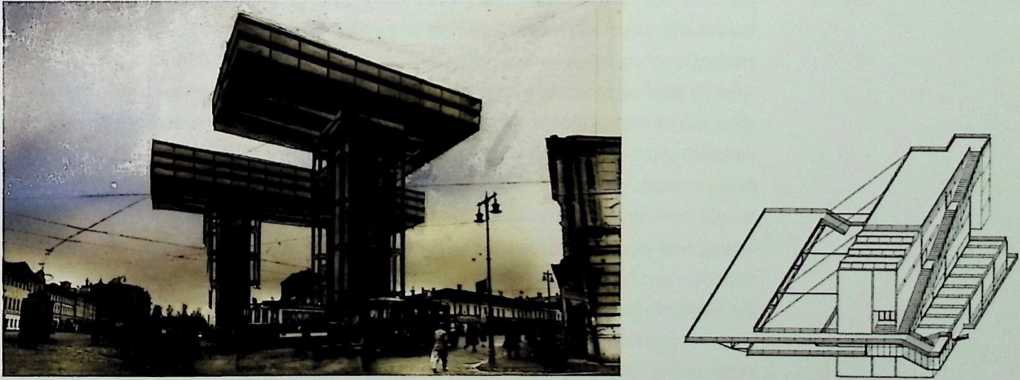

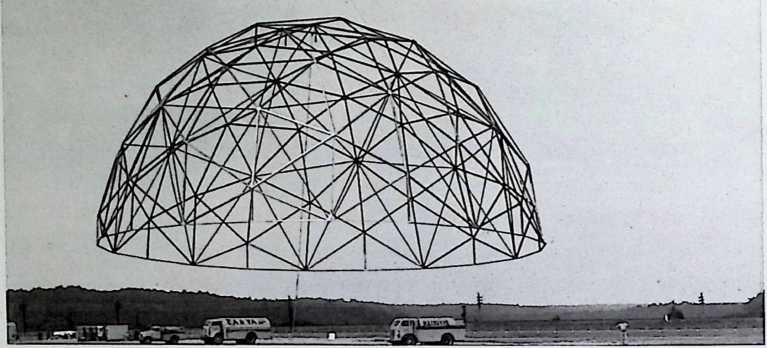
structures of perception itself (diagonals, layers, rotation) are folded back on themselves to become the object of aesthetic expression and experience. Form thereby becomes content, producing an opacity of the architectural sign and a shift of focus to the very operations and apparatuses of sign production. Reflexive aesthetic practice foregrounds materials, techniques, and operations of construction, thus reducing the transparency of style. Whereas Fuller’s 4D project strives for total transparency; it is nothing but its performance, an “invisible energy valve”function and matter organized in time.
Fuller’s work differs from contemporaneous architecture, first, then, in its lack of a code of reflexivity. “Lack” is not quite the right way to put it, since it is precisely the absence of reflexivitythe freeing up of matter and function from any specific kind of contentthat enabled Fuller’s push toward an unencoded functionality of multiple, heterogeneous elements connected across different sites and domains of effectivity, all subsumed by an even higher unity. Fuller insisted that the fundamental 4D machine can be found at work at the level of the individual, the family, society, and the planet, and that it is operative in technology, climate, population, and economics. Such a machine cannot be coded; it is made of nothing more than its connections. It is a geological diagram that organizes functions and guides the multiple interactions of different matters.5
Fuller’s work quickly became known to small and scattered groups of architects mainly through lectures, including a presentation of the Dymaxion House to the Architectural League of New York in 1929. The project was exhibited at the Marshall Field’s department store and published in the Chicago journal Architecture in June of the same year. Architectural Record published it as a “weekend house” in 1930. The larger architectural audience, however, was created later, in the mid-1950s. Fuller’s geodesic domes were exhibited for the first time at the Tenth Triennale in Milan, 1954 (the same year he received the U.S. patent for the dome), drawing the attention of the international design community. These first domes were constructed of paperboard and staples, but for the 1957 Triennale, the U.S. government commissioned an aluminum version covered in fabric. In 1956, John McHalea founding member of the Independent Group of Great Britain who had coined the term Pop Art in 1954published an article on Fuller in the widely read British journal Architectural Review.6 Meanwhile Fuller was mesmerizing students across the United States. The Yale student journal Perspecta reported on a studio Fuller taught in 1951–52.7 North Carolina State College’s Student Publications of the School of Design published Fuller’s “No More Second Hand God.”8 In 1954 Architectural Forum mentions Fuller’s visits to North Carolina State College and to Princeton University, and it published a short article, “Marines Test a Flying Bucky Fuller Barracks,” with what would become the famous photograph of a helicopter transporting Fuller’s dome (fig. 5).9 In 1960, Arthur Drexler at the Museum of Modern Art launched the exhibition Three Structures by Buckminster Fuller. The Fuller phenomenon was in place.
But it was the historian Reyner Banham who was the single most important advocate for Fuller in the architecture world. In the conclusion to his polemical revisionist history of modernism, Theory and Design in the First Machine Age (1960), Banham presents Fuller as the contemporary analogue of his Futurist architect-hero Sant’Elia and avatar of the Second Machine Age:
There is something strikingly, but coincidentally, Futurist about the Dymaxion House. It was to be light, expendable, made of those substitutes for wood, stone and brick of which Sant’Elia had spoken, just as Fuller also shared his aim of harmonizing environment and man, and of exploiting every benefit of science and technology. Furthermore, in the idea of a central core distributing services through surrounding space there is a concept that strikingly echoes Boccioni’s field-theory of space, with objects distributing lines of force through their surroundings.10
The final point is remarkably suggestive, but the lines-of-force idea was not developed. Instead, Banham stressed Fuller’s advocacy of the constant renewal of the environment, using Fuller’s own words (quoted from a letter sent by Fuller to John McHale in 1955) to criticize the “outside-in” thinking of mainstream architecture “they only looked at problems of modifications of the surface of end-products, which end-products
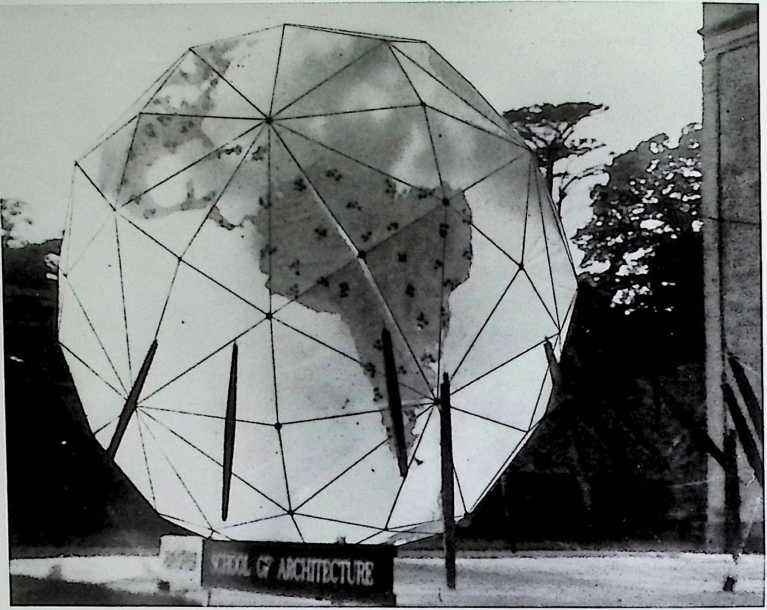
were inherently sub-functions of a technically obsolete world”and to recommend what Fuller termed “the science-initiated transcendental transformations of the industrializing world’s unhaltable trend to constantly accelerate change” in a quest for ever-better environmental performance.11
In his review of Banham’s book, Alan Colquhoun dramatized the stakes of the full embrace of the Fullerian machine: “In introducing him as deus ex machina of his argument, Dr. Banham is raising the fundamental question of the validity of architecture itself in any sense that we understand that term.” Colquhoun understood that the absence of reflexivity and self-conscious codes in Fuller’s work could yield only “the image of a technique which has reached an optimum of undifferentiation.” Highly critical of Fuller, he nevertheless caught the motivation behind the antirepresentational, pure matter-energy assemblage that is the geodesic dome: “In Fuller’s domes the forms are identified by their lines of force, resembling those High Gothic structures where a framework alone defines the volumes which it encloses, and seeming to exemplify Fuller’s philosophy of the forms of art being absorbed back into the technical process.”12
What Colquhoun could not recognize was that by dealing with purely functional elements, forces, and the multiplicity of their relations in different domains, Fuller’s thought comes close to what Gilles Deleuze termed a “transcendental empiricism,” which is antirepresentational, vitalistic, and open to the multiple and divergent experiences and manifestations of life, or as Fuller put it, to “the everywhere and everywhen nonsimultaneously intertransforming, differently enduring, differently energized, independently episodic and overlapping, eternally regenerative, scenario Universe’s laws.”13 For Fuller everything that exists is a modulation of something else, an articulation of one substanceNature, God, or Universe; “I am quite confident, because I have been exploring it for a long time, that nature has just one coordinate system.”14 But this does not mean Fuller’s geological diagram is just an abstraction that transcends all possible experience. Rather it is an empirical system of differential relations that creates and organizes actual times, movements, trajectories, and ultimately sensations.
Perhaps the best demonstration of such cognitive and perceptual possibilities is the Geoscope (fig. 6). Beginning in 1952, working with John McHale and architecture students at Cornell University, University of Minnesota, and Princeton University, Fuller designed a globe, 200 feet in diameter, made up of triangular panels analogous to the Dymaxion Air-Ocean World Map (1943) and furnished with 10 million tiny computer-controlled pixels of lighta spherical computer display monitor for viewing Earth in the universe from inside out, like an enfolded Google Earth except with more cosmic ambitions. Fuller had speculated on such a prospect as early as 1928:
The point of view, through introspection, unlimited to the segmental area of our temporal eyes, is our abstract central position in the center of the universe, looking or building from inside out, as from the center of a great glass globe of the earth. Through this globe may be viewed the progression of relative positions to the starry universe, looking along the time lines in all directions. The separate paragraph thoughts are only connected by their common truths, which are the material crystalline spheres of sensible and reasonable fact, through which the radial time lines of individualism must inevitably pass in their outward progression towards the temporal infinity.15
His subsequent cartographic and geodesic research enabled Fuller to actualize this early idea.
Using cybernetic data gathering and feedback all organized by computer, the Geoscope would graphically display the inventory and patterns of the world’s resources and needs, in real time, slowed down, or speeded up, simultaneously or separately, for study and comparisonfrom energy consumption to stock trading, voting trends to weather patterns, tourist routes to military movements. It was an inverted planetarium for playing out the World Game, a “macro-micro-Universe-information” machine, geo-info-video-dome for the comparative display of flows, patterns, and intensities of population, climate, geology, sociology, finance, and their distributions and interactions. “It was to satisfy the same need of humanity to comprehend the total planetary, all-evolutionary historical significance of each day’s developmentthat the 200-foot, or sixty-meter, -diameter Geoscope was developed.”16 Fuller proposed that it be displayed at the United Nations building in New York as well as the U.S. Pavilion at the Montreal Expo 67, among other places (plate 154). The Expo dome had its beginnings, in fact, in the Geoscope; the initial project included a rectangular space-frame hovering over an unfolded Geoscope equipped with consoles on a balcony for players of the World Game.17 The Geoscope was the concrete embodiment of Fuller’s geological diagram.
Fuller’s dome made him famous in architecture circles. And yet, of the modem architecture heroes who were practicing during the 1950sincluding Marcel Breuer, Walter Gropius, Le Corbusier, Ludwig Mies van der Rohe, Eero Saarinen, and Frank Lloyd Wright only Louis Kahn seemed to have been directly influenced by Fuller. In an extraordinary unpublished article of 1982, Fuller recounts the time when, living
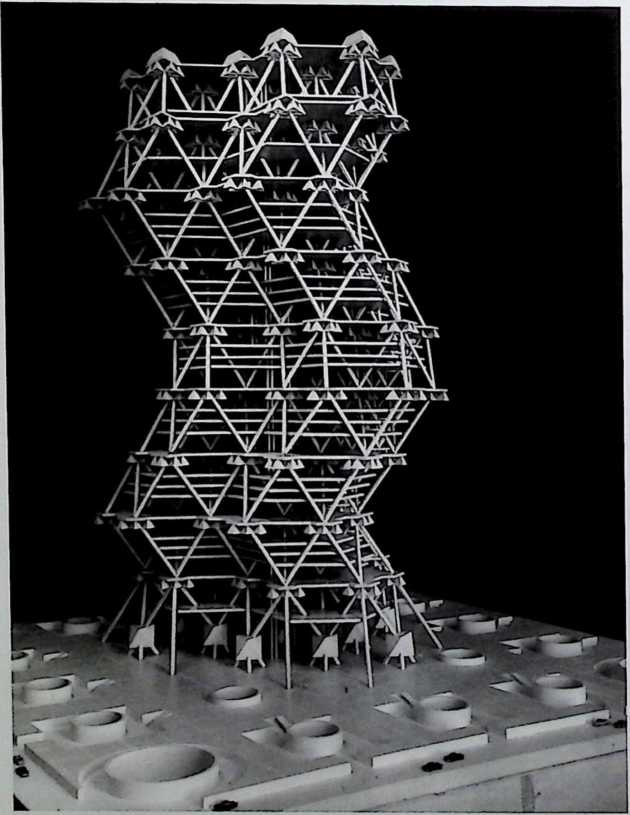
in New York and teaching at Yale University (having been summoned there by the chair of the Architecture Department, George Howe), he regularly boarded the Philadelphia-New Haven train in New York and traveled to Yale with Kahn. During these trips, according to Fuller’s account, Kahn converted to geodesic thinking, the results of which were the octet (octahedron-tetrahedron) truss used by Kahn in the Yale Art Gallery (1951-53), and the City Tower project for Philadelphia (fig. 7), which is basically a geodesic skyscraper, done in collaboration with Anne Tyng beginning in 1952.18 Kahn and Tyng understood Fuller’s energetic-synergetic geometry as both architectural tool and social mobilization, generator of practical shapes with cosmic implications, Tyng later published a theoretical article, “Geometric Extensions of Consciousness,” that explores the geometrical foundations of human consciousness itselfwhat she calls “mind-matter.”19 The tetrahedral and hexagonal geometries propounded by Fuller were empirical structures flowing “from microcosm to macrocosm,” the dynamic basis of biological organisms as well as social formations and cultural practices, making interconnections across all of humanity and nature and promising fundamental transformation in social and mental life. In the early work of Kahn and Tyng, the geological diagram was the sponsor of an architecture that promised to engender a new society.20
From the mid-1930s through the 1960s Buckminster Fuller was recognized as the architectural conscience for social technology. An important related aspect of his work remained latent for the most part, howeverthe aspect glimpsed in different ways by Tyng, Kahn, Banham, and Colquhoun. This is the second way Fuller’s work differed from contemporaneous architecture: whereas architecture would seem to be fundamentally a search for stability, Fuller sought a model of reality based on movable elements and flows of very different sortsphysical, psychological, environmental, socialelements that interconnect and enter into structures, where structure is defined as a “locally regenerative pattern integrity.”21 “Both man and universe are indeed complex aggregates of motion,” Fuller insisted.22 The resolution of reality into renewable patterns of movement is the most radical of Fuller’s ideas for architecture, for it challenges not only stability but space itself as architecture’s fundamental principal. “ ‘Space’ is meaningless,” Fuller insisted. “We have relationships but not space.”23
Though it became famous as the most stable structural system available, Fuller’s geodesics must be understood first as a system based on distances and movements. Consider the cuboctahedron as the basic geodesic sphere. The cuboctahedron comprises fourteen surfacessix squares and eight triangles twenty-four identical edges, and twelve identical vertices with two triangles and two squares meeting at each. In the cubic close packing of twelve spheres around one sphere, to connect the centers of the twelve outer spheres gives a cuboctahedron; the center of each outer sphere connects to the center sphere with an interval of the same length or “frequency.”
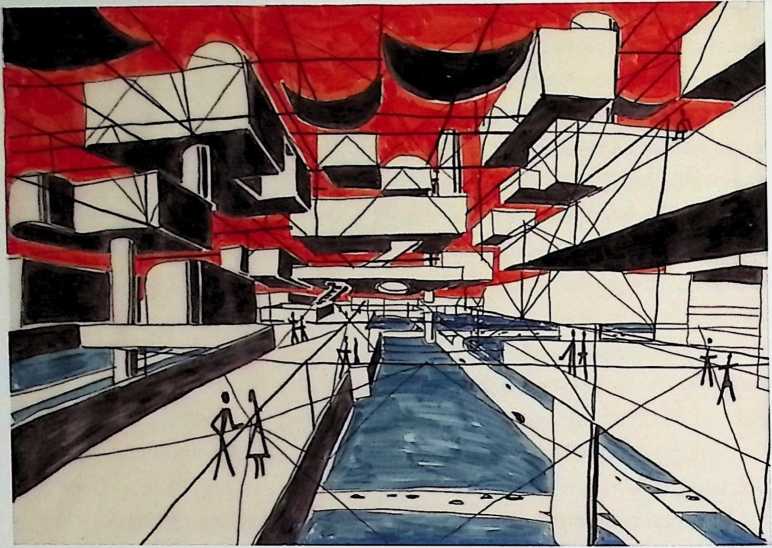
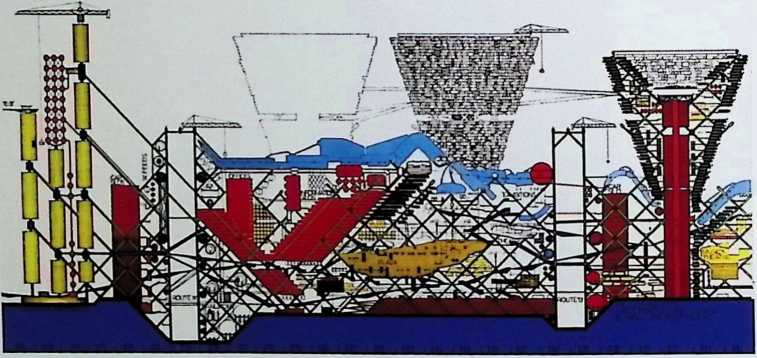
We therefore understand the vertices as vectors moving outward from these centers in waves or lines of forceFuller’s “twelve degrees of freedom.” The geometry of the cuboctahedron is the structure that these flows temporarily enter intoFuller called it “vector equilibrium.” It is his principal model for an omnidirectional process of growth and change. It can also be a dome, but the dome is understood not as simply a stable cover, but as a cosmic machine, plugged into and traversed by the forces of the universe.
We are reminded of Banham’s perception of the lines of force radiating through time and distance. Banham correcty recognized Fuller’s geological engagements with architecture as “other”:
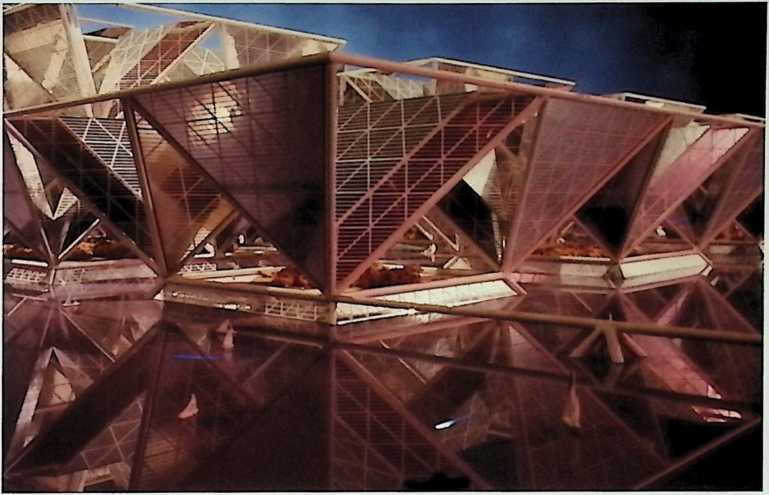
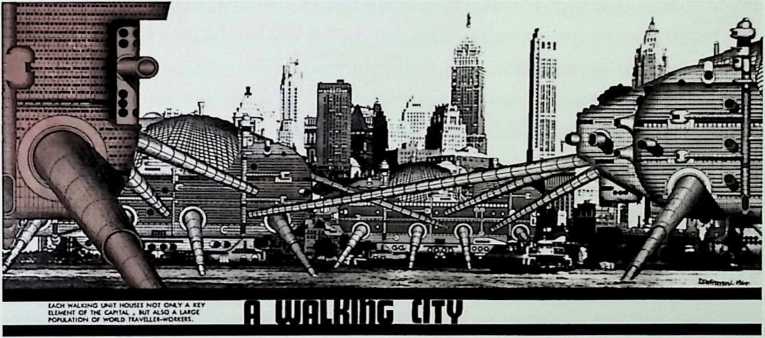 But more fundamentally “other” is the approach of a designer like Buckminster Fuller, especially as the architectural profession started by mistaking him for a man preoccupied with creating structures to envelop spaces [like the space-frames of Robert le Ricolais or Konrad Wachsmann], The fact is that, though his domes may enclose some very seductive-seeming spaces, the structure is simply a means towards, the space merely a by-product of, the creation of an environment, and that given other technical means, Fuller might have satisfied his quest for ever-higher environmental performance in some more “other” way.24
But more fundamentally “other” is the approach of a designer like Buckminster Fuller, especially as the architectural profession started by mistaking him for a man preoccupied with creating structures to envelop spaces [like the space-frames of Robert le Ricolais or Konrad Wachsmann], The fact is that, though his domes may enclose some very seductive-seeming spaces, the structure is simply a means towards, the space merely a by-product of, the creation of an environment, and that given other technical means, Fuller might have satisfied his quest for ever-higher environmental performance in some more “other” way.24
After Kahn and Tyng, architects did not return to this sort of architectural alterity until the late 1990s, when, armed with different theoretical tools, a new generation of scholars and designers approached Fuller’s work again with open-mindedness. Sanford Kwinter’s is a particularly forceful voice:
Fuller was the first designer in history to understand structure as a pattern comprised entirely of energy and information…He conceived of the universe itself as an energetico-informational continuum, something dynamic, and always transforming…He was the first designer to have comprehensively understood the social and natural environment as a fluid, shapable, and active medium… Fuller’s simple point is that a large part of a society’s fixed capital and public goods comprises infrastructural possibilitiestechniques that remain woefully unexplored. Here, and nowhere else, lies the true problem of design for the 21st century: the marriage of fixed and intellectual capital. But to get there, we must pass through Fuller.25
The 1960s and ‘70s were years of intense search and struggle for architecture to conceptualize new forms of collective habitation, and Fuller’s were not the only radical propositions. Constantinos Doxiadis used global statistics and theorized the growth of cities in terms of time rather than space. Kenzo Tange’s influential 1960 Plan for Tokyo would extend the growth of that city over the bay using artificial islands connected by bridges. Around the same time, Yona Friedman’s Ville Spatiale (fig. 8) and Constant Nieuwenhuis’s New Babylon superimposed an entirely new architecture above old European capitals using suspended freedom-granting spaceframes and movable dwelling modules. In 1964 the Archigram group advertised Peter Cook’s Plug-in City (fig. 9), which stretched out from London across the Channel and utilized standardized building units plugged into a flexible support structure. Soon after that, Stanley Tigerman in Chicago produced a series of giant floating tetrahedral city projects (fig. 10). Meanwhile Ron Herron’s Walking City simply sidled up and squatted near whatever neighbor its traveler-workers thought attractive (fig. 11).26 These and other such projects continue the progressive experiments of the interwar avant-garde, now in the different context of a rapidly emerging consumer information society, even as they assuage old anxieties about the historical city (which was usually left in place in these proposals), often with appeals to Pop and Sci-fi subcultures, transgeneric practices, and psychedelic environmental pleasures. The heterogeneity of architectural expression in these works project the desire for a heterogeneity of sensual and psychic experience, and the new technologies of building, organization, and communication are all in the service of experiential effect.
Fuller’s engagement with the problem of collective living was developed at the same time but came directly from his earlier concept of the individual domicile as an energy valve in a vast system of energy exchange, except now the energy valve was shifted to the urban scale. Taking the city of New York as an example, Fuller noted that the existing individual buildings placed in the Manhattan grid, with their outside-in-designed decorative fins and other spongelike ornaments, maximize surface area and together give off heat like an enormous air-cooled engine. An inside-out-designed dome over Manhattan would function in precisely the opposite wayas an environmental control valve that would minimize energy use even while connecting its inhabitants with the cosmos (plate 145). h
From the inside there will be uninterrupted contact with the exterior world. The sun and moon will shine in the landscape, and the sky will be completely visible, but the unpleasant effects of climate, heat, dust, bugs, glare, etc. will be modulated by the skin to provide Garden of Eden interior.27
Doming over Manhattan was only a corrective, of course. Fuller would rather leave the city behind altogether and occupy those parts of the globe previously uninhabitable, like the ocean and the polar icecaps. A series of schemes designed with Shoji Sadao in the late 1960s further develop the energy-valve schema. Tetra City is a paradigm of a new class of floating omni-surfaced ecologies (plate 146). Measuring two miles at each of its edges, it gives its one million “passengers” maximum access to outside living in tiered, terraced garden homes, while community services, shops, and recreational facilities are housed inside the structure and efficiently serviced from the “common, omni-nearest possible center of all polyhedra.” This is, of course exactly the same diagram as the 4D House, with its central mast housing all equipment and services. Tetra City is even more mobile than 4D. It may be anchored near a coast or floated out to sea and used as a way station for globe-circling ships and planes. The tetrahedral structure itself may be expanded symmetrically using recycled materials from obsolete land buildings. Cloud Nine, extraordinary as it is, is fundamentally the same project, now spherical rather than tetrahedral, and engineered for the air-ocean world rather than water (plate 144).
The photomontages of these giant floating megastructures are among Fuller’s most intriguing images. The scale, geometrical purity, and abstract surfaces, in contrast with the landscapes that are their temporary hosts, suggest further comparison with the architettura radicate of Italy around 1970 and especially with Superstudio’s 1969 Continuous Monument (fig. 12)a single blank monolith that stretches across the entire earth, unrelenting, crossing deserts and forests, valleys and lakes, as well as old cities whose inhabitants would have no choice but to take refuge in this new and singular form of “total urbanization”:
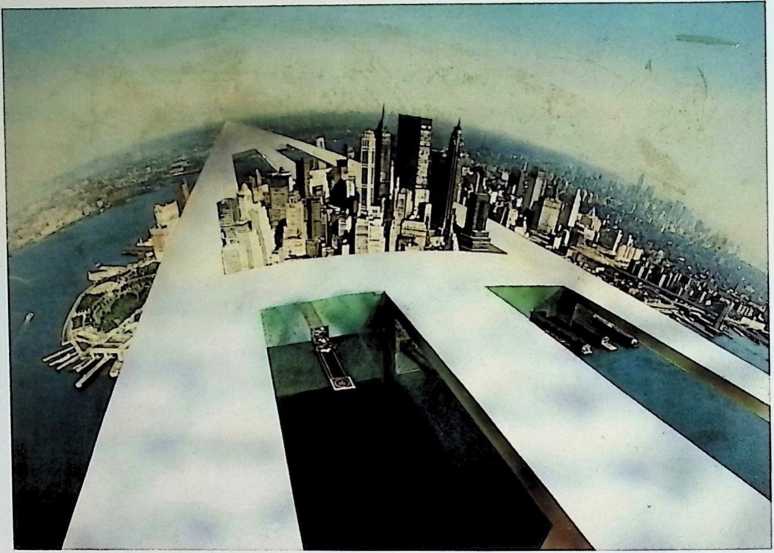
New York for example. A superstructure passes over the Hudson and the point of the peninsula joining Brooklyn and New Jersey. And a second perpendicular structure for expansion. All the rest is Central Park. This is sufficient to hold the entire built-up volume of Manhattan. .. . And from the Bay, we see New New York arranged by the Continuous Monument into a great plane of ice, clouds or sky.28
In the architectural magazine Casabella (1971), the genesis of this project is narrated: A single square, the basis of all architecture, dissolves over the earth and its particles float through the air, settling randomly across the globe, where they grow into their final form. One is reminded, of course, of the status of the triangle and its infinitely generative capabilities in Fuller’s system.
But if the empiricist leanings of Banham and the Archigram architects, who explored the potentials of social technologies to totally reshape the environment, permit a partial match of Archigram’s work with Fuller’s, the comparison with the radical architecture of Superstudio forces to the foreground what are, in fact, the very real differences between Fuller’s megastructures and all the rest. The projects of Superstudio, Archigram, Constant, and Friedman alike are first and foremost ideological criticisms of the cultural codes and conventions of an emerging consumer society anti-utopias whose proper functions are antagonism and disruption, using the New as a radical and systematic break with the present. Technology and social program are preoccupations, but architectural formor even style, to return to Johnson’s distinctionis still a primary concern. As Banham attested, “Archigram can’t tell you for certain whether Plug-in City can be made to work, but it can tell you what it might look like.”29 And though some of these architects’ work certainly contains serious propositions, it trades much more freely in irony, paradox, and aesthetic negativity. Superstudio’s Continuous Monument, in particular, is a pure practice of negation, a revolt of the objectthe laying to waste of tradition through relentless repetition and counterpoint.
In contrast, Tetra City and Cloud Nine are not cultural critiques, and they do not really propose an aesthetics of a new technological environment (though certainly they have been taken to do so). They are rather visual models of a complex of elements and connections, many invisible, that enable dwellingorganizations of immaterial as well as material processes that include climate, transportation, and communication, forces that enter into a pattern or structure, then grow into archipelagos of omnidirectional ecologies, giant biospheres suspended in the world net. This is the third difference between Fuller’s geological diagram and architecture (which may also be thought of as a product of the prior two): with Fuller we must think beyond the view that technology, architecture, and human individuals are discreet things and systems that may act upon one another, but are still self-defined and external to one another. We must envision a differentiated totality where these distinctions no longer hold: we must recognize a continuum that includes the flows of air that buoy the enclosure and supply oxygen for its passengers, the sun and snow, the movements of bodies, nutrients, and fuels in and out of the enclosures, the movement of capital, the movement of the enclosures themselves through time and distance in postterrestrial becoming. Fuller: “I am convinced of the utter integrity of the total experience, and of the indicated extensibleness of the comprehensive integrity-apparent universe.”30 The universe is a vast Bit Torrent communications protocol distributing data to ever-multiplying recipients. Such a complex can include signs and codes among its many elements and functions, of course, perhaps even necessarily. But it is not reducible to an aesthetic or a style. Tetra City and Cloud Nine are transfer stations in this complex; they are not what they look like but what they do; they are not nouns but verbs. They are what Fuller called “articulations,” in the same sense that he uses the term in “No More Secondhand God”:
Here is God’s purpose
for God to me, it seems,
is a verb
not a noun,
proper or improper;
is the articulation
not the art, objective or subjective;
is loving,
not the abstraction “love” commanded or entreated;
is knowledge dynamic,
not legislative code,
not proclamation law,
not academic dogma, nor ecclesiastic canon.[5]
Architecture as articulation, not art; dynamic knowledge, not code. Articulations are made, sustained, transformed, and destroyed in a continuum of concrete practices, one of which is architecture.
Fuller was awarded the Royal Gold Medal of Architecture by the Royal Institute of British Architects in 1968 and the Gold Medal from the American Institute of Architects in 1970. But Fuller was not an architect. His collaborative friendships with architects like Norman Foster, with whom he designed the Autonomous House in 1982, and Nicholas Grimshaw & Partners, whose Eden Project of 1996 is a showcase for biodiversity and global sustainability housed in eight geodesic domes, stand among Fuller’s professional architectural legacies. But Fuller was never an architect. A new generation of architects who rediscover Fuller will be inspired not by self-conscious reflexivity, spatial invention, or radical cultural critique, but by his modeling of a globalized system of contingency and structure, organization and change, temporary stability and constant renewal. This was his prediction:
The great aesthetic which will inaugurate the twenty-first century will be the utterly invisible quality of intellectual integrity the integrity of the individual in dealing with his scientific discoveries the integrity of the individual in dealing with conceptual realization of comprehensive inter-relatedness of all events; the integrity of the individual in dealing with the only experimentally arrived at information regarding invisible phenomena; and finally the integrity of all those who formulate invisibly within their respective minds and invisible with the, only mathematically dimensionable, advanced production technologies, on the behalf of their fellow men.32
Such are Fuller’s geological engagements with architecture.
Notes
-
“Buckminster Fuller: Thinking Out Loud,” documentary in the American Masters series, Thirteen/ WNET, April 10, 1996, http://www.thirteen.org/bucky/johnson.html.
-
Buckminster Fuller, “Influences on My Work,” in The Buckminster Fuller Reader, ed. James Meller (London: Penguin, 1972), 61.
-
László Moholy-Nagy, The New Vision (1928; repr., New York: Wittenbom, Schultz, 1947), 189.
-
Buckminster Fuller, “On Paul Nelson,” letter to Margaret Fuller, 1928, in Your Private Sky: R. Buckminster Fuller: Discourse, ed. Joachim Krausse and Claude Lichtenstein (Zurich: Lars Muller, 2001), 80.
-
I have taken recourse here to the concept of an abstract machine as “the aspect or moment at which there is no longer anything but functions and matters,” from Gilles Deleuze and Felix Guattari, A Thousand Plateaus: Capitalism and Schizophrenia (Minneapolis: University of Minnesota Press, 1987), 141.
-
John McHale, “Buckminster Fuller,” Architectural Review 120 (July 1956): 13–20.
-
R. Buckminster Fuller, “The Cardboard House,” Perspecta 2 (1953): 28–35.
-
R. Buckminster Fuller, “No More Second Hand God,” Student Publications of the School of Design (Raleigh: North Carolina State College) 4, no. 1 (Fall 1953): 16–24.
-
Architectural Forum 100 (March 1954): 37.
-
Reyner Banham, Theory and Design in the First Machine Age (New York: Praeger, 1960), 327.
-
Ibid., 326, 327. Fuller’s letter was published in Architectural Design 31, no. 7 (July 1961).
-
Alan Colquhoun, “The Modem Movement in Architecture,” British Journal of Aesthetics 2, no. 1 (January 1962): 63.
-
R. Buckminster Fuller, Critical Path (New York: St. Martin’s Press, 1981), 163.
-
Buckminster Fuller, “The Music of the New Life,” Music Educators Journal 52, no. 6 (June-July 1966): 67.
-
Buckminster Fuller, 4D Time Lock (1928; repr., Albuquerque, N.Mex.: Biotechnic Press, Lama Foundation, 1972), 31.
-
Fuller, Critical Path, 171–72.
-
For a discussion, see Jonathan Massey, “Buckminster Fuller’s Cybernetic Pastoral: the United States Pavilion at Expo 67,” Journal of Architecture 11, no. 4 (September 2006): 463–83. Also see Mark Wigley, “Planetary Homeboy,” ANY 17 (1997).
-
Fuller reports, “I was talking in terms of the future of humanity and the enormous responsibility of the young world to take on the new technology, for, as I saw it, it was only that new technology that made possible the option to make all humanity a success. Lou found almost unbridled enthusiasm in each of my new university audiences. We talked about this a great deal. I think this was very much of a turning point in his life. He said so to me. He set about doing his own ‘thinking out loud’ exploration. Lou next designed the Yale Art Gallery (1951–53). He used my octet (octahedron-tetrahedron) truss for his reinforced concrete, clear-span ceiling structure. Then he began designing projects with the octet truss used as the infrastructure of the entire building (Philadelphia City Hall project, 1952–53; a city tower study,1953–577). He said, ‘Bucky, you never thought of living inside your geometry.’,” Buckminster Fuller, “Kahn Essay,” typescript, sen 8, box 201, folder 5, R. Buckminster Fuller Papers, Department of Special Collections, Stanford University Libraries.
The structure of the Yale Art Gallery is not, in fact, an octet truss, but rather long concrete beams with diagonal webbing filled in between.
-
Anne Griswold Tyng, “Geometric Extensions of Consciousness,” Zodiac 19 (1969): 130–73.
-
For a discussion see Sarah Williams Ksiazek, “Critiques of Liberal Individualism: Louis Kahn’s Civic Projects, 1947–57,” Assemblage 31 (December 1996): 56–79. The “from microcosm to macrocosm” comment is from Tyng, “Anatomy of Form/ Atom to Urban,” unpublished ms., 1962, cited in Williams Ksiazek.
-
Buckminster Fuller, Synergetics: Explorations in the Geometry of Thinking, in collaboration with E. J. Applewhite (New York: Macmillan, 1979), 315.
-
R. Buckminster Fuller, Utopia or Oblivion: The Prospects for Humanity (New York: Bantam, 1969), 348.
-
Ibid., 18.
-
Reyner Banham, The New Brutalism: Ethic or Aesthetic? (New York: Reinhold, 1966), 69.
-
Sanford Kwinter, “Fuller Themselves,” ANY 17 (1997): 62.
-
Walking City didn’t actually walk but rather retracted its legs and glided along on a cushion of air.
-
Buckminster Fuller, quoted in John Allwood, The Great Exhibitions (London: Studio Vista, 1977), 169.
-
Superstudio, “11 monumento continuo,” Casa-bella 358 (1971): 22.
-
Reyner Banham, “A Clip-on Architecture, ” Architectural Design 35 (November 1965): 535.
-
Fuller, “Influences on My Work,” 67–68.
-
R. Buckminster Fuller, No More Secondhand God and Other Writings (Carbondale: Southern Illinois University Press, 1963), 28.
-
R. Buckminster Fuller, “Planetary Planning,” in Jawaharlal Nehru Memorial Lectures, 1967–1972 (Bombay: Bharatiya Vidya Bhavan, 1973), 112–13.
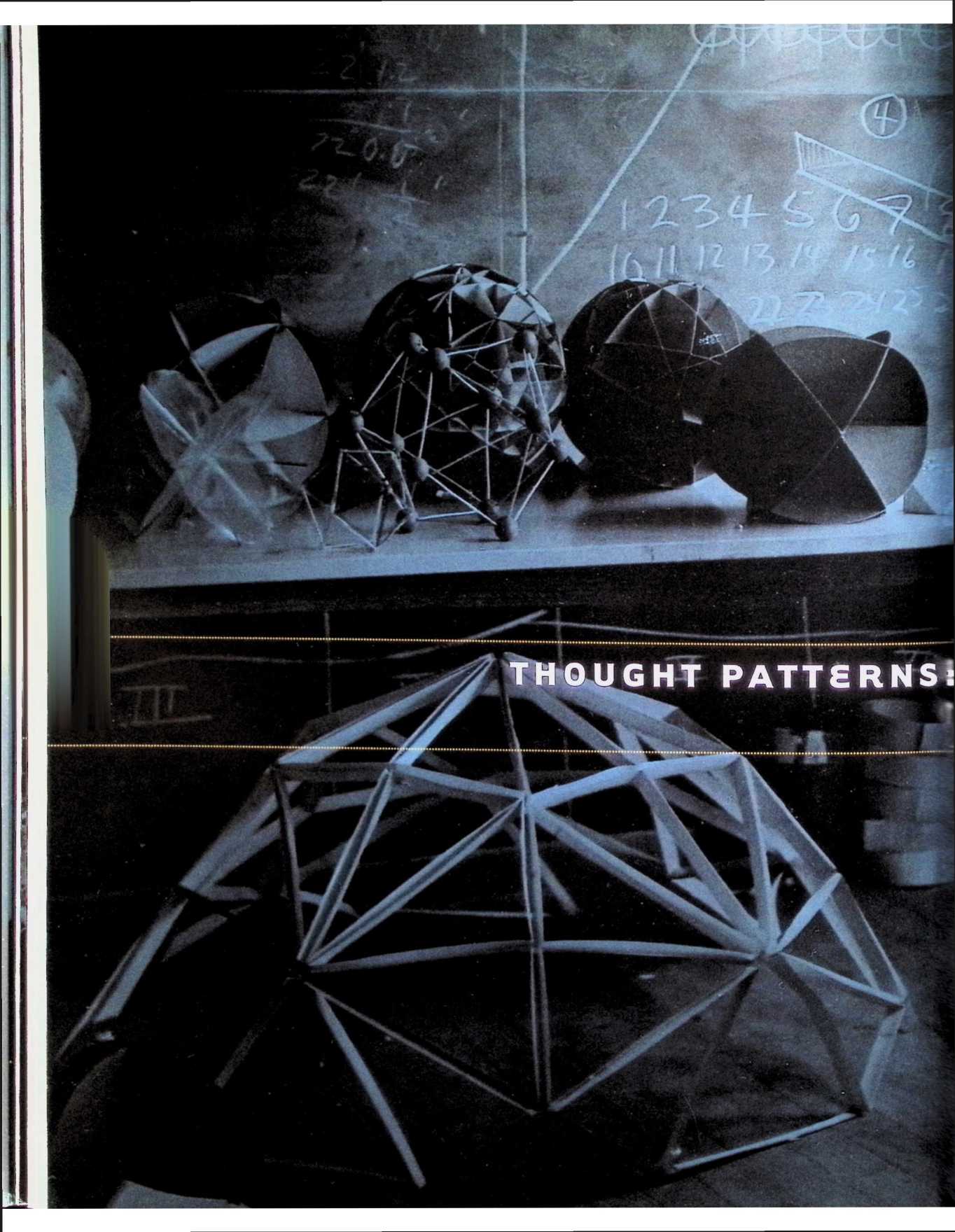
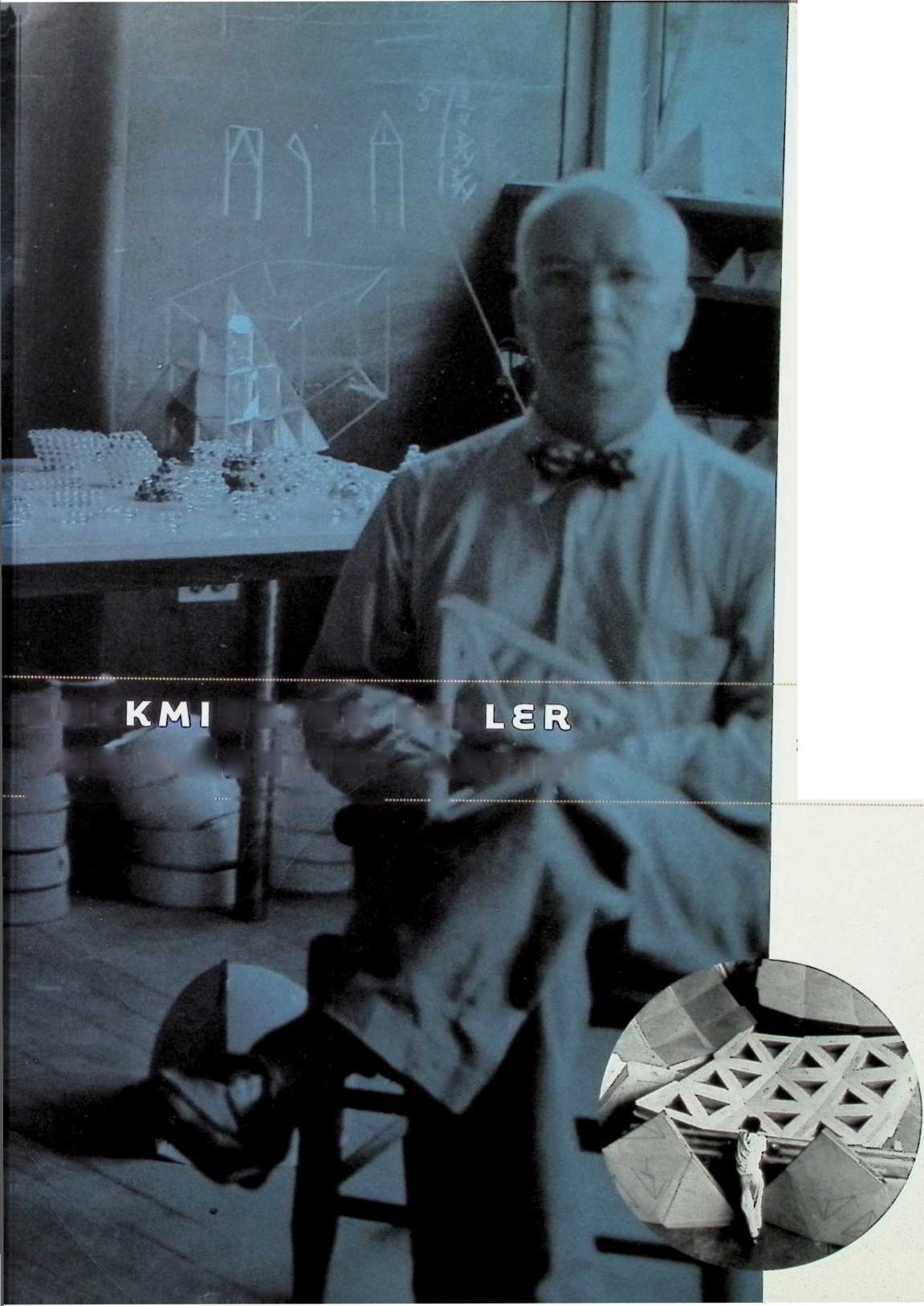
¶ Thought Patterns: Buckminster Fuller the Scientist-Artist
DANA MILLER
Intuition and aesthetics automatedly trigger us into consciousness of the existence of opportunities to consider and selectively initiate alternative acts or position-taking regarding oncoming events, potential realizations or unprecedented breakthroughs in art, technology and other human productivity.
BUCKMINSTER FULLER, foreword to Projections: Anti-Materialism, 1970
While architects and engineers frequently greeted Buckminster Fuller with skepticism or suspicion, he deftly navigated artistic circles throughout his life. Fuller believed artists were uniquely positioned to conceptualize solutions to humanity’s mounting problems because of their capacity to recognize nature’s inherent patterns and extrapolate comprehensive design applications from them. He consciously cultivated friendships with artists with whom he felt a kinship and from whom he was able to draw inspiration. And although Fuller claimed that he never considered the visual impact of his structures while devising them, much of his work can be viewed as aesthetic exploration. If something wasn’t beautiful when he finished it, Fuller knew it wasn’t correct. This essay will illuminate some of the more important episodes in a career that intersected with those of sculptors, painters, and film and video artists again and again. Fuller’s significant presence in the art world of the 1960s and early ‘70s will be a key focus, as it goes largely unnoted in the literature on Fuller and in the art historical accounts of that period.
Fuller’s ardent belief in experientially gained information was crucial to understanding his philosophy. Testing hypotheses through trial and error and accepting failure as part of the process was essential to the “experientially founded mathematics” at the root of his comprehensive design program. As was the case with many of Fuller’s deeply held convictions, he could trace the origins of this approach back to childhood. As a severely cross-eyed toddler, Fuller could see only large patterns and colors, and his earliest understanding of the world was based upon his imagination and physical intuition. When he was in kindergarten, his teacher gave his class toothpicks and peas and asked them to build houses. “All the other children, none of whom had eye trouble, put together rectilinear box houses,” he recalled. “Not having visualized the rectilinearity about me, I used only my tactile sense. My finger muscles found that only the triangle had a natural shape-holding capability. I therefore felt my way into producing an octahedron-tetrahedron truss assembly. …It was this experience which undoubtedly started me off at fifteen to look for nature’s own structural coordinate system.”[6] Employing “nature’s own structural coordinate system” teleologically to benefit all of humanity became the foundation of Fuller’s lifework as a comprehensive anticipatory design scientist.2 The corollary to Fuller’s belief in nature’s coordinate systems is that man-made edifices built upon those principles will be structurally sound and aesthetically resolved. They will look and feel right.
Fuller’s belief in intuition and experientially gained information meant that his design science revolution needed artists as much as scientists and designers. Artists could recognize local patterns and envision ways to translate them into three-dimensional models and universal applications. They often did so in advance of legitimizing scientific discoveries. According to Fuller, this was because artists had resisted specialization and maintained their inherent ability to think independently, intuitively, and comprehensively, while rigorous education had forced scientists into institutionalized methodology and specialization.3 “Artists are now extraordinarily important to human society. By keeping their innate endowment of capabilities intact, artists have kept the integrity of childhood alive until we reached the bridge between the arts and sciences. Their greatest faculty is the ability of the imagination to formulate conceptually. Suddenly, we realize how important this conceptual ability is.”4 For Fuller, thinking conceptually meant using the mind, not the brain. “Many creatures have brains. Man alone has mind. Parrots cannot do algebra; only mind can abstract. Brains are physical devices for storing and retrieving special case experience data.

Mind alone can discover and employ the generalized scientific principles found holding true in every special case experience.”5 Fuller believed that “only minds can conduct science and produce art,”6 and the highest compliment he could confer upon someone was to call him or her a “scientist-artist.” Artists also frequently worked in an anticipatory fashion rather than waiting to be presented with specific commissions or challenges. Unlike scientists, architects, or engineers who were reliant upon patrons or external mandates, artists were not members of what Fuller called the “slave professions.”
By locating the source of his innovations and patents in nature, Fuller could sidestep the inevitable challenges to the originality of his work. Alexander Graham Bell’s experiments with tetrahedral kites and space-frame towers (fig. 1) were a key precedent to Fuller, though one he insisted was brought to his attention long after he reached his independent conclusions.7 The fact that he had unknowingly pursued investigations similar to Bell’s was added proof that a universal coordinated system existed. “It’s the way nature behaves, so we both discovered nature. It isn’t something you invent. You discover it.”8 One progenitor Fuller did acknowledge was D’Arcy Wentworth Thompson. Thompson’s seminal 1917 book On Growth and Form demonstrated the morphological similarities of a wide variety of organic substances and the mathematical basis underlying their structure and growth.9 Thompson’s arguments were punctuated with illustrations by Emst Haeckel and photos by Arthur Worthington, among others, and in later versions with photos by Harold Edgerton as well (fig. 2).
 Spread from DArcy Wentworth Thompson (1860), On Growth and Form (2nd ed. Cambridge: Cambridge University Press; New York: MacMillan, 1943; 1st ed. 1917), with illustrations by Ernst Haeckel (1834-1919)
Spread from DArcy Wentworth Thompson (1860), On Growth and Form (2nd ed. Cambridge: Cambridge University Press; New York: MacMillan, 1943; 1st ed. 1917), with illustrations by Ernst Haeckel (1834-1919)
Romany Marie’s tavern, the eponymous gathering spot run by the Romanian emigre Romany Marie Marchand, was the setting for a seminal period in Fuller’s development. As New York’s version of Paris’s cafe society, Romany Marie’s was filled with artists and intellectuals, and Fuller became a regular in the late 1920s. “There I would stay, a table-sitter, all evening, until very late into the night,” he recalled. “It was the Greenwich Village of the late ‘20s and early ‘30s that generated great new thinkingand I gained many friends for my concepts, and lost none.”10 It was there that Fuller, a polymath and autodidact whose formal education amounted to being kicked out of Harvard twice, began crafting his persona as a maverick outsider unrestrained by academic or commercial fiefdoms. Fuller also sharpened his oratory skills in this milieu, holding forth on his Dymaxion House, which he described as a dwelling machine suspended on a mast that could turn to meet the sun. One room in the house was set aside for books, maps, drawing boards, globes, and radio sets. Called the “Go-Ahead-With-Life room,” it was an early example of Fuller’s commitment to the accumulation and visual display of information and set the blueprint for later endeavors such as the Geoscope and World Game.
Among the artists Fuller met at Romany Marie’s was the young Isamu Noguchi. When Noguchi moved to a new, window-wrapped studio, Fuller planned the interior environment. “Under Bucky’s sway I painted the whole place silverso that one was almost blinded by the lack of shadows,” Noguchi remembered. “There I made his portrait head in chrome-plate bronzealso form without shadows” (plate 41).11 More than three decades before Warhol’s silver-paint- and foil-covered Factory, Fuller conceived of an entirely reflective silver studio for Noguchi. Noguchi’s highly reflective bust of Fuller was among the first works of art to use chrome plating, a process then reserved primarily for automobiles. The choice of media was only appropriate for the man who advocated the harnessing of technology to meet humanity’s needs. At that time Noguchi was supporting himself as an artist, and Fuller, who was regularly broke, often slept on the floor of his studio. They became lifelong friends, and their mutual influence can be detected throughout both careers, including in works such as Noguchi’s Miss Expanding Universe (see plate 40) and the streamlined models of the Dymaxion car on which they collaborated (plate 46).12
When Marie moved her eatery to Minetta Street in 1929, Fuller offered his design services. He devised chairs based on contemporary airplane and steamship furnishings and painted the walls and pipes silver (plate 22). He lit the space brightly using hom-shaped aluminum fixtures, explaining, as Marie recalled, that “pseudos wouldn’t come and hide in my place, they prefer to go hide in dark rooms, dark dining rooms where you can’t see them wellcan’t see through them. To this room, Bucky said, only real and upright people would come, because you would immediately see all the way through them and they wouldn’t mind the test.”13 In practice, the design was less than successful. The chairs collapsed the evening the tavern opened. “It was the most ridiculous spectacle you ever saw in your life,” Marie recalled. “It wasn’t enough that there was a deviation with all the luminositywhen they sit down, they fall down.”14 The next morning she hired a carpenter to make benches to her specifications.
The following year Fuller designed “A Collector’s Room” for the architect Ely Jacques Kahn, which went unrealized. The room, which resembled the streamlined form of the Dymaxion car, was to have niches for displaying sculpture (plates 42 and 43). It was “an outwardly tensed, ovaloid shaped, hyperbolic parabola, faceted, tension (tent) fabric room for installation in the Grand Central Palace at a proposed Architectural Show for a sculptors’ exhibit roomlighting for the room and its sculptural exhibits to diffuse inwardly through the comprehensive translucent, tensed, white fabric ‘walling,’ from lights exterior to the structure.”15 Noguchi’s studio, Romany Marie’s, and the Collector’s Room all demonstrate Fuller’s early affinity for total environments, employing illumination, reflectivity, translucency, color, tension, and shape to maximum sensorial effect.
Fuller continued to promote his Dymaxion House in the early 1930s, often making contacts at Romany Marie’s. He accepted lecture invitations from the Harvard Society for Contemporary Art (recentiy founded by Lincoln Kirstein, Edward
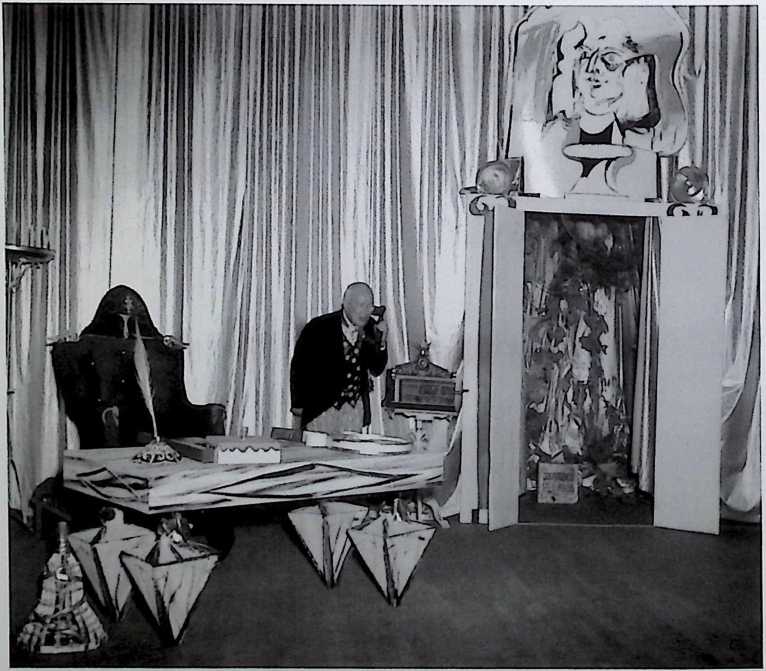
HAZEL LARSEN ARCHER (1921-2001)
Buckminster Fuller of the Baron Medusa in The Ruse of Medusa at Black Mountain College, summer 1948 Warburg, and John Walker) and his friend Katherine Drier, under the auspices of the Societe Anonyme. But by 1932 his work on Shelter and his burgeoning Dymaxion car business occupied most of his time and took him away from New York’s artistic community.
Much has already been written on the two summers that Fuller taught at Black Mountain College, 1948 and 1949, including his encounters with Josef and Anni Albers, Ruth Asawa, John Cage, Merce Cunningham, Willem and Elaine de Kooning, Richard Lippold, and Kenneth Snelson. Yet it was a crucial experience for Fuller and must be discussed, if only briefly.16 Josef Albers hired Fuller for the 1948 summer session at the suggestion of the architect Bertrand Goldberg, whom he thanked, writing, “The whole affair of which I was somewhat doubtful, turned out very well. He has accepted and has arrived just the other day. And last night he gave a talk for about three hours and he proves to be a great man.”17 Despite his professed disdain for Bauhaus philosophy, Fuller thrived in the cross-disciplinary, makeshift atmosphere of BMC, and he would become lifelong friends with Albers and his wife Anni.18
By all accounts Fuller cast a spell on many who were there in 1948, commencing with the lecture he gave that first evening. Cunningham was in attendance and recalled, “I remember thinking it’s Bucky Fuller and his magic show. It was immediate, I think, with all of us who were there …this immediate absolute adoration and love of this man because of his …ideas, the width of the ideas. The grandeur with which he saw things and the way in which he spoke about them and demonstrated them.”19 That performative magic was further unleashed when Fuller played the lead in The Ruse of Medusa, part of Cage’s summer-long concentration on Erik Satie (the play was directed by Arthur Penn, also featured Cunningham and Elaine de Kooning, and employed props and sets by Ruth Asawa and Willem and Elaine de Kooning; fig. 3).
During that summer Cage and Cunningham grew close to Fuller, who appreciated the fields of music, dance, theater, and athletics not the least for their ability to heighten and utilize man’s “intuitive dynamic sense.” The three of them breakfasted together every morning and dreamed up an imaginary “finishing school” they would run. It was a “schematic new school…We would finish anything. In other words, we would really break down all of the conventional ways of approaching school. And the ‘finishing school’ was going to be a caravan, and we would travel from city to city.”20 Both men credited Fuller with expanding their thinking into a multitude of other directions and encouraging them to think holistically and universally. 21 Cage in particular remained in close contact with Fuller, and years later he struggled to reconcile his belief in indeterminacy with Fuller’s vision of a structured universe, eventually noting with relief, “There’s a beautiful statement in Fuller’s Education Automation [1963] [sic] in which he says that the whole idea of things being fixed is a notion that we no longer need.”22
JEAN TINGUELy (1925-1991) Fragment from Homage to New York, 1960, in the sculpture garden of the Museum of Modern Art, with the exhibition Three Structures by Buckminster Fuller (September 22, 1959-winter 1960) in the background Painted metal, fabric, tape, wood, and rubber tires
6 ft. 8 */« in. x 2 ft. 5s/iin.x7 ft. 37/iin. (20.3 x7.5 x 22.3 m)
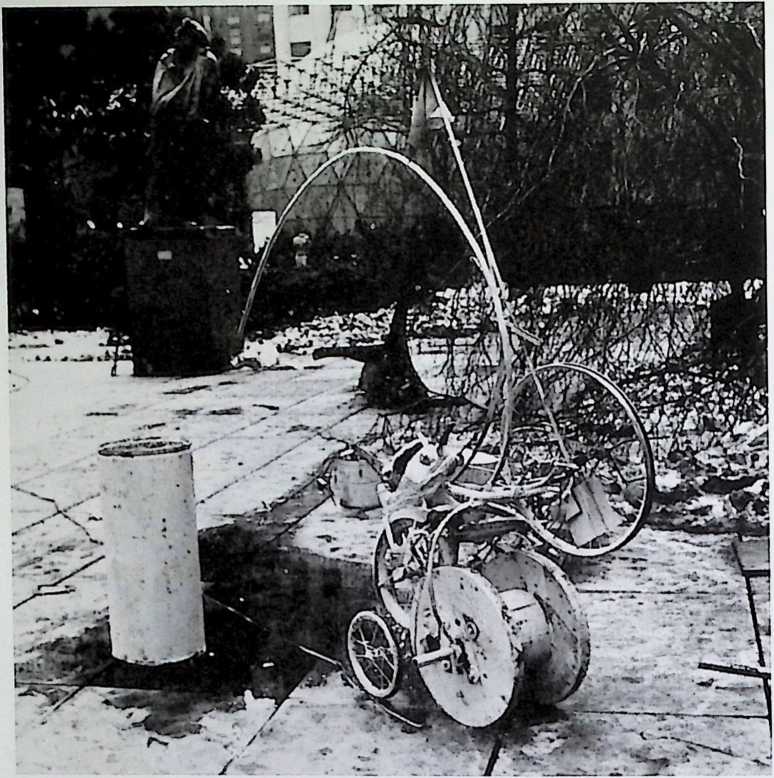 The Museum of Modern Art, New York, Gift of the artist
The Museum of Modern Art, New York, Gift of the artist
Much of Fuller’s first summer at BMC was occupied with constructing a large-scale great-circle dome. Despite the immense level of anticipation, the dome, composed of strips of aluminum Venetian blinds, refused to rise. Immediately dubbed the “Supine Dome,” it was a lesson, Fuller rationalized, in failure as a necessary step on the path to success. Kenneth Snelson, a young artist who had intended to pursue painting at BMC, was chosen by Albers to assist Fuller in his classes that summer because of his demonstrated abilities with three-dimensional structures and worked on the Supine Dome. The following winter, when Snelson was back in Oregon, he created several sculptures, including Early X-Piece (1948-49), an example of a discontinuous compression structure made of wood and nylon (plate 86). Snelson sent photographs of the work to Fuller and then brought the sculptures with him to BMC the following summer. Fuller, immediately recognizing the structural possibilities that Snelson’s sculpture presented, having apparently been searching for such solutions himself, asked to have Early X-Piece. In the early 1950s, photos of similar works began to appear in articles about Fuller, without attribution to Snelson. Soon after, Fuller
coined the word tensegrity to describe tensional integrity with discontinuous compression. Snelson remembers Fuller asking him what he thought of “calling our structure ‘tensegrity,’ ” thereby signaling his intention to take at least partial credit for the innovation Snelson had developed that winter.23 This series of events resulted in a lasting rift between student and teacher.24
For much of the 1950s Fuller was absorbed with inventorying and tracking the earth’s resources, culminating with the Geoscope or Minni-Earth projects, discussed at length in K. Michael Hays’s essay in this volume. More than the artifacts that preceded it, the Geoscope was meant to be a symbolic visual display of information, an attentiongetting dramatization. As Mark Wigley has asserted, Fuller conceived of the Geoscope “as a mechanism for blurring the distinction between science and art.”25 This distinction was further blurred in projects that Fuller worked on with John McHale and Shoji Sadao starting in the late 1950s, such as Dome Over Manhattan and Cloud Nine. The latter was presented as a photomontage in which spherical cloud cities float above a sublime landscape of deep canyons (plate 144). These monumental, airborne living spaces were the seemingly inevitable conclusion of Fuller’s early experimentations with total environments and his emphasis on buoyancy and lightfulness. One also can’t help but be reminded of Bell’s tetrahedral kite experiments.
Beginning in the mid-1950s Fuller was increasingly included in gallery and museum exhibitions, as well as art periodicals. A full-scale exhibition of Fuller’s work at the Walker Art Center was discussed. H. Harvard Amason, then director of the Walker, was a principal supporter, and Gyorgy Kepes, professor of visual design at the Massachusetts Institute of Technology, was slated to design the exhibition. Fuller fantasized that the viewer would become a “comprehensive apprehender and possibly a neophyte comprehensive designer” subsequent to seeing the show.26 That exhibition never came to pass, but in 1959 Arthur Drexler, curator of architecture at the Museum of Modern Art, organized an exhibition of Fuller’s work in the museum’s sculpture garden. Three Structures by Buckminster Fuller ran from September 1959 to winter of 1960 and included a geodesic radome, an octet truss, and a tensegrity mast. A smaller accompanying show with models and didactics was held indoors and overlapped for some of that time. In a wall text Drexler wrote, “Central to Fuller’s genius, is the insight his ideas give us into universal order. That is an achievement which ranks him with other great poets, scientists, and artists.”27 The exhibition was widely reported on in the popular press and in art journals. An interesting side note is that Jean Tinguely’s infamous Homage to New York (1960) was literally hatched inside Fuller’s dome (fig. 4). Billy Kliiver and engineers from Bell Labs built the self-destroying machine inside Fuller’s radome in MoMA’s garden over a period of several weeks. This would initiate Kliiver’s decades-long mediation between artists and engineers.
ROBERT SMITHSON (1938-1973)
Detail of World Ocean Map (Hammer’s Equal Area Projection), 1967 Graphite and Photostat collage 12x10 in. (30.5 x25.4 cm)
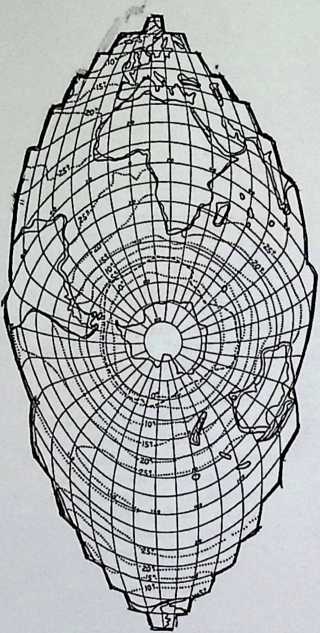 Estate of Robert Smithson, Courtesy James Cohan Gallery, New York
Estate of Robert Smithson, Courtesy James Cohan Gallery, New York
The growing recognition that Fuller enjoyed in the 1950s reached a crescendo in the mid-1960s.28 Fuller wrote several books in short succession and was the subject of extensive press coverage, including a 1964 Time cover story and Calvin Tomkins’s New Yorker profile two years later, reprinted in this volume.29 Fuller was no longer described exclusively in terms of engineer, architect, or inventor. Peter Blake called him “one of the great creators of beautiful sculpture of this century.”30 His writings became increasingly relevant to artists as a dialogue about the relationship between the arts and the sciences grew in import, led by figures such as C. P. Snow and Kepes. In 1965 Fuller contributed “Conceptuality of Fundamental Structures” to Structure in Art and in Science, one of the Vision + Value series edited by Kepes. He wrote, “The brush and chisel artists who, despite the literary man’s frustrations, tried to follow the scientists into ‘non-conceptuality’ with their ‘non-representational’ quasi-abstractions are now proven to have been intuitively sound in their conviction that they could really follow or even lead science in the game of intuitive probing.”31
In John Chandler and Lucy Lippard’s review of the Vision + Value series, entitled “Visual Art and the Invisible World,” they wrote, “What scientists seem to want from art is the method or process of the artist, his powers of visualization an important part of the method of Galileo and early science, but neglected in the last century.” Not surprisingly, Fuller figured prominently in their review, including his assertion that he had finally provided a physical model that artists and scientists alike might use to represent the imperceptible forces around us: “Buckminster Fuller suggests that the major reason for the failure of the public to keep informed about the ‘evoluting realities’ of science was the literary man’s inability to follow into realms where there were no conceptual models or analogies. Visual artists were not only able to enter these realms, but also occasionally lead the way ‘in the game of intuitive probing.’ However, the result was that neither artist nor scientist was understood by the word-stuck public at large. Fuller claims that his own discovery of the ‘natural four axis, 60 degree, tetrahedronal coordinate system’ has returned ‘conceptuality of dynamic structural principles to scientific validity.’,32
Chandler and Lippard’s account of the discussion echoed the “new sensibility” that Susan Sontag had described in her 1965 essay “One Culture and the New Sensibility.” Sontag spoke of a new cultural establishment that unashamedly drew upon scientific developments and was oriented toward the plastic rather than the literary arts. “This new establishment includes certain painters, sculptors, architects, social planners, film-makers, TV technicians, neurologists, musicians, electronics engineers, dancers, philosophers, and sociologists ldots Some of the basic texts for this new cultural alignment are to be found in the writings of… Buckminster Fuller, Marshall McLuhan, John Cage, Andre Breton, Roland Barthes… and Gyorgy Kepes.”33
Fuller’s growing impact was also manifest in the art of the 1960s, one such example being the milestone 1966 exhibition Primary Structures. The show announced the ascendancy of large-scale, geometrically based sculpture in contemporary art. Curator Kynaston McShine used Fuller’s neologism tensegrity to describe Forrest Myers’s contribution and wrote in the catalogue, “Central to many of the principles upon which many of the artists like Forrest Myers work are the structures of Buckminster Fuller. Fuller’s theories, now widely accepted and implemented, have been insights into the dynamic structure of nature, and into the interrelationship of physics, mathematics and philosophy.”34 McShine also drew a connection between Sol LeWitt’s structures and Fuller, describing their white cubic framework as possessing “a logic and structure that seems to be what Fuller described as ‘comprehensive design.’ The modular pattern, which is so fundamental and universal in nature, in this piece assumes extraordinary beauty.”35 Even Time noted in its review that the artists “wax hot for the Geodesic Architect Buckminster Fuller.”36
Several of the artists in Primary Structures showed at the Park Place Gallery, namely Peter Forakis, Robert Grosvenor, and Myers. In his 1966 essay “Entropy and the New Monuments,” Robert Smithson noted that the Park Place Group had “permuted the ‘models’ of R. Buckminster Fuller’s ‘vectoral’ geometry in the most astounding manner.” He continued:
Fuller was told by certain scientists that the fourth dimension was “ha-ha,” in other words, that it is laughter…Laughter is in a sense of kind of entropic “verbalization.” How could artists translate this verbal entropy, that is “ha-ha” into “solid models”? Some of the Park Place artists seem to be researching this “curious” condition. The order and disorder of the fourth dimension could be set between laughter and crystal-structural, as a device for unlimited speculation.37
And yet the art historical accounts of Primary Structures rarely mention Fuller.38 Perhaps this is partly because the Park Place artists are not the ones who, over time, have come to exemplify the Minimalist movement that that exhibition ostensibly baptized.
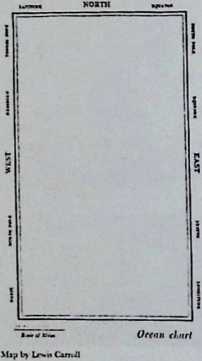 shape of crescents intersect at the ‘ ‘bound’ ’ equator. The “lune” triangulation in this orb detaches itself and becomes secondary “sculpture”.
shape of crescents intersect at the ‘ ‘bound’ ’ equator. The “lune” triangulation in this orb detaches itself and becomes secondary “sculpture”.
"Tknt art aptraxinatrlj 50 Pazarr.a Canals to a cubic milt and then art 317 MILLION cubic mita ej cetin."
R. Buckminster Fuller: Nine Chains to the Moon
R. Buckminster Fuller has developed a type of writing and original cartography, that not only is pragmatic and practical but also astonishing and teratological. His Djmaxion Ptojtclicrt and World Er.rrff Map is a Comonatbia that pros es Ptolemy’s remark that, “no one presents it rigntly unless he is an artist.” Each dot in the World Entry? Map refers to “1 % of World’s harnessed energy slave population (inanimate power serving man) in terms of human equivalents ..says F uller. The use Fuller makes of the “dot” is in a sense a concentration or dilation of an infinite expanse of spheres of energy. The “dot” has its rim and middle, and could be related to Reinhardt’s mandala, Judd’s “device” of the specific and general, or Pascals universe of center and circumference.
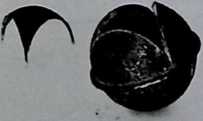
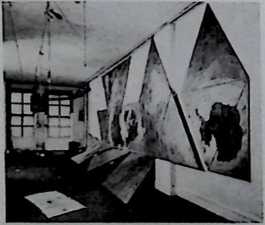
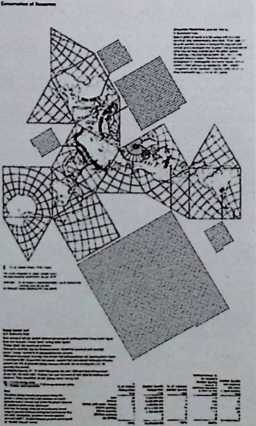 Yet, lhe dot evades our capacity to find its center. Where is die central point, axis, pole, dominant interest, fixed position, absolute structure, or decided goal? The mind is always being hurled lotsards the outer edge into intractable trajectories that lead to vertigo.
Yet, lhe dot evades our capacity to find its center. Where is die central point, axis, pole, dominant interest, fixed position, absolute structure, or decided goal? The mind is always being hurled lotsards the outer edge into intractable trajectories that lead to vertigo.
“Entropy and the New Monuments” was not the only instance in which Smithson cited Fuller.39 Smithson was drawn to Fuller and to Alexander Graham Bell for their attempts to isolate within the disorder of the natural world key organizing principles that could be translated into monumentally scaled artifacts. They saw no conflict between organic structures and modern technology. Fuller’s forays into cartography also provided a precedent for Smithson’s investigations into alternative mapping systems (fig. 5). In his 1968 “A Museum of Language in the Vicinity of Art” Smithson wrote: “R. Buckminster Fuller has developed a type of writing and original cartography, that not only is pragmatic and practical but also astonishing and teratological. His Dymaxion Projection and World Energy Map is a Cosmographia that proves Ptolemy’s remark, that, ‘no one presents it rightly unless he is an artist’ ” (fig. 6).40
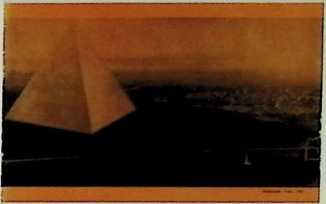
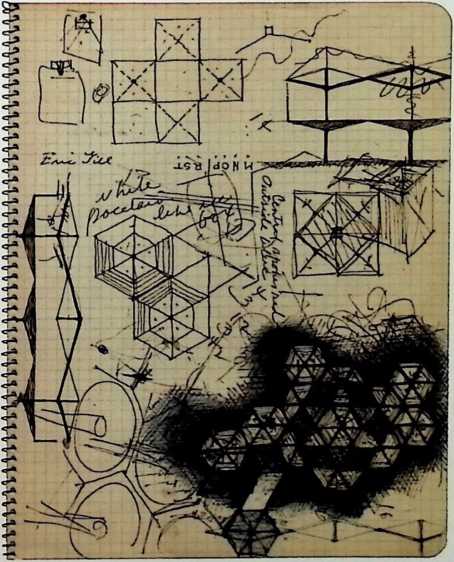 In the spring of 1967, Fuller’s work was included in a show entitled Projects for Macrostructures at the Richard Feigen Gallery in New York. His contribution included the Project for Floating Cloud Structure (the Cloud Nine project), Tetra City, a large-scale floating tetrahedron that could house up to a million people, and Harlem Redesign, a “slum clearing project” that had appeared in a 1965 issue of Esquire (plate 148).41 Ronald Bladen, Christo, Hans Hollein, Claes Oldenburg, and Tony Smith were among the others included in the exhibition. Tetra City was featured on the cover of the March 1967 Arts Magazine with the contentious title “A Minimal Future?” (fig. 7). Dan Graham’s article “Models and Monuments: The Plague of Architecture” considered the Feigen show, as well as two others, prominently
In the spring of 1967, Fuller’s work was included in a show entitled Projects for Macrostructures at the Richard Feigen Gallery in New York. His contribution included the Project for Floating Cloud Structure (the Cloud Nine project), Tetra City, a large-scale floating tetrahedron that could house up to a million people, and Harlem Redesign, a “slum clearing project” that had appeared in a 1965 issue of Esquire (plate 148).41 Ronald Bladen, Christo, Hans Hollein, Claes Oldenburg, and Tony Smith were among the others included in the exhibition. Tetra City was featured on the cover of the March 1967 Arts Magazine with the contentious title “A Minimal Future?” (fig. 7). Dan Graham’s article “Models and Monuments: The Plague of Architecture” considered the Feigen show, as well as two others, prominently
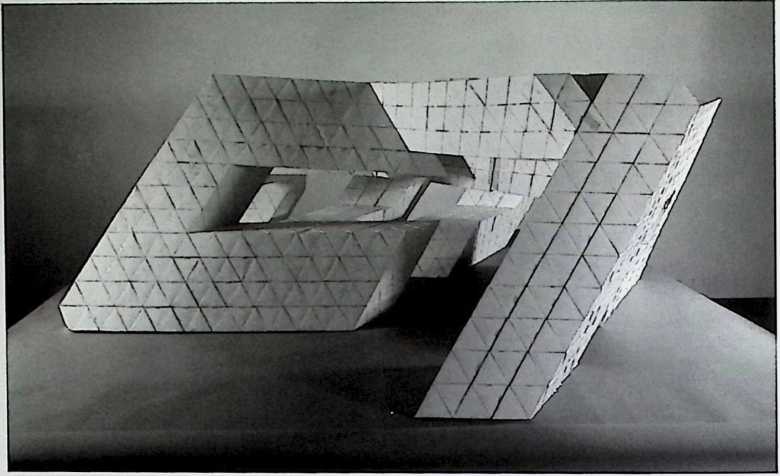
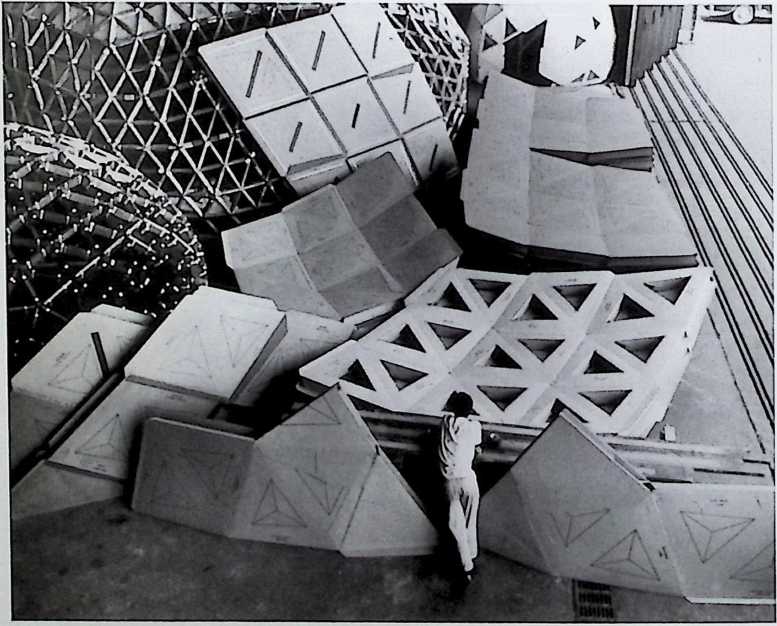
illustrating Fuller’s megastructure projects.42 And yet despite Fuller’s high level of visibility in these art contexts, his significant engagement with the art world of the 1960s goes unnoted in most recent art historical accounts of this period. This significant exchange also remains absent in the literature on Fuller. The one consistent exception is the writing on Kenneth Snelson. One could argue the reverse in his casetoo much of the writing on Snelson revolves around Fuller.
One intriguing area of future investigation might be Tony Smith’s relationship to Fuller. Considering that Smith was well versed in architectural history and cited D’Arcy Thompson and Alexander Graham Bell as influences, the literature on Smith somewhat conspicuously elides Fuller.43 Smith had to have had at least a passing familiarity with Fuller through his friendships with Barnett Newman and Gerome Kamrowski. The hexagons of Smith’s 1950–51 East Hampton church project were admittedly indebted to Thompson and Frank Lloyd Wright but perhaps owed something to Fuller’s Dymaxion House as welland we know that Smith did own copies of plans for Fuller’s house (see fig. S).44 Bat Cave, Smith’s contribution to the 1970 Expo in Osaka, was made in collaboration with the Container Corporation of America. It was composed of thousands of die-cut cardboard tetrahedra and octahedra, a reiterative patterning that was reworked for the Art and Technology exhibition at the Los Angeles County Museum in 1971 (fig. 9). Bat Cave came less than two decades after Fuller collaborated with the Container Corporation of America on die-cut cardboard unit geodesic domes for the 1954 Milan Triennale (fig. 10) .45 Another ripe area for investigation would be to look at Joseph Beuys through the prism of Fuller’s work. The two met in 1974 at the Black and White Oil Conference in Edinburgh, and Beuys made photographic multiples in 1980 to commemorate the event. But even before 1974 Beuys’s work showed an affinity with Fuller’s ideas, not least in his notion of “social sculpture”using aesthetics to help forge a sustainable future.
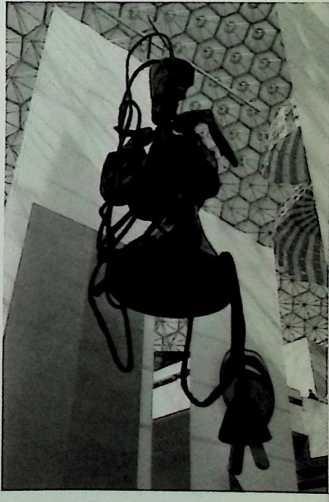 Fuller was never more visible than in summer of 1967, when the three- quarter skybreak sphere he created for the U.S. Pavilion, the most dramatic structure he ever realized, was unveiled at the Montreal Expo46 The pavilion’s theme was “Creative America,” and Alan Solomon was hired to curate a contemporary art exhibition entitled American Painting Now. Solomon selected a show of large-scale paintings, the exception being a soft sculpture by Claes Oldenburg that hung from the roof (fig. 11). Jasper Johns proposed a painting based upon Fuller’s Dymaxion Air-Ocean World Map, thinking “it seemed logical…to make a work which repeated the motif of the structure.”47 Employing Cage as his emissary, Johns obtained Fuller’s permission to use the map in this manner. Johns wrote and thanked him, explaining, “I’m delighted. I intend to hinge the six-foot triangles so that it will be possible to change the form of the picture should it ever have to be shown in different environments.”43 He made the enormous work, his first and only painting of a world map, in his studio in twenty-two separate panels (fig. 12). “The stretcher bars used were angled so that the work could bend to form an icosahedron globe, but the clumsiness and weight of the work made this idea an impossibility.”49 As envisioned, the multipart painting represented a map of possibilities with no single, fixed viewpoint, exemplifying Fuller’s notion of a “fluid geography.” When Johns first saw the painting assembled in Montreal, he was disappointed, feeling it conformed too closely to Fuller’s concept (fig. 13). Over the course of the next four years he reworked it, abandoning the temperature index of Fuller’s map and removing the hinges, among other alterations. Johns described the final result as “a complicated visual experience. It’s both a map and a painting.”50 On December 3, 1971, Cunningham performed Loops at MoMA in front of Johns’s painting, where it had been installed in the Founder’s Room. Slides by Charles Atlas were projected onto the wall, and he was accompanied by music by Gordon Mumma.51
Fuller was never more visible than in summer of 1967, when the three- quarter skybreak sphere he created for the U.S. Pavilion, the most dramatic structure he ever realized, was unveiled at the Montreal Expo46 The pavilion’s theme was “Creative America,” and Alan Solomon was hired to curate a contemporary art exhibition entitled American Painting Now. Solomon selected a show of large-scale paintings, the exception being a soft sculpture by Claes Oldenburg that hung from the roof (fig. 11). Jasper Johns proposed a painting based upon Fuller’s Dymaxion Air-Ocean World Map, thinking “it seemed logical…to make a work which repeated the motif of the structure.”47 Employing Cage as his emissary, Johns obtained Fuller’s permission to use the map in this manner. Johns wrote and thanked him, explaining, “I’m delighted. I intend to hinge the six-foot triangles so that it will be possible to change the form of the picture should it ever have to be shown in different environments.”43 He made the enormous work, his first and only painting of a world map, in his studio in twenty-two separate panels (fig. 12). “The stretcher bars used were angled so that the work could bend to form an icosahedron globe, but the clumsiness and weight of the work made this idea an impossibility.”49 As envisioned, the multipart painting represented a map of possibilities with no single, fixed viewpoint, exemplifying Fuller’s notion of a “fluid geography.” When Johns first saw the painting assembled in Montreal, he was disappointed, feeling it conformed too closely to Fuller’s concept (fig. 13). Over the course of the next four years he reworked it, abandoning the temperature index of Fuller’s map and removing the hinges, among other alterations. Johns described the final result as “a complicated visual experience. It’s both a map and a painting.”50 On December 3, 1971, Cunningham performed Loops at MoMA in front of Johns’s painting, where it had been installed in the Founder’s Room. Slides by Charles Atlas were projected onto the wall, and he was accompanied by music by Gordon Mumma.51
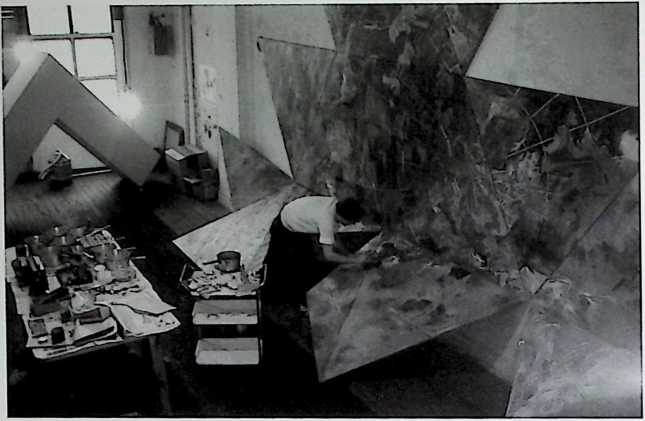
As the 1960s came to a close, the preponderance of unseen forces and vectors that constitute our environment, particularly the electromagnetic spectrum, gained primacy in Fuller’s vast speaking program. His Montreal dome was the epitome of light
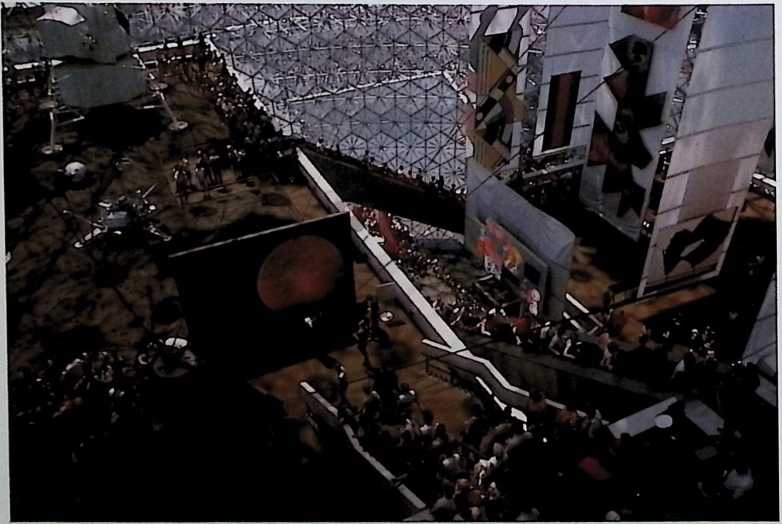
fulness, transparency, and material dilution. This dematerialization of architecture was the logical result of his philosophy of ephemeralization and paralleled the dematerialization of the art object at that time. In his foreword to the exhibition catalogue for Projections: Anti-Materialism, a 1970 show at the La Jolla Museum of Art, Fuller wrote, “When successful, tomorrow’s architecture will be approximately invisible, not just figuratively speaking, but literally as well. What will count with world man is how well the architecture serves all humanity while sublimating itself spontaneously. Architecture may be accomplished tomorrow with electrical field and other utterly invisible environment controls.”52
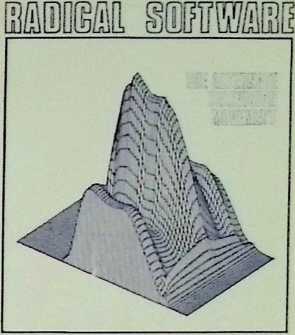
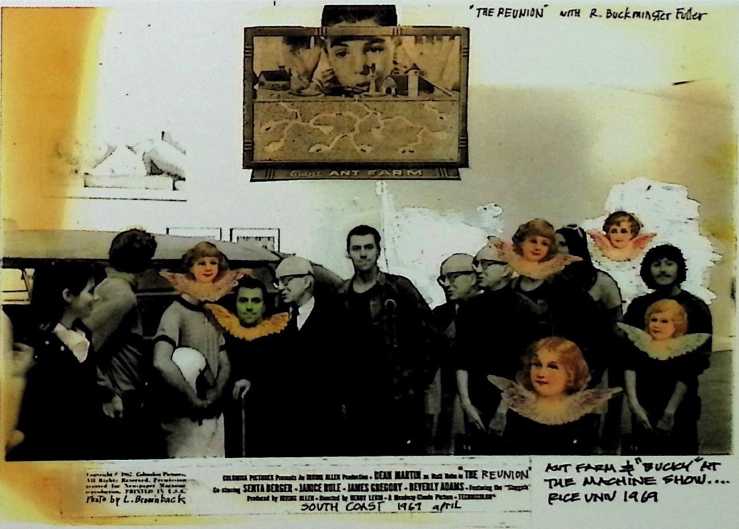 Artists, specifically those engaged with developing media, closely followed Fuller’s emphasis on nonvisible forces, the “ha-ha” that he spoke of and Smithson commented on. Inspired by Fuller, Stan Vanderbeek began to construct his Movie- Drome in 1963. He showed his multiscreen films inside the domed circular building, which was his attempt at a theater of infinite space, “with no ‘edge’ to the screen …a total Envelope-Environmentallowing an almost endless amount of image material to flow over you and around the Drome.”53 The collective Raindance published the alternative television movement journal Radical Sojtware, which included a pirated interview with Fuller in its first issue in 1970 (fig. 14). Ant Farm and USCO were two of the several other antiestablishment collectives influenced by Fuller’s work. The members of Ant Farm considered him a hero and “the lone voice in the wilderness among architects and engineers.”54 In 1969 they “kidnapped” Fuller on
Artists, specifically those engaged with developing media, closely followed Fuller’s emphasis on nonvisible forces, the “ha-ha” that he spoke of and Smithson commented on. Inspired by Fuller, Stan Vanderbeek began to construct his Movie- Drome in 1963. He showed his multiscreen films inside the domed circular building, which was his attempt at a theater of infinite space, “with no ‘edge’ to the screen …a total Envelope-Environmentallowing an almost endless amount of image material to flow over you and around the Drome.”53 The collective Raindance published the alternative television movement journal Radical Sojtware, which included a pirated interview with Fuller in its first issue in 1970 (fig. 14). Ant Farm and USCO were two of the several other antiestablishment collectives influenced by Fuller’s work. The members of Ant Farm considered him a hero and “the lone voice in the wilderness among architects and engineers.”54 In 1969 they “kidnapped” Fuller on
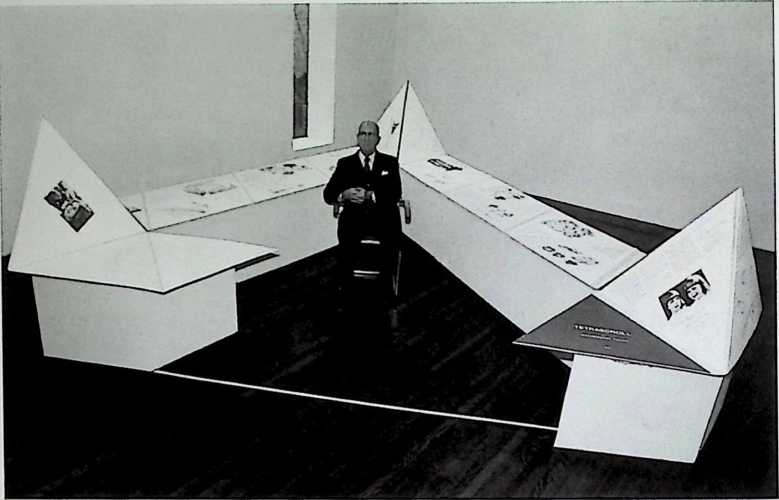
his way to a lecture at the University of Houston’s engineering school. Instead of delivering him to the school, they took him to see his Dymaxion car in the exhibition The Machine at the End of the Mechanical Age, which was on tour in Houston at the time (fig. 15). Their 1970 Inflatocookbook illustrated Energy Credit, an invented paper currency that incorporated Fuller’s visage and a geodesic dome in its design. Fuller penned the introduction to Gene Youngblood’s seminal Expanded Cinema, the first book to treat video as an art medium. He wrote: “Humans still think in terms of an entirely superficial game of static things solids, surfaces, or straight linesdespite that no things no continuumsonly discontinuous, energy quanta-separate event packages operate as remotely from one another as the stars of the Milky Way. Science has found no ‘things’; only events. Universe has no nouns; only verbs.”55
In February 1975 Fuller’s friend Edwin Schlossberg took him to the print workshop Universal Limited Artist Editions as an eightieth-birthday present. There Tatyana Grosman, the proprietor, introduced Fuller to lithography, which he took to immediately. He began crafting a version of the story “Goldilocks and the Three Bears,” retold to explain the mysteries of the universe and the possibilities for mankind’s future. “I know that we have the option to make it. That’s different than being optimistic. It’s touch and go. Goldy is very concerned. That’s what this is all about. I’m interested in making artifacts that give us options.”55
Characteristically, Fuller rejected the traditional rectangular structure of a book and created the Tetrascroll from twenty-six triangular pages (plates 164). Written in all caps with minimal punctuation, the text included an “epilever” rather than an “epilogue” by Schlossberg. The color was to match a seagull feather, and the
book was bound using Dacron, a material frequently used in sailing. Each hinged page of the book can be folded in multiple directions, creating numerous possible configurations of the Tetrascroll, much like his Dymaxion maps and Johns’s vision for his painting. In January of 1977, as part of their Projects series MoMA installed the Tetrciscroll along two perpendicular walls in proximity to an installation of Cage’s work.57 A second print was exhibited almost simultaneously on tables arranged in a V shape at Ronald Feldman Fine Arts, and a third was shown at the Fendrick Gallery in a tetrahedronal frame structure (figs. 16 and 17). Fuller called the Tetrascroll “everything I think and feel in mathematics and philosophy and everything else.” Grossman described it as “a very beautiful achievement by an artist, a pure vision expressed in lithography.”58
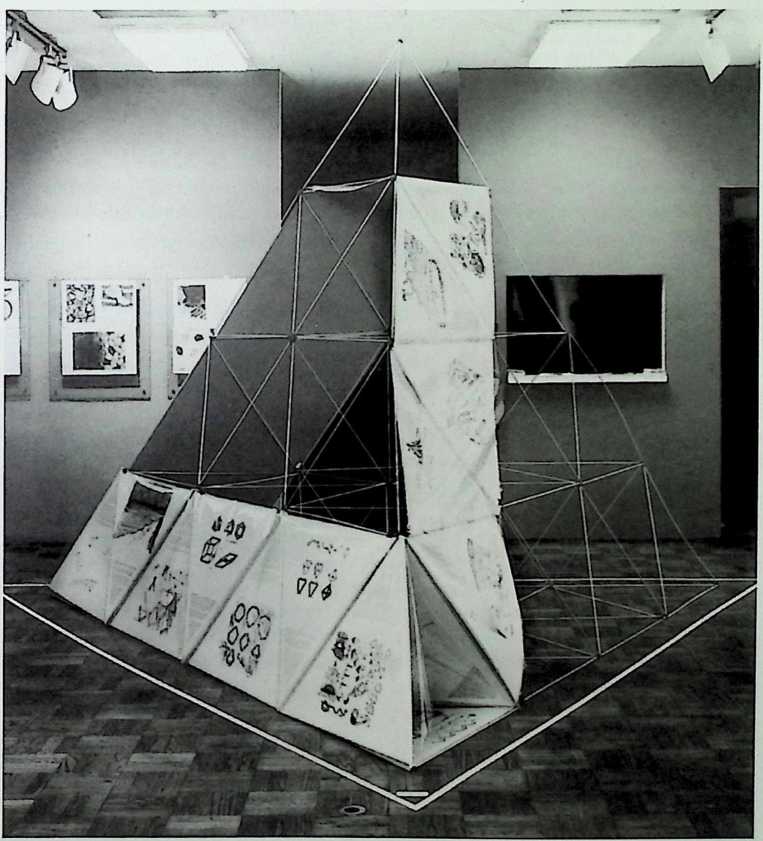
After Grossman’s death in 1982, Calvin Tomkins wrote an homage listing some of the artists she had worked with through the years. Johns was among those, but Fuller was not. Slighted, Fuller wrote Tomkins a somewhat bitter but telling missive:
It seems unreasonable for Jasper Johns to be rated as an artist because he employs the beauty and whole unique lay-out, shape, and color of my Dymaxion Sky-Ocean World Map to make his 50 foot hanging for the Expo dome in Montreal in 1967 as an art form, and that Jasper Johns would later receive a $150,000 price for a somewhat modified form of a picture of my map, and not even think of offering any of it to me.59
Fuller’s intersection with the artistic avant-garde spanned an astonishing period of the twentieth century, from Romany Marie’s to the explosion of video and new media art in the 1970s. Throughout this time Fuller remained focused on locating, representing, and utilizing patterns in nature, and toward the end of his life he chose to represent his investigations in several formal artistic modes. Yet he stated that it was his “life long working assumption that the name ‘artist,’ ‘poet’ or ‘musician’ can only be bestowed on individuals by contemporary of later society, that these titles cannot be professed.”60 While he was alive, there were those who considered him an artist, including Marshall McLuhan, who called him the Leonardo da Vinci of the twentieth century. Since his death the number of those who refer to him as an artist has dramatically increased.61 Certainly one can argue that Fuller’s adult life was a single performative experiment; indeed, he called himself Guinea Pig B for that very reason. He believed artists were essential to society because they could broaden our range of perception and fuel our imagination. He saw patterns and built structures that represented as yet unverified forces in nature, including what would later be known as the Ceo carbon molecule. Fuller expanded our options for the future; thus, by his own definition, he was unquestionably a scientist-artist of the highest order.
Notes
Epigraph. Buckminster Fuller, foreword to Projections: Anti-Materialism (La Jolla, Calif.: La Jolla Museum of Art, 1970), n.p.
-
From Dorothy Harley Eber, “Prologue: An Interview with Buckminster Fuller,” in Genius at Work: Images of Alexander Graham Bell (New York: Viking Press, 1982), 11. Fuller delved into other “important-design-influence experiences” in a fourteen-page letter to John McHale dated January 7,1955, M1090, ser. 4, box 2, folder 1, R. Buckminster Fuller Papers, Department of Special Collections, Stanford University Libraries.
-
Even after he received his glasses at age four, Fuller claimed that he was preternaturally attuned to the patterns around him. “Good luck for me I was bom cross-eyed.” As quoted in Deborah Shapely, “Declaration of War Was Commencement for Class of 1917,” Harvard Crimson, June 13, 1967.
-
Fuller noted that resistance to specialization is often interpreted by the school system as delinquency or a learning disability, with the result that many such youths drop out of school and become “minor outlaws or artists using sounds or visual compositions in which they can safely use their own language to say anything they want about the going order of life.” As quoted in Howard Taubman, “Environment as Key to Achievement Is Theme of R. Buckminster Fuller,” New York Times, November 28, 1967.
-
Fuller, “Emergent Humanity: Its Environment and Education,” from R. Buckminster Fuller on Education, reprinted in Buckminster Fuller: Anthology for a New Millennium, ed. Thomas Zung (New York: St. Martin’s Griffin, 2001), 114.
-
Fuller, introduction to Gene Youngblood, Expanded Cinema (New York: E. P. Dutton, 1970), 20.
-
From a talk Buckminster Fuller presented at a dinner of the American Academy and Institute of Arts and Letters in New York on January 18, 1978, published as “Josef Albers (1888-1976)” in Leonardo 11, no. 4 (Autumn 1978): 311.
-
Beginning in 1898 Bell worked in his laboratory in Baddeck, Nova Scotia, on a series of tetrahedral structureskites and towers in particular. He also worked on a hydrofoil craft he called the HD, and in 1919 the fourth version, HD-4, set a world marine speed record.
-
From Eber, “Interview with Buckminster Fuller,” 9.
-
The book was the first entry listed in “Live Book Squad (The mobile ‘shelf’ [footlocker] of B. Fuller as of September, 1949),” M1090, subser. 25, box 8, folder 4, Fuller Papers.
-
Fuller, An Autobiographical Monologue/ Scenario, ed. Robert Snyder (New York: St. Martin’s Press, 1980), 61.
-
Ibid., 62.
-
The fascinating relationship between Fuller and Noguchi has been explored in depth in the recent exhibition Best of Friends: Buckminster Fuller and Isamu Noguchi at the Noguchi Museum (May 19-October 15, 2006), and will be expanded in a forthcoming book by its curator, Shoji Sadao.
-
Robert Schulman, Romany Marie: The Queen of Greenwich Village (Louisville, Ky.: Butler Books, 2006), 105.
-
Ibid., 106.
-
Letter from John Dixon, Fuller’s assistant, to Donald Robertson, dated December 6,1954, M1090, ser. 4, box 2, folder 4, Fuller Papers.
-
For a thorough account of the summer of 1948 see Mary Emma Harris, The Arts at Black Mountain College (Cambridge, Mass.: MIT Press, 1987). Other good sources on Fuller and BMC include Eva Diaz, “Experiment, Expression, and the Paradox of Black Mountain College,” in Starting at Zero: Black Mountain College, 1933 (Bristol, England: Amolfini; Cambridge, Kettle’s Yard, 2006); Martin Duberman, Black Mountain: An Exploration in Community (New York: W. W. Norton, 1993); and Vincent Katz, ed., Black Mountain College: Experiment in Art (Madrid: Museo Nacional Centro de Reina Sofia, 2002).
-
Josef Albers, letter to Bertrand Goldberg, July 14,1948, general files 2, box 12, folder Fuller, Bucky, 1948, Black Mountain College Records, 1933, courtesy North Carolina Office of Archives and History, Raleigh. Quoted with permission of the Josef and Anni Albers Foundation. Goldberg had met Albers at the Bauhaus when he studied there in 1932. They became reacquainted when Albers and his wife fled Europe and settled in the United States. Goldberg may have suggested Fuller after turning down Albers’s invitation for that summer himself. Fuller had been so slow to respond to Albers’s invitation that he invited another architect, Charles Burchard, a professor at Harvard. In the end both Burchard and Fuller taught at the college that summer.
-
In 1939 Fuller wrote to Frederick Kielser about the Bauhaus and its offshoots in the United States: “Nothing seems more fatuous than esthetically emotional exclamations of ‘appreciation’ of the physical properties of the myriad new materials by so called ‘industrial designers,’ which exclamation on one hand indicate that the speaker anticipates public acclaim for his perspicacity in making the ‘discovery’ and, on the other hand, infers that the anonymous industrial individuals who have spent years in developing the materials should have been so blind as to expend that effort unwitting the dynamics and potentials of their endeavor.” Letter to F. J. Kiesler, April 14, 1939, Research Library, The Getty Research Institute, Los Angeles, California (850940). Although Albers’s Homage to the Square series is commonly described as originating in 1949, Fuller recounted being present at this seminal moment. “One Sunday morning in August, 1948, when I was fortunate enough to be present, Albers developed his system of simple arrangements of squares within squares as explicit articulations of his color harmonies.” From Fuller, “Josef Albers (1888-1976),” Leonardo 11, no. 4 (Autumn 1978): 311. Fuller described the Homage to the Square series as a set of generalized principles discovered by Albers.
-
Interview with Merce Cunningham, from PBS American Masters, Buckminster Fuller: Thinking Out Loud, http://www.thirteen.org/bucky/merce.html (accessed August 23, 2007).
-
Mary Emma Harris, interview with Buckminster Fuller, October 3, 1971, box 30, folder Fuller, Buckminster, transcript p. 34, Black Mountain College Research Project (1933), North Carolina State Archives, Raleigh.
-
Ruth Asawa and Albert Lanier remembered that Fuller’s sense of the world as a united entity was fairly novel and somewhat controversial. Immediately following World War II, this notion was perceived by some to be anti-American. Interview with the author, February 21, 2007.
-
Richard Kostelantz, ed., “Conversation with John Cage,” in John Cage (New York: Praeger, 1970), 10. For a discussion of Cage and Fuller, see Branden Joseph, “Hitchhiker in an Omni-Directional Transport: The Spatial Politics of John Cage and Buckminster Fuller,” ANY 17 (1997): 40.
-
Kenneth Snelson, interview with the author, May 21, 2007.
-
For further discussion of the complicated relationship between Fuller and Snelson, see transcript for Mary Emma Harris, interview with Kenneth Snelson, May 25, 1972, box 37, folder Snelson, Kenneth, Black Mountain College Research Project (1933-73), North Carolina State Archives, Raleigh; Katz, Black Mountain College; Duberman, Black Mountain; and https://www.grunch.net/snelson/.
-
Mark Wigley, “Planetary Homeboy,” ANY 17 (1997): 20.
-
Letter from Fuller to Gyorgy Kepes, dictated to his assistant, John Dixon, and dated December 20, 1954, M1090, ser. 4, box 2, folder 1, Fuller Papers.
-
Arthur Drexler, text of wall label for “Structures by Buckminster Fuller,” Buckminster Fuller artist file, library of the Museum of Modem Art, New York.
-
See K. Michael Hays in this volume for an account of Fuller’s growing reputation in the 1950s.
-
Nine Chains to the Moon, published in 1938, was Fuller’s only book available in any significant quantity in the United States before 1962. Fuller published several major books in the 1960s: Untitled Epic Poem on the History of Industrialization and Education Automation in 1962, Ideas and Integrities, No More Secondhand God and Other Writings, and a reprint of Nine Chains to the Moon in 1963, and Operating Manual for Spaceship Earth, 50 Years of Design Science Revolution and the World Game, and Utopia or Oblivion in 1969.
-
Peter Blake, “Five Shapers of Todays Skyline,” New York Times, October 21, 1962.
-
Fuller, “Conceptuality of Fundamental Structures,” in Structure in Art and in Science, ed. Gyorgy Kepes (New York: George Braziller, 1965), 80.
-
John Chandler and Lucy R. Lippard, “Visual Art and the Invisible World,” Art International 11, no. 5 (May 1967): 27.
-
Susan Sontag, “One Culture and the New Sensibility,” in Against Interpretation and Other Essays (New York: Noonday Press, 1966), 298.
-
Kynaston McShine, introduction to Primary Structures: Younger American and British Sculptors (New York: Jewish Museum, 1966), n.p.
-
Ibid.
-
“Engineer’s Esthetic,” Time, June 3, 1966.
-
Robert Smithson, “Entropy and the New Monuments,” Artforum 4 (June 1966): 31.
-
Linda Dalrymple Henderson is one of the few to discuss Fuller’s influence on the Park Place Group. See “Dean Fleming, Ed Ruda, and the Park Place Gallery” in Blanton Museum of Art: American Art since 1900 (Austin, Tex.: Blanton Museum of Art, 2006), 379–87.
-
Among the other essays in which Smithson cites Fuller are “The Artist as Site-Seer; Or, a Dintorphic Essay” (1966-67) m Robert Smithson: The Collected Writings, ed. Jack Flam (Berkeley: University of California Press, 1996), 342; and “Towards the Development of an Air Terminal Site,” Artforum 5 (Summer 1967): 37. Both of these essays also mention Alexander Graham Bell. Smithson also discusses Fuller and entropy in an interview with Alison Sky published as “Entropy Made Visible,” On Site 4 (1973).
-
From “A Museum of Language in the Vicinity of Ait,” Art International 12, no. 3 (March 1968): 27. By 1971 Smithson had characterized Fuller as a utopian and distanced himself from Fuller’s program: “Unlike Buckminster Fuller, I’m interested in collaborating with entropy…After all, wreckage is often more interesting than structure. At least, not as depressing as Dymaxion domes. Utopian saviors we can do without.” From an interview with Gregoire Muller, published as “The Earth …Is a Cruel Master,” Arts Magazine 46, no. 2 (November 1971): 40.
-
June Meyer, “Instant Slum Clearance,” in Esquire 63, no. 4 (April 1965): 108–11.
-
The other two exhibitions were Scale Models and Drawings at the Dwan Gallery and Architectural Sculpture, Sculpture Architecture, at the Visual Arts Gallery. For more discussion on 1960s megastructures, see Hays’s essay in this volume.
-
Chandler and Lippard briefly group Fuller and Smith together: “The organic structure of Tony Smith’s sculptures and Buckminster Fuller’s geodesic domes may be difficult to discern, yet both find the source of their tetrahedral structure in nature.” John Chandler and Lucy R. Lippard, “Visual Art and the Invisible World,” Art International 11, no. 5 (May 1967): 29. Later that year Lippard took pains to distinguish between the two in an essay on Smith, writing in a footnote: “There are areas in which Smith’s ideas, particularly as regards tetrahedral construction and continuity, seem to have affinities with those of Buckminster Fuller. In fact the two have very little in common, and Fuller’s incontestable influence on art has been in an intellectual rather than an esthetic sphere.” Lucy R. Lippard, “Tony Smith: The Ineluctable Modality of the Visible,”, Art International 11, no. 6 (Summer 1967): 27.
-
Joan Pachner explains, “While he later denied any interest in Fuller, Smith did own a set of blueprints for Fuller’s Dymaxion House; it is uncertain when he obtained them.” See Pachner, Tony Smith: Architect, Painter, Sculptor (Ph.D. diss., New York University, 1993), 85.
-
W. Paepcke, president of CCA, was a supporter of Fuller’s. Paepcke was also a patron of Herbert Bayer and Laszld Moholy-Nagy, whom he helped start the American Bauhaus in Chicago. In 1950 Paepcke founded the Aspen Institute, where Fuller became a regular visitor.
-
Among the other architects considered for the U.S. Pavilion were John Johansen, Philip Johnson, Ludwig Mies van der Rohe, and Paul Rudolph. Marcel Breuer sent an unsolicited submission. According to Jack Masey, it was Peter Chermayeff of Cambridge Seven Associates who suggested that Fuller build a three-quarter sphere rather than a hemispherical dome. Later Fuller showed Masey sketches from several decades before in which he had depicted a three-quarter dome. Masey had first met Fuller when he, under the auspices of the United States Information Agency (USIA), asked Fuller to contribute a geodesic dome to the Jeshyn trade fair in Kabul, Afghanistan, in 1956. They worked together again in 1959 on the Moscow fair dome. Jack Masey, interview with the author, May 8, 2007. For a detailed discussion of the U.S. Pavilion, see Jonathan Massey, “Buckminster Fuller’s Cybernetic Pastoral: The United States Pavilion at Expo 67,” Journal of Architecture 11, no. 4 (September 2006): 463–83.
-
Jasper Johns in a letter to the author, September 12, 2007.
-
Jasper Johns in a letter to Fuller, January 23, 1967, M1090, ser. 2, box 154, folder 2, Fuller Papers. Solomon was initially under the impression that Johns would not be able to contribute a new work and was prepared to borrow Johns’s large painting Studio II from private collectors. Letter from Alan Solomon to Victor Ganz, December 7,1966, Alan R. Solomon Papers, Archives of American Art.
-
Johns to author, September 12, 2007.
-
“Heasure Map,” Newsweek, February 15,1971,90.
-
In February 1971 newspapers reported on the rumor that the German collector Peter Ludwig had bought Map, which prompted MoMA to install the work before it left the country. Their Founder’s Room was the only space large enough to accommodate the work. See chronology in Kirk Vamedoe, Jasper Johns: A Retrospective (New York: Museum of Modem Art, 1997), 239.
-
Fuller, foreword to Projections: Anti-Materialism (La Jolla, Calif.: La Jolla Museum of Art, 1970), n.p.
-
Stan Vanderbeek, quoted in Douglas Davis, Art and the Future (New York: Praeger, 1973), 49.
-
Doug Michels, from “Interview with Ant Farm,” in Connie M. Lewallen and Steve Seid, Ant Farm, 1968–1978 (Berkeley and Los Angeles: University of California Press, 2004), 44.
-
Buckminster Fuller, introduction to Gene Youngblood, Expanded Cinema (New York: E. P. Dutton, 1970), 24.
-
As quoted in Amei Wallach, “Bucky and Tatyana,” Newsday, February 6, 1977.
-
Cage had two works on display, Apartment House 1776 and Renga, a system of graphic notation using tracings of drawings from Henry David Thoreau’s journals.
-
Amei Wallach, introduction to Tetrascroll, Goldilocks and the Three Bears: A Cosmic Fairy Tale, by R. Buckminster Fuller (New York: St. Martin’s Press, 1975), x.
-
Letter from Fuller to Calvin Tomkins, dated October 6, 1982, M1090, ser. 7, box 6, folder 3, Fuller Papers.
-
Ibid.
-
Victoria Vesna, “Bucky Beat,” Artbyte 1, no. 3 (August-September 1998): 22–29; Linda Weintraub, “I Seem to Be a Verb: R. Buckminster Fuller as Pioneering Eco-Artist,” Art Journal 65, no. 1 (Spring 2006): 65–66; Wigley, “Planetary Homeboy.”
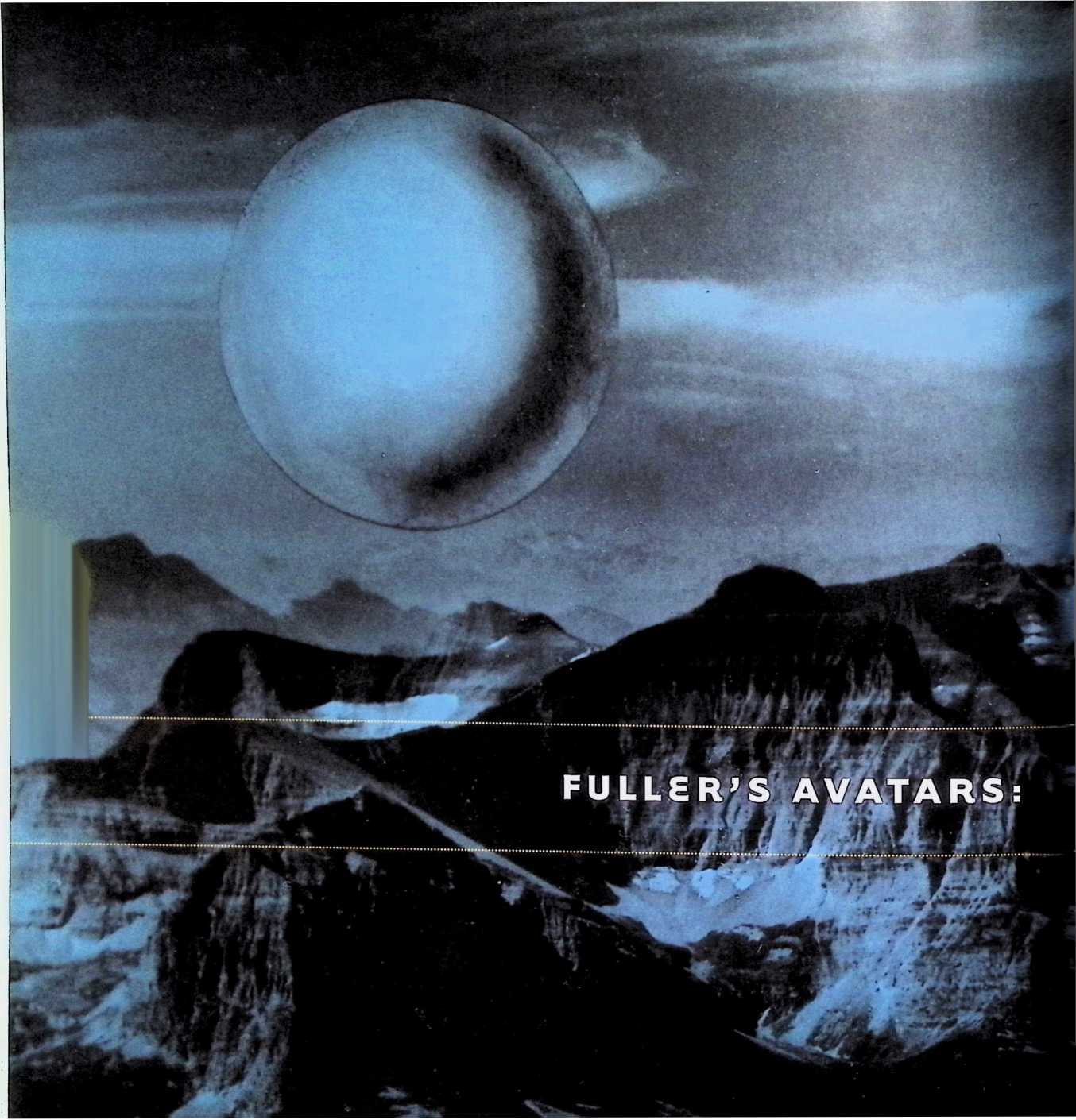
if
VIEW FROM THE PRESENT
ANTOINE PICON
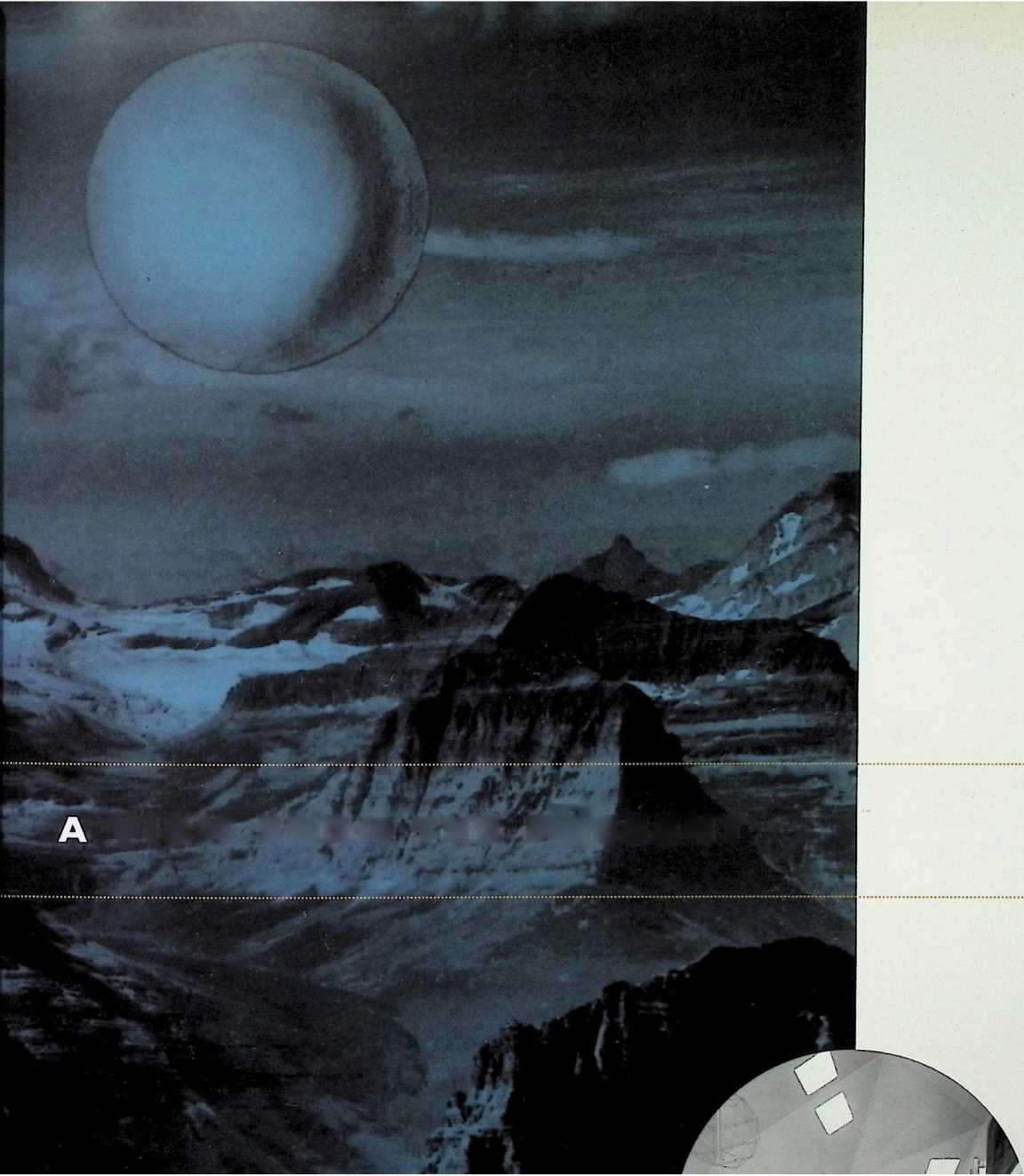
Ok here are many Buckminster Fullers. A rapid survey reveals F the existence of a series of contrasting figures: the marginal inventor of the 1920s and the world-famous prophet of the 1960s and s, the protege of the U.S. military and the inspiration for alternative communities like Drop City,1 the advocate of technological progress and rationalization and the defender of the environment. Paradoxically, this confusion has been created by Fuller’s endless attempts to explain himself through books, articles, and lectures, not to mention the systematic recording of his life in his Dymaxion Chronofile. His wish to be transparent, like a rigorously defined experimentto use one of his favorite characterizations of his attitude toward life2 has produced the opposite effect: an impression of opacity generated by an overabundance of details.
A closer study of Fuller’s trajectory reveals, however, the persistence of themes and preoccupations, like his transcendentalist emphasis on the creative power of the individual, or his desire to promote a “revolution in design.”3 These themes and preoccupations are not distributed randomly. They organize themselves along axes that make it possible to reconstruct another series of avatars of Buckminster Fuller. Are those avatars closer to what the man was in reality than those I mentioned earlier? The answer is difficult to give. At least, because they are the direct product of our power of investigation, they correspond to the reasons we have to be interested still in Fuller’s work today.
In this essay, I would like to explore two possible interpretations of Buckminster Fuller. The first relates him to the emergence of the society of information and communication. Due to projects like his World Game, Fuller is often presented as a forerunner of digital culture. What can be said about his relation to information, communication, network, computing, and simulation? It is striking to observe how this kind of question has replaced former inquiries regarding Fuller’s contribution to structural design.
The utopian constitutes the other avatar of Buckminster Fuller that I will deal with. Contrary to the information-age Fuller, Fuller the utopian has always been a widely discussed subject. In the 1960s and s, critics were generally fascinated by the brave new world he promised in his books and lectures. Later, his optimistic take on the capacity of man to steer “Spaceship Earth” was seen as typical of the demagogic and technocratic tendencies of the postwar period.4 In connection with the emergence of a digital Fuller, the utopian dimension is probably acquiring a new meaning today.
After a long purgatory, utopia is indeed reappraised, not necessarily in terms of a global, well-crafted project, another ideal city after all those that have been produced from the Renaissance on, but as the promise that, with a proper course of action, something different can take place in the near future. In the digital realm, we are no longer fascinated by the discourses on the Global Village that accompanied the creation and early developments of the Internet. The Global Village perspective was, after all, nothing but the ideal city reinvented. In recent years, we have become more sensitive to the notion that utopia is less a definitive state of affairs than an open-ended process, a process that should furthermore empower the individual instead of giving precedence to impersonal collectives. And this is perhaps where Fuller might fit in, despite the colossal dreams of Cloud Nine or Tetra City, as a passionate advocate of utopia as a process giving a key role to the individual. The ultimate expression of his utopian vision, the World Game, was after all a process. This may account for the fascination the endeavor exerts on so many of us today. Just like “digital Fuller,” Fuller the utopian definitely belongs to our present.
“Digital Fuller”
From the very beginning of his career, Fuller displayed interests that were clearly related to information and communication. He was, for instance, obsessed with figures and statistics that he collected from all kinds of sources, from daily newspapers to the proceedings of the American Statistical Association. Above all, he was fascinated by the phone and the radio, and their potential to transform everyday life. The proposals and perspectives he elaborated in the 1920s and s under the generic title of 4D or Dymaxion already spoke to the society of information and digital culture, with its trends toward universal mobility, delocalization, and mass customization (see plates 5 and 15).
Fuller’s society of the future was characterized by a fluidity of communication that allowed individuals to live pretty much everywhere on the surface of the earth, including the two poles. Why should one have a New York Stock Exchange when one could imagine a “mechanical stock exchange” functioning at the scale of the entire planet? 5 Why have localized schools and universities when one could teach children, young men, and women at home, using radio broadcasting? 6 Material production itself could be decentralized along the main transportation infrastructures, roads and railways, according to the pattern imagined by Fuller for the production and temporary storage of his Dymaxion Houses.7 Never was Fuller as prescient as when he announced the possibility that mass media could satisfy individual preferences, foreshadowing the principle of generalized customization Nicholas Negroponte proclaimed in his influential best seller Being Digital.8
This fluidity found its implicit counterpart in the creation of global organizations, like the ones that would replace the existing stock exchange and the various schools and universities. The Dymaxion universe was actually far more ambiguous in that respect than its creator officially acknowledged, an ambiguity that was to form the germ of the enduring tension between individualistic and technocratic leanings typical of Fuller’s later proposals. In that respect too, the author of 4D Time Lock and Nine Chains to the Moon announced the fundamental ambivalence of our
society of information and communication, with its constant oscillation between the desire for individual freedom and the simultaneous need for coordination and control.
Fuller was not the only one to set out on this path. Where he was perhaps especially farsighted was in his understanding of the fundamentally strategic ability required to cope with massive flows of information. While one could survive as a tactician in the traditional industrial society, a new world of highly strategic choices was gradually unfolding, in step with the proliferation of data and the explosive growth of telecommunication. This world was in dire need of visualization techniques to make choices easier. From his Dymaxion Air-Ocean World Map to his postwar Geoscope and World Game, a number of Fuller’s inventions are related to our need, in an information-based society, to distinguish patterns and trends where we previously saw only forms and backgrounds.
As a technical adviser to the magazine Fortune from 1938 to 1940, Fuller could already present himself as having a special talent for seeing patterns and trends. Indeed, some of the charts he produced for the magazine, like Dynamics of Progress, Comparison of U.S. Economy with the Rest of the World, or Profile of the Industrial Revolution were quite remarkable (figs. 1 and 2). The experience of World War II reinforced this talent through episodes like his working, alongside filmmakers,
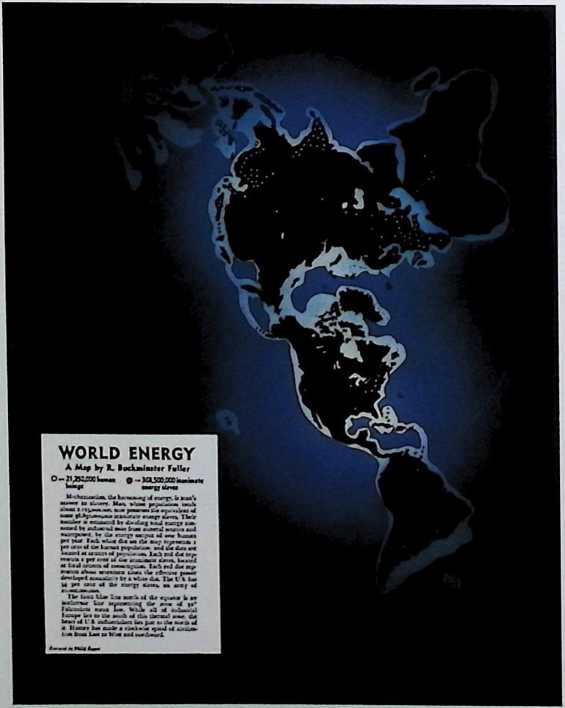
World Energy Map, as published in 1 Fortune, February 1940
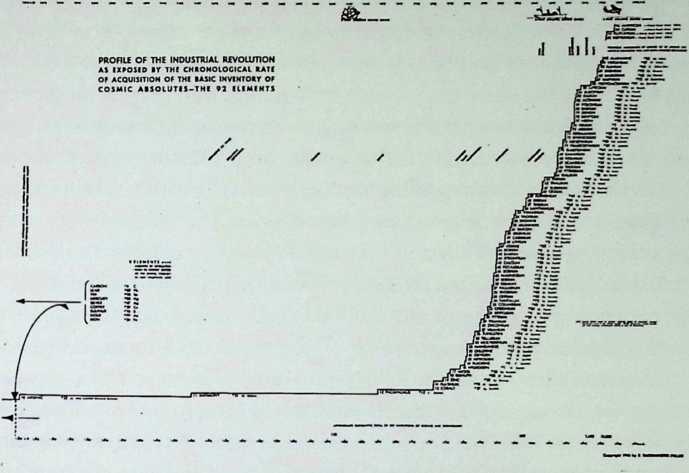
Profile of the Industrial Revolution as : Exposed by the Chronological Rate of Acquisition of Basic Inventory of Cosmic Absolutes the 92 Elements,
-
j 1946
-
Sketch illustrating an early conception of the Geoscope, 1948
¶ A View from the Present
Antoine Picon
There are many Buckminster Fullers. A rapid survey reveals the existence of a series of contrasting figures: the marginal inventor of the 1920s and the world-famous prophet of the 1960s and ‘70s, the protégé of the U.S. military and the inspiration for alternative communities like Drop City,[7] the advocate of technological progress and rationalization and the defender of the environment. Paradoxically, this confusion has been created by Fuller’s endless attempts to explain himself through books, articles, and lectures, not to mention the systematic recording of his life in his Dymaxion Chronofile. His wish to be transparent, like a rigorously defined experimentto use one of his favorite characterizations of his attitude toward life[8]has produced the opposite effect: an impression of opacity generated by an overabundance of details.
A closer study of Fuller’s trajectory reveals, however, the persistence of themes and preoccupations, like his transcendentalist emphasis on the creative power of the individual, or his desire to promote a “revolution in design.”[9] These themes and preoccupations are not distributed randomly. They organize themselves along axes that make it possible to reconstruct another series of avatars of Buckminster Fuller. Are those avatars closer to what the man was in reality than those I mentioned earlier? The answer is difficult to give. At least, because they are the direct product of our power of investigation, they correspond to the reasons we have to be interested still in Fuller’s work today.
In this essay, I would like to explore two possible interpretations of Buckminster Fuller. The first relates him to the emergence of the society of information and communication. Due to projects like his World Game, Fuller is often presented as a forerunner of digital culture. What can be said about his relation to information, communication, network, computing, and simulation? It is striking to observe how this kind of question has replaced former inquiries regarding Fuller’s contribution to structural design.
The utopian constitutes the other avatar of Buckminster Fuller that I will deal with. Contrary to the information-age Fuller, Fuller the utopian has always been a widely discussed subject. In the 1960s and ‘70s, critics were generally fascinated by the brave new world he promised in his books and lectures. Later, his optimistic take on the capacity of man to steer “Spaceship Earth” was seen as typical of the demagogic and technocratic tendencies of the postwar period.[10] In connection with the emergence of a digital Fuller, the utopian dimension is probably acquiring a new meaning today.
After a long purgatory, utopia is indeed reappraised, not necessarily in terms of a global, well-crafted project, another ideal city after all those that have been produced from the Renaissance on, but as the promise that, with a proper course of action, something different can take place in the near future. In the digital realm, we are no longer fascinated by the discourses on the Global Village that accompanied the creation and early developments of the Internet. The Global Village perspective was, after all, nothing but the ideal city reinvented. In recent years, we have become more sensitive to the notion that utopia is less a definitive state of affairs than an open-ended process, a process that should furthermore empower the individual instead of giving precedence to impersonal collectives. And this is perhaps where Fuller might fit in, despite the colossal dreams of Cloud Nine or Tetra City, as a passionate advocate of utopia as a process giving a key role to the individual. The ultimate expression of his utopian vision, the World Game, was after all a process. This may account for the fascination the endeavor exerts on so many of us today. Just like “digital Fuller,” Fuller the utopian definitely belongs to our present.
“Digital Fuller”
From the very beginning of his career, Fuller displayed interests that were clearly related to information and communication. He was, for instance, obsessed with figures and statistics that he collected from all kinds of sources, from daily newspapers to the proceedings of the American Statistical Association. Above all, he was fascinated by the phone and the radio, and their potential to transform everyday life. The proposals and perspectives he elaborated in the 1920s and ‘30s under the generic title of 4D or Dymaxion already spoke to the society of information and digital culture, with its trends toward universal mobility, delocalization, and mass customization (see plates 5 and 15) Change: add refs .
Fuller’s society of the future was characterized by a fluidity of communication that allowed individuals to live pretty much everywhere on the surface of the earth, including the two poles. Why should one have a New York Stock Exchange when one could imagine a “mechanical stock exchange” functioning at the scale of the entire planet? [11] Why have localized schools and universities when one could teach children, young men, and women at home, using radio broadcasting?[12] Material production itself could be decentralized along the main transportation infrastructures, roads and railways, according to the pattern imagined by Fuller for the production and temporary storage of his Dymaxion Houses.[13] Never was Fuller as prescient as when he announced the possibility that mass media could satisfy individual preferences, foreshadowing the principle of generalized customization Nicholas Negroponte proclaimed in his influential best seller Being Digital.[14]
This fluidity found its implicit counterpart in the creation of global organizations, like the ones that would replace the existing stock exchange and the various schools and universities. The Dymaxion universe was actually far more ambiguous in that respect than its creator officially acknowledged, an ambiguity that was to form the germ of the enduring tension between individualistic and technocratic leanings typical of Fuller’s later proposals. In that respect too, the author of 4D Time Lock Change: add to biblio and Nine Chains to the Moon Change: add to biblio announced the fundamental ambivalence of our society of information and communication, with its constant oscillation between the desire for individual freedom and the simultaneous need for coordination and control.
Fuller was not the only one to set out on this path. Where he was perhaps especially farsighted was in his understanding of the fundamentally strategic ability required to cope with massive flows of information. While one could survive as a tactician in the traditional industrial society, a new world of highly strategic choices was gradually unfolding, in step with the proliferation of data and the explosive growth of telecommunication. This world was in dire need of visualization techniques to make choices easier. From his Dymaxion Air-Ocean World Map to his postwar Geoscope and World Game, a number of Fuller’s inventions are related to our need, in an information-based society, to distinguish patterns and trends where we previously saw only forms and backgrounds.
As a technical adviser to the magazine Fortune from 1938 to 1940, Fuller could already present himself as having a special talent for seeing patterns and trends. Indeed, some of the charts he produced for the magazine, like Dynamics of Progress, Comparison of U.S. Economy with the Rest of the World, or Profile of the Industrial Revolution were quite remarkable (figs. 1 and 2). The experience of World War II reinforced this talent through episodes like his working, alongside filmmakers,

World Energy Map, as published in 1 fortune, February 1940
Profile of the Industrial Revolution as Exposed by the Chronological Rate of Acquisition of Basic Inventory of Cosmic Absolutesthe 92 Elements, 1946
Sketch illustrating an early conception of the Geoscope, 1948

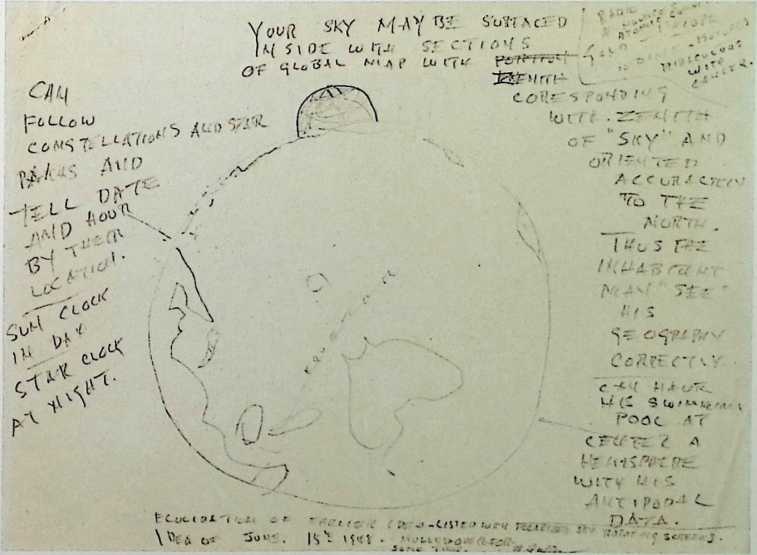
designers, and architects like John Ford, Raymond Loewy, and Louis Kahn, for the Office of Strategic Services, offering synthetic visual presentation of key data for the president of the United States and his advisers.[15] The Geoscope, as an attempt to present a global image of the planet using a geodesic sphere, was a direct inheritor of this project (fig. 3) Change: add ref .
Postwar, Buckminster Fuller was even more clearly in tune with the development of a new society giving precedence to information, communication, and networks. His discourse was influenced by the rhetoric of cybernetics, with its emphasis on trajectory steering. Operations research and game theory also left their marks, though their influence was limited by Fuller’s fundamental interest in geometry rather than calculus (fig. 4) Change: add ref . The ideal of mechanization that had characterized the Dymaxion period was now complemented by the perspective of computerization. For Fuller, the computer represented the ability to pass seamlessly from the collection of data to their dynamic visualization. Initiated as a series of seminars using paper and pencil, like the 1969 session at the New York Studio School, the World Game was meant to transform itself eventually into a giant computer simulation.[16] In direct relation to this perspective, the notion of scenario became crucial in the thinking of its inventor. The World Game revolved around the construction of scenarios about the future of the planetthat is to say, trajectories linking series of possible events. There again, Fuller was in profound accordance with the rising importance given to events in the culture of information and communication. With their bits of data that are nothing more than elementary occurrences, information and electronic communication are fundamentally commensurable with events, in other words with “what happens” or what may happen, to paraphrase Paul Virilio.[17]
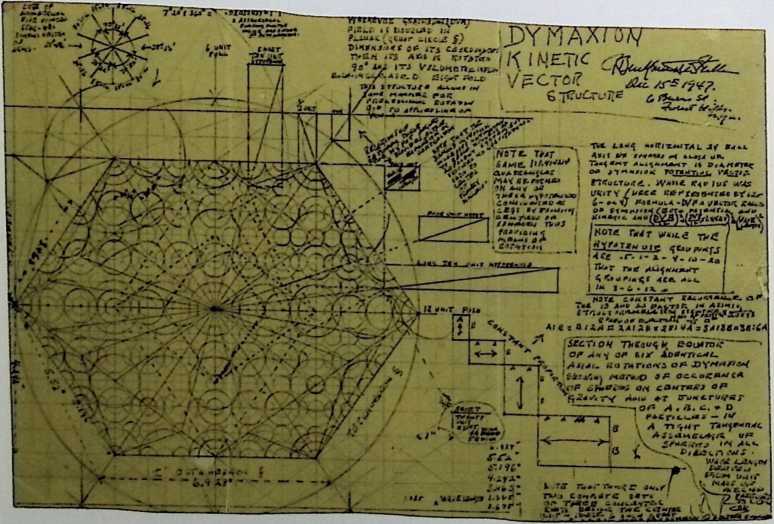
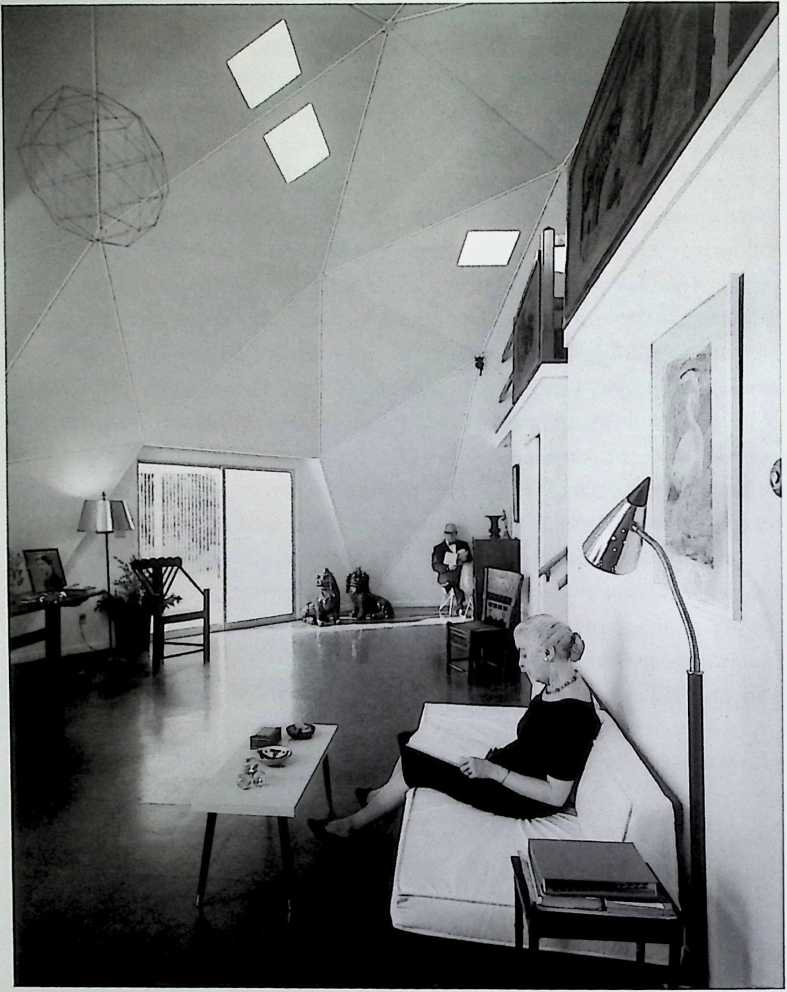
Fuller’s optimistic scenarios were all based on the alliance between his enduring fascination with military-style planning and a new concern for the environment. Although probably the most emblematic representative of this collusion between these seemingly discordant preoccupations, Fuller was by no means the only one to navigate between them; he was joined by a whole range of figures of the time. Based on the hypothesis of “closed worlds” the behavior of which could be predicted, the new tools of the period, like cybernetics, system theory, linear programming, and computer modeling, emphasized the finitude of resources and the need for their careful allocationwhether they were Cold War weaponry or natural resources. It is no coincidence that an engineer like Jay Forrester could translate the computer techniques he had elaborated for the U.S. Air Defense, for the Semi-Automatic Ground Environment (SAGE) system in particular, into the simulated world dynamics used by the Club of Rome to explore the limits of economic growth in the 1970s. Fuller’s “Spaceship Earth” was a particular instance of the “closed world” perspective that triumphed both at the Pentagon and in environmentally conscious circles.[18]
This perspective was of course inseparable from the development of communication networks. Building on some of his prewar intuitions, Fuller now announced the transformation of education into an industry using “an educational machine technology that will provide tools such as the individually selected and articulated two-way TV and an intercontinentally networked, documentaries call-up system.”[19] Interactivity, with the “two-way TV,” and individual customization would be the fundamental characteristics of the global networked society of the future.
One should not, however, hold up Buckminster Fuller as an advocate of the new culture of information and communication who was totally aware of all its implications. The idea of hybridization between man and technology, for instance in other words, the question of the cyborg that was emerging at the time, from cybernetic reflections on the analogy between mind and computer to practical attempts by the military at a more efficient coupling between man and machine[20] remained foreign to him.
More generally, Fuller remained at heart a traditional humanist. Just like his friend Constantinos Doxiadis, an architect and planner who was another postwar prophet of communication and networks, his aim was not to immerse man completely in the sphere of accelerated physical transfer, information processing, and instant messaging, much less to equip him with steel and silicon organs, but rather to re-create the conditions for a new equilibrium, for a regained serenity in a frenzied world.[21] Nothing is more telling, in that respect, than the photographs showing Fuller in the geodesic home he lived in from 1960 to 1971 in Carbondale, Illinois.
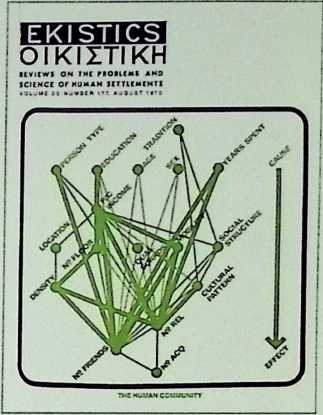
Despite its futuristic geometry, the home is quiet, meditative in ambience, almost like a seventeenth-century Dutch interior (fig. 5) Change: add ref .
If Fuller was clearly a major representative of ±e fundamental shift occurring in these years from the design of objects to the conception of artificial ambiences and environments, an evolution he epitomized with his famous project of a giant dome covering a large part of Manhattan to provide a semitropical climate inside (plate 145) Change: add ref , he was certainly not extreme to the point of imagining, like some younger representatives of radical architecture, that man could be fundamentally altered in his essence through changes in his surroundings.[22] The type of relation he envisioned between man and the environment was much closer to the Enlightenment quest for perfectibility: mankind’s defects were the result of unhealthy conditions of life. As he had put it optimistically in 4D Time Lock, Change: add biblio “Education and the proper upbringing of the young in modern, truthful, healthful environment will quickly efface crime and both mental and physical deformities.”[23]
Prophets are not always as farsighted as their admirers would like them to be. Some of Buckminster Fuller’s ideas are actually more conservative than the popular picture of the relentless advocate of rationalization and progress seems to imply. After all, through his great-aunt Margaret Fuller, he remained indebted all his life to the nineteenth-century transcendentalist legacy. But it is not only ideas that make prophets. In the case of Fuller, a series of very concrete patterns of behavior reinforce his emblematic status. It is as much by these patterns as by his ideas that he announces the rise of information and communication.
I have already mentioned Fuller’s passion for data gathering, a passion he expressed through his systematic paper clipping. The Chronofile, especially in its first decades, is replete with clippings from all kinds of newspapers and journals (pages 212–13). This clipping was definitely linked to a new attitude to data, to the ability to extract, package, and process it, a perspective announcing its transformation into what we today call information.[24]
Even more telling were the various strategies Fuller used to disseminate his ideas. Some of these strategies were of a technical nature, like his use of the mimeograph, a cheap mode of reproduction, to put his early writings in circulation. Others were of a more social nature, like the experimental seminar organized in July 1929 to elaborate 4D Time Lock. Traditional writing was to be replaced by recording and editing a series of exchanges between Fuller and a group of expert architects and engineers.[25] More generally, throughout his career, Buckminster Fuller relied heavily on processes involving state-of-the-art reproduction and communication technologies as well as a heavy dose of social networking. It is no accident that he was immediately seduced by Doxiadis’s Ekistics initiative, with its intricate blend of information gathering, publications, and social events like the Delos meetings organized from 1963 on (fig. 6).[26] Like Doxiadis, postwar Fuller acquired and maintained his worldwide celebrity through his skilled use of media and social network.
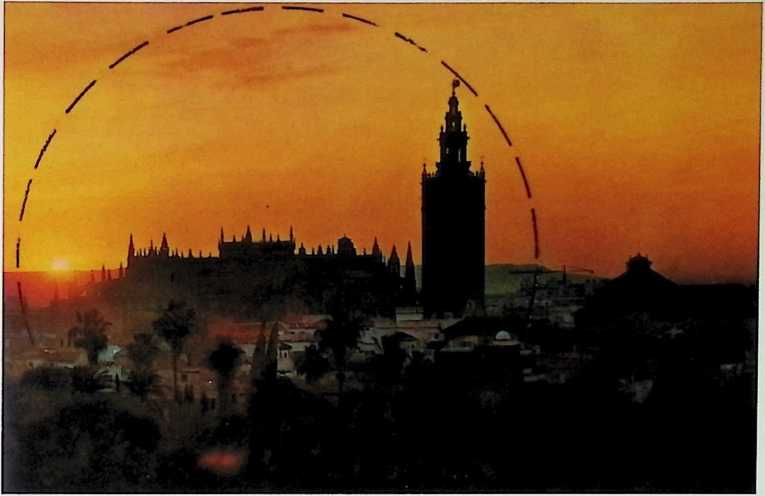 A Paradoxical Utopian
A Paradoxical Utopian
The cunning manipulation of media and people might seem at first fundamentally at odds with the alleged disinterestedness of utopia. But the opposition does not stand up to closer investigation, for utopia in the industrial age is not only about the evocation of a brave new world painted with the vivid colors of a dream. No longer a mere literary genre as it had been from the Renaissance to the eighteenth century, after the model of Thomas More’s seminal fiction, it aims to transform concretely the world.[27] Because of that ambition, utopia is closely allied with the communication techniques that can make the dream persuasive enough to generate political and social effects.[28] In other words, modem and contemporary utopia is intimately linked to media manipulation and social networking. Early-nineteenth-century Utopians like the French Saint-Simonians were already experts at these practices.[29] A similar degree of expertise was to characterize many subsequent enterprises. Fuller the utopian is actually inseparable from Fuller the master of communication and public relations.
Now, the exact nature of Fuller’s utopian vision is not easy to pin down. It seems to present contradictory features indeed. First and foremost, the emphasis is on a more and more immaterial society. Fuller’s key principle of ephemeralization, which he defined as the trend toward doing more with less, describes the progression “from material to abstract,” toward “intangibility, non-sensoriality.”[30] Throughout, Fuller’s writings tend to undermine the importance of materiality in favor of intellectual intuition and reasoning, the principles central to his later work Synergetics. Change: add biblio Nothing is more revealing in that respect than one of his prospectuses for his 4D Houses, in which we find the following statement: “At the high points of each era of the great progression, has it been realized that materials in themselves signify nothing and can be nothing without the will and the creative urge, and that character, happiness, love, harmony, and all the eternal qualities of truth are abstract and of the soul, and have but the freer play for the lack of any material impediment.”[31] Beside materials, objects themselves have only a relative value and should not be fetishized. Ephemeralization implies a certain distance from objects, a distance often based on the privilege given to services rather than to the physical possession of things. As Fuller once noted, to own a telephone handset has no real importance; what counts is to subscribe to a phone plan. By the same token, housing was to be considered as a service rather than a product industry appealing to the instinct of home ownership.[32] Here again, one is tempted to relate Fuller’s stress on immateriality and service to his understanding of the implications of the rise of information and communication. His advocacy of immateriality is not without analogy to the kind of discourse we have heard since from theorists of digital culture like Nicholas Negroponte or William Mitchell.
But at the same time, the legacy of Fuller is essentially composed of a series of fascinating objects, like the Dymaxion house, car, and bathroom, the Wichita House, or his various geodesic domes. Despite his appeal to what he characterized in turn as the abstract or the metaphysical, he insisted on the practical, engineeringlike nature of his proposals: “I must always ‘reduce’ my inventions to physically working models and must never talk about the inventions until physically proven or disproven.”[33]
Many other contradictions can be pointed out in Fuller’s vision of the future. As I have already noted, this future is marked by contradictory trends toward decentralization and centralization, freedom and control.
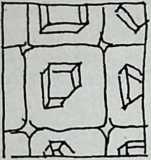
“We are convinced that, with the progress of life, the living abodes of humans will become more and more decentralized, and industry more and more centralized and mechanicalized,” he wrote in one of his early prospectuses.[34] The radical nature of the decentralization of life he had in mind prevents us from interpreting this statement as a simple endorsement of the American suburban model.
Another striking discrepancy lies in the spectacular contrast between Fuller’s quest for structural lightness and the gigantism of many of his postwar proposals. This gigantism was to reach its climax with tensegrity megastructures like Cloud Nine and Tetra City (plates 144 and 147), which would have dwarfed Manhattan skyscrapers. Some of his realizations were already of respectable size. As Fuller showed using a postcard from Sevihe, the cathedral of the Spanish city, by no means a small building, could fit entirely inside his geodesic dome at the Montreal Expo 67 (fig. 7).
All these apparent contradictions are actually related to a fundamental tension that runs throughout Fuller’s life and work, between the immaterial, light, and mobile on the one hand, the physical, heavy-duty, and large-scale on the other. Now I described these contradictions as apparent, for Fuller’s ultimate utopia revolves precisely around the way to solve the antinomy between these two series of terms.
His flirting with the megastructural movement may actually provide some insight into what he really aimed at, for his gigantic structures were supposed to be light to the point of being able to float in the air because of their use of the tensegrity principle. In that respect, Fuller was not far from the structural intuitions of someone like Le Ricolais, who believed that less could sometimes be attained through
-THS KEYS AW? REftLESEtSTVUe, BOOM-SHAPCS
A WOBo TYPeb WITH -ntESE KEYS SfoWS A STWNA <T= POQM5
You Fuve. Tt> WATT 6 W1N=, A SF6C4A<- HtveoAPO
ujhose posracD&
CAN BE toTAT®
TH A StBAL *EX
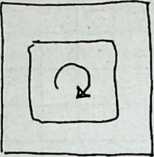
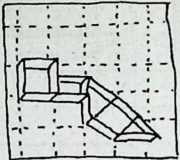

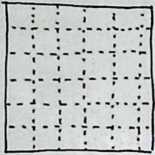
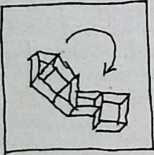
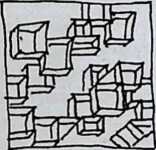
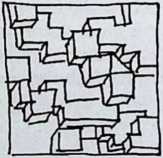
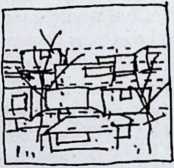
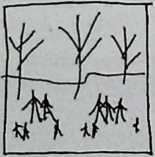
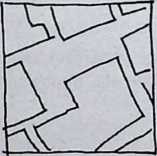
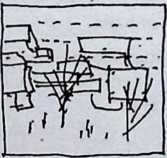
A TEXT IS A SUITE of WORDS: Your, floor. plan Akr> TUat °F YOU) Nfel<\ H%oupi
THS GNb RefBESexrt tRe
iMFhAiTajOVRE Ko which, the rats ARE FiTtej>
OBVIOUSLY yt>DR_rUCT H4S. to £e DETAILEJ EtePi
HXhJboluS
BGyjteAETt-CS CBA7M. RiTmeM.uK. etc)
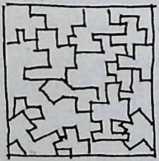
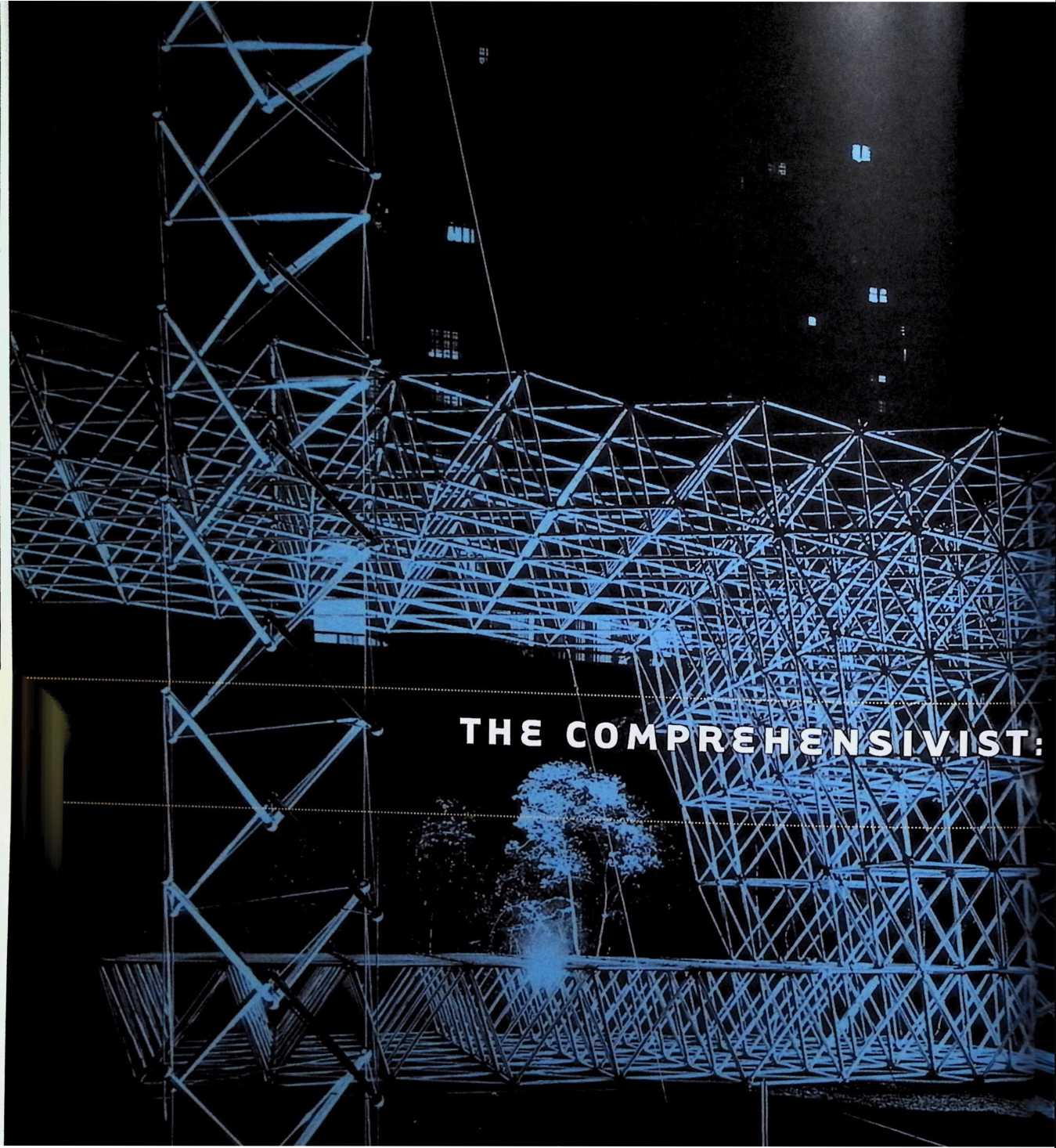
AJJb YOU -MlE Tb teqCE FIMAU MUENTAHCAI RoWINC THE ?AN
THE “TEXT” OS) BE, OF SEVERALPACJes.*.- EACH -pxqe IS 7R£ YIAr» W A JXFFEHEW Floor- i.
A -rexr[35] Type, k/ Maw? PEOPLE Ropuses THE P(aM °F a uei4Htofl Hfflb
A Ci-ry
ts a coLLecTtve 1©CV
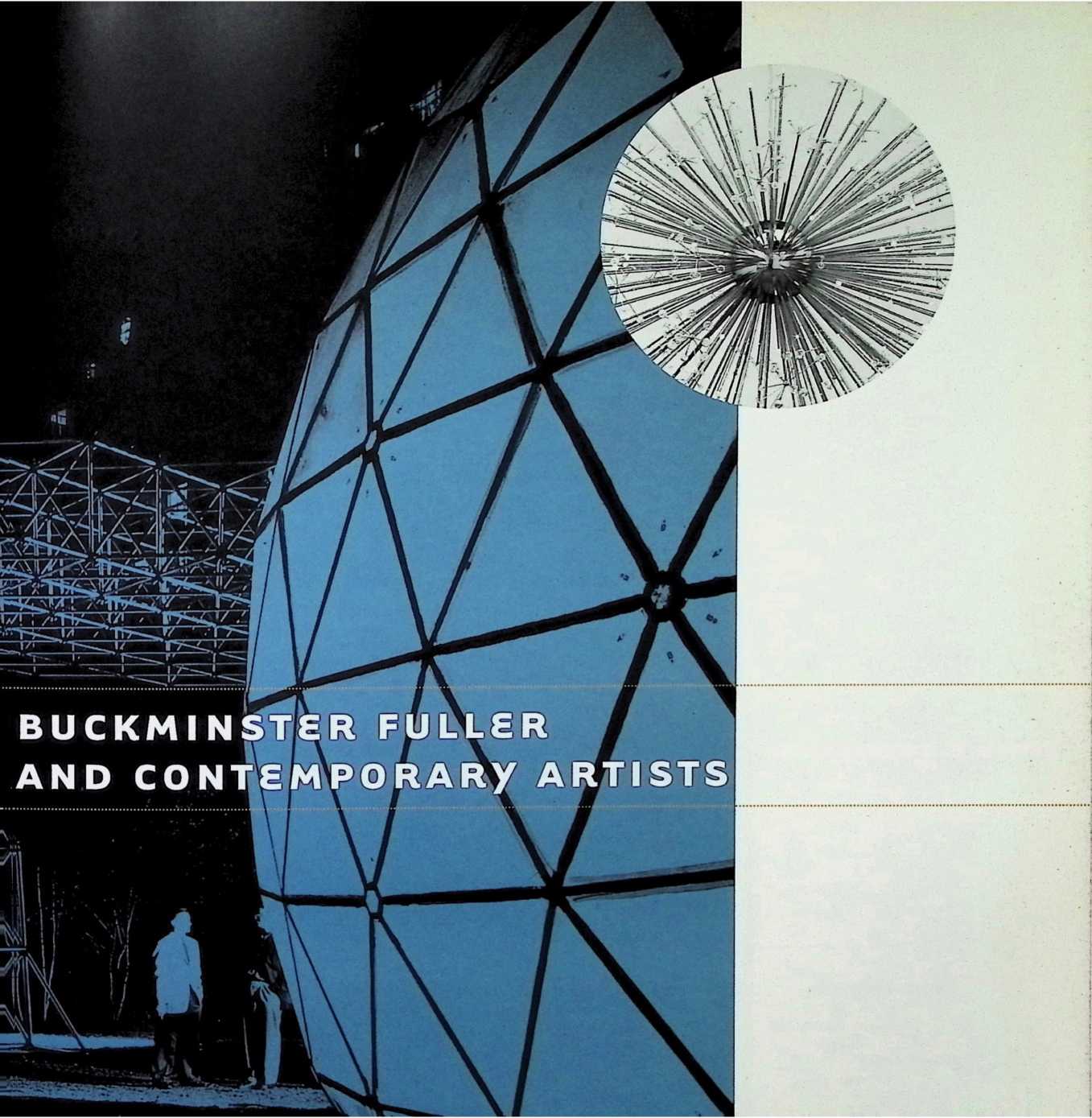
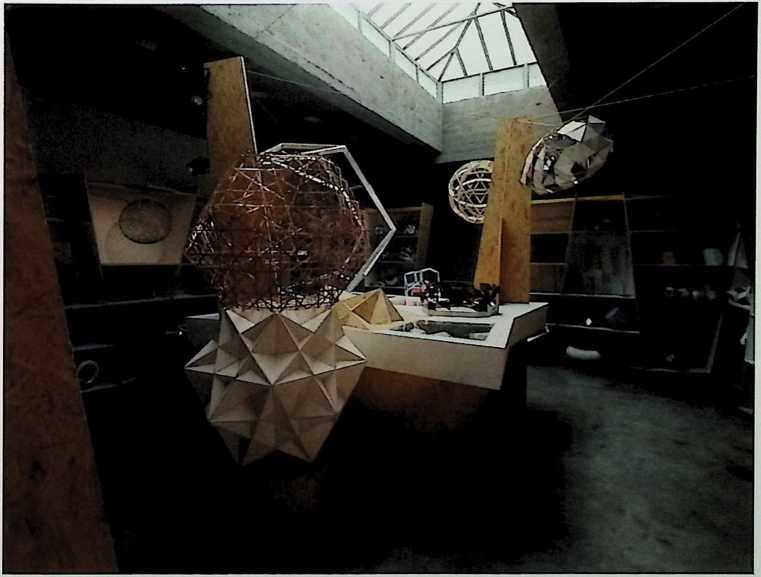

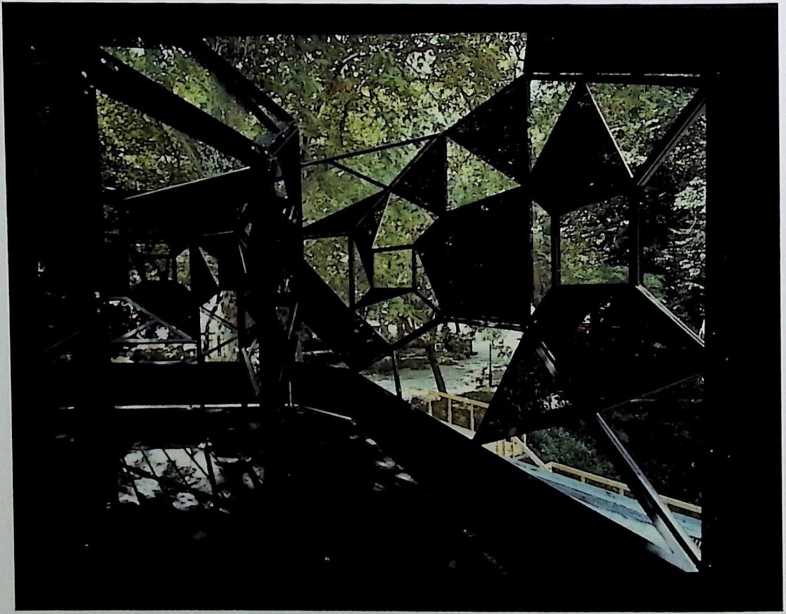
-TYPa’ e>y ihpsc uto u/Airr to U\ me
is mot -rue taUftEtfc CITY WAiJ Eur PATHeft A 9HN<; LF5T“:
~ttie first srep
TtWAMs tUVlbK
ybuft tewh Be
As you Line
more, through a massive mobilization of means.[36] Ephemeralization, that is, more with less, could paradoxically lead to less through more.
Despite its technocratic connotations, the postwar megastructural movement was linked to the project of using technology to free humanity from the mechanical enslavement of the industrial era. In the megastructures to come, men would wander freely, enjoying their rediscovery of natural sensations such as those provided by light and wind. In that respect, megastructures were comparable to giant liners, enabling their passengers to take full advantage of a direct contact with the elements.
The analogy with the liner was not lost on Fuller, who had been a sailor in his youth and was convinced of the maritime origins of modernity though the emblematic figure of the “pirate.”[37] Before ephemeralization, streamlining had been one of his key concepts, a concept definitely owing something to ship design. Megastructures, just like ships, proposed redemption from the misuse of technology through advanced technology. This redemption went hand in hand with a curious primitivism. What megastructures were ultimately about was the direct experience of a long-forgotten contact with nature.
Fuller the utopian is of course not reducible to Fuller the designer of megastructural projects, but the latter is once again revealing. In the past decade, the meaning of megastructures has been revisited in the light provided by their contemporaneousness with the rise of information and communication. Among other things, it has become more and more evident that in the eyes of their most lucid advocates, megastructures were not really objects, but principles of connection and growth.[38] Put another way, they had more to do with software than hardware, a property that was to lead to proposals like Yona Friedman’s “Flatwriter,” a computerized system of spatial allocation within the urban megastructures of the future (fig. 8).[39] Another alternative explored by the Italian radical group Superstudio was the ultimate replacement of megastructures by equipped surfaces, giant grids on which a nomadic humanity could roam while enjoying all the benefits of advanced technology.[40]
Fuller is certainly not foreign to this kind of perspective. More generally, megastructures are emblematic of the real status of objects in the “revolution in design” he had in mind, namely the concretization of an attitude toward life, the trace of steps taken in the right direction. Neither the Cloud Nine and Triton City structures nor his tetrahedral city project nor his Old Man River town concept in Saint Louis are to be confused with the ideal cities of the past. They are not meant to prescribe a univocal social organization and style of life; they represent, rather, moments in the development of an endless game with the possibilities of the future. In other words, they mark a trajectory.
We are in the midst of a renewed interest in trajectory steering and scenario- oriented management techniques. Along with the desire to understand our immediate past, this might account for the fascination that the cybernetic era exerts on so many young theorists and historians today.[41] The reinterpretation of Fuller the utopian is inseparable from that context. Its interest lies also in its resonance with one of the most nagging questions of our time: How can we reconcile the emphasis put on the individual dimension and the possibility of a common principle of hope? After all, Fuller himself liked to present his trajectory as the incarnation of such reconciliation.
Of course, we no longer believe that the universe obeys at a fundamental level the laws of synergetic geometry. We no longer take at face value Fuller’s claims to possess the true solution to all the problems plaguing the earth. But there is a definite appeal in his proposal that we consider the future of the world as a game that can be won against all odds. More than the prophet, even more than the digital or the utopian proper, the player might ultimately be the most attractive avatar of Buckminster Fuller today.
Notes
-
Cf. Felicity D. Scott, Architecture or TechnoUtopia: Politics after Modernism (Cambridge, Mass.: MIT Press, 2007), 157–67.
-
See, for instance, R. Buckminster Fuller and Kiyoshi Kuromiya, Critical Path (New York: St. Martin’s Press, 1981), 124.
-
This expression is already present in Fuller’s first book, 4D Time Lock (Chicago: privately printed, 1928; Albuquerque, N.Mex.: Lama Foundation, 1972), 13.
-
R. Buckminster Fuller, Operating Manual for Spaceship Earth (Carbondale: Southern Illinois University Press, 1969).
-
R. Buckminster Fuller, Nine Chains to the Moon (Philadelphia: J. B. Lippincott, 1938; Garden City, N.Y.: Anchor, 1971), 230.
-
Fuller, 4D Time Lock, 5.
1. See Fuller’s notes for 4D Time Lock, M1090, ser.
- box 2, R. Buckminster Fuller Papers, Department of Special Collections, Stanford University Libraries.
-
Nicholas Negroponte, Being Digital (New York, 1995; reprint, New York: Vintage, 1996), 163–71.
-
See Barry Katz, “The Arts of Wan Visual Presentation’ and National Intelligence,” Design Issues 12, no.
2 (Summer 1996): 3–21; and above all Mark Wigley, “Planetary Homeboy,”, ANY 17 (1997): 16–23.
-
Cf16–23 various documents on the World Game kept in M1090, ser. 18, Projects Files, boxes 24–25, Fuller Papers.
-
On the relation between information and event, see Pierre Levy, La Machine univers: Creation, cognition et culture informatique (Paris: La D couverte, 1987), 124 in particular. Paul Virilio, Ce qui arrive [What happens] (Paris: Fondation Cartier pour 1’Art Contemporain, Actes Sud, 2002).
-
Cf. Paul Edwards, The Closed World: Computers and the Politics of Discourse in Cold War America (Cambridge, Mass.: MIT Press, 1996); Agatha C. Hughes and Thomas P. Hughes, eds., Systems, Experts, and Computers: The Systems Approach in Management and Engineering, World War II and After (Cambridge, Mass.: MIT Press, 2000).
-
R. Buckminster Fuller, Education Automation: Freeing the Scholar to Return to His Studies (Carbondale: Southern Illinois University Press, 1962), 48.
-
Cf. Les Levidow and Kevin Robins, eds., Cyborg Worlds: The Military Information Society (London: Free Association, 1989).
-
On that point, our interpretation of Doxiadis is slightly different from the perspective adopted by Mark Wigley in “Network Fever,” in Grey Room, no. 4 (Summer 2001): 82–122. On Doxiadis see also Alexandros-Andreas Kyrtsis, ed., Constantinos A. Doxiadis: Texts, Design Drawings, Settlements (Athens: Ikaros, 2006).
-
Cf. Dominique Rouillard, Superarchitecture: Le Futur de architecture, 1950–1970 (Paris: Editions de La Villette, 2004).
-
Fuller, 4D Time Lock, 6.
-
See on that theme the articles gathered under the title “Cut and Paste um 1900,” in Kaleidoskopien, no. 4 (2002).
-
“Meeting Tuesday, July 9, 1929 Architectural
League, New York. Verbatim report by: National Stenotype,” Dymaxion Chronofile, vol. 36, 1929, M1090, ser. 2, box 21, Fuller Papers. -
For a detailed account of the Delos meetings, see the journal Ekistics. From 1975 to 1977, Fuller was president of the World Society for Ekistics. On Ekistics as a discipline, defined by Doxiadis as the science of human settlements, see Panayiota Pyla, “Ekistics, Architecture and Environmental Politics, 1945–1976: A Prehistory of Sustainable Development” (Ph.D. diss., MIT, 2002).
-
Michdle Riot-Sarcey, Thomas Bouchet, and Antoine Picon, eds., Dictionnaire des Utopies (Paris: Larousse, 2002).
-
On the relations between utopia and communication, see Armand Mattelart, The Invention of Communication (Paris: La Decouverte, 1994; English ed., Minneapolis: University of Minnesota Press, 1996).
-
Cf. Antoine Picon, Les Saint-Simoniens: Raison, imaginaire et utopie (Paris: Belin, 2002).
-
Fuller, Nine Chains to the Moon, 256. One of the best analyses of the concept of ephemeralization can be found in Martin Pawley, Buckminster Fuller (London: Trefoil, 1990).
-
“4D Housing & The Time Dimension,” Dymaxion Chronofile, vol. 36, 1929, M1090, ser. 2, box 21, Fuller Papers.
-
Pawley, Buckminster Fuller, 24.
-
Fuller and Kuromiya, Critical Path, 125.
-
“Cosmopolitan Home Corporation Lightful products,” manuscript, M1090, ser. 8, box 2, Fuller Papers.
-
On Le Ricolais’s paradoxical statement that less can be achieved through more, see Peter McCleary, Robert Le Ricolais: Visions and Paradoxes (Madrid: COAM, 1997).
-
The figure appears in almost all his accounts of world history. See, for instance, his Operating Manual for Spaceship Earth.
-
This dimension of the megastructure was already present in Alison and Peter Smithson’s projects like their celebrated Golden Lane. Cf. Rouillard, Superarchitecture.
-
Sabine Lebesque, Yona Friedman: Structures Serving the Unpredictable (Rotterdam: NAI, 1999), 50–51.
-
Peter Lang, Superstudio: Life without Objects (Milan: Skira, 2003).
-
To mention only a few: Branden Hookway, Pandemonium: The Rise of Predatory Locales in the Postwar World (New York: Princeton Architectural Press, 1999); Reinhold Martin, The Organizational Complex: Architecture, Media, and Corporate Space (Cambridge, Mass.: MIT Press, 2003); Michael Kubo, “Constructing the Cold War Environment: The Architecture of the Rand Corporation, 1950–2005” (master’s thesis, Harvard University, 2006).
¶ Buckminster Fuller and Contemporary Artists
Elizabeth A. T. Smith 


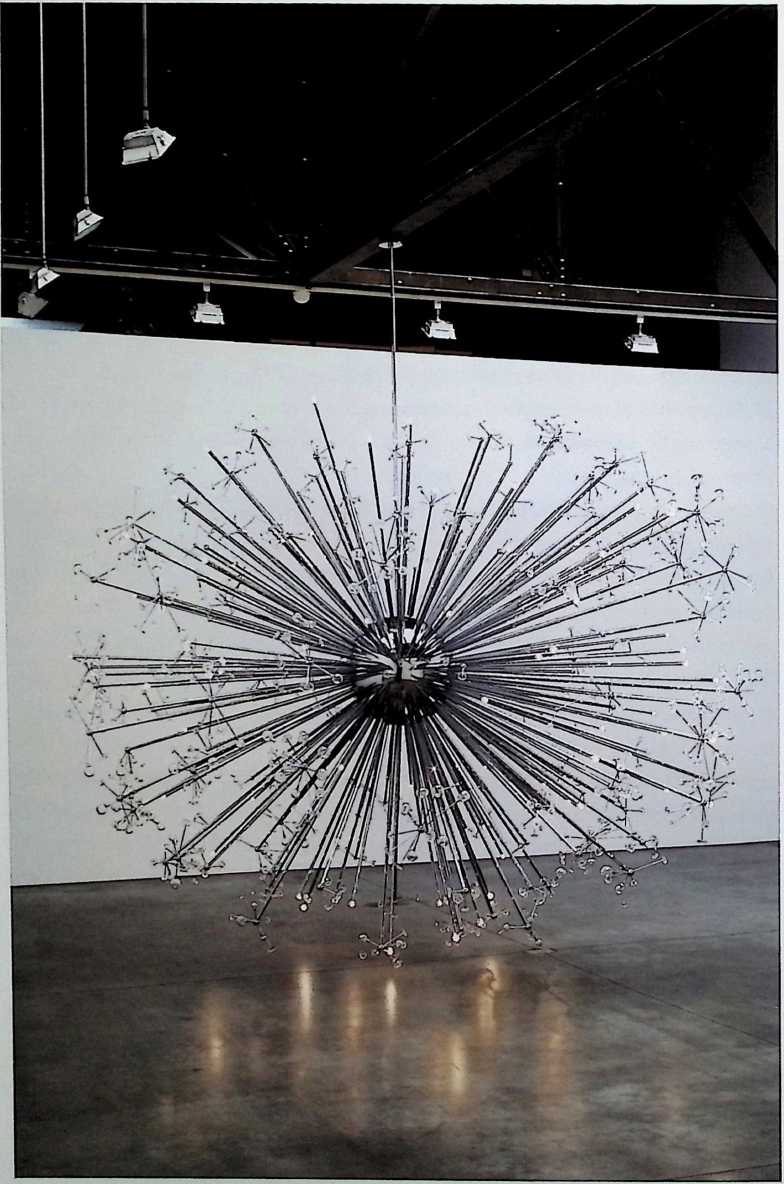
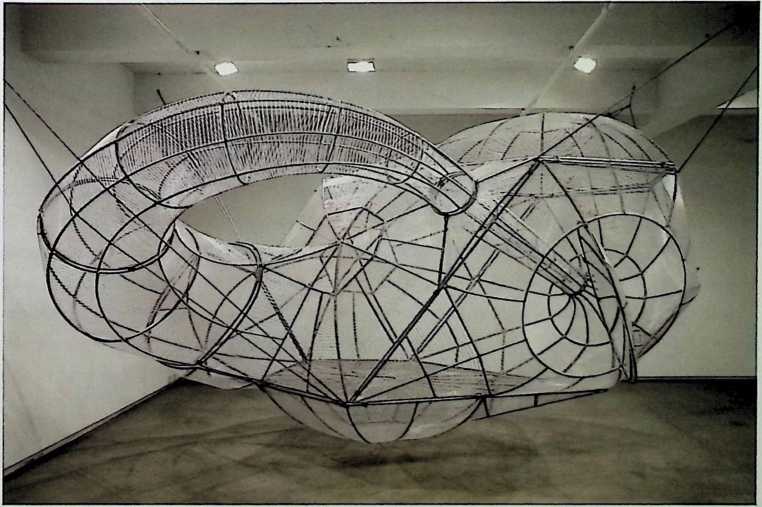
The wide range of ideas and achievements associated with Buckminster Fuller utopian, visionary thinking about systems and their interconnectedness, the structural and aesthetic manifestations of integrity, the relationship between pragmatism and abstract concepts, and the potential of human beings as driving forces of changeresonates in current and recent contemporary art practice. Examples abound of artists who cite Fuller directly as a touchstone for their own thinking; for others, the relationship to his work and ideas resembles a set of shared intuitions or loose affinities. Still others find Fuller relevant as fodder for ideas about shifting interpretations of and uncharted terrains within modernism, including the idea of utopia and its failures. The range of responses to Fuller among today’s artists parallels the expansive and sometimes contradictory way in which his examplenot only his work and ideas, but also his persona has been continuously reevaluated and reinterpreted, beginning in the 1950s and escalating, with ebbs and flows, into the present in ways that manifest “synergy” with the thinking and exigencies of each decade.
The position of Fuller, who called himself a “comprehensive anticipatory design scientist,”[42] as an avatar for today’s artists might best be appreciated as stemming from a ceaseless kind of resdessness, where everything is constantly in a state of discovery or of “becoming”always in flux, never static. Beyond the rationality and tectonics associated with many of Fuller’s achievements, the role of intuition in his work and ideas, as well as the philosophical richness and sense of spirituality that increasingly manifested itself later in his career, have profound resonance today, increasingly setting him apart from his contemporaries and from other modernists. This sphere of influence, centering on the intuitive or psychic/spiritual, contrasts intriguingly with the way in which Fuller is often credited as a forerunner of digital culturea system based on logic and rationalityas is compellingly analyzed elsewhere in this publication.
This essay will consider several examples of shared intuitions or affinities between Fuller and various artists active during the past decade. These artists are part of a generation whose work strongly reveals the legacy of conceptualism as well as the impact of minimalism, perceptual modes, feminism, and the performative practices that, though they have percolated within art since the 1960s, have widely proliferated only in the last decade. Extending the boundaries of traditional approaches to media and inviting new practices, disciplines, and models of meaning into the art world, conceptualism ushered in a reconsideration of art that transformed it “beyond recognition,” in the words of noted art theorist Craig Owens.[43] With an amorphous yet pervasive legacy, Fuller demonstrates a clear kinship to artists concerned with cross-disciplinary investigation, particularly those navigating uncharted terrain in terms of using or rethinking systems as the basis for individual works or bodies of work. Often, like Fuller, these artists choose to work collaboratively with others to
gain the perspective of specialized applications of knowledge, yet their achievements are highly individualistic and, like Fuller’s, sometimes difficult to categorize or to relate to those of their contemporaries.
Perhaps the best-known artist of his generation to acknowledge the inspiration of Fuller, not only in his methods of working but also in his ideas and approaches, is Olafur Eliasson. Profoundly interested in experience and interaction, the effects of time and space, the physical and visual properties of physics, and the relationships between the part or the fragment and the wholeall concepts that also stimulated FullerEliasson also resembles Fuller in the way he communicates his ideas, involving extensive scientific reference and prolific textual elaboration.[44]
Many of Eliasson’s works in a series of projects involving mathematical patterns and symmetries draw directly from Fuller’s experiments with geometric form. His Model Room installation of 2003 presents an enclosed space filled with specially designed shelves and tables on which are positioned a profusion of small geometric objects resembling scientific modelsgeodesic domes, kaleidoscopes, and latticeshaped constructionssignaling a restless and energetic mode of experimentation derived from the act of making as the basis of artistic discovery (fig. 1). Model Room was created in collaboration with Einar Thorsteinn, an architect who had extensive contact and involvement with Fuller and who has been a crucial transmitter of his
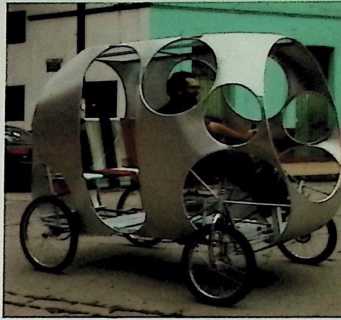
OLAFUR ELIASSON (b. 1967)
Model Room, 2003
Chipboard display cabinets, mixed media models, maquettes, and prototypes
Dimensions variable
Courtesy the artist and Tanya Bonakdar
Gallery, New York
ideas about the aesthetics and utility of geometry and mathematical forms to Eliasson, with whom he has worked directly since 1996.[45] The same year, Eliasson realized the Blind Pavilion for the Venice Biennale his most extensive application of ideas about geometry, non-Euclidian space, and perception to date (fig. 2). In this large-scale installation of various spatial and perceptual sequences achieved through the use of a kind of “energetic geometry,” utilizing both interior and exterior spaces of the existing pavilion structure, the objects presented in Model Room seemed to have expanded to an architectural scale, offering a compellingly participatory experience for the viewer.
Describing his concept of the relationship between subjectivity, time, space, and responsibility as “the most attractive model for understanding and communicating the idea of temporality in relation to individual objects and the world at large,” Eliasson has coined the term YES (“Your Engagement Sequence”):
By including YES as a central element of perception, the governing dogma of timelessness and static object-hood may be renegotiated, thus making your responsibility for an active engagement in the concrete situation apparent. …In other words, engagement has consequences and these entail some feeling of responsibility. . . . “YES,” or the fifth dimension, creates a perspective that is personal; it functions to individualize the other
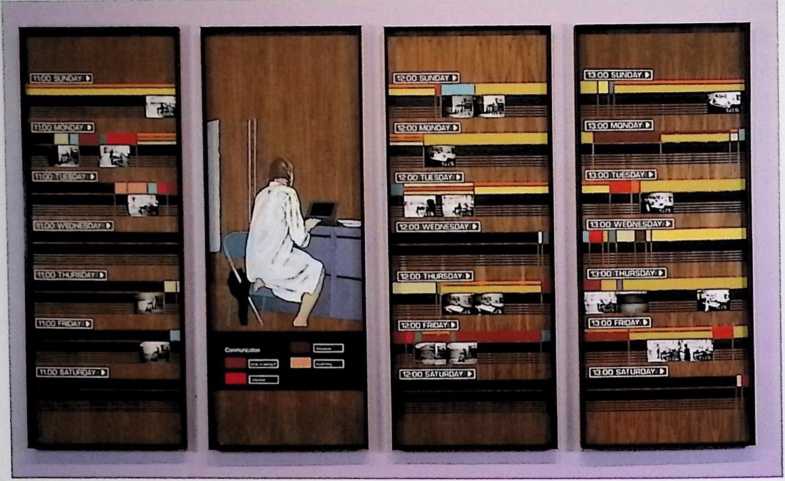
OLAFUR ELIASSON
; Blind Pavilion, 2003
; Steel construction, black and
•transparent glass
. 8 ft. 2 */t in. x 24 ft. 7 */« in.
i (2.5 x 7.5 m)
Installation: Danish Pavilion, 2003 Venice Biennale
2 Private collection
dimensions of space. I am interested in the potential inherent in giving the individual subject this dimensionality as a sort of tool that relativizes the other existent, presumed static dimensions upon which our conception of space is based.[46]
Commingling art, science, engineering, and architecture, Eliasson’s approach to systemic components and emphasis on revealing rather than masking their mechanisms of display appears to link him as closely to Fuller as to such artists as Robert Irwin and James Turrell, with whom he is often connected in a shared interest in phenomenological and perceptual effects.[47] Furthermore, the ethical dimension of agency implied in Eliasson’s statements about YES offers intriguing parallels with related concepts of Fuller’s, as does his commitment, in various projects since the late 1990s, to utilizing or manipulating natural phenomena, not just to explore perception but also to reflect on man’s place in the chain of life on Earth.
Eliasson has commented that he is drawn to utopian architects and thinkers such as Fuller because “they’ve got that ability to think about their own vision from the outside…Artistic practice has rediscovered its ability to constantly redefine its own programme, and architectural discourse has opened up to other fields in the same way. This is why the fact of integrating architectsand engineers and experts as wellis crucial for me in opening up to other ways of working.”[48]
The fluidity of intellectual parameters and disparate interests characteristic of Fuller is also apparent in other artists who have cited him directly as a source or a subject matter in their own work. In her installation Fuller’s Flow (2003), artist Irit Batsry has reconsidered and taken as a source of inspiration Fuller’s vision for the Biosphere, created as the U.S. Pavilion for Montreal Expo 67 (fig. 3). Her project, a video and mixed media installation situated within the Biosphere itself, references Fuller’s creation of the dome and its aesthetic possibilities while advancing theories about perception. Batsry’s project, commenting on the shifting nature of architectural innovation from the time of the Biosphere’s creation in 1967, when it was considered a technological marvel, to its condition as an almost forgotten relic today, seeks to reinvigorate the meaning of technological interactivity. Paying homage to Fuller’s precedent, she probes his ideas about space as stated in 1929: “A room should not be fixed, should not create a static mood, but should lend itself to change so that its occupants may play upon it as they would upon a piano,”[49] using myriad media including sound, moving imagery, and three-dimensional alterations to the space to offer a kinesthetic, sensorial reinterpretation.
Batsry’s interest in Fuller is of long standing. She encountered Fuller’s book Utopia or Oblivion in 1988 while researching her trilogy Passage to Utopia, finding in Fuller’s writing “an essential connection between the personal and the collective” that she had missed in the writings of other utopian thinkers.[50] In 1991, her video A
Simple Case of Vision and an installation titled . . . of persistence of absence . . . took as their subject matter a childhood vision disorder that caused Fuller to have almost constant blurred vision. In her work, Batsry sought to give form to the way defective vision alters perception; in Fuller’s case, he credited this experience as having indelibly shaped how he gained information and learned to make sense of the world around him.
I was bom cross-eyed…My vision was thereafter fully corrected with lenses. Until four I could see only large patterns, houses, trees, outlines of people with blurred coloring. While I saw two dark areas on human faces, I did not see a human eye or a teardrop or a human hair until I was four. Despite my new ability to apprehend details, my childhood’s spontaneous dependence only upon big pattern clues has persisted.[51]
For Batsry, this physiological fact was of immense significance to Fuller’s future contributions to the world of ideas and also offers a potent metaphor for the primacy of perception and intuition as a catalyst to invention in human experience. Seeking to use Fuller’s actual text as material in combination with other sensorial effects, Batsry discusses her approach as follows:
Part of my practice at that time was processing many images and texts without predetermining how and when they will be used. …In the beginning of one of these residencies I typed Fuller’s text [cited above] into the character generator, played it back hundreds of times and transformed it in many different ways using colorizers, superimposing and mixing it with live camera images and the “wobullator” (a Nam June Paik device that allows for transforming the image through voltage control). I ended up using all five
days of the residency treating this one paragraph and ended up with a few hours of recorded material.[52]
Various artists have considered Fuller’s complex role within and relationship to modernism from a more theoretical standpoint. Artist Josiah McElheny has undertaken one of the most sustained considerations of Fuller from this standpoint in a body of work and writings exemplified by a 2005 project titled An End to Modernity (fig. 4). This monumental sculpture, approximating both a chandelier and a model of the universe as explained by the Big Bang theory, presents a scientifically accurate rendition of the isotropic nature of the universe. Created in collaboration with an astronomer and incorporating references to 1960s-era scientific and culturally derived concepts and objects, the piece was accompanied by a documentary film also produced by the artist. The hundreds of component parts within the sculpture present a vast network that appears to coalesce into a unified whole, yet can never be fully comprehended or apprehended by the viewer.[53]
An End to Modernity culminates a series of objects and investigations McElheny has made over the past few years that reference Fuller directly: specifically a conversation between Fuller and sculptor Isamu Noguchi in 1929 that led to their proposal for creation of a “Total Reflective Abstraction”a world of form without shadow, completely reflective form in a totally reflective environment.[54] Intrigued by Fuller and Noguchi’s arrival at the idea of an aesthetic utopia of “endless everywhere,” McElheny in his interpretation of it encompasses both a meditation on modernism and its failures and a fascination with “the intersection of specific concepts and abstract ones.”[55] What emerges is a problematic, ambivalent relationship to the concept of “Total Reflective Abstraction” in McElheny’s work. While it has served as a powerful stimulus for McElheny in various of his own sculptural objects and environments, as, for example, in Buckminster Fuller’s Proposal to Isamu Noguchi for the New Abstraction of Total Reflection (2003), his approach to this concept is both an embrace and a critique. In An End to Modernity, McElheny signals the impossibility of rendering the totality of the universe as imagined by modernism, calling into question the idea of any kind of totalizing vision as imagined by Fuller or other modernists, yet creating an object so encompassing and seductive that it renders concrete the power of that vision.
McElheny states that he is intrigued by the exploration of concepts that “didn’t fit within the context of the moment they were invented, or have always been there but are constantly being returned to because they are needed in a different way.”[56] A related strand of thinking about Fuller and modernism has been articulated by writer Francesco Manacorda, who acknowledges Fuller’s centrality to a revisionist modernism that has exerted a profound influence on a generation of young artists drawn to the more obscure, lateral impulses within modernism. These were fueled
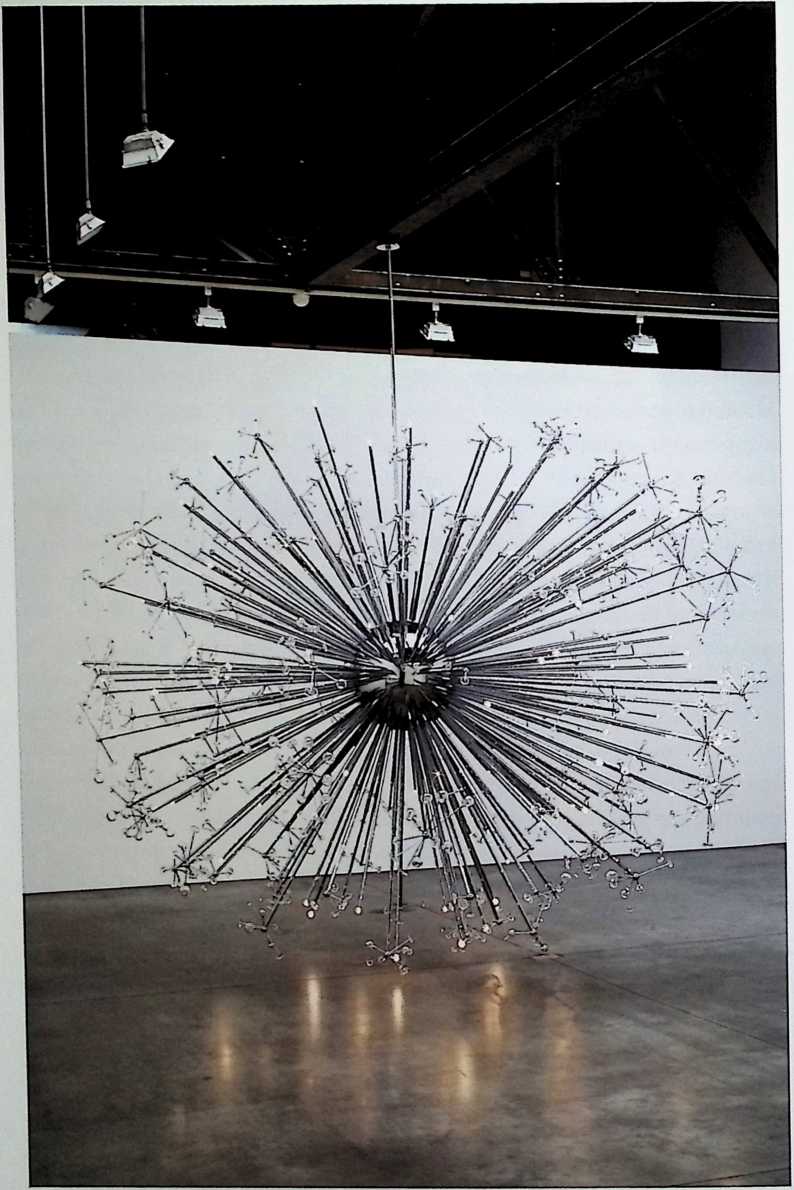
JOSIAH MCELHENy (b. 1966)
An End to Modernity, 2005
-
Chrome-plated aluminum, electric
-
lighting, hand-blown glass, steel cable
-
and rigging
. Diameter 16 ft. (4.8 m)
[57] Courtesy Andrea Rosen Gallery,
4 New york
by intuition and organic rather than rational models, constituting what he describes as “a gothic side of the modem movement.”[58] For Manacorda, Fuller stands among the “heretical” figures of modernism, whose fantastic visions such as the Cloud Nine project reveal a hallucinatory blurring of reality and fiction, as distinct from the ideal of harnessing or marshaling Earth’s systems toward a common good.[59]
In a different way, artist Pedro Reyes reveals an equally strong ongoing fascination with modernismprimarily with the notion of resuscitating ideas that have fallen into disuse or disfavor but demonstrate new potential. Contrasting with artists who see evidence in Fuller’s utopianism of the failure of modernism, Reyes’s position is more generous. He comments, “The ‘modem’ does not have a fixed value; it becomes more or less interesting to us.. . . For me, modernism is a toolbox, but it is primarily part of an historical compost.”[60] Paralleling Fuller in the voracious mix of ideas and disciplines from which he draws inspiration, Reyes’s work interweaves the social, scientific, mathematical, philosophical, and aestheticconsistently going beyond issues of form or making them integral to symbolic and philosophical concerns.
Described by writer Tatiana Cuevas as “an idealist: he lives and works thinking of ways to improve the world,” Reyes embraces Fuller as a precursor and potent source of inspiration for many of his projects, including Parque Vertical (2000), Floating Pyramid (2004), Dream Digester (2005), and Velotaxi (2008).[61] His interest in taking structures or ideas associated with modernism and rehabilitating them in some way, toward often surprising ends, corresponds to Fuller’s regenerative thinking. For instance, in Parque Vertical (2000), Reyes re-visioned a 1962 example of modernist architecture by Mario Pani as a vertical park/urban form by means of a relatively modest alteration of the infrastructure; naming this unrealized project the “World Environmental Center” has generated attention to and interest in its possibilities as a model of sustainability and ecological aspirations.

The suspended sculptures in Reyes’s Capulas series, ongoing since 2001, approximate Fuller’s work in the way they resemble scientific models based on mathematics and geometryinteractive spaces with an exploratory, experimental character rather than static objects (fig. 5). Expressing his shared interest in the physical and conceptual properties of the microscopic sea creatures called radiolaria with Fuller, Reyes’s Capulas also function much like many of Eliasson’s projects in that they are defined by sensate experience and physical/perceptual engagement. The wordplay of their namefrom cupola, capillary, capsule resonates with Fuller’s term Dymaxion (from dynamic, maximum, ion) and his coinage of other neologisms to emphasize distinctive experiences, concepts, or forms.
Fuller’s visionary experiments with methods of dematerializing structure to make it more efficient and lightweight have fueled Reyes’s ideas for various specific projects. His design for the Velotaxi, a human-powered passenger vehicle planned to debut in 2008, is indebted to the example of Fuller’s Dymaxion car as well as the performative, anti-institutional character of Chris Burden’s 1976 B-car (fig. 6). Applying his artistic/engineering acumen to the problem of creating an alternative to the ubiquitous automobile, Reyes turned the spaces of the Museum of Mexico City into a factory for eight monthsan assembly line for the production of prototype vehicles, to be immediately put into circulation in Mexico City’s downtown upon completion. The artist comments:
Instead of bringing an exhibition into the museum, the museum produces these objects, and the exhibition will take place outside. The project has several goals. One is to replace cars with nonemission vehicles; another is to enable a migration of the unemployed from informal to more formal economies…. Henry Ford and Frederick Taylor created the foundations of the economy that we live in. I wanted to do something more than criticize how they opened the path for sweatshops, planned obsolescence, consumerism, and drive-thru societies. I thought, if these mechanisms, which approved to be so effective, have led us to ravish the planet, it is because techne has prevailed over ethos. It’s very easy to be enticed by technology and to be indifferent to its moral consequences. But it is useless to resist these driving forces. What we have to do is create new driving forces in the opposite direction, toward healing, not destruction.[62]
While Reyes’s work clearly manifests a sensibility of relational aesthetics with its emphatic commitment to creating new models of social interaction through art, he
acknowledges and embraces Fuller as a catalytic example for achieving a similar goal. He points to concepts he feels are most relevant and inspirational from Fuller, including: “Guinea Pig B. How an unemployed middle-aged person, married with kids, can turn his life into an experiment to test the maximum good he can do for the planet…. Dome for Kabul 1956. Him a B-52 into a carrier for a dome. Same as placing a flower in the barrel of a gun. Self-assembly in 24 hours without special training. …No more secondhand god. Talk with the sources of knowledge, not the intermediaries.”[63]
The work of artist Andrea Zittel also invites comparison to that of Fuller, in his self-appointment as “Guinea Pig B” and commitment to using himself and his life as raw material for explorations about improving the quality of everyday living. Drawing upon ideas that are both scientific and intuitive, and focusing attention on details of how to achieve more efficient, compact design, Zittel has sought primarily to redefine the role of the artist in relationship to the larger culture.
In the early 1990s, Zittel began to design objects resembling furniture, with the goal of creating one piece that could satisfy all human needs. Reminiscent of Fuller’s Standard of Living Package (1948-49), Zittel’s Living Units were tested by the artist herself for a period of one year each. The Living Units exemplify Zittel’s Fulleresque focus on systems of maximum efficiency and how they can be customized for the individual; she also “uses her body to test the authenticity of her art to the world” in a way that stems from earlier precedents in performative and feminist art.[64]
In the 1999 project A-Z Time Trials, Zittel probed the emotional and physiological effects of the absence of conventional measures of time by casting herself as “guinea pig Z” in a quasi-scientific experiment in which she analyzed her own responses to this absence, seeking to better understand human needs and agency (fig. 7). Various additional projects of Zittel’s resonate intriguingly with Fuller for instance, the documentary impulse of her A-Z Personal Profiles Newsletter with his ongoing Chronofile of his life in relationship to society yet references to Fuller in Zittel’s highly original and idiosyncratic body of work blend with psychology, social commentary, and humor as well as a distinct emphasis on the quotidian rather than the utopian. Asserting that she has always been interested in “the hybrid position he created for his practice,” Zittel comments on the specific appeal of Fuller’s designs for the Dymaxion bathroom and the Wichita House, a built version of the Dymaxion Dwelling Machine that was inhabited by a family for years before falling into disuse, as having triggered her thinking about authorship and authenticity as a young artist.[65] Aspects of her current and recent work, however, including projects developed as part of “A-Z Advanced Technologies,” reveal the continuing legacy of Fuller’s restless experimentation with materials and their applications to improving daily living.
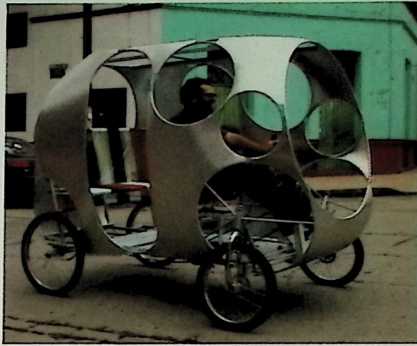 Similarly involved with creating objects and designs that are both utilitarian in purpose and infused with social critique is the Danish collective N55. Since 1993 this group has been at work on a series of projects ranging from hygiene systems to space-frames to fish farmsall stemming from the concept of providing socially useful artifacts that will in some way improve human life and circumstances.
Similarly involved with creating objects and designs that are both utilitarian in purpose and infused with social critique is the Danish collective N55. Since 1993 this group has been at work on a series of projects ranging from hygiene systems to space-frames to fish farmsall stemming from the concept of providing socially useful artifacts that will in some way improve human life and circumstances.
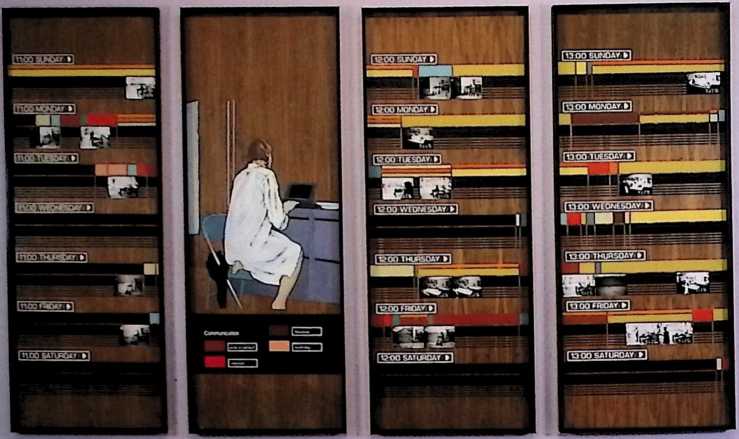
Disseminated in the form of “manuals” published on their Web site, with clear descriptions of their purpose, physical components, and construction techniques and thereby democratically available to allN55’s designs range from modest objects conceived for individual usage to more ambitious concepts on a larger, civic scale.[66] These works can be seen as gestures encompassing social and political commentary about issues ranging from ecological degradation to immigration to community-building and deployment of leisure time, yet in their dedication to inhabitable structures and systems, they are indebted to Fuller’s visionary mass-produced, easily deployed systems of housing and transportationhis array of “designs for mobility.”
In 1976, author Stephen Mark Dobbs prognosticated a Fuller-inflected future for art:
The Buckminster Fuller Future. Politics will be obsolete, and the rational use of Earth’s resources will liberate most people to pursue self-development and avocational interests. The arts and humanities will prosper. Artists will be admired as models of efficient use of resources and energy, achieving maximum impact in a given form. But some artists, taking advantage of the liberal climate, will reject sophisticated technologies at their disposal and will take sheets of paper, brushes, and paint and inscribe images as they used to do in the twentieth century. For a time there will be a trend toward pre-scientific attitudes, exalting the mystical and emotional against the rational and scientific, but that wave of nostalgia will spend itself on a brief flurry of enthusiasm for four-color psychedelic posters and videotapes of “Let’s Make a Deal.”[67]
More than thirty years later, it is evident that this scenarioone of several posited by the writer as a future vision for art and its societal impact has not played out entirely as imagined, yet Fuller’s impact on the future of creative practice has perhaps been more wide-ranging than previously thought. Fuller’s continuing influence on architecture, digital culture, environmental awareness and urges toward sustainability, and overall global vision has been substantial, while his currency with artists has been simultaneously pervasive and diffuse, palpable yet difficult to pinpoint or define with certainty. Yet numerous artists have pointed to the persistence of Fuller’s legacy or revealed affinities with his thinking, from Robert Smithson’s engagement with Fuller’s ideas in the mid-1960s to those discussed in this essay whose work approximates Fuller’s “comprehensivist” position, confounding conventional definitions of categorization. Artist Mel Chin, known for a significant body of environmentally committed, often socially and politically activist work since the early 1990s, has noted, “I’m not so interested in working with scientists, but the world of ideas is full of scientific relationships.”[68] In this respect he articulates the thinking of many artists, architects, designers, and others in creative fields whose interests have taken them beyond the narrow categories of disciplinary boundaries and closer to a sphere of activity characterized more by its approach to problem-solving, whether for pragmatic or symbolic ends. Fuller can be appreciated as a spiritual godfather to this strain of thinking and action.
Alternatively, an artist such as Sarah Sze, who has always developed her sculpture and installation work without the intervention or collaboration of others, points to Fuller’s contribution in the creation of scientific models that reveal both structure and relationships between physical objects (fig. 8). “It’s the investigation of structures that can perform all of these functions: act as models for something to be realized full scale, represent laws and behavior, and question the practical application of objects and structures in the real world, that I find intriguing,” she comments.[69] The idea of revealing the way something works as a stimulus for form resonates within Sze’s work; a sense of flux, disequilibrium, dynamism, and the interconnectedness of microcosmic to macrocosmic components are defining features of her sculpture. The connections between her work and Fuller’s are perhaps more tenuous than those between Fuller and any of the artists I have discussed above. Nevertheless, in its constellation of always interdependent parts that suggest a magnitude of organic, technological, scientific, and philosophical relationships, Sze’s work most satisfactorily embodies the spirit of Fuller’s commitment to explorations of omnidirectional processes of growth and change, and most eloquently references the terrain of comprehensivism he advocated.
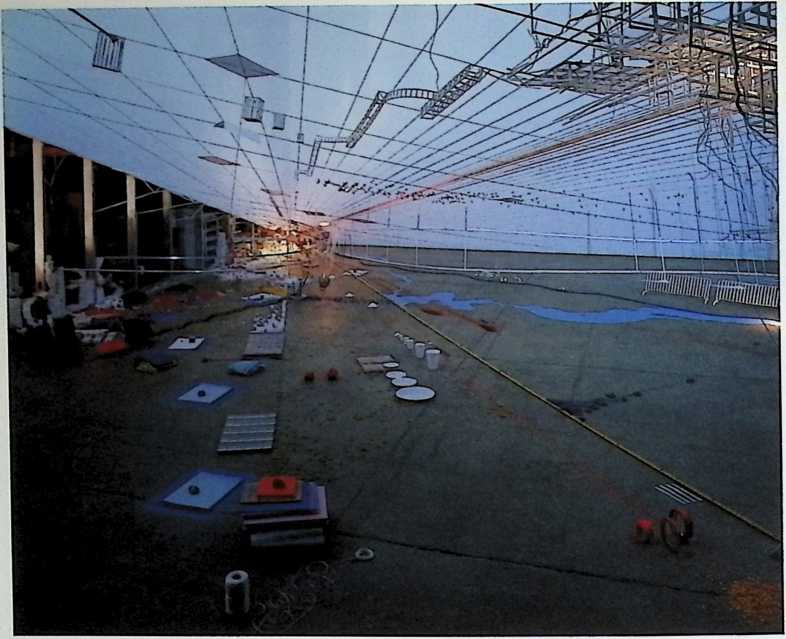
In her characterization of Fuller as an “illusive mutant artist, impossible to categorize,” writer Victoria Vesna states that he “foreshadows the complex persona of a contemporary media artist.”[70] She offers a compelling analysis of his significance for this emerging strain of practice, noting that “very early on he recognized the computer as a human extension, never losing the organic quality in his interpretation of the human/machine relationship.” Going on to describe him as a “performance artist who constructed practical prototypes of some of his visions,” she points to the persistence of an “invisible aesthetic of integrity” underlying and unifying all of his work.[71] The notion of the invisible quality of integrity as an aesthetic and ethic, articulated directly by Fuller in 1973 and quoted elsewhere in this publication, stands as a compelling, comprehensive vision that permeates his work’s significance for a younger generation of artists.
¶ Notes
-
Michael John Gorman, Buckminster Fuller: Designing for Mobility (Milan: Skira, 2005), 16.
-
Craig Owens, “Detachment: From the Parergon,” in Beyond Recognition: Representation, Power, and Culture, ed. Scott Bryson, Barbara Kruger, Lynne Tillman, and Jane Weinstock (Berkeley and Los Angeles: University of California Press, 1992), 38.
-
In a 2006 essay titled “Vibrations,” Eliasson begins with a quote from Fuller about the properties of physics that underpins his own ideas about time, energy, subjectivity, criticality, and other alternatives to modernist concepts of space. Olafur Eliasson, “Vibrations,” in Your Engagement Has Consequences: On the Relativity of Your Reality (St. Louis: St. Louis Art Museum, 2006), 59.
-
Thorsteinn, founder of the Reykjavik-based
research institute “Constructions Lab” in 1973, had a close personal and professional relationship with Fuller. His contributions are referenced extensively in the literature on Eliasson. For his role in Eliasson’s Model Room, see Karen Rosenberg, “Room with a View: Eliasson’s Elegant Universe,” Village Voice, May 2003, http://www.villagevoice. com/art/0320,Rosenberg,43999,13.html (accessed June 27, 2007). See also Madeleine Grynsztejn, “(Y)our Entanglements: Olafiir Eliasson, the Museum, and Consumer Culture,” in Take Your Time: Olafur Eliasson, ed. Madeleine Grynsztejn (San Francisco: Museum of Modem Art, 2007), 25–26 and 31 n. 48. -
Eliasson, “Vibrations,” 62–63.
-
An extensive analysis of Eliasson’s relationship to the so-called Light and Space artists is found in Pamela M. Lee, “Your Light and Space,” in Grynsztejn, Take Your Time. See also Susan May, “Meteorologica,” in Olafur Eliasson: The Weather Project (London: Tate Modem, 2004), http://weboelisson.dyndns. info:8080/PDF/Meteorologica.pdf (accessed June 27, 2007).
-
“Conversation between Olafur Eliasson and Hans Ulrich Obrist,” http://weboeliasson.dyndns.info: 8080/PDF/Conversation_HUO_OE.pdf (accessed August 20, 2007). Collaboration with others from related fields and in various roles has become a primary working method for Eliasson, who maintains a studio of approximately thirty individuals ranging from mathematicians to carpenters, as well as the aforementioned Einar Thorsteinn.
-
Buckminster Fuller, Dymaxion Chronofile, vol. 36, 1929, M1090, ser. 2, box 21, R. Buckminster Fuller Papers, Department of Special Collections, Stanford University Libraries.
-
E-mail from Irit Batsry to the author, October 24, 2007.
-
Buckminster Fuller, from Utopia or Oblivion: The Prospects for Humanity (New York: Bantam, 1969), quoted in an e-mail from Batsry to the author, October 24, 2007.
-
Ibid.
-
See “Josiah McElheny,” in Part Object Part Sculpture, ed. Helen Molesworth (Columbus: Wexner Center for the Arts, Ohio State University, 2005–6), 253.
-
Barbara Pollack, “Beyond the Looking Glass,” Art News 102, no. 11 (December 2003): 109. See also Dana Miller’s essay in this volume, “Thought Patterns: Buckminster Fuller the Scientist-Artist,” for the “entirely reflective silver studio” Fuller conceived for Noguchi.
-
“Josiah McElheny Talks about An End to Modernity and Conceptual Drawings for a Chandelier, 1965, both 2005,” Artforum 44, no. 3 (November 2005): 237.
-
Art: 21 film on Josiah McElheny, PBS, http://www.pbs.org/art21/artists/mcelheny/clip2. html (accessed September 14, 2007).
-
Francesco Manacorda, “The Dark Side of Modernism: Architecture, Science Fiction, and the Organic,” Flash Art 37 (March-April 2004): 91.
-
Manacorda points to artists Tobias Putrih, Ian Kiaer, Jeff Ono, and Bjom Dahlem as responsive to figures such as Fuller and Frederick Kiesler as stimuli for work that seeks to find “a path from the artificial to the primordial” using science fiction, architectural references, and scale models as tools to investigate modernism’s hidden gothicisms. Ibid., 91–92. Another artist of the same generation engaged with the idea of failure within modernism, specifically Fuller and utopianism, is Christine Tarkowski, whose project Searching for the Failed Utopia takes the form of a series of recent sculptures and installations.
-
Tatiana Cuevas, “Pedro Reyes,” Bomb, no. 94 (Winter 2005/2006): 21.
-
Ibid.
-
E-mail from Pedro Reyes to the author, October 17, 2007. See also Anuj Desai, “Building a Better Pedicab,” ArtNews 106, no. 8 (September 2007): 141–42.
-
E-mail from Pedro Reyes to the author, September 24, 2007.
-
Lynn Zelevansky, Sense and Sensibility: Women Artists and Minimalism in the Nineties (New York: Museum of Modem Art, 1994), 32–33.
-
E-mail from Andrea Zittel to the author, October 27, 2007.
-
See Web site www.n55.dk.
-
Stephen Mark Dobbs, “From Buck Rogers to Buckminster Fuller: On the Future of Art,” Art Education 29, no. 3 (March 1976): 11.
-
“A Composite Interview with Mel Chin,” in Inescapable Histories: Mel Chin (Kansas City, Mo.: ExhibitsUSA, Mid-America Ans Alliance, 1996), 36.
-
E-mail from Sarah Sze to the author, September 14, 2007.
-
Victoria Vesna, “Bucky Beat,” Artbyte 1, no. 3 (August-September 1998): 25.
-
Ibid., 28.
¶ In the Outlaw Area
image image
image
image
When Richard Buckminster Fuller was in New Zealand a k / year ago, he spent several rewarding hours at the Uni- versity of Auckland with a friend of his, a cultural anthropologist who also happens to be Keeper of the Chants of the people he belongs to, the Maoris. These chants go back more than fifty generations and constitute, in effect, an oral history of the Maoris, and Fuller, a man who is intensely interested in almost everything, undertook to persuade his friend that it was high time they were recorded on tape and made available to scholars, himself included. The anthropologist said that he had often thought of recording them, but that, according to an ancient tradition, the Keeper of the Chants was allowed to repeat them only to fellow-Maoris. Fuller thereupon launched into an extensive monologue. It was buttressed at every point by seemingly irrefutable data on tides, prevailing winds, boat design, mathematics, linguistics, archeology, architecture, and religion, and the gist of it was that the Maoris had been among the first peoples to discover the principles of celestial navigation, that they had found a way of sailing around the world from their base in the South Seas, and that they had done so a long, long time before any such voyages were commonly believed to have been made at least ten thousand years ago, in fact. In conclusion, Fuller explained, with a straight face, that he himself had been a Maori, a few generations before the earliest chant, and that he had sailed off into the seas one day, lacking the navigational lore that gradually worked its way into the chants, and had been unable to find his way back, so that he had a personal interest in seeing that the chants got recorded. We have Fuller’s assurance that the anthropologist is now engaged in recording all the chants, together with their English translations.
The somewhat overwhelming effect of a Fuller monologue is well known today in many parts of the world, and while his claim to Maori ancestry must remain open to question, even that seems an oddly plausible conjecture. An association with the origins of circumnavigating the globe would be an ideal background for his current activities as an engineer, inventor, mathematician, architect, cartographer, philosopher, poet, cosmogonist, and comprehensive designer whose ideas, once considered wildly visionary, are now influential in so many countries that he averages a complete circuit of the globe each year in fulfillment of various lecture and teaching commitments. Fuller, who was seventy last July and whose vigor seems to increase with his years, gives every indication of enjoying to the hilt his more or less constant “toing and froing,” as he calls it. He often points out that man was born with legs, not roots, and that his primary natural advantage as a species is mobility. Fuller has adapted himself so well to the extreme mobility of his present life that he considers it preposterous to be asked where he lives. A New Englander by birth and heritage, descended from eight generations of Boston clergymen and lawyers, he has had his
official base of operations since 1959 in Carbondale, Illinois, where he is a professor at Southern Illinois University in what he has designated as the field of “design science,” and where he and his wife occupy a plywood geodesic-dome house built according to the patented specifications of the best known and most successful of his many inventions. By agreement with the university, though, he spends only two months of the year, at most, in Carbondale, and much of that is in brief stopovers between jet flights to other cities, often on other continents. Perpetual mobility, he feels, is a perfectly satisfactory condition for a “world man,” which is what he firmly believes all of us are rapidly becoming.
The worldwide enthusiasm for Fuller’s ideas is by no means confined to university students, though they are currently his most fervent supporters. Professional mathematicians will undoubtedly question some of the premises of his “Energetic- Synergetic Geometry” when he finally gets around to publishing the definitive book on it that he has had in preparation for thirty-five years, but it is no longer possible to question the practical application of these same principles in such eminentiy satisfactory structures as the geodesic dome, which has been recognized as the strongest, lightest, and most efficient means of enclosing space yet devised by man. Over the last decade, moreover, scientists in other fields have been finding that Fuller’s research into nature’s geometry has anticipated some important discoveries of their own. Molecular biologists have now established that his mathematical formula for the design of the geodesic dome applies perfectly to the structure of the protein shell that surrounds every known virus. Several leading nuclear physicists are convinced that the same Fuller formula explains the fundamental structure of the atomic nucleus, and is thus the basis of all matter. As more and more people discover the comprehensive relevance of Fuller’s ideas, he finds himself increasingly involved in all sorts of new areas. The government, for example, recently appointed him a “Distinguished Scientist” at the United States Institute of Behavioral Research, in Washington. While this sort of recognition is highly gratifying to one who has always been something of a maverick, working outside the scientific Establishment, it has come as no particular surprise to him. Fuller long ago reached the conclusion that nature has a basic coordinate system, and he has been convinced for a good many years that the discovery of that system would eventually reunite all the scientific disciplines.
To the younger generation, the most stimulating thing about Fuller is probably his exhilarating contention that we have arrived at the ±reshold of “an entirely new philosophical era of man on earth.” For the first time in history, he argues, man has the ability to play a conscious, active role in his own evolution, and therefore to make himself a complete success in his environment. According to Fuller, this dazzling prospect was opened to us by Einstein’s concept of energy as the basis of the universe. “Einstein shattered the Newtonian cosmos,” he said recently. “In the famous first law of dynamics, Newton had said that a body persisted in a state of rest or constant motion except as it was affected by other bodies; he was assuming that the normal condition of all things was inertia. Einstein realized that all bodies were constantly being affected by other bodies, though, and this meant that their normal condition was not inertia at all but continuous motion and continuous change. The replacement of the Newtonian static norm by the Einsteinian dynamic norm really opened the way to modem science and technology, and it’s still the biggest thing that is happening at this moment in history.”
More specifically, the new era was made possible by the phenomenal acceleration of science and technology in the twentieth centurya process that really began, Fuller says, during the First World War, when industry suddenly moved, in his words, “from the track to the trackless, from the wire to the wireless, from visible structuring to invisible structuring in alloys.” A good example of this process can be found in the performance of chrome-nickel steel, an alloy that was used for the first time in the First World War, to make cannon barrels more durable; because of an invisible molecular pattern that is created when chromium, nickel, and iron are combined, the resultant alloy held up under conditions of intense heat that would have quickly melted all three of its components separately. Most of the major advances in science and technology since 1914 have been in this invisible realm, which Fuller calls “synergy”a term that can be defined as the behavior of whole systems in ways unpredictable by the individual behavior of their sub-systems. So far, Fuller maintains, the newest technology has been applied principally to the development of military power, or weaponry, rather than to housing and education and other aspects of what he calls “livingry.” Nevertheless, the shift of industry to the new invisible base has brought about such spectacular gains in over-all efficiency, such demonstrated ability to produce more and more goods and services from fewer and fewer resources, that mankind as a whole has inevitably profited. According to a statistical survey that Fuller made some years ago for Fortune, the proportion of all humanity enjoying the benefits of the highest technology has risen from less than six per cent in 1914 to twenty per cent in 1938. Today, Fuller places forty-four per cent of mankind in the category of technological “have”s, and it is his frequently stated conviction that by devoting a larger share of their industrial budget to world livingry the “have”s could very quickly bring the entire human race into contact with the highest technology, at which time the weighty problems that oppress us nowwar, overpopulation, hunger, diseasewould simply cease to exist.
To achieve this utopia, Fuller proposes a worldwide technological revolution. Such a revolution would not be led by politicians, and, in fact, would take place quite independently of politics or ideology; it would be carried out primarily by what he calls “comprehensive designers,” who would coordinate resources and technology on a world scale for the benefit of all mankind, and would constantly anticipate future needs while they found ever-better ways of providing more and more from less and less.
One big question, of course, is whether the political and economic convulsions of the present era will allow the comprehensive designers time to carry out this kind of revolution. Fuller thinks that there is still time, but he also thinks that time is rapidly running out for humanity, and it is this belief that keeps him in virtually constant motion around the world, talking to students and training them to think comprehensively as they continue his search for nature’s basic patterns.
It is probably fitting that Fuller, as a true world man, should have no real home these daysor, rather, that he should feel at home wherever he happens to be. There is, however, one spot on the globe that comes reasonably close to being a fixed point in his life. Whenever possible, he tries to spend some part of each summer in Maine, on Bear Island, which has been owned by members of his family since 1904, and he has often referred to this place as the source of most of his ideas. “My teleological stimulations first grew out of boyhood experiences on a small island eleven miles off the mainland, in Penobscot Bay of the state of Maine,” he writes of Bear Island in the first chapter of “Ideas and Integrities” (Prentice-Hall), a recent volume of essays that constitutes his intellectual autobiography. With this statement in mind, I wrote to Fuller last spring in England, where he was just completing a one-month visiting professorship in the Department of Architecture at Bristol University, to ask if I could spend a few days with him on Bear Island. He wrote back immediately, inviting me to select a date in August for my visit.
Bear Island, I knew, has been preserved in virtually the same state of development as when Fuller’s grandmother bought it, in 1904no telephone, no electricity, no running waterand this strikes some of Fuller’s friends as an odd setting for a man whose life is devoted to making the highest technology serve a hundred per cent of humanity. At the same time, I thought, it could be an ideal setting for someone like Fuller, who has always been interested in finding out how nature really works. The island lies approximately in the middle of East Penobscot Bay, about twelve miles east of Camden. Visitors usually take a boat over from Camden, on the mainland, but I had been staying with friends farther Down East and had therefore arranged to come over from the town of Sunset, which is only five miles from Bear on Deer Isle and can be reached by bridge from the mainland. Fuller and several members of his household had spent the afternoon buying groceries and other provisions in Stonington, the nearest town of any size on Deer Isle, and I met them all on the Sunset dock. In addition to Fuller, there was Mrs. Alphonse Kenison, a younger sister of Fuller’s, who has missed only three summers of her life at Bear Island, and who, more than anyone else, has kept the place going through the years; his niece Persis and her husband, Robert Alden, a young New York radio-network executive, and their two children; another niece, Persis’s sister Lucilla Marvel, and two of her children; and Pearl Hardie, a Maine native who lives for much of the year on Bear Island, where he acts as caretaker for the half-dozen buildings on the island and man of all work, as his father did before him. For the first time in years, Fuller’s wife, Anne, had not come to Bear Island this year; she was visiting their daughter, Mrs. Robert Snyder, in California.
Fuller put down a carton of canned goods he had been carrying, and came to greet me, smiling warmly and exposing what looked like a recently chipped front tooth. He is a rather stocky man, powerfully built, and with a massive squarish head and a stubble of white hair cut so short that it stands straight up, and he looked, I thought, about twenty years younger than someone who had celebrated his seventieth birthday the month before had any business looking. His face was almost unlined, and it was also deeply tanned from a recent Aegean cruise. Somewhat heavy features and owlish eyes, magnified enormously by thick lenses, which he has worn since boyhood, can make him appear a bit severe, and at times even forbidding, but that impression is immediately dispelled by his open, toothy, and utterly ingenuous smile.
Fog began rolling in as we finished loading the supplies aboard a motor launch, which was operated by Mr. Hardie, and by the time we had left Sunset Harbor, it was too ±ick for us to see much of Penobscot Bay. During the trip over, though, Fuller enthusiastically identified each landmark as it materialized through the mist. “There’s Eagle,” he told me, pointing out a large, wooded island. “And there’s John Quinn’s boarding house, where we stayed that first summer of 1904the summer my father fell in love with Bear Island and talked his mother-in-law into buying it for the whole family. Nothing changes here, you seethat house looks exactly the same as it did then. I really think if my grandmother were to come back tomorrow she’d recognize almost everything.” He went on to say that his grandmother, Caroline Wolcott Andrews, had also bought two neighboring islands, Compass and Little Spruce Head, which formed part of the same deed, but that it was on Bear, with its fine natural harbor, that they had built a large house in 1905, bringing in all the necessary materials and labor from Boston aboard the schooner Polly, a hundred-year- old vessel that had served as a privateer in the War of 1812. “I used to row over to Eagle and back every day for the mail when I was a boy here,” Fuller said. “Four miles a day, often in very bad weather. It made me awfully tough something I’ve never lost, by the way.”
Although he scarcely looked it, Fuller admitted to me that he was feeling a little run down at the moment. His schedule had been particularly demanding lately, and he had arrived only the day beforeseveral days later then he had planned. From Bristol he had gone to Paris, to address an international assembly of architectural students, and from there to Athens, where he took part in a symposium sponsored by Constantinos Doxiadis, the Greek city planner, on board a chartered cruise ship; then he had flown back to the United States for a round of engagements, the most recent of which had been a conference at Princeton on how to improve the level
of scientific education in the nation’s secondary schools. Fuller told me that for the first time in his lifeperhaps because he had turned his ankle rather badly one evening on the Greek yacht while dancing the Twisthe had actually begun to feel his age. “I gained twenty pounds on this last trip,” he added confidentially. “It’s one of the really big problems on this kind of schedulebig, rich dinners everywhere, and all that airline food. I really need a few weeks of this Bear Island atmosphere.”
Approaching Bear Island in the fog, we could catch only occasional glimpses of its rocky shoreline. The island is about a mile long and half a mile wide, and is heavily wooded with spruce, pine, and white birch. Rounding the northernmost point, where the land rises sharply to a high bluff, we caught sight of the shingled roof of a large house, and a minute or so later Fuller pointed to an opening in the trees where we could just make out the shadowy arcs of an unfinished geodesic dome that had been, I was told, a family summer work project two years before. “I think it’s marvellous coming in with the fog this way,” Fuller said as we nosed slowly into the quiet harbor. “With any luck, it will clear tomorrow, and then you’ll be able to see where you are. We have a seventy-five-mile sweepout here, so there’s quite a lot to see.” (Like many other unfamiliar words that crop up in Fuller’s casual conversation, “sweepout” is a term borrowed from one of the scientific disciplinesin this case, astronomy; he used it to mean the range of activity that the eye could take in on all sides of Bear Island on a clear day.)
On the dock to meet the boat were a number of small children, most of them members of Mr. Hardie’s family, and several adults, including Mrs. Leslie Gibson, another niece of Fuller’s, and Professor Sidney Rosen, from the University of Illinois, and his wife. Professor Rosen, a science teacher who also writes biographies of great scientists for young readers, had been assigned by his publisher to write one of Fuller, and he was there to gather material for it. All the small children immediately began clamoring for Fuller’s attention. (They all called him Uncle Bucky, and I have observed that nearly all adults who have spent more than five minutes with him find it natural to call him Bucky.) He had to ask the children to repeat their questions several times into his ear, which he cupped patiently with one hand his hearing, damaged during the First World War, has deteriorated quite a bit in recent years. This difficulty did not appear to discourage the children in the least, or to make even the youngest ones shy of him. After a certain amount of confusion, the supplies were transferred from the launch to a weathered jeep driven by Fuller’s sister, Mrs. Kenison, and the rest of us walked up to the main house, on the bluff.
When most of us had assembled in the big house before dinner, Fuller came downstairs carrying a large blue bullhorn, which he had purchased during his stay in England. He explained that he had found it a great boon at conferences and seminars, where he used it not as a loudspeaker but as a directional antenna; the horn had an electronic amplifier that worked both ways, he said, and by pointing the cone at a speaker across the room, holding the voice box near his good ear, and pressing the amplifier button, he could hear perfectly. “I used to be a real menace at conferences,” he told us. “I had to have everything repeated. People kept telling me I should get a hearing aid, but, you see, I’ve tried that several times, and it has convinced me that nobody really knows anything about how we hear. Hearing aids are non-selectivethey just amplify all sounds. But I hear some sounds perfectly well maybe even better than you doand when those are amplified for me, it’s actually painful. With this marvellous device, though, I can be selective. I can pick up sounds just by pointing.” He held the horn to one ear and pointed it at Professor Rosen, across the room. “Say something in your normal voice, Sidney,” he demanded. Rosen said something too low for me to catch. Fuller said he could hear him perfectly. He passed the bullhorn around the room, so that everyone could try it out, and he slung it around his neck on a white cord when we went to dinner, which was served, like all meals at Bear Island, a few hundred feet from the main house in a farmer’s cottage that was on the property when Fuller’s grandmother bought it. It turned out that there was not enough room at the crowded table to use the bullhorn comfortably, so he soon gave up trying. The sound of many voices reflected off a low ceiling apparently made it almost impossible for Fuller to hear what anyone said, and, sitting at one end of the table watching the others but taking little part in the conversation, he looked, in the flickering light of kerosene lamps, a little sombre and withdrawn.
When dinner was over, though, he suggested to Professor Rosen and me that we stay on at the table and listen to a few things he had to tell us. As I knew from previous meetings, there is no such thing as an ordinary conversation with Fuller. One question is enough to set him talking for an hour or more, and often a question is not even necessary. His talk follows a process that the cyberneticists call “positive feedback,” in that each idea sets off a whole flock of related ideas in something like geometric progression; Fuller seems never to have forgotten anything he ever knew, and his command of statistical detail is awe-inspiring. Perhaps the most amazing aspect of these monologues is that, no matter how long and labyrinthine the digressions that crop up along the way, he invariably returns sooner or later to the primary subject of his discourse, and everything turns out to have been relevant. On that particular evening, he talked for a little longer than three hours. His voice gathered strength and momentum as he went along, and he could clearly have continued for another three hours if his listeners had been up to it. The main subject was his own system of mathematics, which he has been evolving for nearly half a century, and which underlies all his work in other fields.
Fuller began by telling us about meeting C. P. Snow in England two years ago. He said he was sympathetic to Snow’s view that there is a gap between the “two cultures” the sciences and the humanitiesbut he did not agree that this gap had
been caused by a spontaneous aversion to industrialization on the part of literary men. In Fuller’s opinion, scientists had caused it. Soon after the discovery of electromagnetics, in the nineteenth century, he said, scientists had decided that because electrical energy was invisible, it could not be represented to the layman in the form of models, and so they had decided to stop trying to explain what they were doing in terms that the layman could understand. “That’s really the great myth of the nineteenth century,” he said. “I told Snow the basic reason for the split was that science gave up models.”
Having made sure that this point was firmly established, Fuller set off on a survey of his self-education in mathematics. “At Milton Academy, in Massachusetts, where I went to school, I just loved mathematics,” he said. “I found I could get A in it whether or not they liked my face. I was severely cross-eyed then, and not a favorite student ever, and I really believed I was getting bad marks in my other subjects because the teachers didn’t like me. But they couldn’t do that in mathematics. At the same time, there were certain things that the mathematics teacher was saying and doing that I didn’t think were really valid, but it was a game you could learn to play, and you could do it right and get your A. For example, we’d been taught fractions, and one day the teacherit was a womansaid, ‘I am now going to teach you a better way. It’s called decimals.’ She didn’t say why she hadn’t shown us the better way to begin with. She showed us that an eighth is point one two five, and a quarter is point two five, and a third is point three three three, and so on with threes, out the window and over the hill. I noticed that some of these numbers went out the window and others stayed in the classroom, and I didn’t think she really knew what she was talking about. I thought she was very pretty and appealing, and if that’s the way she wanted to play the game, I’d play it her way, because I’d been brought up to believe that adults knew all the answers and that you were just supposed to shut up and learn, but I also thought she wasn’t on any very profound team.
“Later on, we came to geometry. The teacher made a point on the blackboard, then erased it and said, ‘That doesn’t exist.’ She made a row of points, and said, “That’s a line, and it doesn’t exist, either.’ She made a number of parallel lines and put them together to form a plane, and said it didn’t exist. And then she stacked the planes one on top of the other, so that they made a cube, and she said that existed. I wondered how you could get existence out of nonexistence to the third power. It seemed unreasonable. So I asked her, ‘How old is it?’ The teacher said I was just being facetious. I asked her what it weighed and I asked how hot it was, and she got angry. The cube just didn’t have anything that I thought was existence, but I thought I was probably being unfriendly, and so I shut up. I got A’s in all my science work, and when I got to Harvard I didn’t go on with mathematics, because it was so easy just a sort of game you played. I thought I’d take something really difficult, like government or English.
“I was kicked out of Harvard. I spent my whole year’s allowance in one week, and I cut classes and went out quite deliberately to get into trouble, and so naturally I got kicked out. I was sent to work in a factory in Canada making cotton-mill machinery, and I did very well there. It was a very important phase of my life, for I met shop foremen and machinists, and got to know a lot about their tools and about metals in general. I did so well that Harvard decided I was really a good boy and took me back the following year, but obviously I couldn’t stay at Harvard very long. [In his autobiography, Fuller wrote that what really bothered him at Harvard was the social institutions.] So I cut classes and got fired again. This time, I enlisted in the Navy, where again I began to do very well. Well, one day in 1917 I was standing on the deck of my ship looking back at the wake it was all white because of the bubblesand I began wondering idly how many bubbles there were back there. Millions, obviously. I’d learned at school that in order to make a sphere, which is what a bubble is, you employ pi, and I’d also learned that pi is an irrational number. To how many places, I wondered, did frustrated nature factor pi? And I reached the decision right at that moment that nature didn’t use pi. I said to myself, ‘I think nature has a different system, and it must be some sort of arithmetical-geometrical coordinate system, because nature has all kinds of models.’ What we experience of nature is in models, and all of nature’s models are so beautiful. It struck me that nature’s system must be a real beauty, because in chemistry we find that the associations are always in beautiful whole numbersthere are no fractions. And if nature can accomplish all those associations in beautiful whole numbers to make all her basic structures, I thought, then the system will turn out to be a coordinate system and it will be very, very simple. And I decided then, in 1917, that what I’d like to do was to find nature’s geometry.”
Instead of using points and lines and planes, which had no objective existence, Fuller decided to see what would happen if he started with vectors, or lines of force, which had appealed to him very much when he studied Galileo’s diagram of forces in school. He liked vectors tremendously, he said, because they were descriptions of actual physical events. “Your vector has a length that is proportionate to the product of the velocity times the mass,” he explained. “Vectors represent energy events, and they are discrete. All my geometry would therefore be discrete geometry, and you wouldn’t have to worry about infinity and things going out the window all the time. I was interested in exploring a geometry of vectors, which always represent energy events and actions in respect to other energy events and actions. The vector has velocity, and time is a function of velocity, so such a geometry would automatically have a time dimension. The qualities I had wanted in the Greek cube which the Greek cube didn’t haveof heat and weight and age, and so forthwould be implicit in the velocity and the mass that would be translated into energy…Can you fellows go on taking this, or are you getting too tired? You’re going to get awfully sleepy in this Bear Island atmosphere.”
“No, no,” Professor Rosen said. “We’re fine.”
What followed was a detailed account of the mathematical steps by which Fuller, through his study of vectors, came to the conclusion that nature’s geometry must be based on triangles. “The triangle is a set of three energy events getting into critical proximity, so that each one with minimum effort stabilizes the opposite angle,” he said. “Now, I found that a quadrilaterala square, for example will not hold its shape. No rubber-jointed polygon holds its shape except one that is based on the triangle. So I said, T think all nature’s structuring, associating, and patterning must be based on triangles, because there is not structural validity otherwise.’ This is nature’s basic structure, and it is modellable.”
Fuller had been picking up steam right along, and by this time he was talking very rapidly. Pausing to take a Japanese felt-tipped pen from his pocket, he proceeded to illustrate the next phase of the lecture with vigorous drawings on a white pad. “Now, if I’m going to subdivide the universe with triangles, how many triangles will it take to give me a system that will have both an inside and an outside?” he asked. “I found that two triangles just fall back on each other and become congruent. I found that it takes a minimum of three triangles around a point. When you put in three triangles, with three common sides, around a point, they form a fourth triangle at the base and what you get is a tetrahedron. We know that nature always does things in the simplest and most efficient way, and structures based on tetrahedrons are the structures that nature usesthese are the only babies that count. All the metals are made up of some form of tetrahedron. All the other shapes you find in nature are only transformable states of the tetrahedron. This is what nature is really doing.
“All right, getting back to Snow, then, I showed him how I could make a model of any of nature’s structural relationships by using triangulation as the basis. Everything was now back in modellable form, I told him. And soon after that Snow said on the radio that he believed that the chasm between the sciences and the humanities could be closedthat the conceptual bridge had been found.”
A gust of wind buffeted the cottage, throwing open the doors on both sides and scattering the loose sheets of paper that Fuller had tom from the pad. It was eleven o’clock. When the doors had been secured again, Fuller poured himself a cup of tea from a large pot he had been working on ever since dinner. It was quite clear that the Bear Island atmosphere was not making him sleepy. He talked for a while about the immense changes that were taking place in the world, and how the really significant developments were going on quite independendy of politics, and this brought him to the subject of the fourth Dartmouth Conference, held in Russia the previous summer, which he had attended.
“The Dartmouth Conference was instituted several years ago," he explained. “The first one was held at Dartmouth College, and this one, the fourth, was in Leningrad. It’s supposed to be a meeting of prominent Soviet and American citizens, in a wide variety of different fields, to talk over any and all problems. There were twenty-one Russians at our last meeting and sixteen Americans, and that’s the way it’s been right alongthe Russians have been more thorough in appointing people from all parts of their society, most of them the top men in their field. We had some very exciting people, though. We had Paul Dudley White the Russians told me they considered White the world’s greatest cardiologist, and that they trusted him more than any other American; the poor man is so trusted by both sides that he hardly has any time to himself anymoreand we had James Michener and John Kenneth Galbraith and David Rockefeller. One of the Russians got up during the seminar and said, ‘Mr. Rockefeller, I’m an old Bolshevik, and I must say you’re very different from what I’d always thought of as a capitalist.’ They liked him very much. It was a wonderful meeting, and it was decided that it would end with a prognostication by a Russian and a prognostication by an American.
“We had talked very frankly and freely, and we were all somewhat aghast to find that whatever we wanted to do or thought should be done about the problems between us would inevitably be defeated by the bureaucracies on both sides. The Russians, though, were convinced that they had one fundamental advantage over us. They kept saying, ‘We have a singleness of purpose in Russia, while in America you’re completely competitive and you’re always cancelling out each other’s good effects.’ They said it with such earnestnessthey were really convinced it was true. And some of the Americans were not able to answer right away whether it was true or not.
“At any rate, I was chosen to give the American prognostication. The Russian one took up the whole morning and I had the whole afternoonfabulous. I always speak spontaneously, because I’ve found that it really is possible to think out loud. Although I seemingly go over and over the same inventory of thoughts and experiences, I find that each time I do, I learn something new, and that I have to change or rearrange what I’ve learned, and that I’m not allowed to carry out yesterday’s myths. Anyway, I found myself standing up and talking in the following way. I said, ‘I don’t know why I’m talking to you here, because you’re all so ignorant.’ Well, they were surprised by that, and I was surprised, too. But then I had to make good on it, so I said, ‘Many of you think of yourselves as scientists, and yet you go off on a picnic with your family, and you see a beautiful sunset, and you actually see the sun setting, going down. You’ve had four hundred years to adjust your senses since you learned from Copernicus and Galileo that the earth wasn’t standing still with the sun going around it. I’ve made tests with childrenyou have to get them right away, before they take in too many myths. I’ve made a paper model of a man and glued him down with his feet to a globe of the world, and put a light at one side, and shown them how the man’s shadow lengthens as the globe turns, until finally he’s completely in the shadow. If you show that to children, they never see it any other way, and they can really understand how the earth revolves the sun out of sight. But
you scientists still see the sun setting. And you talk about things being “up” or “down” in space, when what you really mean is out and in in respect to the earth’s surface. And you say that the wind is blowing from the northwest, which means that there must be a place called northwest that it’s blowing frombeing blown, I suppose, by one of those little fat-cheeked zephyrs that used to be drawn on maps. When you scientists say the wind is blowing from the northwest, what’s actually happening is that there’s a low-pressure area sucking it toward the southeast, pulling the air past you. So why don’t you say the wind is sucking southeast, which is what it’s really doing?’ Well, by this time the Russians were all laughing. They were off their high horse. Next, I told them that young people were always wondering what it was like to be on a spaceship, and that my answer was always, ‘Well, what does it feel like? Because that’s what you’re on.’ The earth is a very small spaceship. It’s only eight thousand miles in diameter, and the nearest star is ninety-two million miles away, and the next star after that is billions of miles away. This spaceship is so superbly designed that we’ve had men on board here for about two million years, reproducing themselves, thanks to the ecological balance whereby all the vegetation is respiring all the gases needed by the mammals and the mammals are giving off all the gases needed by the vegetation, even though they may think they’re just making hot air. The bees go after the honey, which is all they’re interested in, and quite inadvertently their little tails knock off the pollen that fertilizes the vegetation. And so I said that in America we’re all bees, and we’re all after our honey, and inadvertendy our little tails knock off quite a lot of pollen, and inadvertently we’ve made some contributions. Well, the Russians really had a good sense of humor. They realized they were all just after honey themselves, and that their whole argument about singleness of purpose was pretty silly, and that the whole thing was working quite independendy of politics.
“And so I said, ‘I don’t know any man who really knows anything about himself. I don’t think anybody in this room can stand up and tell me what he’s doing with his luncheon. And no one can stand up and say that he’s consciously pushing each of his hairs out of his head in preferred shapes and colors, and I doubt whether anyone even knows why he has hair. In fact, I don’t know anybody who really knows anything. But it’s very important to recognize what we don’t know, and to realize that so far man has been moderately successful in his environment despite his ignorance.’ Then I went into Hoyle’s prediction that hundreds of millions of planets are going to be discovered, and that not all the human beings on all the planets will have lived to fulfill their functions, and I said, ‘I think we have a very borderline case here, and it’s about time we began to make some sense.’ That’s where I really started my talk. My main prognostication was based on the point that, for the first time in the history of the world, man is just beginning to take conscious participation in some of his evolutionary formulations. And from this point on we’re not going to be allowed to be innocent anymore. From now on, we’re going to have to be very responsible, or the show is not going to work.”
Fuller broke off and looked from Rosen to me and back, a sudden smile illuminating his face. “You must find it strange to sit here all this time and hear me talk about me,” he said. “But the fact is I really am pure guinea pig to me. I set out many years ago to see what would happen if an individual did certain things. Back in 1927, just after our second child was born, I committed myself to as much of a fresh start as a human being can haveto try to go back to the fundamentals and see what nature was really up to. But I was all alone, and up against the massive corporation and the massive state. ‘Can the unsupported individual really get anywhere?’ I asked myself. Because I’m not impractical, I’m not a blind idealist. How could I work in the system without capital backing? And I came to the following conclusion: In the universe, everything is always in motion, and everything is always moving in the directions of least resistance. That’s basic. So I said, ‘If that’s the case, then it should be possible to modify the shapes of things so that they follow preferred directions of least resistance.’ I made up my mind at this point that I would never try to reform manthat’s much too difficult. What I would do was to try to modify the environment in such a way as to get man moving in preferred directions. It’s like the principle of a ship’s rudder, which is something I thought a lot about as a boy here on Bear Island. The interesting thing about a rudder is that the ship has already gone by, all but the stern, and you throw the rudder over, and what you’re really doing is to make a little longer distance for the water to go round; in other words, you’re putting a low pressure on the other side, and the low pressure pulls the whole stern over and she takes a new direction. The same in an airplaneyou have this great big rudder up there, with a little tiny trim tab on the trailing edge, and by moving that little trim tab to one side or the other you throw a low pressure that moves the whole airplane. The last thing, after the airplane has gone by, you just move that little tab. And so I said to myself, ‘I’m just an individual, I don’t have any capital to start things with, but I can learn how to throw those low pressures to one side or the other, and this should make things go in preferred directions, and while I can’t reform man, I just may be able to improve his environment a little. But in order to build up those low pressures I’m going to have to really know the truth.’ ”
Fuller broke off again, and poured himself a last cup of cold tea. The wind made a sudden restless sound in the fireplace chimney. He leaned back and stared at the ceiling. “Of course, I know that you can’t get to the truth,” he said slowly. “Heisenberg was right about thatthe act of measuring does alter what’s being measured. But you can always get nearer to the truth. It’s something you can get closer to, even though you never get to it. And today the young people really want to know about things, they want to get closer to the truth, and my job is to do all I can to help them.
The child is really the trim tab of the future. At any rate, that’s the sort of thinking that came out of Bear Island, and that’s probably enough for tonight, isn’t it?”
Exposure to an hour or more of Fuller’s conversation can give rise to extremely varied reactions. Not infrequently, people meeting him for the first time are so taken aback by what seems to them a torrential outpouring of ego that they hear nothing he says, and go away in a state of shock. Others are convinced that, having suffered for years at the hands of people who refused to take his ideas seriously, he is simply enjoying his revenge. Such reactions are rarely experience by students, who pack lecture halls to hear him and often keep him talking long after the scheduled time. A Fuller lecture can easily run for six hours, and upon occasions he has talked, with only incidental breaks, from eight o’clock in the morning until past midnight. After the first hour, which is usually perplexing, students find themselves tuned in to the unique Fuller wave length, with its oddly necessary word coinings and its synergetic constructions. They dig his humor, which often appears as a sort of wry comment on his own verbal styleas, for example, when digressing to students at the University of London about bird ecology not long ago, he described how “the male birds fly off to sweep out areas of maximum anticipated metabolic advantage,” then paused and added, reflectively, “Worms.” What’s more, students seem to feel that there is really very little ego involved in his monologues, that Fuller is pure guinea pig to Fuller, and that when he talks about himself and his experiences, his tone is that of an objective, if greatly interested, third party. Nothing irritates Fuller more than occasional implications by journalists that he is a non-stop talker who loves to hear himself hold forth; he never talks, he says, unless he is invited to do so, but he cannot limit himself to one or two aspects of a complex subject. Since 1927, which he looks back on as the critical year in his life, he has taken himself and his experiences as raw material for a series of experiments aimed at improving man’s environment, and to anyone who is interested he will provide the results, in comprehensive form.
What happened in 1927 was that Fuller, at the low point of his career, gave serious consideration to the idea of committing suicide and then rejected it in favor of what he has called “a blind date with principle.” For several years after he resigned from the Navy, in 1919, he had done rather well for himself. He had worked as assistant export manager for Armour & Co., and, in partnership with his father- in-law, a New York architect named James Monroe Hewlett (Fuller married Anne Hewlett in 1917), he had formed a company to exploit a building-block method of construction, patented by the two men, which was used in two hundred and forty houses and small commercial buildings over a five-year period. In 1922, the Fullers daughter, Alexandra, had died, just before her fourth birthday, after a succession of illnesses culminating in spinal meningitis. Fuller began drinking heavily; he recalls that he used to stay up all night drinking, and still have enough energy to work twelve or fourteen hours the next day. When his father-in-law was obliged to sell his stock in the building-block company in 1927, Fuller, a minority stockholder, was informed by the new owners that his services were no longer needed. This blow came shortly after a second daughter, Allegra, was born to the Fullers. In the belief that he had made a complete mess of his life thus far, Fuller considered what seemed to him the only two courses open to him: he could do away with himself, thereby giving his wife and new baby a chance to find someone better equipped to take care of them, or he could devote the rest of his life to the service of something greater than he was, and try to get straightened out that way. In the light of his background eight generations of Boston idealists, Unitarian ministers, and transcendental thinkers (Margaret Fuller was his great-aunt)the answer was never really in much doubt. In his autobiography, Fuller tells how he stood on the shore of Lake Michigan in Chicago, where he was living at the time, and found himself saying, “You do not have the right to eliminate yourself, you do not belong to you. You belong to the universe.”
Fuller moved his family into a slum neighborhood in Chicago, cut himself off from contact with everyone he had known before, and began, he says, to do his own thinking. It seemed to him that, purely by chance, he had already acquired a great deal of valuable experience, having repeatedly found himself working in areas that gave him an insight into the new world of accelerating technology. In the Navy, particularly, his exposure to the principles of ballistics, logistics, radio electronics, and naval aviation had given him a glimpse of future industrial developments that would make it possiblethrough the use of the new alloys, for exampleto do more and more with less and less. This sort of technological movement seemed even then to promise, if carried far enough, a reversal of the old Malthusian concept of the economic forces at work in the world. Malthus had said that the world’s population would always multiply more rapidly than the available food supply, and Darwin’s theory of the survival of the fittest had seemed to provide a melancholy solution to this perennial problem, and also an ecological justification of war. But if technology could provide more and more goods from fewer and fewer resources, it was conceivable that man could convert himself from an inherent failure, as Malthus had depicted him, into a success in his environment. Technology, of course, is dependent on science, for it requires the discovery by science of certain basic patterns in nature that can be isolated and reproduced by industrial processes. In 1927, then, Fuller dedicated himself to a search not only for these patterns but also for ways in which they could be made to benefit his fellow-man. He is almost alone among twentieth-century scientists in having thus concerned himself at all times with the social implication of his discoveries.
Although society has not always been ready to accept what Fuller has come up with since then, he insists that not one of these inventions has been a failure. His first Dymaxion house, a circular dwelling unit suspended by cables from a central mast,
was a successful exploitation of the discovery that the tensile strength of certain metals and alloys is far greater than the strength of the same materials when used in compression. (The term “Dymaxion,” with its overtones of “dynamic” and “maximum,” was coined by a pair of public-relations men for Marshall Field s, the Chicago department store, where the house was first exhibited, in 1929.) Fullers Dymaxion threewheeled automobile, of which three prototypes were built between 1933 and 1935, could turn in its own length; it could also develop a speed of a hundred and twenty miles per hour using a standard ninety-horsepower Ford engine. His 1943 Dymaxion Airocean World Map was the first cartographic system to receive a United States patent, and was one of the first Fuller inventions to arouse the serious interest of other scientists; it shows the whole surface of the earth in a single flat view with no visible distortion. In 1944, the government agreed to release high-priority aluminum alloys for Fuller’s Wichita House, a new version of the Dymaxion circular unit. It was to sell for sixty-four hundred dollars, and was scheduled to go into mass production as an emergency solution to the postwar housing shortage, but with the end of the war and the end of rationing the arrangement fell apart. Like a die-stamped, mass producible bathroom unit that Fuller had designed earlier, the Wichita House was ultimately the victim of caution and inertia in the building industry. Fuller had decided long before that housing was technologically the most backward of all the major industries, and he continued to concentrate his efforts in the field of shelter.
In 1947, Fuller produced the discovery that made him famousthe geodesic dome whose basic, patented formula comes straight from nature s geometry. For a while, all geodesic domes were manufactured by two companies Fuller set up for that purpose, Synergetics, Inc., and Geodesics, Inc. But now he has licensed about two hundred construction and other firms to do the actual manufacturing and build ing under his patent, and for every dome sold he receives a royalty of five per cent of the selling price. Fuller’s domes are now spread throughout the world more than three thousand of them, according to a recent count. They range in size from small living units to a huge maintenance and repair shed, three hundred and eighty four feet in diameter, that was put up in 1958 for the Union Tank Car Company in Baton Rouge, and they are just as suitable in the Arctic, where geodesic Radomes house the listening devices of the Air Force’s Distant Early Warning Line, as in Equatorial Africa, where Fuller has taught natives to make them out of bamboo, or on the top of Mount Washington, exposed to the highest wind velocities on the North American continent. The Marine Corps has adopted air-liftable geodesic domes as its advance base shelters, and the Department of Commerce has been using them since 1956 to house its exhibits at international trade fairs. Fuller’s domes are a product of his geometry of vectors, their prodigious strength arising from a patented formula that combines interlocking tetrahedrons and icosahedrons so as to balance the forces of tension and compression and thus distribute stresses evenly throughout the structure. Because their strength is all in the invisible mathematics, they can be made of almost any material, including paper, and because the basic structural formula is simple, they can be assembled by unskilled labor, using color-coded parts, in unbelievably short order; in Hawaii, for example, a hundred-and-forty-five-foot-in-diameter dome was assembled in one day by the Kaiser Aluminum company, in time for a symphony orchestra to give a concert inside it that same evening. Although Fuller has farmed out the production of his domes to individual licensees, he has more requests than he can handle to adapt the basic design for various purposes. Right now, he is designing several domes for the 1968 Olympics in Mexico City, a huge dome to cover the Mexico City Plaza de Toros, and a huge geodesic sphere to serve as the United States Pavilion at the 1967 Montreal World’s Fair. (Fuller was named the official architect for the United States Pavilion in Montreal, although he has no architect’s license and must have all building contracts signed by an associate, a young man named Shoji Sadao.) The domes have brought Fuller wealth and fame, but there are times when he grows a little tired of hearing about them. They are, after all, only one application of a lifetime’s research. He once told his friend and biographer Robert W. Marks, “I did not set out to design a house that hung from a pole, or to manufacture a new type of automobile, invent a new system of map projection, develop geodesic domes or Energetic Geometry. I started with the universeas an organization of regenerative principles frequently manifest as energy systems of which all our experiences, and possible experiences, are only local instances. My objective was humanity’s comprehensive success in the universe. I could have ended up with a pair of flying slippers.”
Although, technically speaking, Fuller is not an architect, he has come to be recognized as a powerful force in contemporary architecture. Leading architects here and abroad often make a point of praising his contributions in their field, even though what he has done, in a sense, has been to challenge the whole basis of their aesthetic, pointing out that the supposedly modern and functional Bauhaus-derived architecture of our time is only superficially functional and not modem at all. It is almost as though the architectural profession had chosen to avoid Fuller’s challenge by pretending to agree with what he says.
At breakfast the morning after the three-hour lecture on mathematics and other matters, Fuller, seeming not in the least winded, talked for quite a while about the deficiencies of contemporary architecture. He had come to breakfast in a bright- orange slicker, looking somewhat disconsolate, with the announcement that only about ten per cent of the runoff from a brief, hard rain that had taken place during the night had gone into the cisterns; he had been out checking the gutters and rainspouts, and had found most of them badly clogged. This bit of non-functionalism the drinking water on Bear Island comes from a spring, but water for washing is col
lected as runoffled him, by way of a chance remark, to a discussion of the Bauhaus idea and how it differed from his own work.
“You see, the very essence of the Bauhaus was what happened to Germany as a consequence of the First World War,” Fuller said. Having lost the war and suffered so much destruction, the Germans had the problem of rebuilding with very little money. Obviously, one of the things they could do without was decoration. Walter Gropius and those people looked at American industrial engineering about this time, and decided maybe they could turn that into an aesthetic. They didnt make any engineering contributions. These men simply used the hard edge that had been devel oped in engineering. They didn’t invent a new window or a new structural principle, or anything like that; they didn’t go in back of the walls and take a look at the plumb ing, for example. Mies van der Rohe, who was the most perceptive of all of them, saw the glasswork in the American stores and began making drawings of buildings that were all glass. Now, I was proposing something completely different at the time. I was saying that the same science that had gone into weaponry and the develop ment of the advanced technology of the aircraft industry had also made it possible to make very much lighter and more powerful structures. I had come to the conclu sion in 1927 that Malthus might be wrong, you see, because I’d realized that real wealth is energy, not gold, and that it is therefore without practical limit. Einstein and Max Planck demonstrated once again that energy could neither be created nor lost and that it left one system only to join anotherthe famous law of conservation of energy. And this meant that wealth was not only without practical limit but inde structible. Man’s intellect, his ability to tap the cosmic resources of energy and make them work for him, had really caused wealth to be regenerative, or self-augmenting. The main thing, then, was to use this great energy-wealth to help man instead of to kill himfor example, in designing ways to house the third of humanity that was without adequate shelter. At any rate, that was very different from what Gropius taught his students. And now Mies tries to confuse me by saying Less is more meaning, I suppose, that less decoration is more effective. But that’s hardly the same as doing more with less in making an airplane.”
After a moment’s reflection, Fuller continued, Architects, engineers, and scientists are all what I call slave professions. They don’t go to work unless they have a patron. But architects are the most slavish of all, and they work under a system that hasn’t changed since the time of the Pharaohs. When you re an architect, the patron tells you where he’s going to build, and just what he wants to do. And he says, ‘My brother’s in the hardware business, and my wife wants this, and here s the build ing code, and the labor laws, and here are the zoning regulations, and heres Sweets catalogue. I don’t want anything special outside of it.’ So the architect is really just a tasteful purchasing agent. He discovers he’s inherited a skeleton frame and guts, and all he can do is put in curtain wallswhat I call exterior decorating. And for this you don’t really need an architect at all. Only about four per cent of the building done in America involves architects, in fact. So who does design what you build? I’ve found that the real design initiative comes from way, way out, and gets into the prime contracts for hardware and so forth, and I’ve also found that the important hardware comes originally from those people who are producing the weaponry battleships and airplanes. The first electric-light bulbs were developed for use on board battleships. The same thing with refrigeration and desalinization plants, which the Navy has had for half a century.
“You see, it surprises people when you tell them that since the last ice age three-quarters of the earth has been water, and that of the one-quarter that is land very little has been lived on. Ninety-nine per cent of humanity has lived on only about five per cent of the eartha few little dry spots. Now, the law has always been applicable only to this five per cent of the earth, and anyone who went outside of it the tiny minority that went to sea, for exampleimmediately found himself outside the law. And the whole development of technology has been in the outlaw area, where you’re dealing with the toughness of nature. I find this fascinating and utterly true. All improvement has to be made in the outlaw area. You can’t reform man, and you can’t improve his situation where he is. But when you’ve made things so good out there in the outlaw area that they can’t help being recognized, then gradually they get drawn in and assimilated. A good example of what I mean is going on right now in the space program. I’m on the advance research team of NASA, on a consultant basis, working with some very good people on this problem of how to keep man in space. Now, the real purpose of the space programs at the present time is simply to get the highest weapons advantage, and the side that gets it will rule the universe. This is greatly hidden from people by all the talk of getting to the moon, but the space platform, the military advantage, is really it. In order to maintain advantage in space, though, where there’s no atmosphere and no water and no sewer lines and no berries to eat, for the first time in history you have to look out for man. Not just for the weapon but for the individual. And this is really the most significant part of the whole thing, as far as I’m concerned. Until now, making more effective weapons on earth never involved making life better for man. The little container that sustains man in space will actually be the first scientific house in history. Inadvertently, man is trying for the first time to learn how to make man a success. It’s inadvertent, but it’s being done.”
The whole question of design initiative is central to Fuller’s vision of utopia. The initiative must be wrested from the military strategists by comprehensive designers, he says, if we are to escape destruction. And where are the comprehensive designers to come from? Despite his reservations about most modern architects, Fuller is convinced that the leaders of the great new technological revolution will come from the architectural profession, which, in an over-specialized age, is almost
the only profession that is trained to put things together and to think comprehensively. Architectural training must first be thoroughly overhauled and placed on a new footing, however, and Fuller has been doing quite a good deal lately, trim-tab fashion, toward that end. For some time, he has urged the creation of research centers at leading architectural schools, where students and professional architects can work together in anticipation of future needs, and within the last few years a number of universities in this country and abroad have set up such centers, which are often under Fuller’s direct guidance. Fuller has visited a hundred and seventy-three colleges and universities, all told, and architectural students at a great many of them now exchange information and keep in touch with each other and with a “World Resources Inventory” that Fuller has set up at Southern Illinois Universitya vast compilation of data on raw and organized resources, human trends, and projected human needs. These developments encourage Fuller to believe that the comprehensive design initiative is finally getting into the right hands. He devotes a large proportion of his time and energy now to coordinating this worldwide student movement, which remains, at his insistence, loosely organized and resolutely non-political. In Paris last June, at an assembly for architectural students held in conjunction with the International Union of Architects’ Eighth Biennial World Congress, the students adopted a proposal by Fuller that the years from 1965 to 1975 be designated as a World Design Science Decade. The goal, simply stated, is “to render the total chemical and energy resources of the world, which are now exclusively preoccupied in serving only 44 per cent of humanity, adequate to the service of 100 per cent of humanity at higher standards of living and total enjoyment than any man has yet experienced.”
By the time Fuller had concluded his remarks on architecture and the design initiative, it was nearly one o’clock. The weather had cleared during the morning. A benign sun presided over the blue water and dark-green islands of the bay, and the seventy-five- mile sweepout left one’s eyes feeling freshly washed. Following the custom of summer people in all latitudes, several members of the family came to lunch with the observation that it had turned into “a real Bear Island day.”
Later that afternoon, I set off with Fuller for a tour of the island. The weather was magnificent and he took deep breaths as he walked, stopping short when he wanted to say something, then forging ahead rapidly with short, vigorous strides. He had his two-way bullhorn slung around his neck, but he scarcely ever bothered to use it. “I really feel quite wonderful,” he announced at one point. “When I got here, three days ago, I was in terrible shape, and already I’m getting my energy back.”
We crossed a long meadow sloping away from the main house and past the dining cottage, and headed toward the heavily wooded southern end of the island. On the way, Fuller stopped to show me a small graveyardthree headstones in a neatly fenced plot. “When my grandmother bought this island,” he said, “the settlers were down to two familiesthe Parsons and the Eatons, both fishermen-farmers. They moved back to the mainland, and we agreed to keep up their little burial ground. We’ve found gravestones all over the island, you know, some of them going back a century and a half, and we’ve also found eleven cellar holes, which shows you how much life there’s been here. These islands have been lived on for generations. The earliest settlers from England were massacred when they tried to build on the mainland, but islands were easier to defend. You’ll find that the British charts of 1765, or thereabouts, show all the Penobscot Bay islands, many with the same names they have today. You must get my sister Rosie to tell you about the early history of the island sometime. She knows a lot about it. Get her to tell you about the time the Seventh-Day Adventists came here to wait for the end of the world.” (I did ask Mrs. Kenison about the Adventists that evening, and she told me that in 1901, or thereabouts, all the members of this sect in Bangor had rowed over to Bear Island one day, climbed trees, and settled down to wait for the end of the world, which they expected momentarily. No one knew why they had picked Bear Island. When the scheduled event failed to take place, they climbed down and rowed back.)
We pushed on into the woods. Fuller paused at frequent intervals to sniff the wild raspberry and balsam and other forest scents, which he said were especially delicious just after a rain. His hearing and eyesight were not all they might be, he said, but his sense of smell had always been very good. Our path, which had followed the edge of the high bluff at the northern end of the island for a while, now descended until we were only a few feet above the sea, which sparkled brightly through a green curtain of spruce. We passed a rocky beach and continued around a point, until Fuller led the way down to a smaller beach consecrated to nude male bathing (the ladies’ beach is nearer to the main house and similarly secluded.) Fuller stood facing the water, smiling his toothy smile. “Everything I can really remember begins here,” he said happily. “There’s Eagle Island, where I used to row for the mail every day. And there’s Butter, and Fling, and Burnt, and Dagger, and Sheep, and Oak, and around there is Horse Head and Colt Head. Time and time again, the views of this bay are in my mind as I go around the world. And the atmospheric conditions, the sudden changes you get. That northwest wind that came in last night and pushed the doors openit always comes suddenly that way. It just cleans everything out. You can understand how it was on an island, can’t you, old man? All the things that had to be done, all the chores. And then I often felt like being by myself, so I started making experimental houses on different parts of the island. I didn’t have any regular allowance, but I’d have money left over from birthdays and things, and I’d buy a hammer and some nails and start making a house…Well, I think if we’re going to swim we’d better do it now.”
Fuller started to remove his clothes, laying them out carefully on the warm, jagged rocks, which he identified for me as the top of the Allegheny range and prob
ably among the oldest geological formations in existence anywhere. As he was untying his sneakers, he reached down and picked up a pebble that was almost a perfect tetrahedron. A moment later, he found another, and then another. It was amazing, he said, how often you came across this shape on the beach. Fuller took off his socks and then put his sneakers back on, and warned me to do the same; the tide was out, and the bottom would be strewn with sea urchins. His next bit of instruction concerned the art of swimming in Maine water. By going in and out very quickly several times, he said, and warming up between plunges, one could build up a tolerance to the cold. On our fourth entry, the crystalline water actually did seem a trifle less numbing, and I was prepared to believe that after a while it might become almost comfortable. Fuller warmed up between plunges by skipping stones on the water. He claimed he could skip any stone I found, whether it was flat or not, and he had no failures. Just as we were coming out of the water for the last time, a big seal surfaced near the rocky point some twenty yards away; he gave us a long, incredulous look and then vanished silently.
I had asked earlier to see Fuller’s new dome. We went there directly from the beach, retracing our path through the woods and then cutting in back of the dining cottage. The dome stands above the harbor on a high point of land, looking out toward one of the other two Fuller-owned islands, Compass, and, beyond that, to the Camden Hills, on the mainland. Put up two summers ago to replace an earlier, paperboard dome that had been destroyed by a falling tree in a storm, this one is what Fuller terms a “tensegrity” structuremeaning, he said, that the forces of discontinuous compression and continuous tension that hold it together are entirely dif ferentiated, or separate. The compression members are two-by-four timbers. They are held apartnot joined togetherby the tension members, light Dacron cords, in such a manner that a stress exerted anywhere on the surface is immediately distrib uted throughout the entire structure, rendering the whole construction immensely strong. As I stood inside the dome, which Fuller had not yet got around to covering with a plastic skin, the sense of lightness, grace, elegance, and unseen strength was strangely exhilarating. It was easy to understand why Fuller, throughout his career, has had the immediate and enthusiastic support of artists, if not of engineers and architects. While he greatly appreciates this sort of recognition, and values highly his long and close friendships with such artists as Isamu Noguchi and Alexander Calder, he makes it clear that in his own work aesthetics plays only an incidental role. I never work with aesthetic considerations in mind,” he told me that afternoon. But I have a test: If something isn’t beautiful when I get finished with it, it’s no good.
Our path back to the main house led past a sturdy little farmer s cottage, which Mr. and Mrs. Kenison and their children now occupy each summer. Mrs. Kenison asked us in to have a cup of tea and to inspect a new room that Mr. Hardie had nearly finished building for them, and a litde later I left Fuller there, chatting contentedly in his sister’s parlor. His affection for every member of the family is apparent at all times, but it had struck me that he reserves a special fondness for Mrs. Kenison, as she does for him. “Bucky really became the head of our family after our father died, in 1910,” Mrs. Kenison told me that evening, after she had filled me in on the Seventh-Day Adventists. “He was both father and brother to me, and I just adored him always. Of course, he did worry Mother. Mother was left with four children and very little money when Father died, and Bucky’s improvidence was her despair. I can remember how night after night she used to bawl him out and I’d sit in the next room just shivering. And then she would get the husbands of her friends to bawl him out. He had a terrible time in school, you know, although he always got good marks. He couldn’t play games, because of his glasses, and he was almost always in trouble. Mother so wanted him to be a success, and I’m afraid she died without knowing that he ever would be.”
Actually, Fuller came rather close to a major success in 1933, the year before his mother died. His first three-wheeled Dymaxion car, built by a team of hand- picked mechanics in Bridgeport, had stopped traffic in New York and other cities and drawn considerable publicity nationally, and some engineers believe that it might very well have revolutionized the automobile industry if it had not suffered a stroke of exceptionally bad luck. Just outside the main gate of the Chicago World’s Fair, the Dymaxion car was rammed by a conventional vehicle, which happened to belong to a city official. The Dymaxion was overturned and its driver was killed. The other car was immediately towed away from the scene, and its involvement completely escaped the notice of reporters, who subsequently ascribed the accident to the Dymaxion car’s “freak” design. (“THREE-WHEELED CAR KILLS DRIVER,” ran a headline in one paper.) A later investigation disclosed the true facts, but the stigma remained, and in order to erase it, Fuller put his whole inheritance from his mother’s estate into the production of two more automobile prototypes. Unfortunately, when the two new Dymaxion cars had been completed and sold one to a racing driver, the other to Leopold Stokowskitwo of the subcontractors whom Fuller had engaged presented a bill for a great deal more than the sum he thought they had originally agreed on, and then sued for the difference. Fuller, dead broke, was unable to pay. He held a one-eighth interest in Bear Island, and the two men then came to Maine and pressed a claim to it. A local judge awarded it to them. Several years later, Mrs. Kenison managed to buy back her brother’s share, and Fuller paid her back as soon as he could.
During my talk with Mrs. Kenison after dinner, the whole family gathered in the living room of the main house to watch Fuller put on a visual demonstration of his mathematics. He went upstairs to his room and returned with a bag full of bright-colored plastic rods and rubber elbow joints, which he had had a toy manufacturer make up for him, and proceeded to construct out of them five geometrical shapes a dodecahedron, a cube, a tetrahedron, an octahedron, and an icosahedron.
Seated gnomically on a bench by a window, with his audience gathered in a half circle around him, he took up each shape in turn and showed us that the cube and the dodecahedron, no matter how you tried to prop them up, invariably collapsed, while the other three, whose structural basis was the triangle, held their shape. The accompanying explanation was rather complex, and it was close to midnight by the time he had finished it. He was then prevailed upon to sing, in a faltering but dogged tenor, some lyrics he had once written to the tune of “Home on the Range.” They began like this:
There once was a square, with a romantic flair,
Pure Beaux-Arts, McKim, Mead & White,
Then modern ensued; it went factory-nude
Mies, Gropius, Corbu, and Wright.
Roam, home to a dome, where Gothic and Roman once stood.
Now chemical bonds alone guard our blonds, And even the plumbing looks good.
Let architects sing of aesthetics that bring
Rich clients in hordes to their knees;
Just give me a home in a great circle dome
Where the stresses and strains are at ease. . ..
Several of Fuller’s listeners took the end of his song as an opportunity to retire. The rest of us followed him outdoors to look at the full moon and feel the earth’s rotation. If you stood with your feet wide apart and faced the North Star, he explained, you would, after a certain length of time, begin to sense the motion of the earth in the night sky as it turned with you aboard. You could actually feel it, he said, as a pressure on your left foot. After about fifteen minutes, several of us said that we were beginning to get something like the sensation he meant, and this pleased him enormously. When I finally left to go to bed, Fuller was explaining triangulation more fully to one of his nieces, out there under the great dome of the stars.
During the four days that I spent on Bear Island, it often occurred to me that the highly stimulating and occasionally exhausting “Bear Island atmosphere” that Fuller had talked about the first night was more or less directly the product of his own presence there. He never seemed to tire, although he seldom went to bed before two in the morningfour hours’ sleep, he said, was his usual quota. When the rest of the family got together for cocktails in the late afternoon, Fuller might go upstairs to his room to work on one of several articles or books he was writing; he gave up alcohol during the Second World War, he told me, not because he could not handle it but because he had decided that people who did not want to take his ideas seriously often ascribed them to his drinking habits. One of the writing projects that occupied him during my visit was a personal summing up of what he had learned from life, which had been commissioned by the editor of the Saturday Review, Norman Cousins. Fuller had decided to cast it in a unique quasi-poetic form that he refers to as “mental mouthfuls and ventilated prose.” He has written a number of things in this form, including an unfinished “Epic Poem on the History of Industrialization.” It all began in 1936, when he was asked to write a technical paper for the Phelps Dodge Corporation. A director of the company found the paper totally incomprehensible, and said so. Somewhat miffed, Fuller gained an audience with the man and proceeded to read the paper aloud to him in carefully metered doses, watching his face to make sure that each portion was understood before he went on to the next. “Why don’t you write it that way?” the director asked when he had finished reading. Fuller went home, rewrote the paper in metered doses, and resubmitted it. “This is lucid,” the director said. “But it is poetry, and I cannot possibly hand it to the president of the corporation for submission to the board of directors.” Fuller insisted that it wasn’t poetry at all but simply a chopped-up version of the original prose report. The director said he was having two poets to dinner at his house that night, and would show the paper to them and ask their opinion. The following morning, he called Fuller into his office again, and said, “It’s too badthey say it’s poetry.” The report was finally put back into prose form, though with a great many dots, dashes, and asterisks to separate the mental mouthfuls. Ever since that time, however, Fuller has frequently found himself putting down his thoughts in the ventilated form. He showed me the rough draft of his article for the Saturday Review, and I saw that it contained a number of ideas he had been discussing at somewhat greater length during the last few days. At one point, I read:
Fission verified Einstein’s hypothesis Change is normal Thank you Albert!
And, a little farther on:
Nature never “fails.”
Nature complies with her own laws.
Nature is the law.
Nature as it presented itself on Bear Island certainly offered unlimited stimulation to Fuller’s thought processes. I was constantly fascinated to see how, his interest having
been piqued by some bit of flora or fauna, he could suddenly take off on long and adventurous flights of erudition. The simple act of cutting out a spruce sapling that had elected to seed itself in a stone retaining wall started Fuller thinking about pruning as an artthe art, he said, of “killing without killing.” This led him, by a lightning transition, to a discussion of the whales that came up through the Bering Strait each year, and of the Eskimos who spoke of the whale with love as their great brother and said that the great brother asked them to kill him very expertly, so that he would return in great numbers the following year. “And all this, by the way, is very close to the ancient bull worship in Crete,” Fuller added. “The bull is, of course, the male fertility, and the killing of the bull in Crete was something that had to be done very beautifully and expertly, which is really what goes on today in the bull ring, although in a debased form. The Cretans played games of jumping over the horns and doing acrobatics on the back of the bull and dancing around him all day long.” Fuller went on to describe the clothing worn by the Cretans at these ancient bull festivals, and then said that it had been taken over by gypsies from northwestern India on their way to Spain, and this brought him, quite naturally, to the true history of flamenco dancing, which, he said, the gypsies had also taken over from the Cretans. Flamenco, he explained, had originated on shipboard. It had grown out of the sounds made on the hard decks of Cretan ships sounds echoed in the staccato clatter of the dancer’s heels in the classical flamenco. Fuller demonstrated a flamencolike dance step, which he had learned, he said, from a South American Indian.
Once Fuller has embarked on one of his verbal flights, I found, he is virtually impervious to distraction or discomfort. As we were coming out of the water rather late one afternoon, while the last rays of the sun lingered on the men’s beach, the subject of New Zealand came up, and in short order he was well launched on the story of his visit to the Maori anthropologist who was also Keeper of the Chants, and his theory of how the Maori navigators had discovered the prevailing wind patterns in the southern latitudes known as the roaring forties, and had used them in sailing around the world as long as ten thousand years ago. It was an interesting story, but by the time he had come to the end of it, the sun was well down behind the trees and a cool breeze was blowing from the northeast (or sucking, rather, from the southwest). Suddenly noticing that I looked a little chilly I had felt that it would somehow be in poor taste to get dressed before Fuller did, and while he was talking he quickly put his clothes back on and then led the way to the house at a fast trot, pausing only to pick up an exceptionally good example of “our friend tetrahedron. Fuller himself was not a bit cold.
The whole story, as Fuller sees it, of the tie-in between the earliest history of navigation and the development of mathematics emerged the next morning. Fuller rowed me over in his dinghy to Little Spruce Heada thickly wooded island, which he now owns outright, having bought out the rest of the family’s shares in itand we spent the morning exploring it. On the way over, he talked nostalgically about the Swedish- built Nagala, a thirty-metre sloop he had owned, describing her as the most beautiful boat ever designed. He had sold her the year before (retaining the dinghy, in which we were at the moment afloat), because he used her seldom, but he still dreamed about the boat and often thought of buying her back. She was a needle, a wraith, he said, and the emotions you felt about her were of the same kind as the emotions you felt about a beautiful woman. I asked how she had come by her name. He explained that in most languages “na” was the ancient word for the seathe root of all marine words like “navigation” and “navy” and “nautical”and that Naga had been the great serpent god of the sea in prehistoric times. When man took the tremendous risk of going to sea in boats, Fuller said, he gradually learned that by making a snake’s path in the waterthat is, tackinghe could navigate against the wind, and this was really the beginning of science and technology, and the beginning of the idea, which we now associate with the Western cultural tradition, though it was bom in the South Seas of the Pacific, that nature could be studied and made to serve man’s needs and desires. “Nagala,” of course, was simply the feminine form of “Naga.”
On the way back to Bear Island, I took the oars and asked Fuller to go on talking about the early history of navigation, and he outlined his theory on the subject, which is nothing less than comprehensive. At the beginning, he said, when men first put to sea, on rafts, they just drifted away from the mainland of Asia on the Japan Current, going where God seemed to will. Much of the philosophy of the Orient may have stemmed from this willing submission to fate as sensed in nature, he saidthis drifting away and never coming back. Then, after many centuries, successors of these earliest seagoing drifters who had found their way to the South Seas, and who may very well have been Maoris, learned how to steer their rafts with crude log rudders and, eventually, how to put up masts in the form of live trees, whose leaves caught the wind, and gradually there evolved the proa, with a mast and sail that could be moved from one end of the boat to the other, and this led, in turn, to the philosophically and technically enormous step of into-the-wind sailing. The men who dared go against God’s will and sail into the wind, Fuller said, also wanted to be able to come back where they had started from, and this was the real beginning of navigation. The sailors of the South Seas made the world’s first navigating devices, which were crude combinations of notched sticks that could be used to plot the position of a boat between two fixed starsthe only visible points of reference. And this early three-point navigation, Fuller said, was the beginning of mathematics the first system of true calculation, as opposed to the simple scratchings on rock that landlubbers used in counting their livestock.
Gathering verbal momentum but still managing to direct my own somewhat serpentine rowing efforts, Fuller described how the earliest navigators gradually
spread throughout the island world of Micronesia, and how they had gained great influence, because of their seemingly magic power to go great distances and return with treasure from no one knew where; they guarded the secrets of navigation, he said, and even lived apart from the other members of their tribe while they were onshore. They became the high priests and witch doctors and spiritual leaders of their people, and they continued to develop their secret mathematical knowledge, and their successors grew more and more proficient at mathematics and astronomy, and more and more daring in their navigation. They reached India, where they built tall star-sighting towers on the mainland, and they learned how to ride the monsoons across the Indian Ocean in dhows until eventually they went overland to the Mediterranean. The descendants of these navigators formed the priesthood of the Babylonian and Egyptian civilizations, became famous as Pheonician navigators, and established the brilliant and powerful Minoan civilization on Crete, still without relinquishing the secrets of the mathematical knowledge that was the source of their power, and their descendents, in turn, pushed on, in bigger and more seaworthy boats, all the way up the Atlantic coast of Europe to England and Scandinavia, where they became known as Vikings, and down the rivers of Russia and out across the North Atlantic to Greenland and America. When the Ionian Greeks overwhelmed the Minoan civilization at Knossos, on Crete, however, the secret mathematical code was finally broken, and immediately afterward, to the amazement of all subsequent historians unacquainted with Fuller’s theory, Greek science suddenly blossomed forth with quadratic equations and other highly advanced methods of calculation. “And now,” Fuller said, “we come to the Garden of Eden story in the Old Testament, and we find that Eve was created out of Adam’s rib, and I am going to tell you that Eve was not a woman at allshe was the boat. Boats have been feminine from the beginning, and Eve was the ribbed, deep-sea ship that took the man Adam into the great globegirdling experience that proved to him the earth was round and therefore finite. And the apple from the tree of knowledge represented the earth, and the serpent was Naga, the great god of the sea, and this is really the very, very long-hidden story.
As Fuller told it, the whole rousing saga sounded absolutely irrefutable. He expects to write a book about it within the next year or soone of five books by him that the Macmillan Company has contracted to publishand the film director John Huston, a friend of his, has said he wants to make it into a motion picture.
There is no doubt whatever in Fuller’s mind that the whole development of modem science and technology has resulted from a willingness on the part of a very few men to sail into the wind of tradition, to trust in their own intellect, and to take advantage of their natural mobility. According to Fuller, the influence of this tiny minority, the navigator-priests of pre-history who ventured into the outlaw area and returned with the new wealth that was knowledge, was always far greater than that of the kings or other rulers to whom they were officially subject, and the situation is no different today; it is modem technology, rather than political leadership, that directs the real movement of contemporary history. “Take away the energy-distributing networks and the industrial machinery from America, Russia, and all the world’s industrialized countries, and within six months over two billion swiftly and painfully deteriorating people will starve to death,” he has written. “Take away the politicians, all the ideologies and their professional protagonists from those same countries and give them their present energy networks, industrial machinery, routine production, and distribution personnel, and no more humans will starve nor be afflicted in health than at present.”
The colossal irony of our time, of course, is that the scientific knowledge that has made utopia possible has also made world suicide a distinctly plausible alternative. As Fuller once put it, “Either war is obsolete or men are.” The issue will be decided one way or another within the next thirty years, he believes but not by the politicians. Much as the political leaders in Russia and America might like to divert science and technology from weaponry to livingry, they are prevented from doing so by the opposition leaders within their own systems, who would use any relaxation of the national military posture as evidence of weakness or treason. “It comes to those who discover it, all round the world, as a dismaying shock, to realize that continuation of the weapons race and of cold and hot warring are motivated only by intramural party fear of local political disasters,” Fuller wrote last spring. “The world’s political fate does not rest with leaders at the summit, expressing the will of world people, but with the local ambitions and fears of lower-echelon political machines, within the major weapons-possessing nations, whose vacillation is accompanied by an increasing spread of the atomic weapons-possessing nations. . . . All political machine professionals of all political states will always oppose loss of sovereignty for their own state. Solution of the impasse, if it comes at all, must clearly come from other than political initiative.”
Fuller is sure that the solution can come only from a design revolution to be carried out by today’s students. Time after time during my stay on Bear Island, he returned to the subject of the student movement, on which he pins all his hopes for the future, and he returned to it once more in the last conversation I had with him before leaving. We had gone for a swim that morning, and were thawing out on the warm rocks and talking about automation. Fuller has a lot of thoughts about automation (which he prophesied many years ago), and he has recently published a little book called “Education Automation” (Southern Illinois University Press), about coming changes in the educational process, that is creating quite a stir in academic circles. The essence of his theory is that education will be the major industry of the future, for automation increasingly will make the old concept of work obsolete and everyone will spend more and more of his non-leisure time in research and reeducation to keep up with a constantly accelerating technology. “Everybody will be going
back to school periodically,” he told me. “But, of course, the university itself won’t be anything like what it is now. We’ll get rid of all the teachers who are just holding on to their jobs in order to eatall the deadwood, which is the biggest problem in a university anyhow. The deadwood will get fellowships to study or work on their own, and TV will come in to take over most of the actual teaching. There will be a large technical staff making documentary movies. The university is going to become a really marvellous industry, with tools like individually selected and articulated two-way TV that will permit any student anywhere in the world to select from a vast stockpile of documentaries on any subject and watch it over his own TV set at home. The individual is going to study mainly at home. And the great teachers wont have to spend their time delivering the same lectures over and over, because they 11 put them on film. The teachers and scholars will be free to spend their time developing more and more knowledge about man’s whole experience past, present, and future.
“But what about the students?” I asked. “How will they react to being cast adrift in a world of impersonal educational machinery? Isn’t part of the answer implied in the recent disorders at modern multiversities such as U.C.L.A.?
Fuller considered the question. “You know, young people sometimes have an infallible sense about these things,” he said, at last. “In my youth, we used to talk about ‘square shooters.’ Today, when a student calls somebody a ‘square he means something entirely different. It doesn’t imply that he’s lost respect for integrity, or anything like that. A ‘square’ these days is somebody who’s static, immobilized, obsolete as obsolete as the square box in architecture. Today’s student knows instinctively that his world is dynamic, not static, and that the normal state of affairs is constant change and evolution. He also knows that a great many of our venerated institu tions, educational and otherwise, are obsolete, and these are what hes reacting against all over the world, sometimes rather violendy. Look here, old man, the pres ent crop of university students are the Second World War’s babies, and they re aston ishingly different from any previous generation. A lot of them were bom when their fathers were away at war, and a lot of them were looked after by baby-sitters while their mothers worked in munitions factories. Besides which, they are the first humans to be reared by what I call the third parenttelevision which helped them from the very beginning to think ‘world.’ And look what’s happened in the world since they were bom. First off, the atomic bomb. When they were about four years old, the giant computers began commercial operation. When they were eight, men climbed Mount Everest. When they were ten, they were immunized against polio. When they were twelve, Sputnik went up and the first civilian nuclear reactor went into operation. When they were thirteen, the atomic submarine Nautilus crossed from the Pacific to the Atlantic under the North Polar ice. When they were fourteen, a Russian rocket photographed the far side of the moon and returned to earth. When they were fifteen, the bathyscaphe took men down to photograph the bottom of the Pacific Ocean’s deepest hole. When they were sixteen, a Russian orbited the earth in a rocket. When they were seventeen, the DNA genetic code for the control of the design of all life was discovered. This generation knows that man can do anything he wants, you see. These people know that wealth is not moneythat it’s a combination of physical energy and human intellect and they know that energy can be neither created nor destroyed and that intellectual knowledge can only increase, and that therefore total wealth cannot help but increase. They also know that they can generate far more wealth by cooperation on a global scale than by competition with each other. And they realize or at least they sensethat utopia is possible now, for the first time in history. All past ideas of utopia were unrealistic, because it was assumed that Malthus was right and there would never be enough physical resources for more than a tiny proportion of humanity to live in comfort. No one ever thought of invisible technology doing more with less. Previous Utopians didn’t think in terms of airplanes getting to increase their power thousands of times over while reducing their engine and airframe weights per horsepower by ninety-nine per cent. No one thought of communications going from wire to wireless. No one thought of a communications satellite weighing a tenth of a ton and outperforming seventy-five thousand tons of transatlantic cables. For the present generation of students, though, these are the facts of life. And yet they see their political leaders locked in the same old static mentality, still putting everything into weaponry, although it’s perfectly obvious where that’s taking us.’’
Fuller fell silent. After a moment or so, he got up and walked to the edge of the water and stood there, looking across at Eagle Island, and then, with a quick motion, he stooped to pick up a stone and send it skipping fifty feet out into the bay. I looked at my watch and saw that it was nearly two o’clock. The boat taking me over to Sunset was to leave at two-thirty, so we headed back toward the main house. On the way, I asked Fuller whether he felt that there was anyone in his own generation working in the same direction he was. He stopped to ponder the question. He stood stock-still, and then said, “No, not really. I’ve been hopeful at times, but I find they don’t really take the fundamental initiative. I just seem to be a maverick in that respect. And I didn’t decide to take the initiative because I thought I was so good, eitherit was only because no one else was doing it.”
We walked on up the path, and came out into the meadow below the main house. As I caught up with Fuller, I saw that he was smiling his chip-toothed smile. “You know, in Greece last month, Doxiadis gave a big dinner party, at which he asked me to make a speech,” he said. “And when it got to be time for the speech, Doxiadis got up from the table and said that he was not going to introduce me he was going to leave that to a member of my own generation. And up to the platform stepped his daughter, who graduated two years ago from Swarthmore. Lovely girl. Well, I sort of liked that. And then, after dinner, this same girl asked me if I would speak to a group of young postgraduate-student friends of hers from the university of Athensyoung scientists and mathematicians and naturally I said I’d be glad to. It turned out to be one of the most fascinating evenings of my life. I found that all these young people were really thinking. Their questions were brilliant, and they had such a clear grasp of the important issues, and their interest and their enthusiasm were so great it was a strange thing, but I felt as though all the centuries had rolled back and I was really talking to the young thinkers of ancient Greece. We didn’t break up until three- thirty in the morning. I don’t believe I’ve ever felt such a spirit as I did that night, just two weeks ago. It’s this sort of thinking that makes me so sure we’re going to come through. Everything centers more and more on the young people, but they’re up to it. World is going to work for world, that’s all.”
After I had said my goodbyes at the main house, Fuller insisted on walking down to the dock with me. On the way, he invited me to join a contest he was sponsoring, with a substantial prize for the person who came up with the best substitute for the word “sunset.” It bothers him quite a bit that his summer mailing address c/o Sunset Post Office, Mainehappens to involve a term of which he disapproves on scientific grounds, although he ruefully admits that it will not be easy to hit on a satisfactory replacement for “sunset,” with its entrenched poetic associations. I said I would do my best.
Mr. Hardie had the engine of the launch warming up when we arrived. I put my suitcase aboard, and turned around to find that Fuller had gone off to look for something on the little strip of beach near the dock. He returned in a few moments, smiling broadly, and handed me a rather lumpy but undeniably tetrahedron-shaped stone. “Goodbye, old man,” he said, raising his voice above the noise of the engine. We shook hands, and I climbed aboard. He stood at the end of the dock until the launch was far out in the bay, waving energetically from time to time, and looking, for the moment, as though there were absolutely nothing in the world that he had to do.
¶ Plates
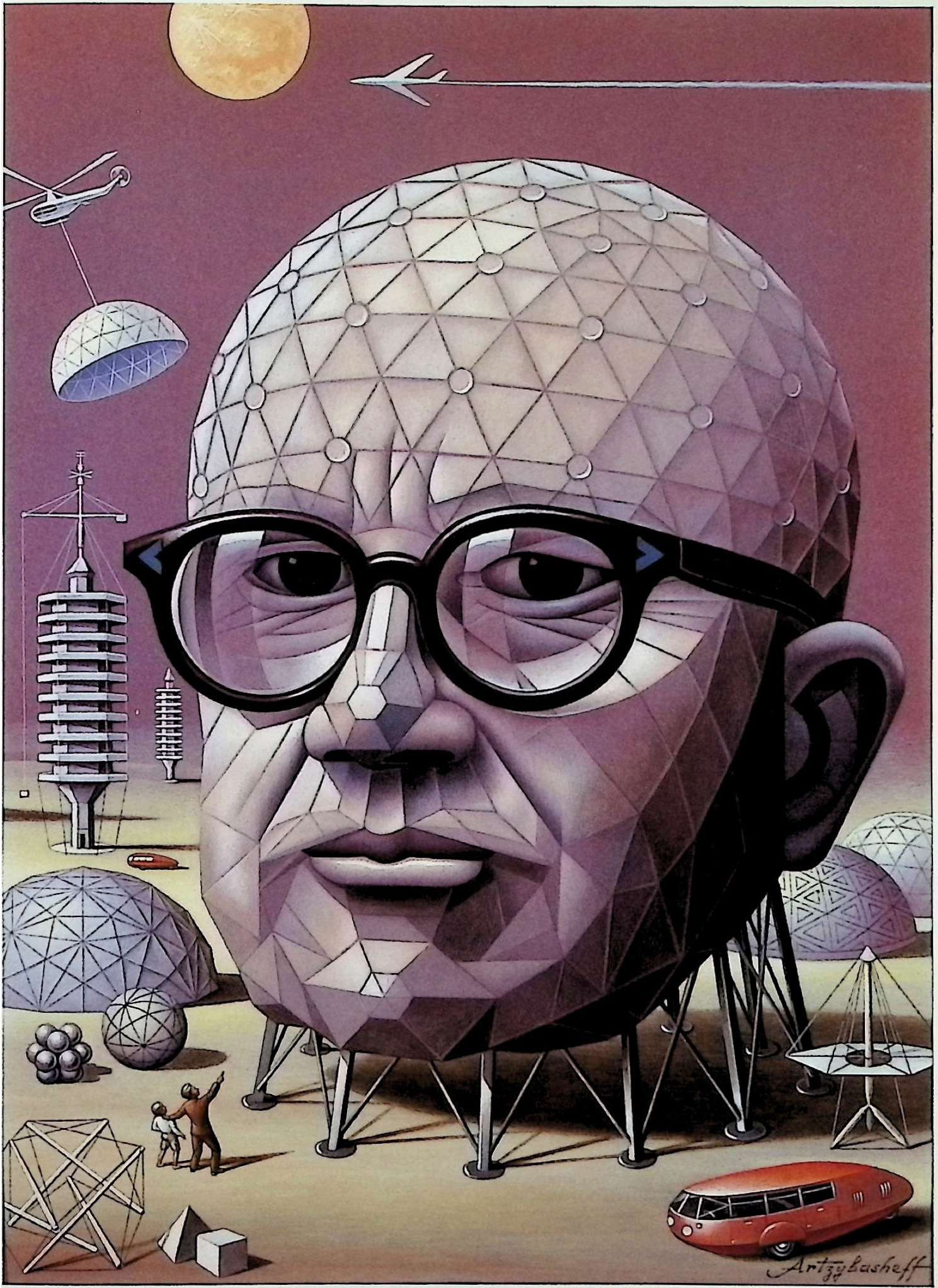
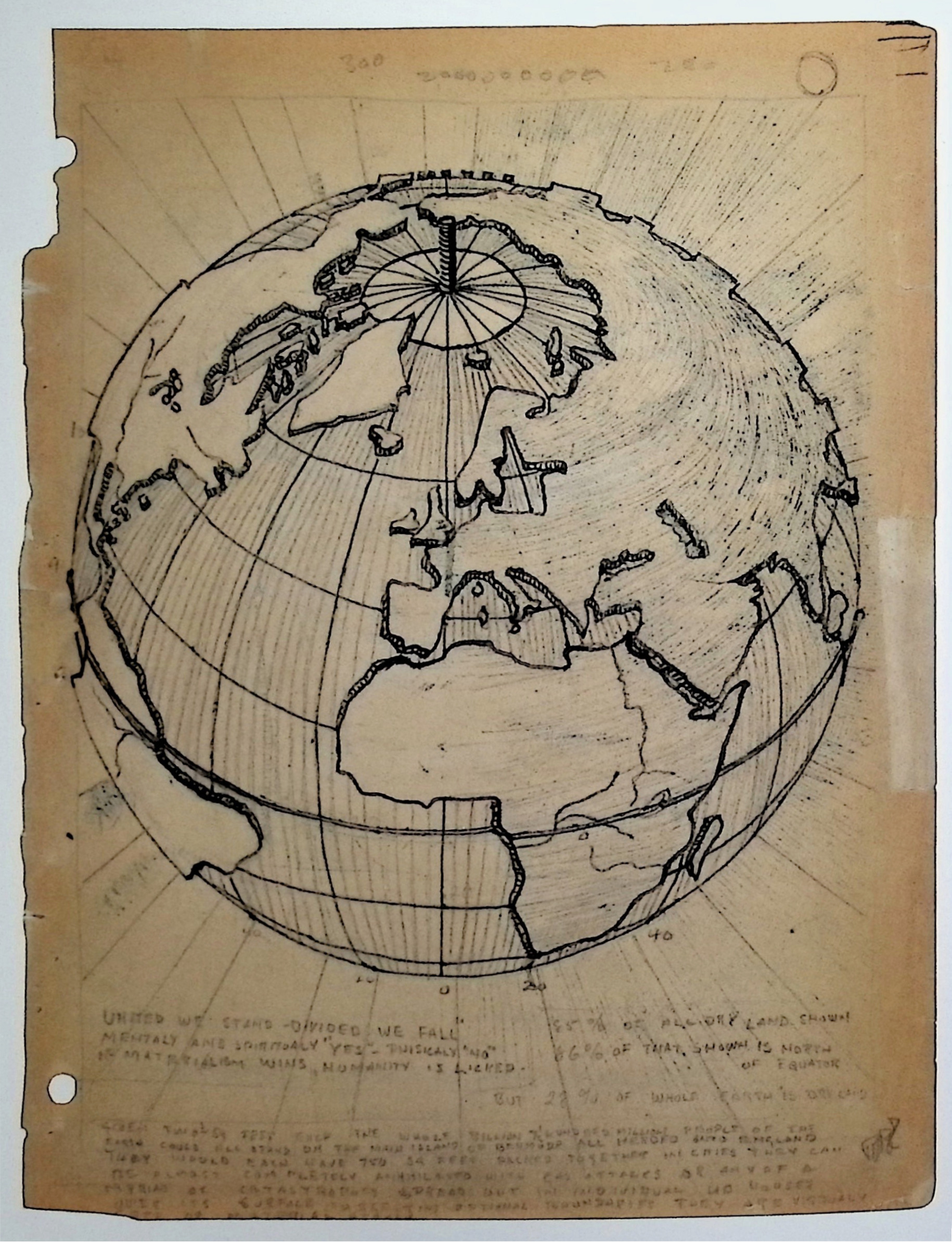
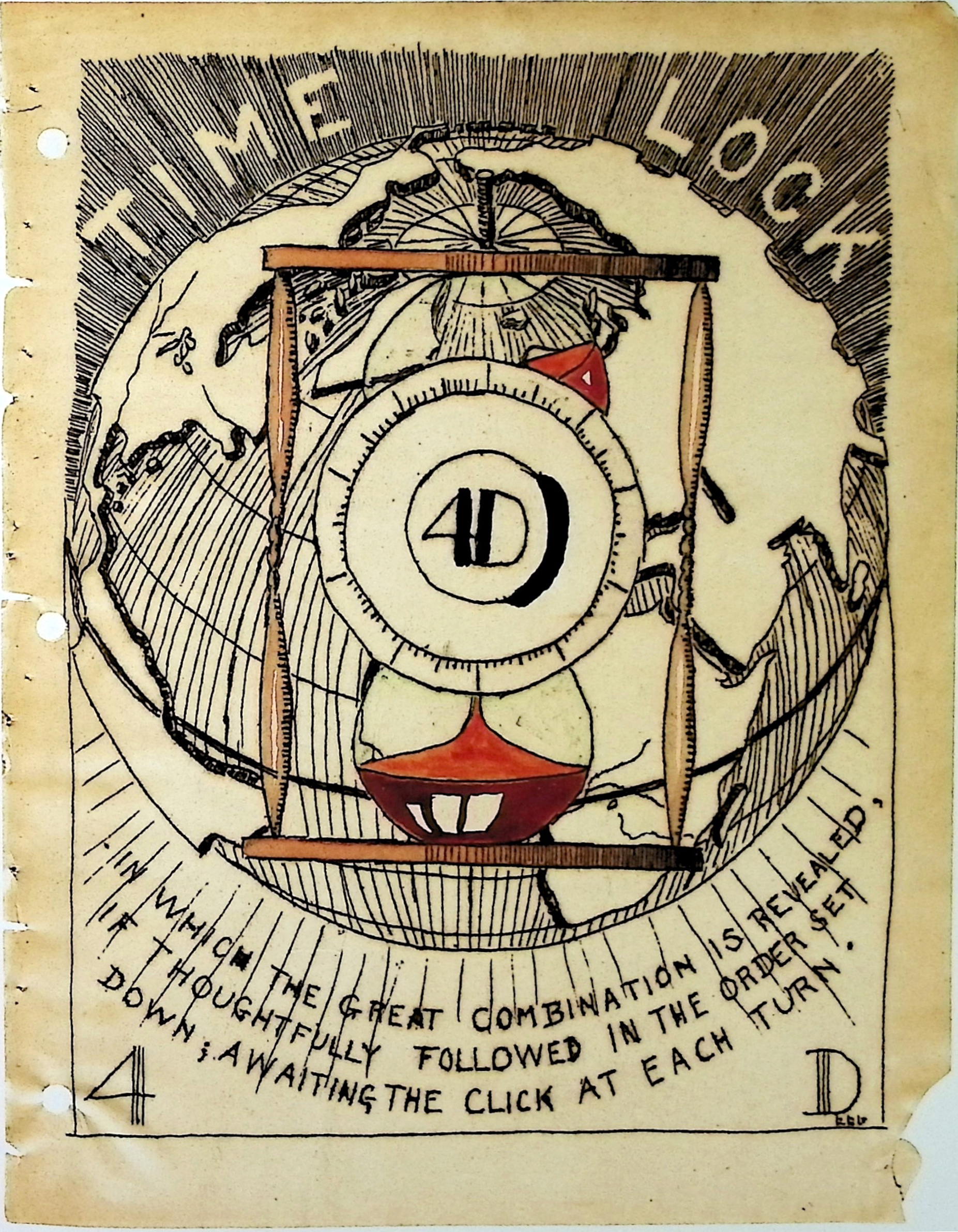
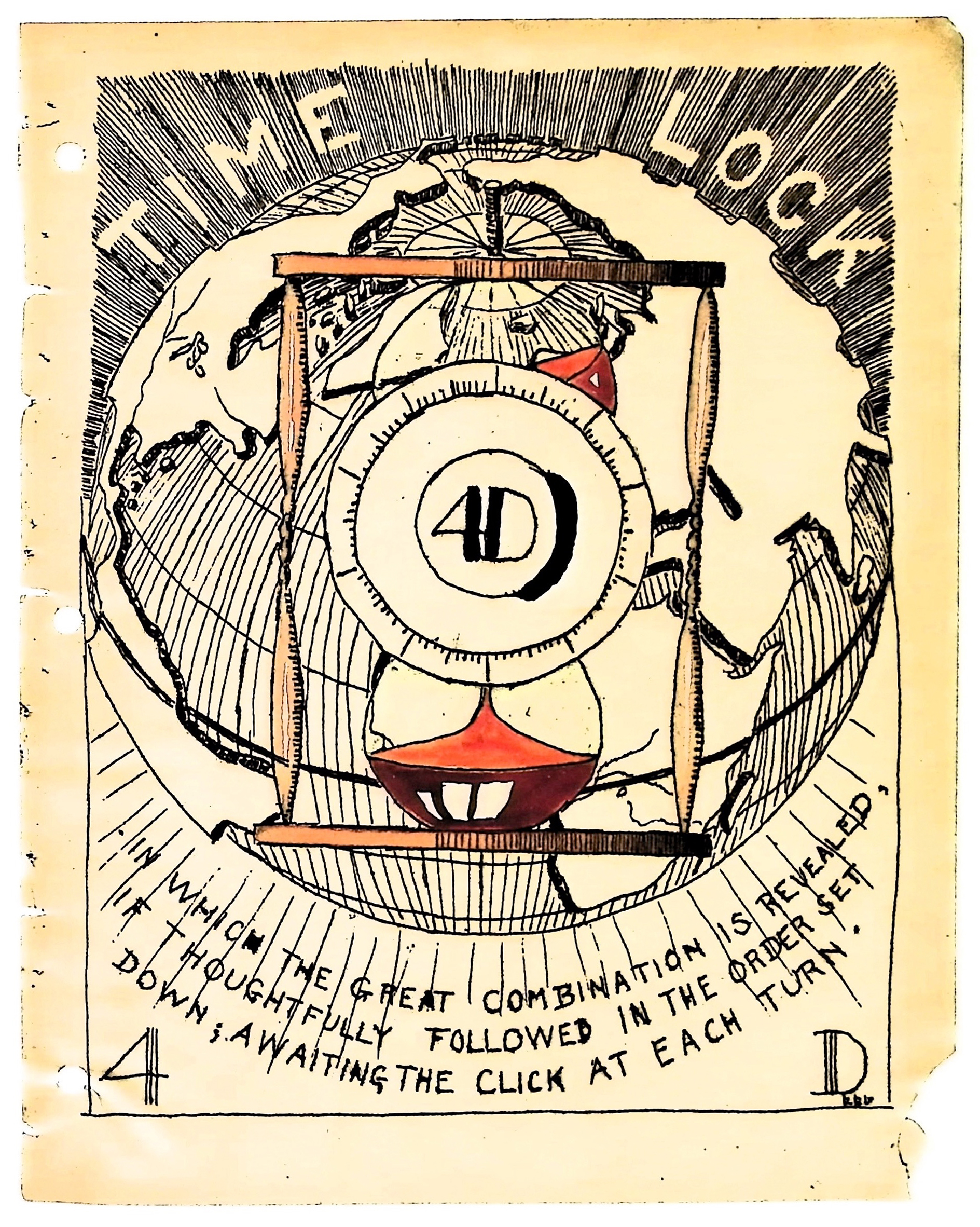
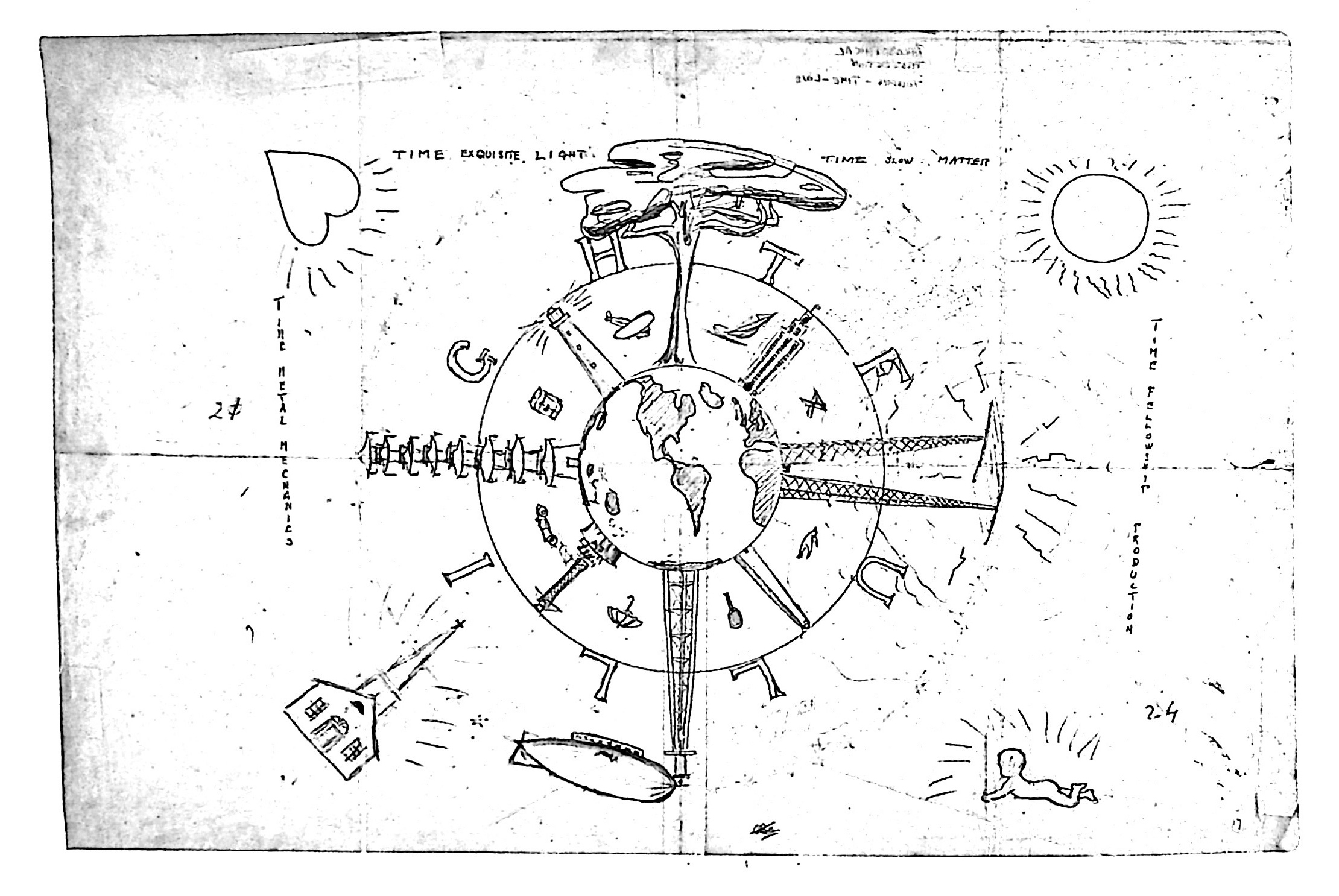
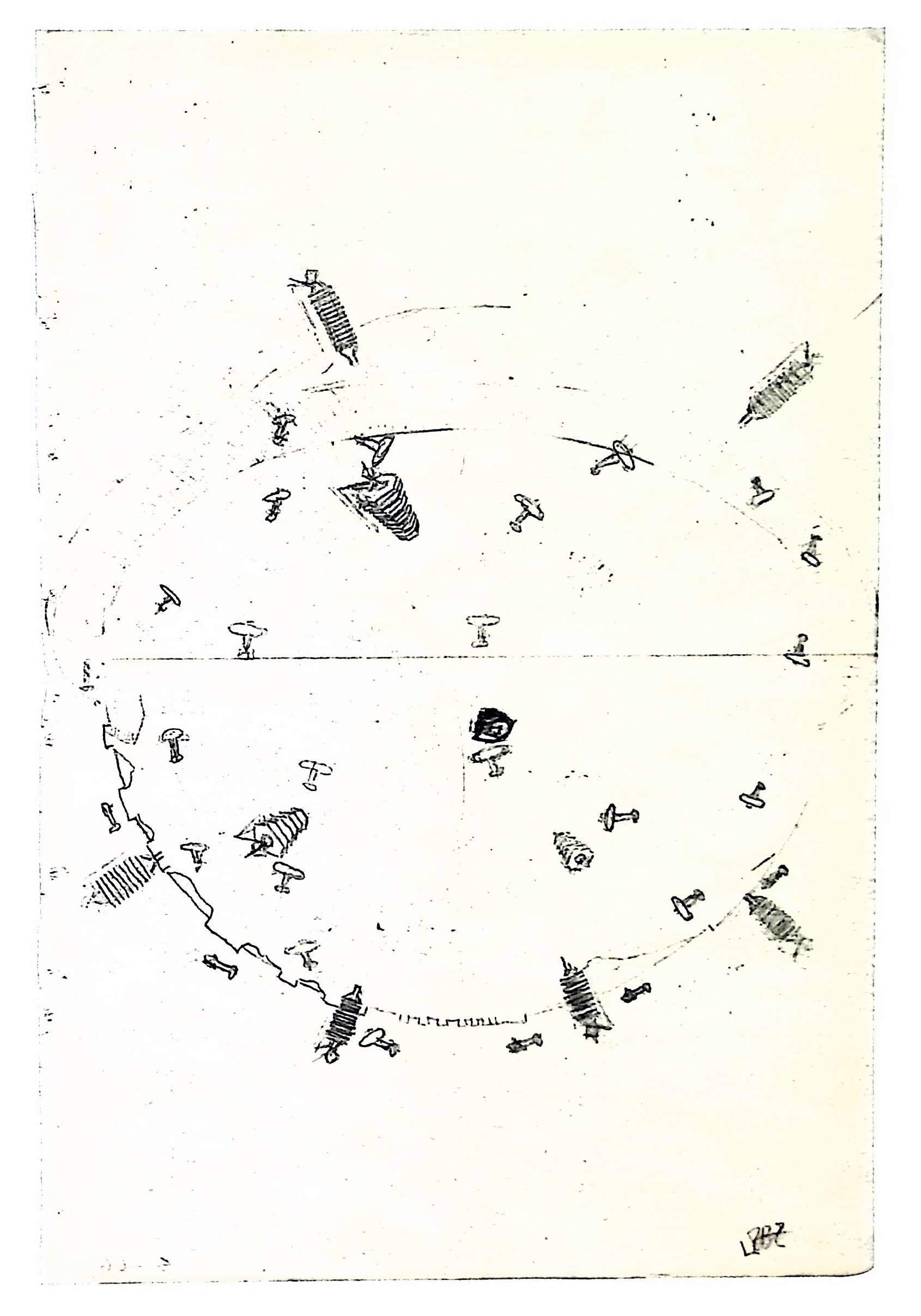

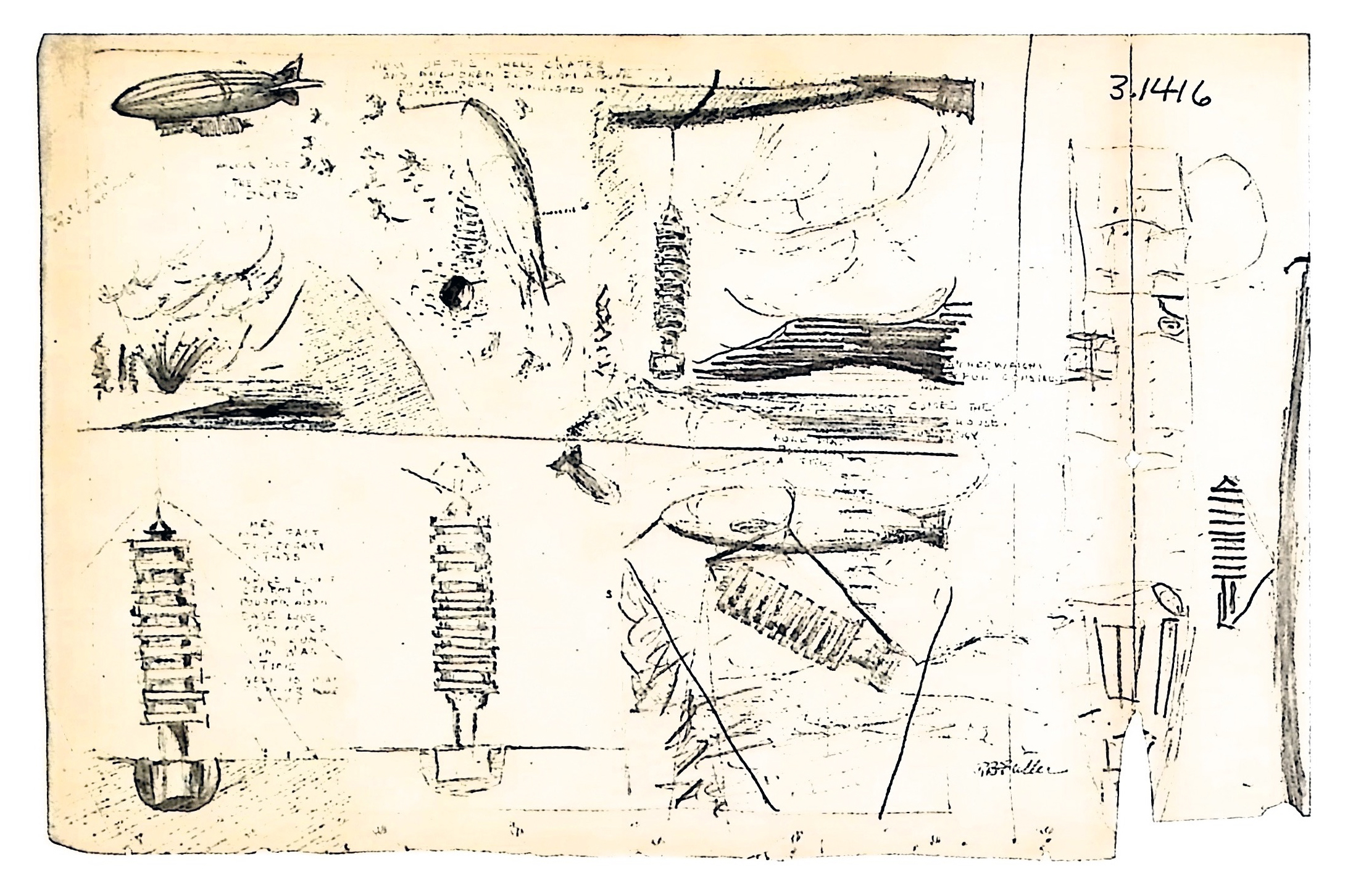
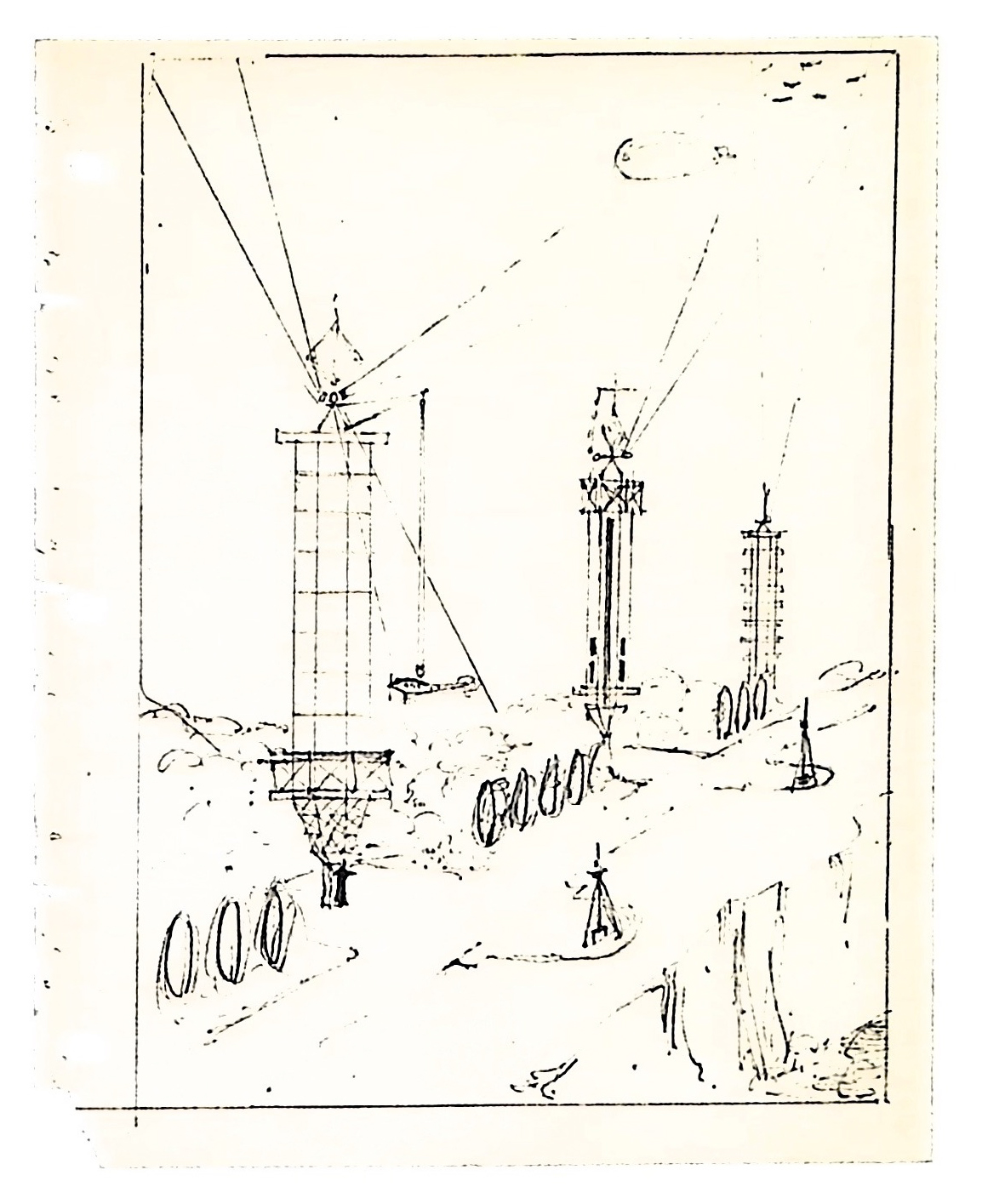
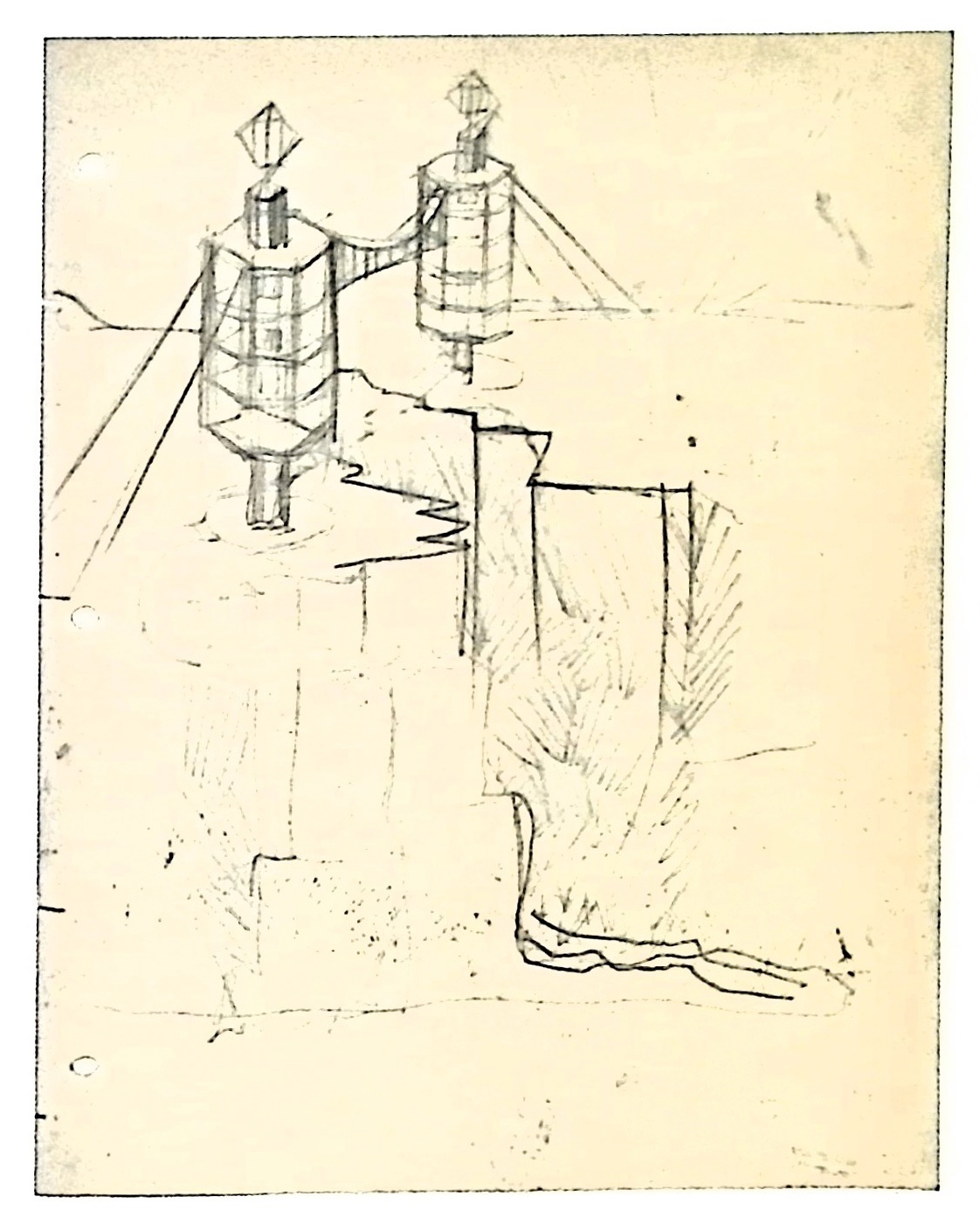
Cover design for 4D Time Lock, 1928 Ink and gouache on paper mounted on paper
11V16 x 8 9/u in. (28.1 x 21.8 cm)

Sketch of Lightful Houses “Lime Exquisite Light,” co. 1928 Graphite on tracing paper 187/jx297/iin. (47.9x 75.9cm)
40 Lightful Towers and 4D Transport, ca. 1928
Graphite and ink on paper 11 x8 in. (27.9x21.6cm)
PLATES
image

Sketch of Zeppelins dropping bombs and delivering 4D Towers to be planted in craters, ca. 1928 Graphite and ink on paper
8’/zx Bin. (21.6x33 cm) (irregular)


: Sketch of 4D Towers, ca. 1928
; Graphite on paper pl. 1 : 11 x 8/z in. (27.9 x 21.6 cm)
pl.8 ; 40 Tower Suspension Bridge, ca. 1928
: Graphite on paper
i 11 x 8‘/z in. (27.9x21.6 cm)
Pi.9
Comparison of Lightful Tower and Traditional Home, 1927 Ink on paper “mimeo-sketch” 8 x 1O’/iin. (20.3 x 27 cm)
pi.10
40 Lightful Tower, Mobile Housing, ca.1928
Graphite and ink on paper
8 ‘Z? x lO’/s in. (21.6x27.6 cm)


pl.ll
ANNE HEWLETT FULLER
(1896-1983)
40 Tower: perspective, co. 1928 Gouache on paper mounted on board 10 x 12 in. (25.4 x 30.5 cm)
PLATES
image image
image
image
Pil2
Opposite:
10 Deck 4D Tower, 1928
Graphite on paper
- 7/t x 8 1/2 in. (27.6 x 21.6 cm)
Attempt to synthesize the Brooklyn Bridge and the Ferris Wheel, ca. 1928 Ink and graphite on paper
- x 8*/z in. (27.9 x 21.6 cm)
Pi.14
Pi.15
Typical 4D Interior Solution Sketch, ca.1928
Graphite and ink on paper
10 7/i x 8 */z in. (27.6 x 21.6 cm)
Model of Dymaxion Shelter with Streamlining Shield, ca. 1932
pi.16
4D Tower: Time Interval 1 Meter, 1928 Gouache and graphite over positive Photostaton paper
14 x 10t/8 in. (35.6x27.6 cm)
PLATES




Buckminster Fullers Dymaxion House The Harvard Society for Contemporary Art, Inc., exhibition brochure cover, 1930 Ink on paper
11 x 8 in. (27.9 x 20.3 cm) (folded folio) 4D logo, combining compass needle, teardrop, and crescent moon, 1928
Ink, graphite, and white highlights on paper
11 x 8!/i in. (27.9x21.3 cm)
 image
image
Sketches of 40 furniture, ca. 1928
Graphite on paper 85/ux 10 ,s/14 in. (21.1 x 27.8 cm)
Proposed Design for Interior of Romany Marie Tavern, ca. 1929 Graphite on paper
8*/2x 107/i in. (21.6 x 27.6 cm)

A Dymaxion Home, Project Elevation, axonometric, and plan, ca.1930
Graphite and watercolor on Photostat 22’/zx 12‘A in. (57.2x31.1cm)
pi.24
A Minimum Dymaxion Home, 1931
Graphite on tracing paper 24 l/a x 28s/i« in. (61.3x72 cm)
image
image image
ANNE HEWLETT FULLER
Dymaxion House with Dymaxion Car, ca. 1934
Watercolor, inh, and graphite on illustration board
13/«x 17*/iin. (33.3 x 43.5 cm)
Typical 4D Interior Before Partitioning or Utility Units are Hung, ca. 1928 Graphite and inh on paper 8 l/tx 10 7/i in. (21.6x27.6cm)

A Minimum Dymaxion Home, Floor Net
DWG1, 1931
Graphite on tracing paper 193/ux 24,3/i4 in. (48.7 x 63 cm)
Dymaxion House, Project Plan, ca. 1927 Graphite, watercolor, and metallic ink on tracing paper
10 ’/< x 10 in. (27.3x25.4 cm) (irregular)
image image
4D House. United States Patent Office file no. 1,793, submitted April 1, 1928, inventor: Buckminster Fuller
From the portfolio Inventions: Twelve Around One, 1981 Screenprint in white ink on clear polyester film overlaid on a Curtis plain blue backing sheet 30 x 40 in. (76.2x101.6 cm)
4D House. United States Patent Office file no. 1,793, submitted April 1, 1928, inventor: Buckminster Fuller
From the portfolio *Inventions: Twelve Around One,*1981
Screenprint on Lenox paper
30 x 40 in. (76.2x101.6 cm)
Unknown artist, likely
ANNE HEWLETT FULLER
Dymaxion House, ca. 1929
Ink and wash on paper
11 1/is x 8 /is in. (29.4 x 22.1 cm)
PLATES
image
image
Structural Studies Associates sketch for Dymaxion 20-Worker-Shelter for Russian Cooperative Mobile Farming, ca.1932
Graphite on tracing paper mounted on paper
8 /is x lOVisin. (21.4 x 27.5 cm)
Structural Studies Associates sketch for Dymaxion 20-Worker-Shelter for Russian Cooperative Mobile Farming, ca.1932
Graphite on tracing paper mounted on paper
8 */2 x 10’/s in. (21.6 x 27.6 cm)
Structural Studies Associates sketch for Dymaxion 20-Worker-Shelter for Russian Cooperative Mobile Farming, ca.1932
Graphite on tracing paper mounted on paper
8‘/2x 10ls/is in. (21.6x27.8 cm)
Structural Studies Associates sketch for Dymaxion 20-Worker-Shelter for Russian Cooperative Mobile Farming, ca.1932
Graphite on tracing paper mounted on paper
8 ‘/tx 10/i in. (21.6x27.6 cm)
36
37
image image image
: Structural Studies Associates sketch for Dymaxion 20-Worker-Shelter for : Russian Cooperative Mobile Farming, i ca.1932
: Graphite on tracing paper mounted
: on paper
pl. 36 j 8’/is X 107/a in. (21.8 x 27.6 cm) pl. JI : Structural Studies Associates sketch ; for Dymaxion 20-Worker-Shelter for Russian Cooperative Mobile Farming, i ca.1932
Graphite on tracing paper mounted : on paper
j 87/i«x 11 in. (21.4x27.9 cm)
: Structural Studies Associates sketch ; for Dymaxion 20-Worker-Shelter for ; Russian Cooperative Mobile Farming, i ca.1932
: Graphite on tracing paper mounted
: on paper
pl.38 ; 8’/l«x 107/a in. (21.8 x 27.6 cm)
Pi.39 i Structure Studies Associates sketch : for Dymaxion 20-Worker-Shelter for Russian Cooperative Mobile Farming, i ca.1932
; Graphite on tracing paper mounted
; on paper
8’/2X1O7« in. (21.6x27.6 cm)
pi.40
Shelter 2, no. 5 (1932)
Cover features a reproduction of Isamu Noguchis hanging sculpture Miss Expanding Universe, 1931
pi.41
ISAMU NOGUCHI (1904-1988)
R. Buckminster Fuller, 1929 Chrome-plated bronze
13 x 8 x 10 in. (33 x 20.3 x 25.4 cm)


Plan of “A Collectors Room,” 1931 Graphite on tracing paper 14 3/« xlls/i in.
(36.5 x 29.5 cm) (irregular)
pi.43
Isometric Drawing for “A Collector’s Room,” 1931
Graphite on tracing paper 15x14‘A in. (38.1 x 36.2 cm)
PLATES



Mock-up of Fortune cover demonstrating three typical streamline equivalents, 1932 Colored pencil and graphite on paper mounted on magazine page 14 x 11‘/x in. (35.6 x 28.6 cm)
image 
Sketch for 4D Transportation Unit, ca.1928
Graphite and ink on tracing paper
8‘/2X 11 in. (21.6 x 27.9 cm)
ISAMU NOGUCHI
in collaboration with
BUCKMINSTER FULLER
Gypsum models of 40 Transport, ca. 1932


Study for Dymaxion Trademark, ca.1933
Graphite on perforated paper
8 S/14x 107/i in. (21.1 x 27.6 cm)
Sketch for 4D Transportation Unit, ca.1929
Ink and graphite on paper
8’/zx 11 in. (21.6 x 27.9 cm)
Dymaxion “2” 4D Transport, 1934, in front of Dymaxion House in the Henry Ford
PLATES


: Dymaxion Car, ca. 1933
: Ink on tracing paper
pl.50 13*/2 x 351J/isin. (34.2x91 cm)
Dymaxion Car, Plan orTop View, ca. 1933
Ink on tracing paper 11x35 ’/z in. (27.9 x90.2 cm)
PLATES
image
image
image image
Motor VehicleDymaxion Car, United States Patent Office no. 2,101,057, filed October 18, 1933, serial no. 694,068, granted December 7,1937, inventor: Buckminster Fuller From the portfolio Inventions: Twelve Around One, 1981 Screenprint in white ink on clear polyester film overlaid on a Curtis plain blue backing sheet 30 x40 in. (76.2x101.6 cm)
Detail of Motor VehicleDymaxion Car, United States Patent Office no. 2,101,057, filed October 18, 1933, serial no. 694,068, granted December 7, 1937, inventor: Buckminster Fuller From the portfolio Inventions: Twelve Around One, 1981 Screenprint on Lenox paper 30 x40 in. (76.2 x 101.6 cm)
Motor VehicleDymaxion Car, United States Patent Office no. 2,101,057, filed October 18,1933, serial no. 694,068, granted December 7, 1937, inventor: Buckminster Fuller From the portfolio Inventions: Twelve Around One, 1981 Screenprint in white ink on clear polyester film overlaid on screenprint on Lenoxpaper 30 x 40 in. (76.2 x 101.6 cm)
pi.55
4D Tower Garage (Proposal for the 1933 Worlds Fair in Chicago), 1928 Colored pencil and graphite on paper 1015/u x 83/s in. (27.8x21.3 cm)

Charge to the account of
Isamu. Noguchi Cara Greenwood 86 Calle Republiea Columbia Mexico City EINSTEINS FORMULA DtlYL TN/&ION INDIVIDUAL SPECIFICS RELATIVITY READS QUOTE ENERGY EQUALS MASS TIMES THE SPEED OF LIGHT SQUARED UNQUOTE SPEED OF LIGHT IDENTICAL SPEED ALL RADIATION COF .1IC GA1Z.1A X ULTRa VIOL. T INFRA RED RAYS ETCETERA ONE HUNDRED EIGHTY SIX T iOJSLLJD ULIS PIE SL-COliD WHICH SQUARED IS TOP OR PERFECT SPEED GIVING SCIENCE A FINITE VALUE FOR BASIC FACTOR IN MOTION UNIVERSE STOP SPEED OF RADIANT ENERGY r; I.iL PIRLCTIONAL OUTWARD ALL DIRECTIONS EXPANDING l.AVE SURFACE DIAMETRIC POD Al SPIED A. AY FRO . SELF IS TWICE SPEED I1J ONE DIRECTION AND SPEED OF VOLUME INCREASE IS SQUARE OF SPEED IN ONT DIRECTION APPROXIMATELY THIRTY FIVE BILLION VOLUMETRIC MILES PER SECOND STOP FORMULA IS WRITTEN QUOTE LETTER E FOLLOWED BY EQUATION MARK FOLLOWED BY 12.IT. f. Y FO LO ED BY LETTER C FOLLOWED CLOSELY BY ELEVATED SMALL FIGURE TWO SYMBOL OF SQUARING UNQUOTE OHLY VARIABLE IN FORMULA IS SPECIFIC KASS SPEED IS A UNIT OF RATE WHICH 12 Al; .111. .-AilD RATIO OF BOTH TIl.il. AND SPACE AND NO GREATER
IT. CF .-PEZll THAI. .HAT PROVIDED BY ITS CAUSE ’..RICH IS PURE ENERGY LATENT OR RADIANT IS ATTAINABLE STOP THE FORMULA THEP.LFOrll. PROVIDES A UNIT AND A RATE OF PERFECTION TO .TEIC1-1 THE LATIVE HIPFICTION OR INEFFICIENCY OF ENERGY RELEASE IN RADIANT OR CONFINED DlfiECTIOi; 01- ALL TE.1P0KAL SPACE PHENOMENA MAY BE COMPARED BY ACTUAL CALCU- - RATION STOP SIGNIFICANCE STOP SPECIFIC QUALITY OF ANIMATES IS CONTROL WILLFUL OR 3 IERWISE OF RATE AND DIRECTION ENERGY RELEASE AND APPLICATION NOT ONLY OF SELF iC.-lAllIS 1 2u“ ;r FRO! he 12ACHIIB. . IVIDED ? CXAili lb ;.UD 0? ALL Illi IACjIS
A11D INARIiiATES IS POTENTIAL OF 2STABDISHMENT THROUGH EINSTEIN FORMULA BUCKY
1111. QltCKEM. ?IR151 A.SD SAFEST UA\ IO SINH MONEi IS m III EGRAPH OR CABLE.
Telegram from Fuller to Isamu Noguchi explaining E = MC2,1936
Type ink on paper
7 x 8*/z in. (17.8x21.6 cm)
Sketch of Dymaxion Bathroom, 1936 Graphite and ink on vellum 14 3/< x 18 */< in. (37.5 x 46.4 cm) (irregular)
PLATES

Photograph of the interior of a Dymaxion Bathroom, 1937

pi.59
Prefabricated Dymaxion Bathroom, United States Patent Office no. 2,220,482, filed May 12, 1938, serial no. 207,518, granted November 5, 1940, inventor: Buckminster Fuller
From the portfolio Inventions: Twelve Around One, 1981 Screenprint in white ink on clear polyester film overlaid on a Curtis plain blue backing sheet 30 x 40 in. (76.2 x 101.6 cm)
Prefabricated Dymaxion Bathroom, United States Patent Office no. 2,220,482, filed May 12, 1938, serial no. 207,518, granted November 5, 1940, inventor: Buckminster Fuller
pi.60
From the portfolio Inventions: Twelve Around One, 1981 Screenprint on Lenox paper 30x40 in. (76.2x101.6 cm)
PLATES



Sketch for Dymaxion Deployment Unit, 1941 Ink, graphite, and colored pencil on paper
11 ‘/16 X 8s/« in. (28.1x21.9cm)

Sketch for Dymaxion Deployment Unit, 1941 Colored pencil, graphite, and ink on paper
11x8 ‘/tin. (27.9x21.6 cm)
Dymoxion Deployment Unit, 18 Foot Diameter, 1941 Diazotype
22 x 34 ‘/i in. (55.9 x 86.7 cm)
pi.64
Building ConstructionDymaxion Deployment Unit (Sheet), United States Patent Office no. 2,343,764, filed March 21, 1941, serial no. 384,509, granted March 7,1944, inventor: Buckminster Fuller
From the portfolio Inventions: Twelve Around One, 1981 Screenprint in white ink on clear polyester film overlaid on a Curtis plain blue backing sheet 30 x 40 in. (76.2 x 101.6 cm)
pi.65
Building Construction-Dymaxion Deployment Unit (Sheet), United States Patent Office no. 2,343,764, filed March 21, 1941, serial no. 384,509, granted March 7, 1944, inventor: Buckminster Fuller From the portfolio Inventions: Twelve Around One, 1981
Screenprint on Lenox paper
30 x 40 in. (76.2 x 101.6 cm)



Marketing photograph of the interior of the Dymaxion Deployment Unit, 1941
pi.67
Dymaxion Airbarac, Rest Area Dormitory/3 Nurse 60 Bed Hospital, 1945 (drawing by L. Don Royston) Diazotype
26 */«x 36 1!/h in. (66.4 x 93.5 cm)
Pi.68
Wichita House: Airbarac, 1945 (drawing by L Don Royston) Graphite on tracing paper 26/z x 36/i in. (67.3x91.8 cm)
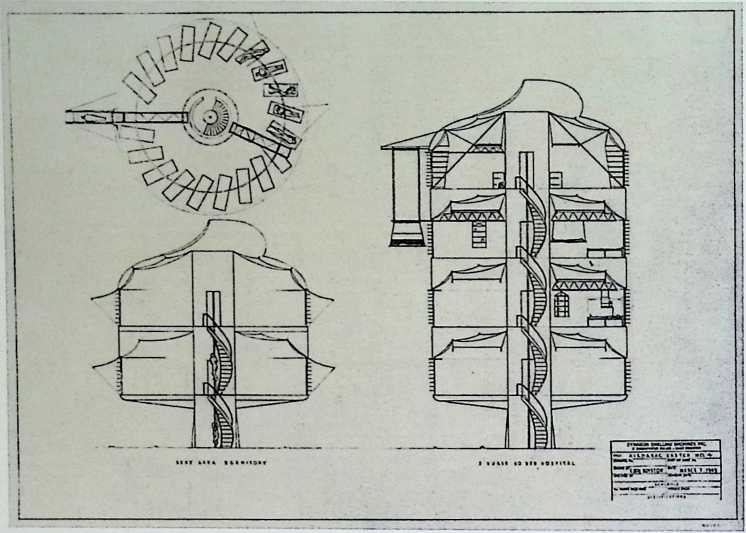



Dymaxion Dwelling Machine, Wichita House, project
Study for air circulation: floor plan, 1945
Graphite on paper
22x 34’/i in. (55.9 x 86.7 cm)
IlVf
Dymaxion Dwelling Machine, Wichita House, Model, 1946 Painted fiberglass Diameter: 36 in. (91.4 cm), height: 23 in. (48.4 cm)
Pi.71
Photograph of model of Dymaxion Dwelling Machines community, ca.1946


Dymaxion Dwelling MachineWichita House, United States Patent Office, filed March 16, 1946, inventor: Buckminster Fuller
From the portfolio Inventions: Twelve Around One, 1981 Screenprint in white ink on clear polyester film overlaid on a Curtis plain blue backing sheet 30 x 40 in. (76.2 x 101.6 cm)
Pi.73
Dymaxion Dwelling MachineWichita House, United States Patent Office, filed March 16, 1946, inventor: Buckminster Fuller
From the portfolio Inventions: Twelve Around One, 1981
Screenprint on Lenox paper
30 x 40 in. (76.2 x 101.6 cm)


pi.74
Dymaxion Map, 1943 Pull-out from Life (March 1, 1943)
Pi.75
Dymaxion Map, 1943 Pull-out from Life (March 1, 1943)


DYMAXION WORLD (continued)
HOW TO ASSEMBLE THE GLOBE
Here demonstrated i» the rimplc procedure by which the segments of the Dymaxion World inaparo aocinblcd intoa visual approximation of n round globe. The opposite page is the reverse aide of the second of tlic twolicavy center dice Lion which the map is printed.
First step, removal of center sheets from magazine, must Ire taken wills care loavoid tearing map on staples. Segments cut out arc best fastened together by paste or mucilage. Because they warp the paper, pins should not be used. For neatest producLsequcncc d assembly here illustrated should be followed. Marginal letters of triangles match marginal letters of squares.
The map, thus assembled into a 14-faced solid, has many of the advantages of a globe. Like a globe it can be viewed from any perspective to bring geographical relationships into new reliefto show that the Southern is the water hemisphere, that Chicago and Fvrrd- lorskare fairly close together <nrr the top < Z the world, tliat Dutch Harbor lies clowr to the shortest San Francisco-Tokyo route than Pearl Harbor.
Before they ore hidden intide gid*, italiain on reverse of each segment are u urth in tpeelxa. For example, the North Pole square’s 8J)rj d world populaliai contrasts dramatically will* the South Pole’s .0004
BENDING OE STAPLES is first step in removing mop from copy of LIFE. Bent back, staples hold copy intact.
SCORING OF MARGINS cf cnlcred faced segment with dip or dull knife facilitates folding </ Caps (rijtl).
FOLDING OF FLAPS aLcutl f.-fkw marg’a d cap precisely. Haps cf segments to be jciacd are kryrd Ly letters.
HOUSEHOLD PASTE ormucibgeb bat means for fastening tbps. It should be spread thinly to avoid warping.
PINCH CLIPS, easy to apply, permit disassembly cf globe. If clips are used last segment must be taped or glued ia.
C t-LiLOPHANE TAPE is substitute for paste and cEps. 11 m tut be a ppfied aside and cut to keep edges together.
POLAR SQUARE and triangles should first be assembled into unit. Care should be taken to keep edges in register.
MOST DIFFICULT is this step ia which square is joined to triangle. Polar square shoal! be held Cat ea t sta!
SECOND POLAR ASSEMBLY is ra seated. Paste should be allowed to dry a little before the Caps are joined.
LAST TRIANGLE b L-n unfair icd mil uln Caps are secured, it can tbea tc set Ly pressure (rtaa thewtskle.
SQUARES AND TRIANGLES are now fastened and structure Is self-supporting. Ibpcr has surprising rigidity.



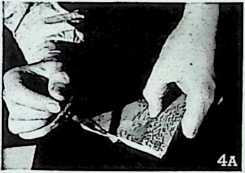

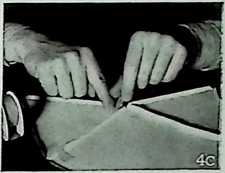




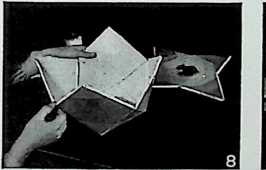
OR YOU CAN USE SEGMENTS FOR A FLAT, MOVABLE MAP (SEE PAGE 53)
pl
76
Instructions for assembling Dymaxion
Map, 1943
Pull-out from Life (March 1, 1943)
Pi.7Z
Fuller in front of various Dymaxion Map projections, ca. 1945
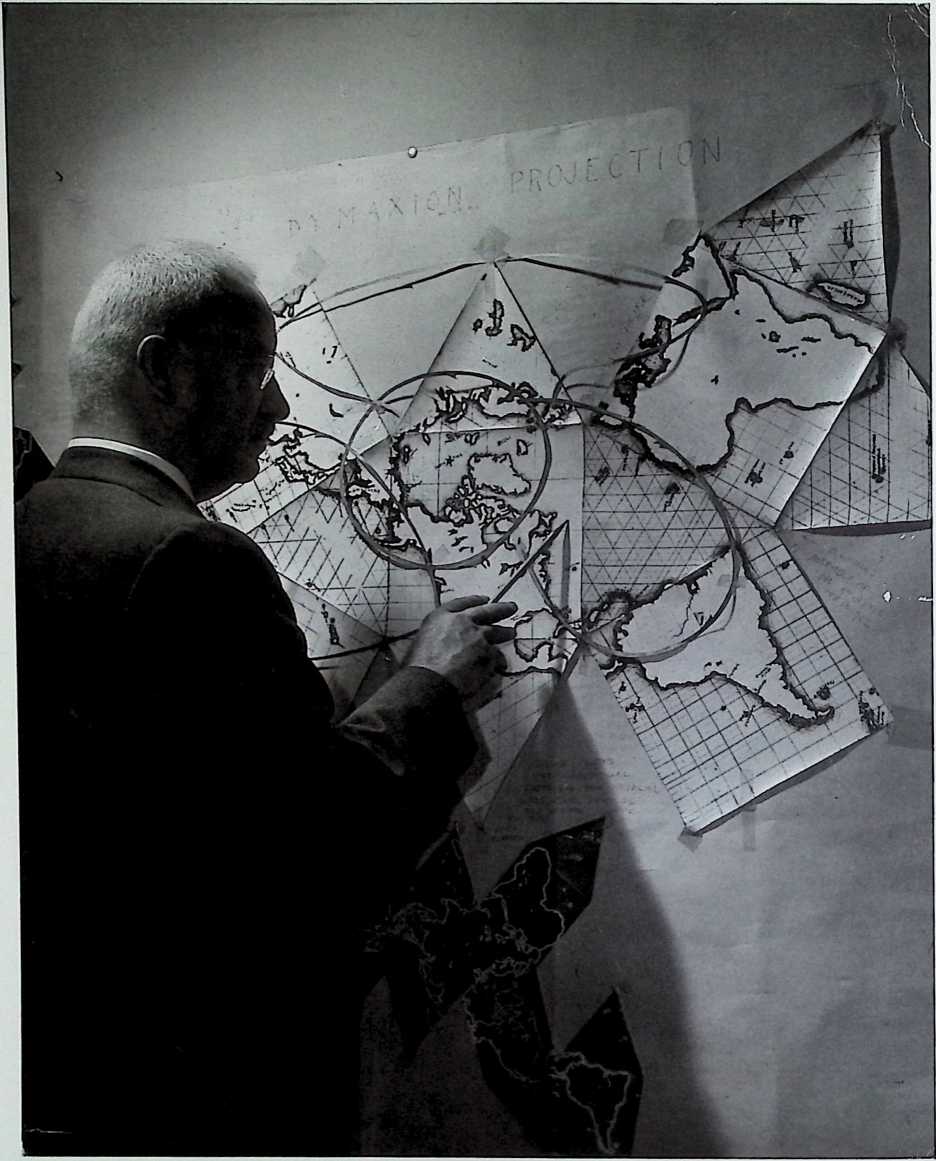
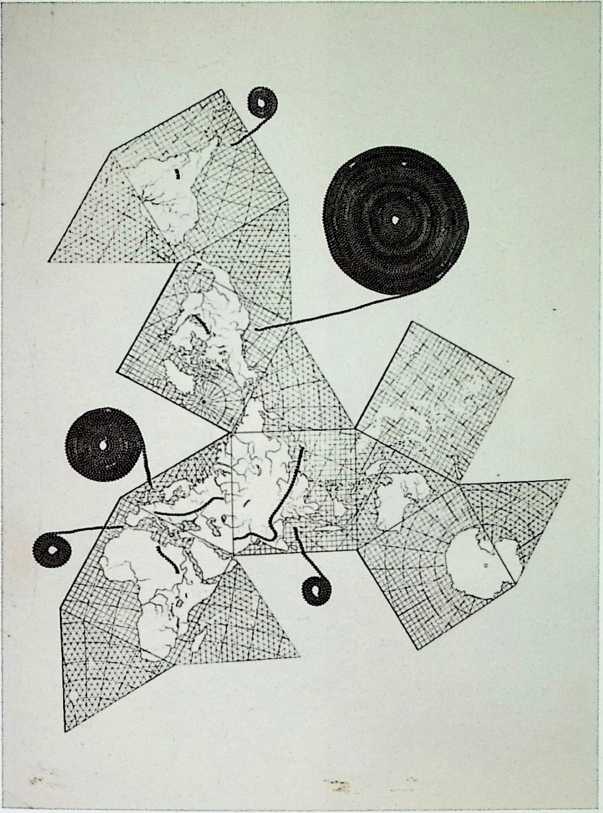
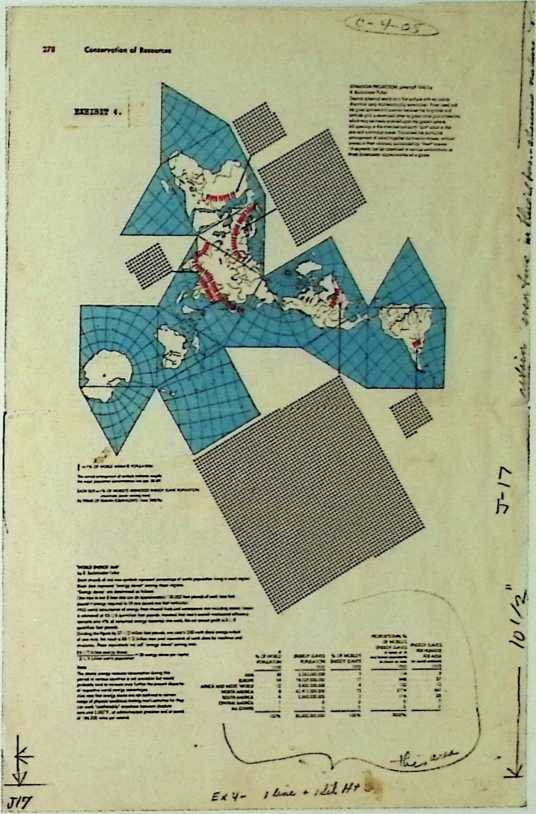
Photograph of Dymaxion Projection Map displaying the world distribution of “energy slaves” Photograph by Aaron Siskind (1903–1991) for Fullers article “Comprehensive Designing” in Trans/formation 1, no. 1 (1950) Gelatin silverprint
13I5/ux9’/4in. (35.4 x 24.8 cm)
Dymaxion Projection Map displaying the world distribution of “energy slaves” (replacement of human labor by machines), from World Geo-Graphic Atlas, 1953, edited and designed by Herbert Bayer (1900-1985), printed privately for the Container Corporation of America Commercial offset print
16 x 11 */< in. (40.6 x 28.6 cm) (folded)
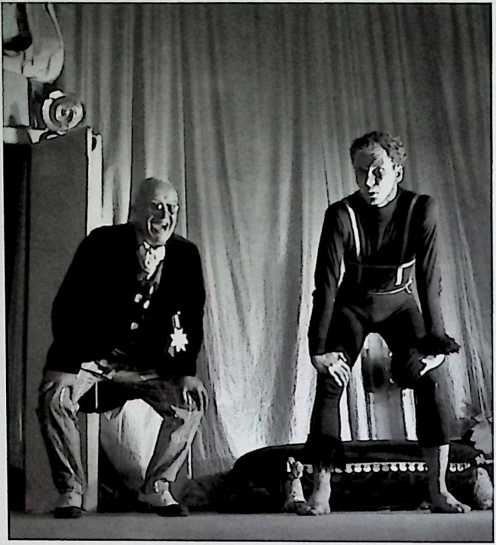

THE RI SE Of MEDUSA
a lyric comedy in One act
by
LR1K SATIE
with trunic fur dance by the tauic
tramlitzil fr.tn the Ionh h? M.<_ Richard*
M,,t. 1im. thr 4»y Lrfurr yrUrnlay; the <!rn t»f ILrnm Mrdu»a
CAST ur OUBACtXJU
B_r<n Medina, a very rich rentier Rdvrarp, hit aervar.t
AiLjLq. aff.jhccd to Frjtene
Fibette. Medina** daughter
Jonaa. a turfy mrtkinica! munkev Paer
: CLEMENS KALISCHER
\ (b.1921)
: Buckminster Fuller and Merce
: Cunningham in The Ruse of Medusa
by Erik Satie, Black Mountain College, pl. 80: August 14, 1948
Uleo U*ln<lr.n & Anhar P»nn Merer Catuunph.ru John Capr WiIImct & Elalor Kuonia/r Mary Ootim Ru hard iJ-br, Marion Rothirnn
pl. ol Playbill for production of The Ruse
- of Medusa by Erik Satie, performed
: at Black Mountain College, August 14,
; 1948
Letterpress print on coated paper
- 11 */s x 7 l/z in. (28.3 x 19.1 cm) (folded)
/IT)



JOHN CAGE (1912) “For Bucky at 85 with love,” 1980 Ballpoint pen on paper IS/zxllAin. (39.4 x28.6 cm)
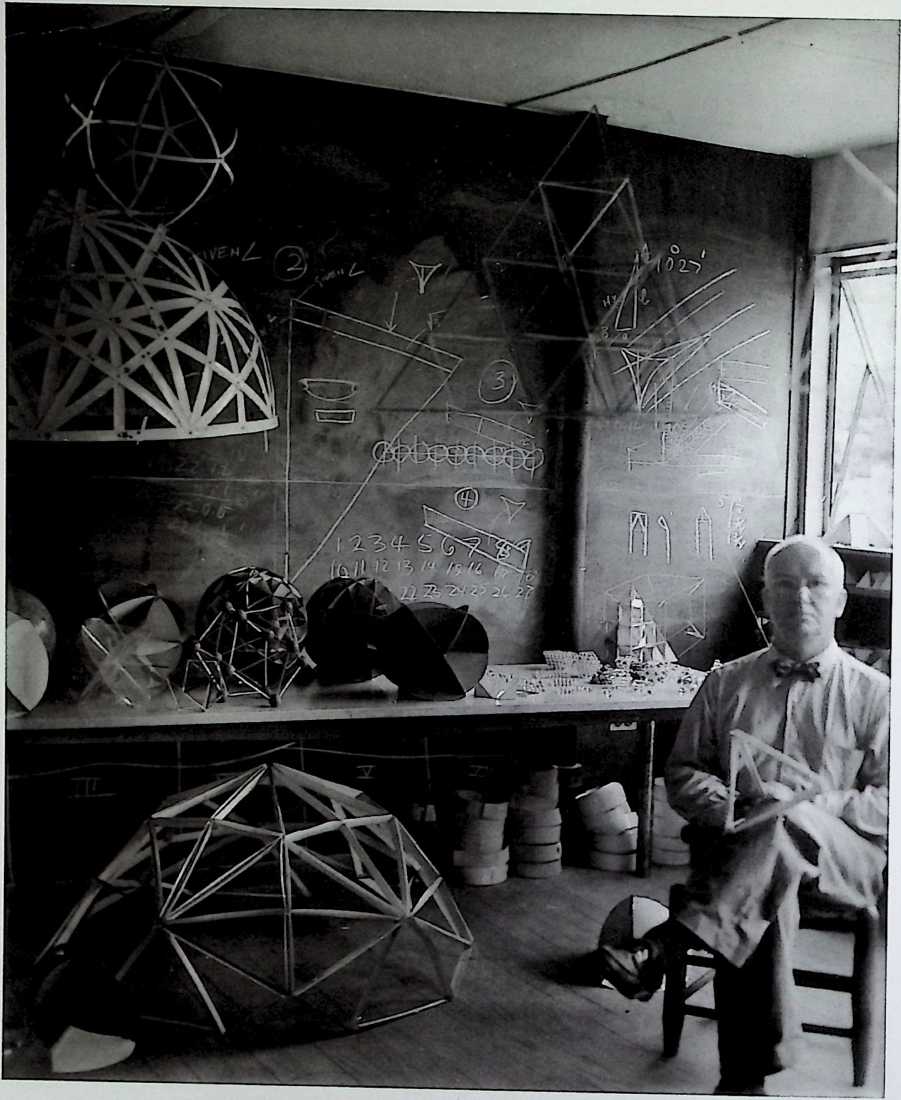
HAZEL LARSEN ARCHER
(1921-2001)
Fuller in his classroom at
Black Mountain College, summer 1948
pi.84
BEAUMONT NEWHALL
Great circle model, ca. 1949
pl.85
(1908-1993)
Fuller with students, constructing dome from Venetian blinds at Black Mountain College, summer 1948
PLATES
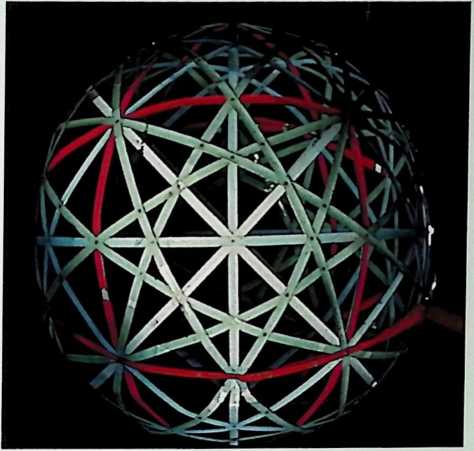
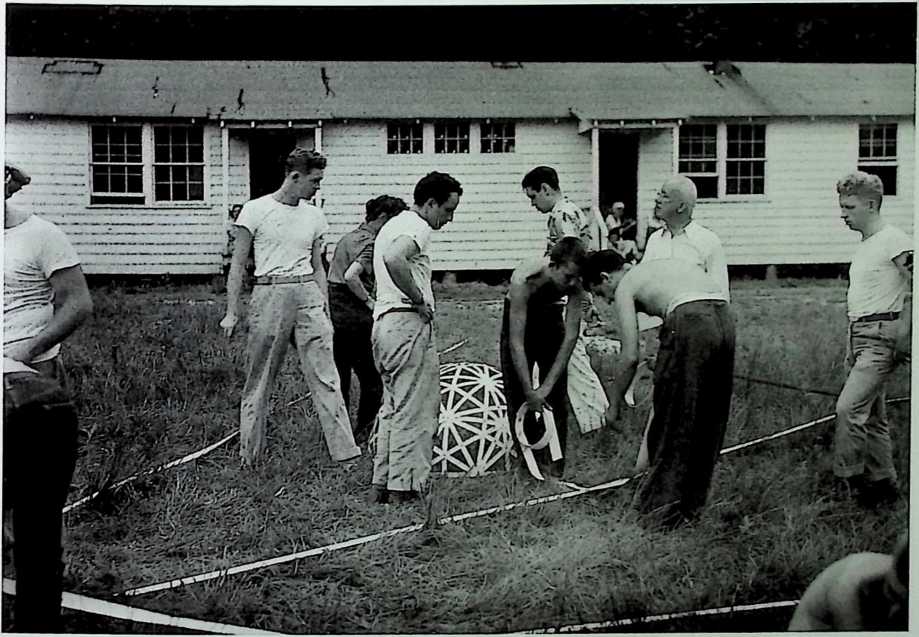
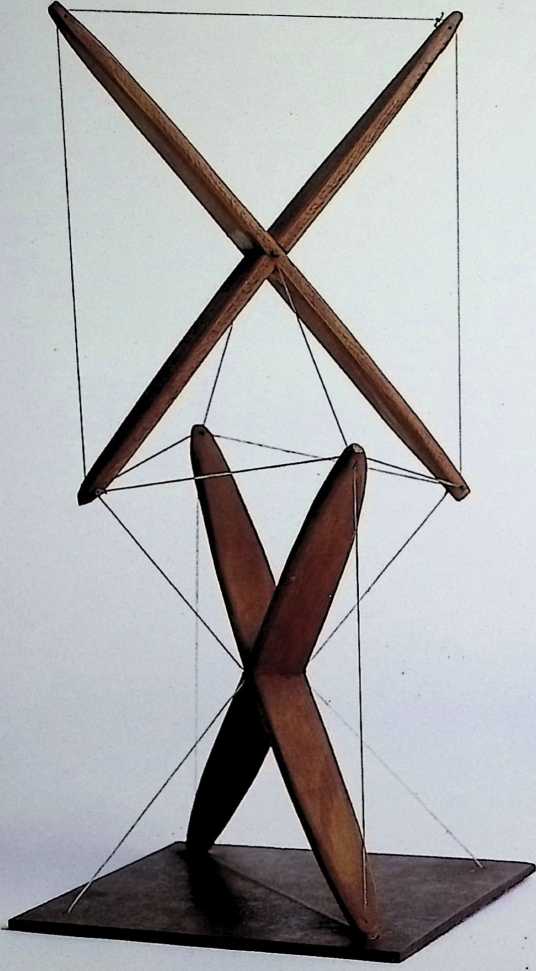
KENNETH SNELSON (b. 1927) parly X-Piece, 1948 (re-created 1959) Wood and nylon
11 */zx 5*/x 5J in. (29.2x13.7x13.7 cm)

F.ir-2t;-2o- .?rX,;
L go- i-Hou .
~r= in®-1s- 40”
Buckminster Fuller’s 25 Great Circles, n.d.
Colored pencil and graphite on paper 11 x 8’/u in. (27.9x21.7 cm)
Study of Closest Packing of Spheres, 1948 Ink, colored pencil, and graphite on paper
127ix 19 3/4in. (32.7x50.2 cm)
Geometrical Study, 1948
Ink, colored pencil, and graphite
pi.89
on paper
123/4xl93/iin. (32.4 x49.2 cm)


Three Frequency Geodesic Sphere, n.d. Felt-tip pen and graphite on paper 8 */2x 10 */« in. (21.6 x 26 cm)
PLATES




| pi.91 | Great Circle Model, n.d. Wire Diameter 20’A in. (51.4 cm) |
pi.93 | Great circle model, n.d. Wire Diameter 20/? in. (52.1 cm) |
| Pi.92 | Great circle model, n.d. Wire Diameter 20 *A in. (51.4 cm) |
pi.94 | Great circle model, n.d. Wire Diameter 20 *A in. (51.4 cm) |


First kinetic model demonstrating the Jitterbug Transformation, 1948
Steel, brass, acrylic plastic, and twine pl.96 ; 25’/2 x 25 Vtx 25‘/tin. (64.8 x 64.8 x 64.8 cm)
| pi.97 | Tetrahedra/Octohedra Close Pock, co. 1960–63 Paper Diameter 4 /z in. (11.4 cm) |
| Pi.98 | Vector Equilibrium Nolid, ca. 1960-63 Paper Diameter 4 in. (10.2 cm) |
| pi.99 | Compound Tetrahedra, ca. 1960-63 Paper Diameter 3 in. (7.6 cm) |
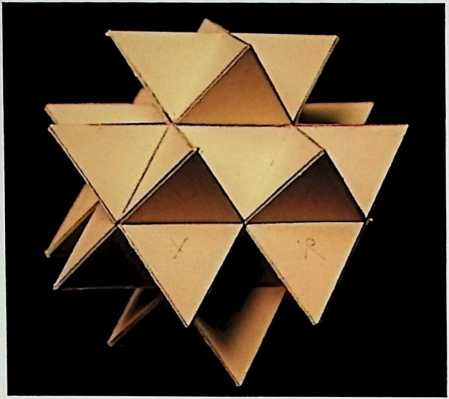
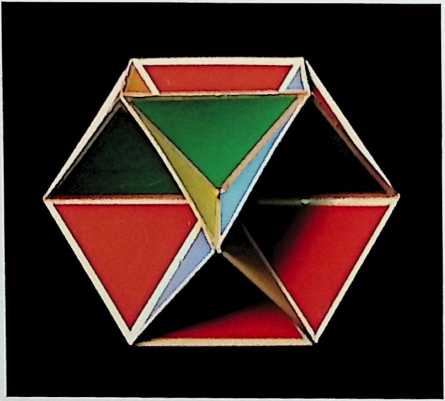
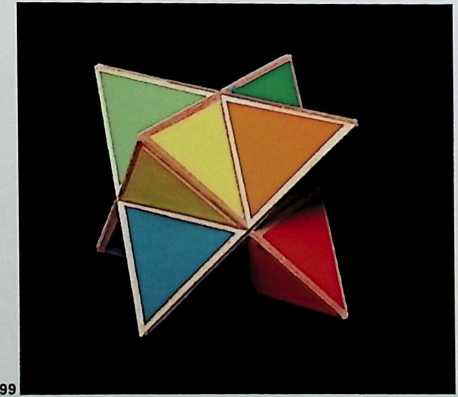

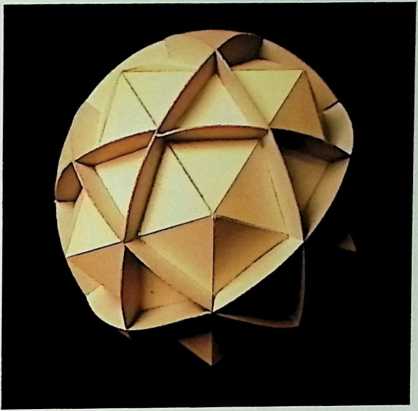
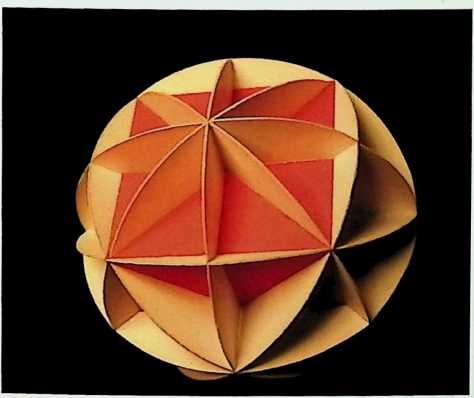

| Pl.100 | Icosahedron Dodecahedron Duality, ca. 1960-63 Paper Diameter? in. (17.8 cm) |
| pl.101 | Great Circles Spherical Nolid with Cube Inscribed, ca. 1960-63 Paper Diameter? in. (17.8 cm) |
| Pi.102 | Icosahedron with 6 Great Circle Planes, ca. 1960-63 Paper Diameter 8 in. (20.3 cm) |
| Pi.103 | Frequency Spherical Cube with Cube Inscribed, ca. 1960-63 Paper Diameter 8 in. (20.3 cm) |

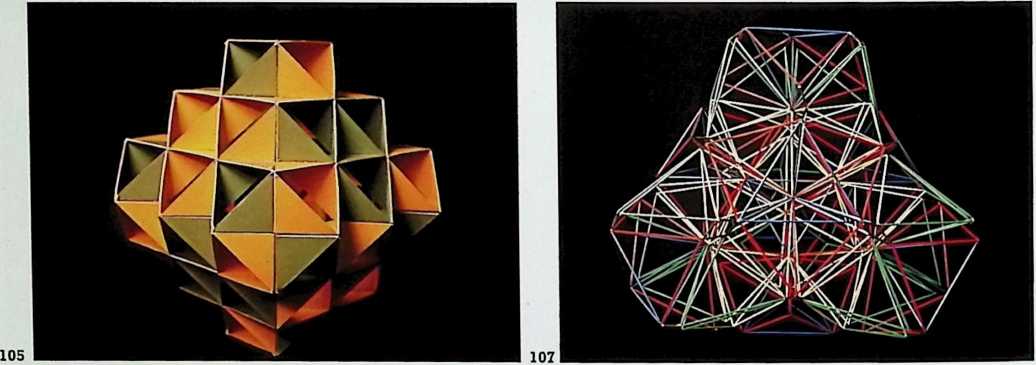
| pi.104 | Cube Space Filling Triangular Tessellation, ca. 1960-63 Paper and wood toothpicks Diameter 16 in. (40.6 cm) | pi.106 | Space Filling Polyhedra, Cube Corner Truncation Triangular Tessellation, ca. 1960-63 Paper and wood toothpicks Diameter 6 in. (15.2 cm) |
| Pi.105 | Close Packing of Polyhedra, ca. 1960-63 Paper Diameter 6 in. (15.2 cm) |
pi.107 | Compound Edge Tangent and Concentric Arrangement of Multiple Polyhedra, ca. 1960-63 Wood toothpicks Diameter 13/? in. (34.3 cm) |
| pi.108 | ,4,6,7 … Frequency, Probably Alternate Method, Spherical Geodesic Octahedron, ca. 1960-63 Paper Diameter 14 in. (35.6 cm) |
p.110 | Great Circles Rhombic Dodecahedron, Tetrahedron, Spin Axii ca. 1960-63 Paper Diameter? in. (17.8 cm) |
| Pi.109 | Great Circle Vector Equilibrium, ca. 1960-63 Paper Diameter 12 in. (30.5 cm) |
pl.lll | Icosadodecahedron with Compound Octahedron Inscribed, ca. 1960-63 Paper and wood toothpicks Diameter 6 A in. (15.9 cm) |
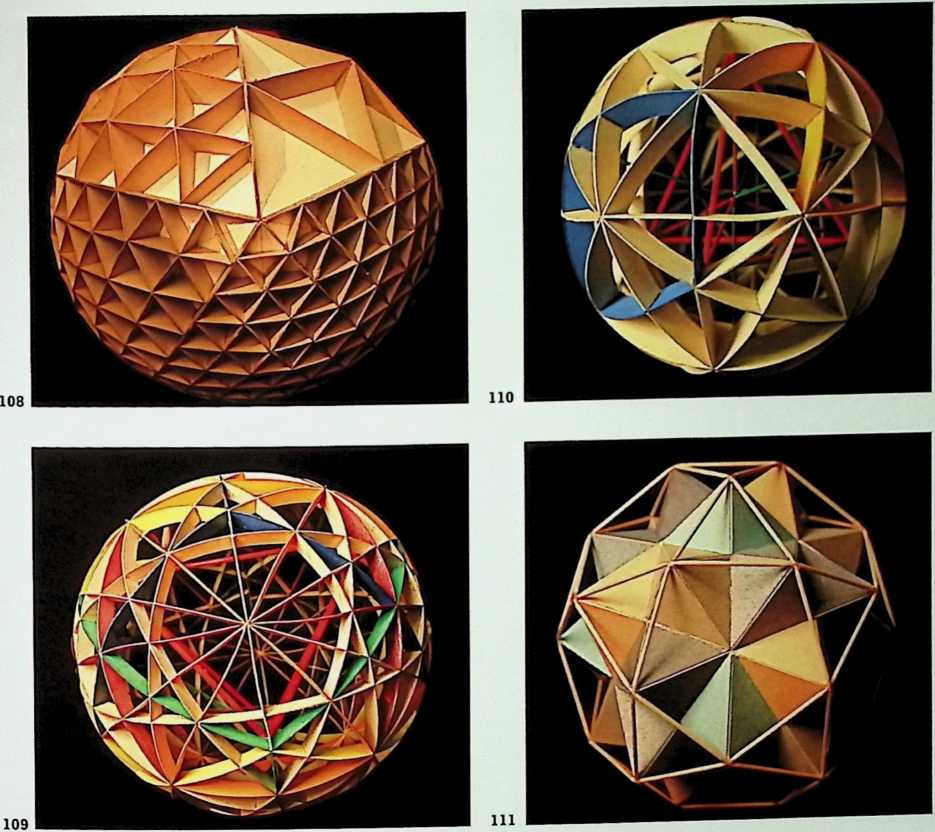
pi.112
Tetrahedron, Axii, Vertex, Face, Midedge, ca.-63 Wood
Diameter 13 in. (33 cm)
pi.113
IVM, Octet truss, ca. 1960-63
Wood
Diameter 14 in. (35.6 cm)
Pi.114
Concentric Arrangement of Multiple
Polyhedra, ca. 1960-63
Wood toothpicks
Diameter 9 in. (22.9 cm)
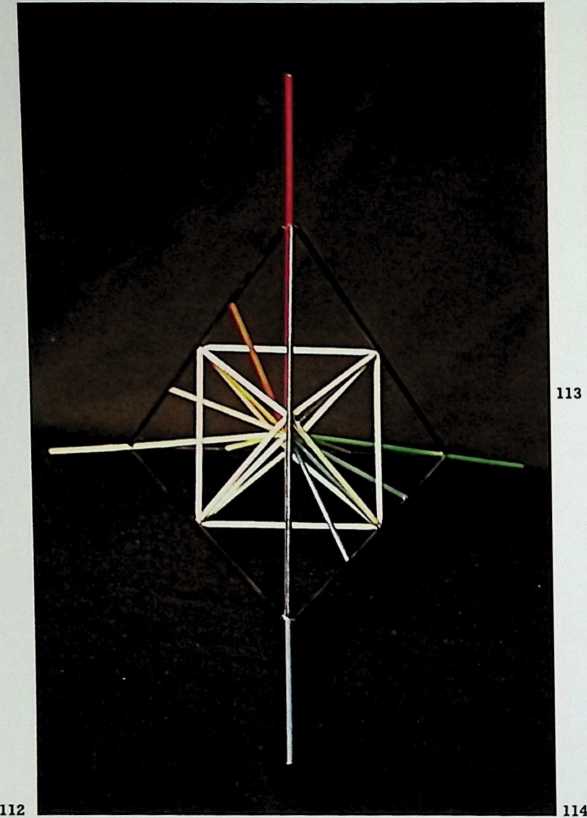
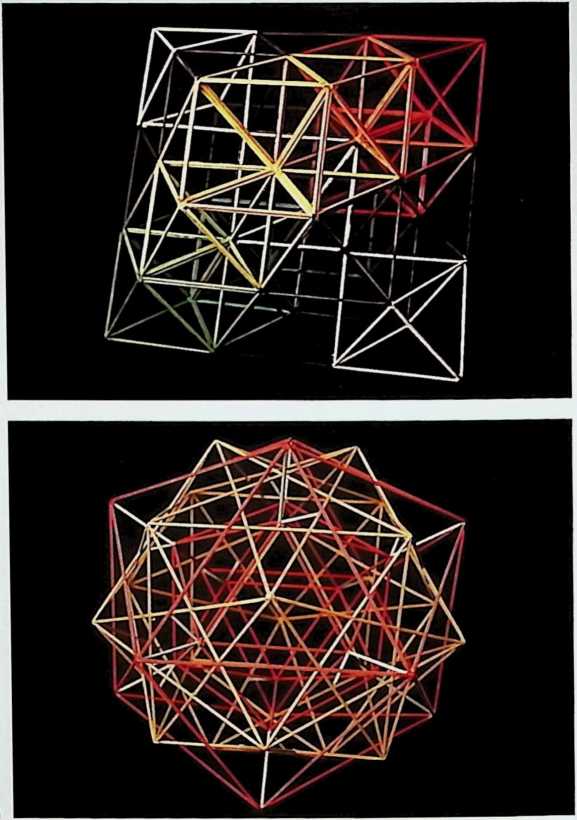
| Pi.ll5 | Compound Curvature, Sphere Packing Voids, ca. 1960-63 Metal Diameter 8 /« in. (21 cm) |
| Pi.116 | Compound Curvature, Sphere Packing Voids, ca. 1960-63 Metal Diameter 10 in. (25.4 cm) |
| P..117 | Compound Curvature, Sphere Packing Voids, ca. 1960-63 Metal Diameter 13 in. (33 cm) |
PLATES
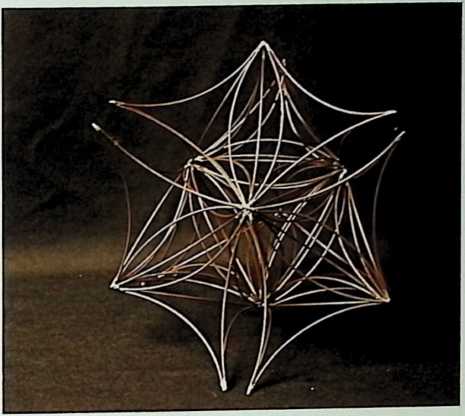
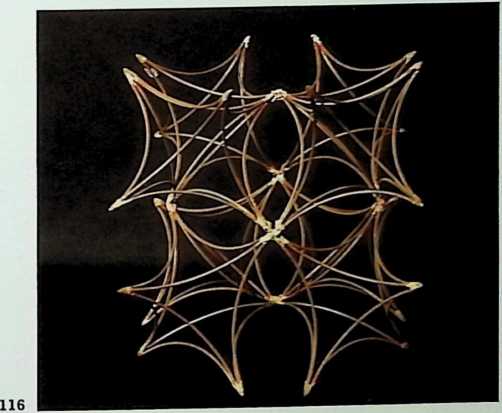
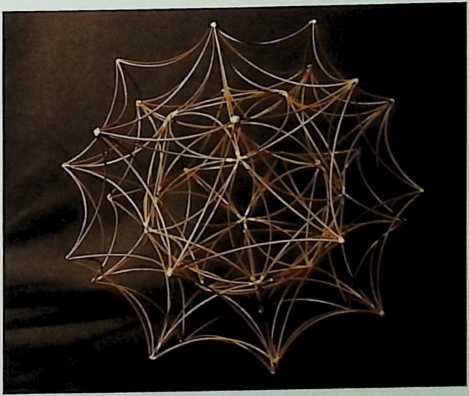
Pi.118
STANDARD
F LIVING
PAG K A G E
Photograph of Standard of Living Package model, packed, ca. 1949
Pi.119
Standard of Living model, unpacked, ca.1949
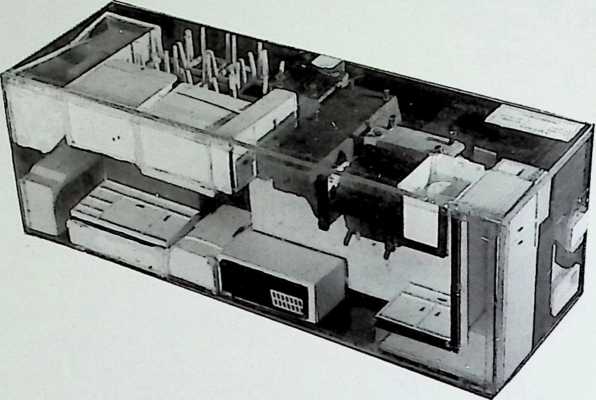
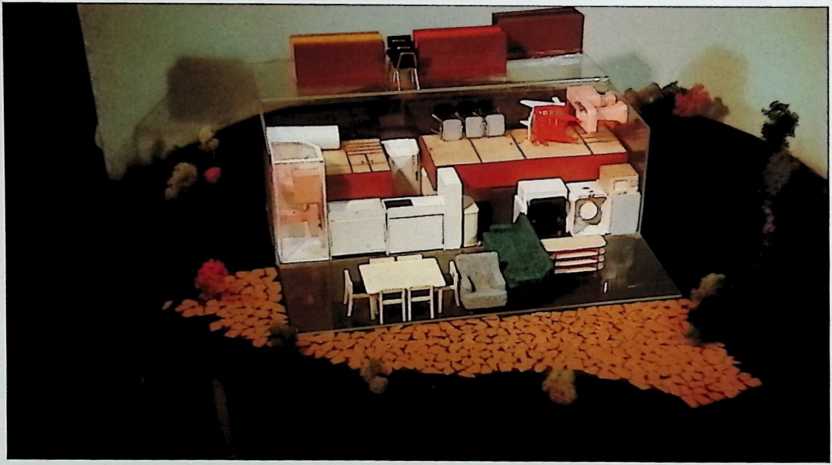
Pi.120
Fuller with models of Standard of Living Package and Skybreak Dome, 1949
PLATES
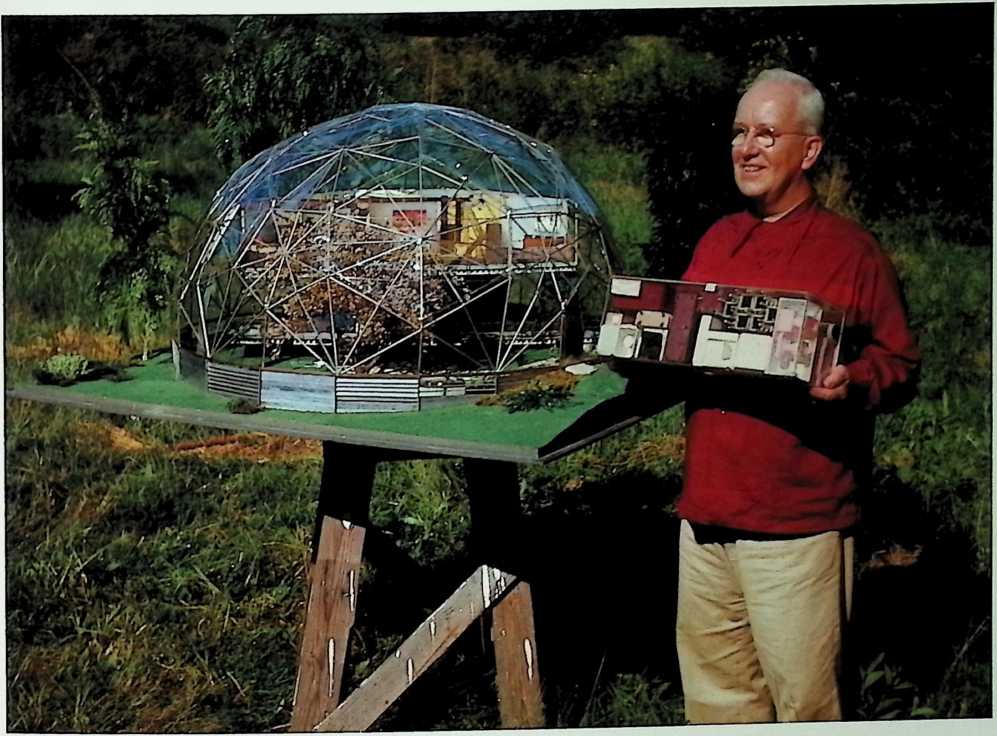
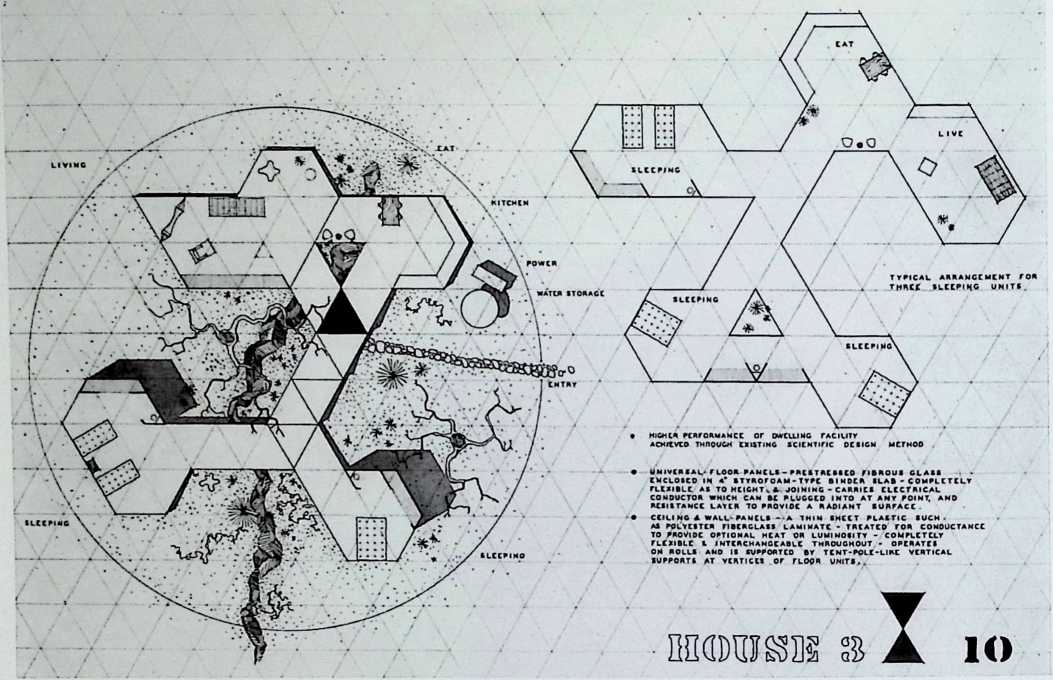
Autonomous dome home plan, designed by Fuller and MIT students, co.1952
Ink and toned overlays on vellum mounted on board
20 x 30’/is in. (50.8 x 76.4 cm)
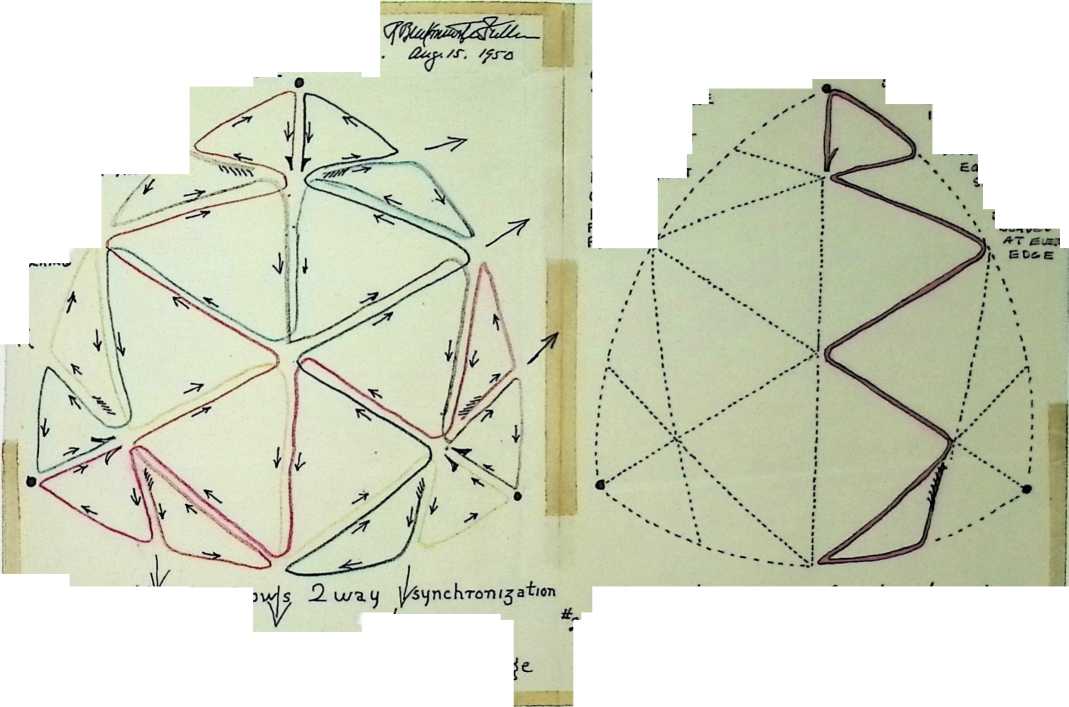

This patrem sho
STict 3 way yield and
basic 6 -function s at i s -fa at i on with sitiTiti out at external ed f°1 Com pl em-eTxta tion by aclj a cen.t
Other pattern use of 15\ sf}0WM
- IN main drawings ano is described GN PAGES 20A-a 21 OF TEXT.
3-Way-Geodesic-Grid-4-Module- Stress-Flow …, 1950
Ink and colored pencil on tracing paper mounted on paper with tape 11 x 17 in. (27.9 x 43.2 cm) overall
pi.123
One of 30 Diamonds on Edge of Icosahedron’s 30 Edges…, 1950 Colored pencil and ink on paper 8/zx 11 in. (21.6 x 27.9 cm)
pi.124
Strip X, n.d.
Graphite and felt-tip pen on tracing paper
11*74X13 in. (28.6 x 33 cm)
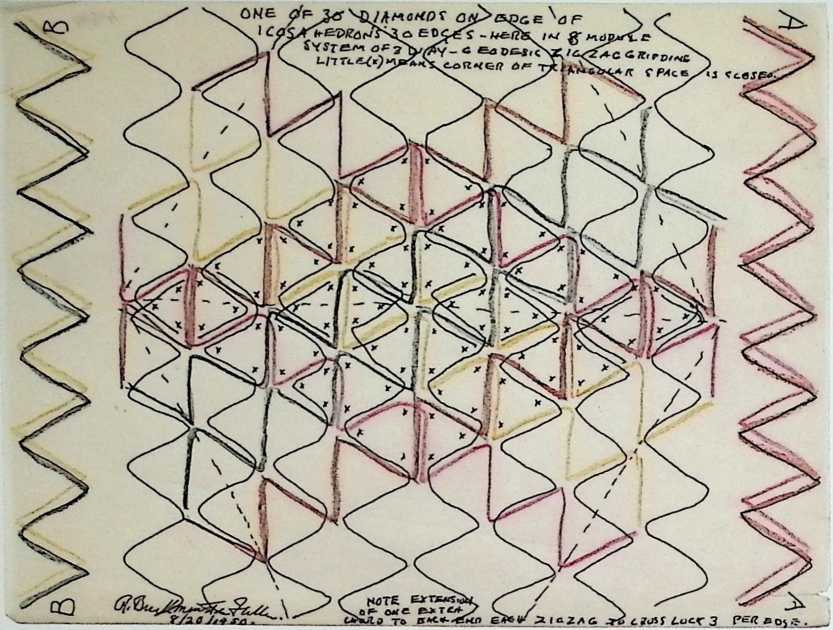
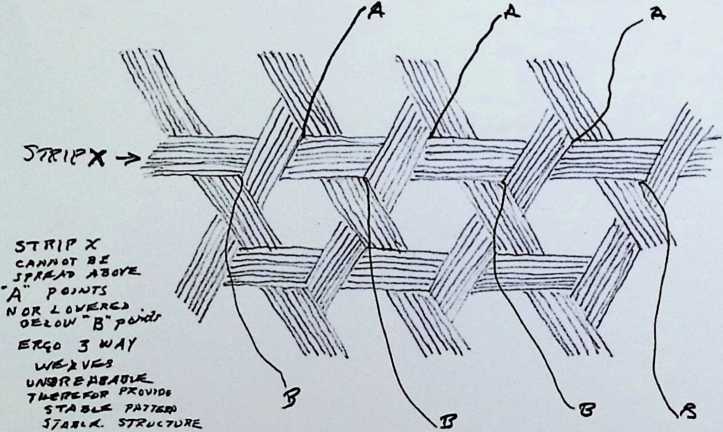
pi.125
Basic Diamond Turbining, 1951 Graphite on tracing paper 20 l/z x 23 5/u in. (52.1 x 59.2 cm)
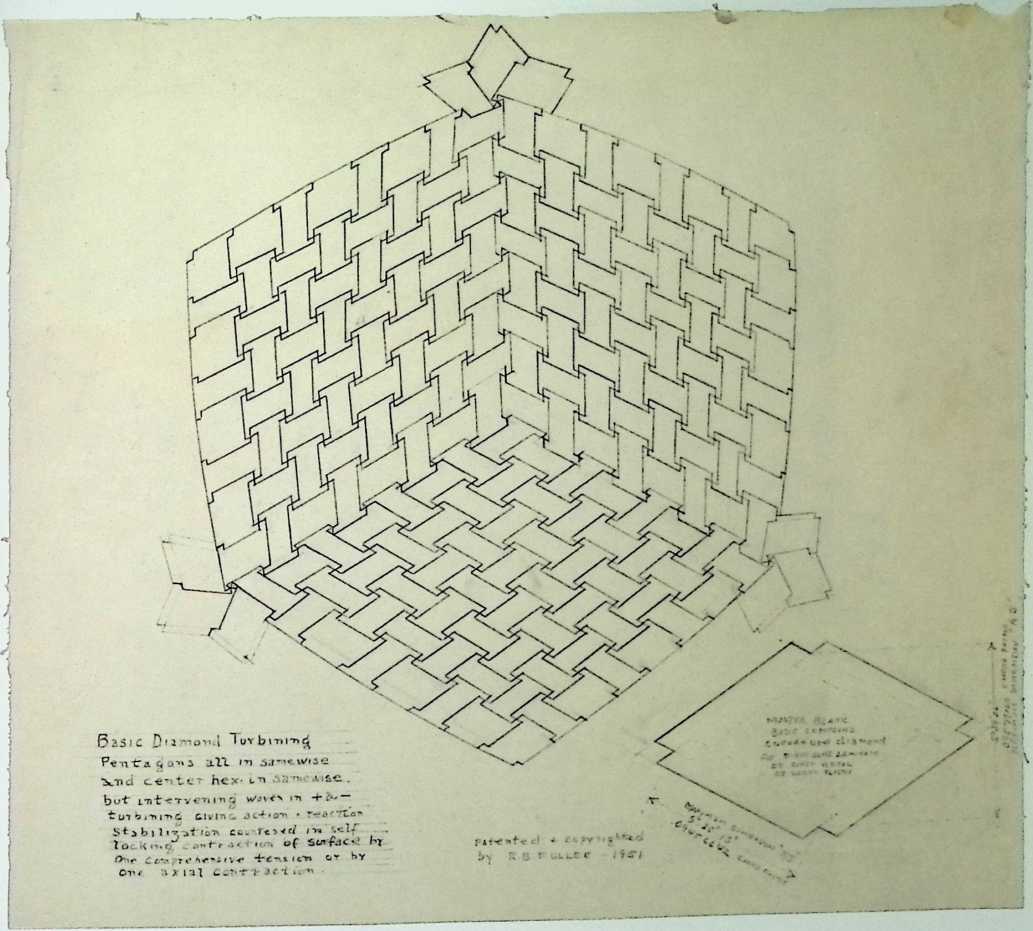
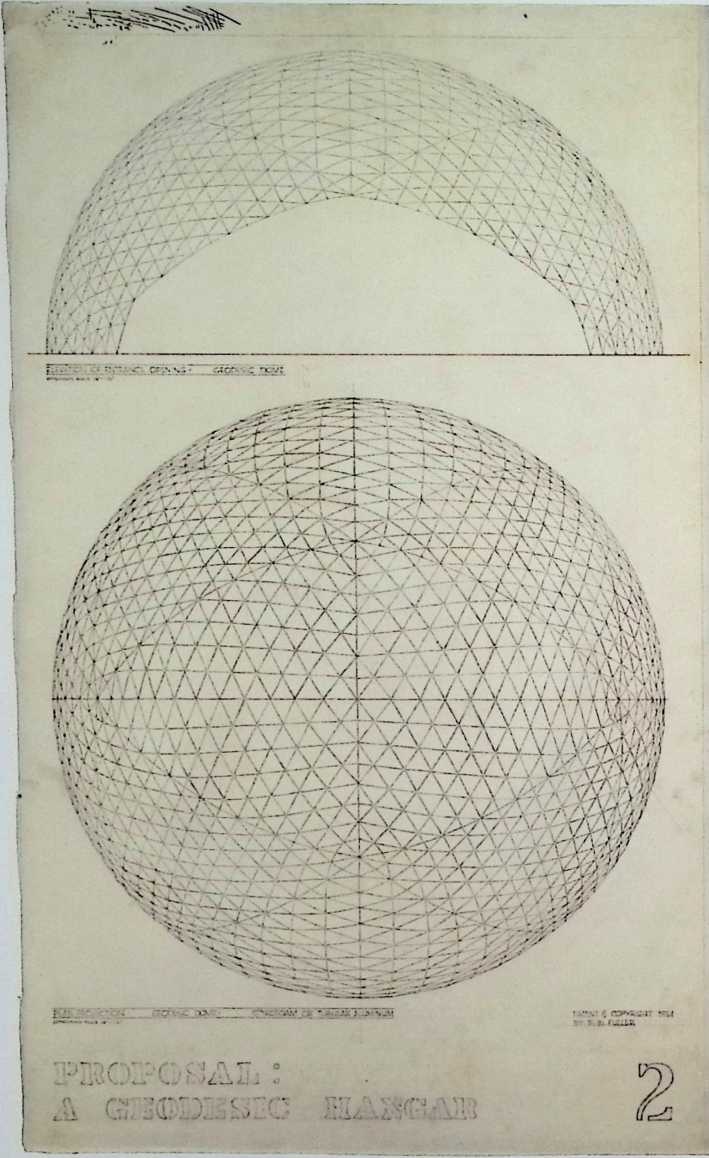
Proposal: A Geodesic Hangar, Plan Projection, Geodesic Dome, Styrofoam or Tubular Aluminum, 1951 Graphite on tracing paper 40 ‘Ax 24 ‘/sin. (102.2x61.3 cm)
pi.127
Proposal: A Geodesic Hangar, Plan Projection, Geodesic Dome, Diamonds of Fiberglass Laminate, 1951 Graphite on tracing paper 39Vix 237/s in. (100 x 60.6 cm) (irregular)
PLATES
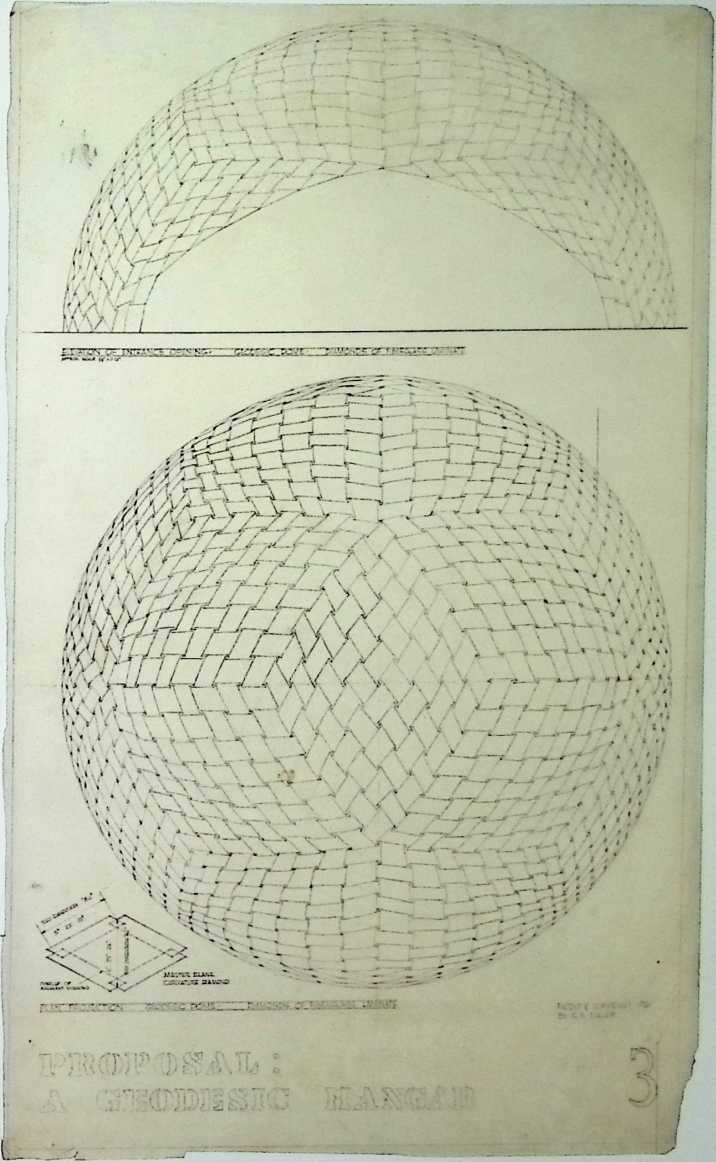
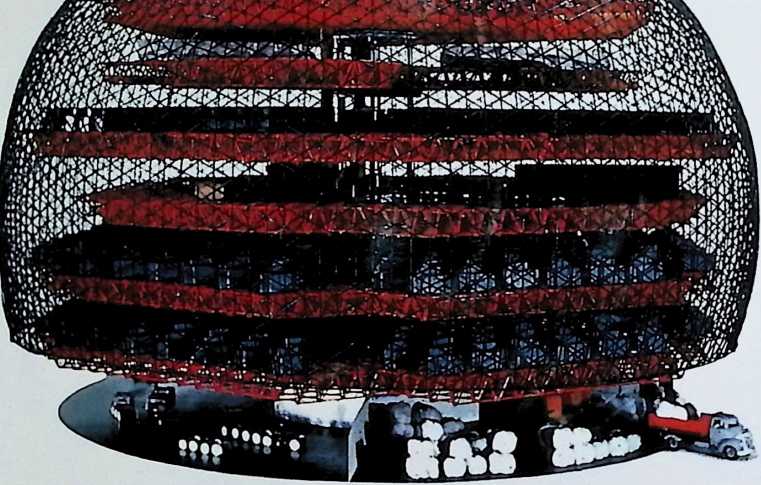
Model for 90% Automatic Cotton Mill, designed with students at North Carolina State College, 1951
pi.129
Geodesic Dome for the Ford Motor Company, Dearborn, Michigan, 1952-53
India ink, graphite, and felt-tip pen
on tracing paper
30‘/jx 30 in. (77.1 x 76.2 cm)
PLATES
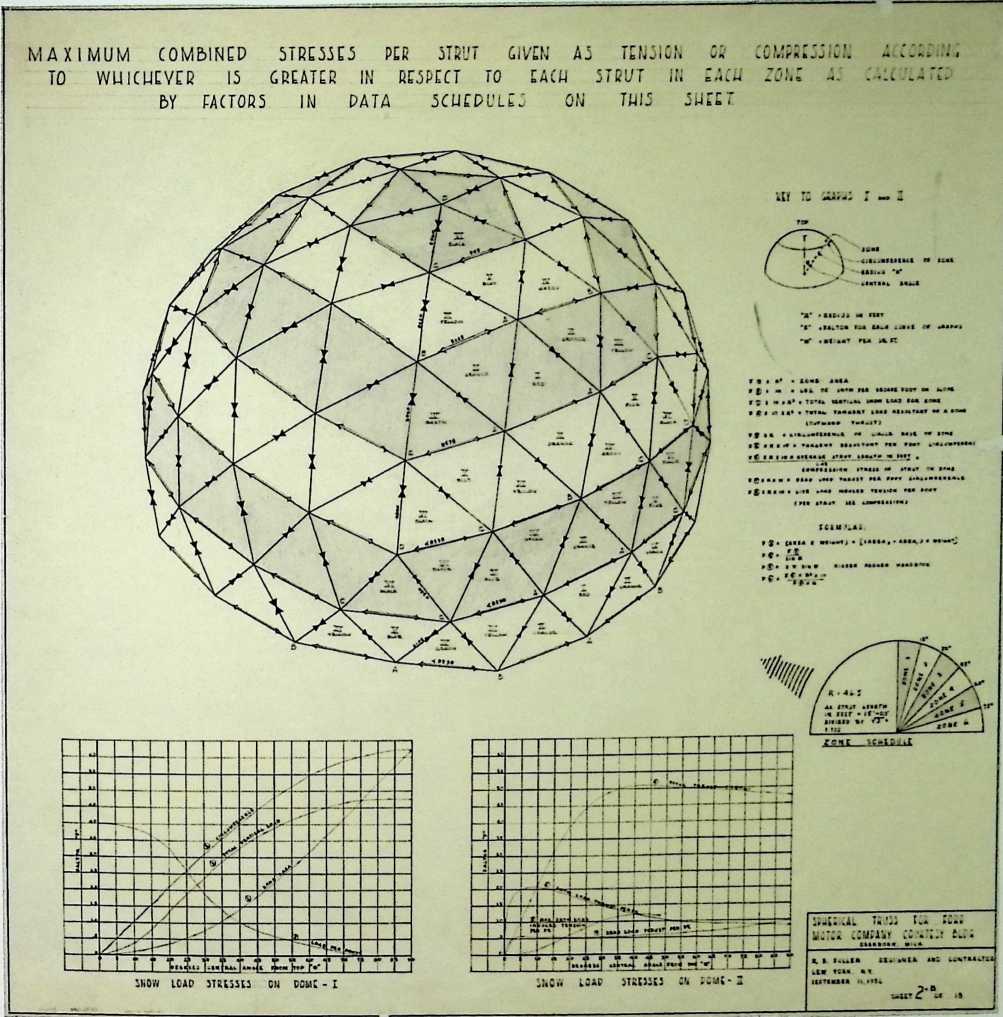
pi.130
SPUERICAL. TRUSS FDD, FORD MOTOR COMPANY COLTATE KlDCi
1…
Geodesic Dome for the Ford Motor Company, Dearborn, Michigan, 1952-53
Ink on paper
29 /i x 29 ’/tin. (75x75 cm)
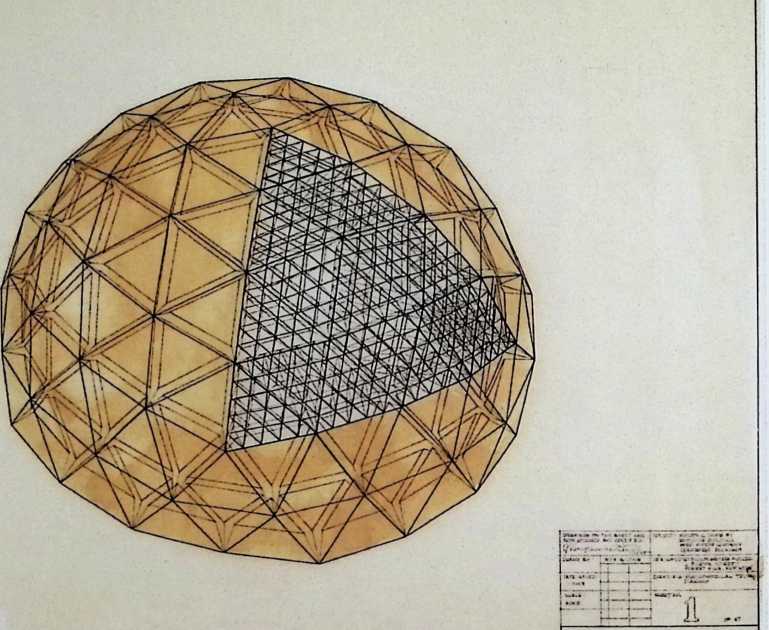


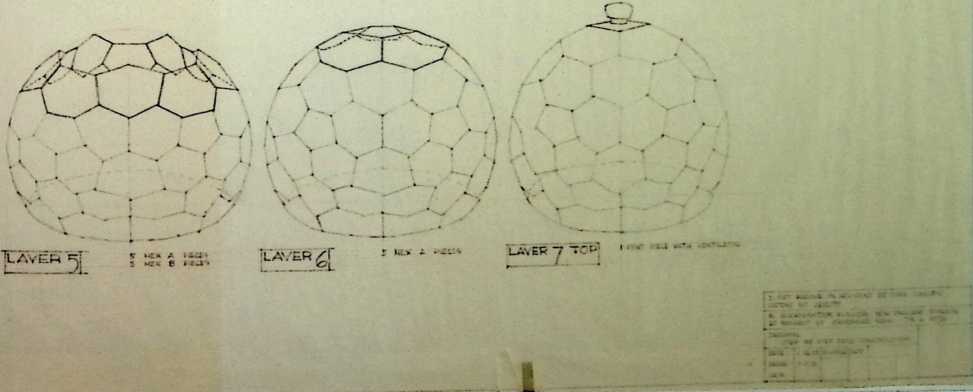
Radomes (31 Foot Diameter and 50 Foot Diameter), 1954 Graphite on tracing paper 27 Vz x 36 in. (70x91.5 cm)
pi.132
: Geoscope built with students at
: Cornell University, 1952
: Diameter 21 ft. (6.4 m)
Land masses are represented by pieces of mesh wire-netting
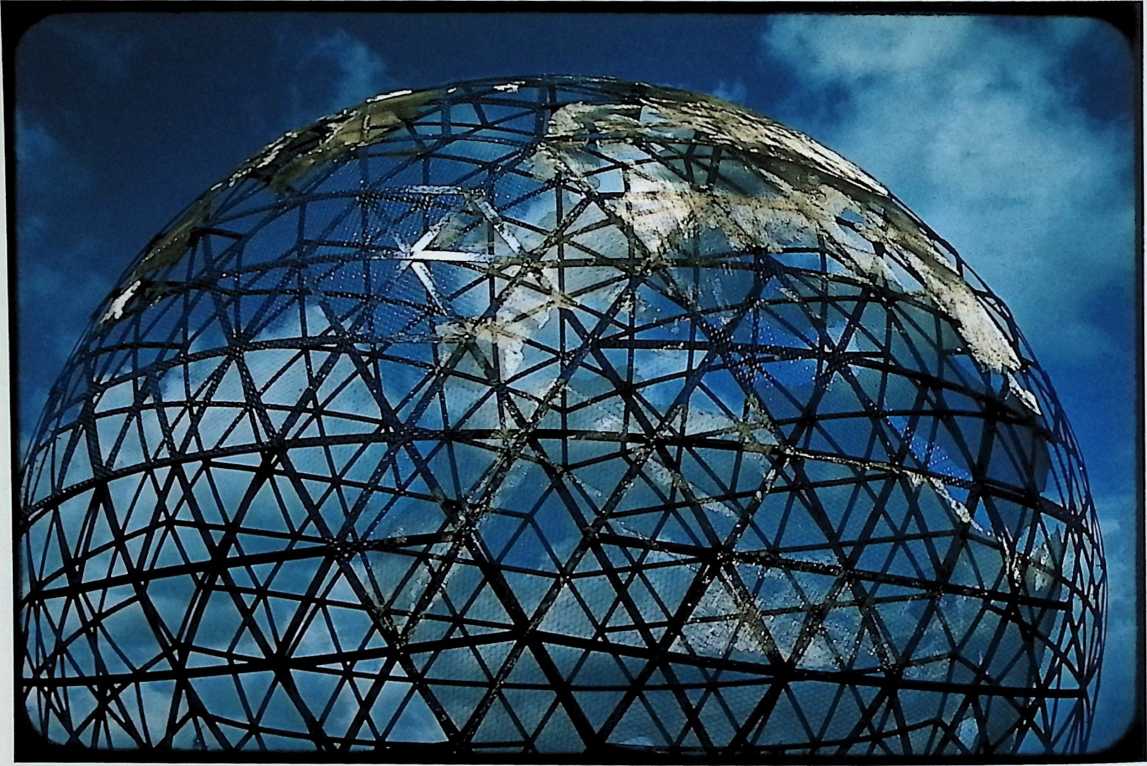
pi-
133
Minni Earth Location at U.N. Building, New York, 1956 (drawing by Elston Nelson)
Ink and graphite with plastic overlay on paper mounted on board 15x20 in. (38.1 x 50.8 cm)
pi.134
Minni Earth Location at U.N. Building, New York, 1956 (drawing by Winslow Wedin) Ink and graphite on tracing paper mounted on board 15x20 in. (38.1 x50.8 cm)
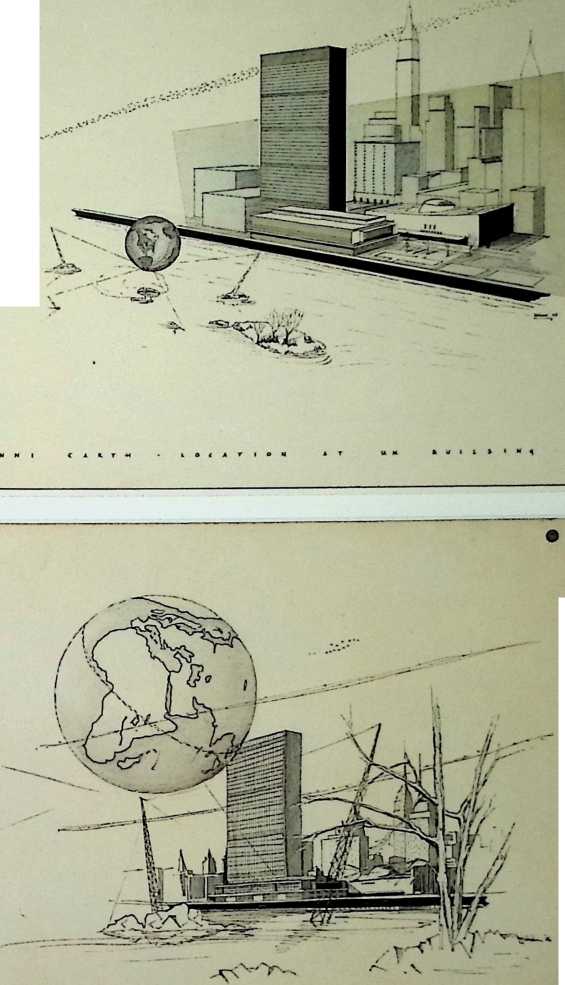
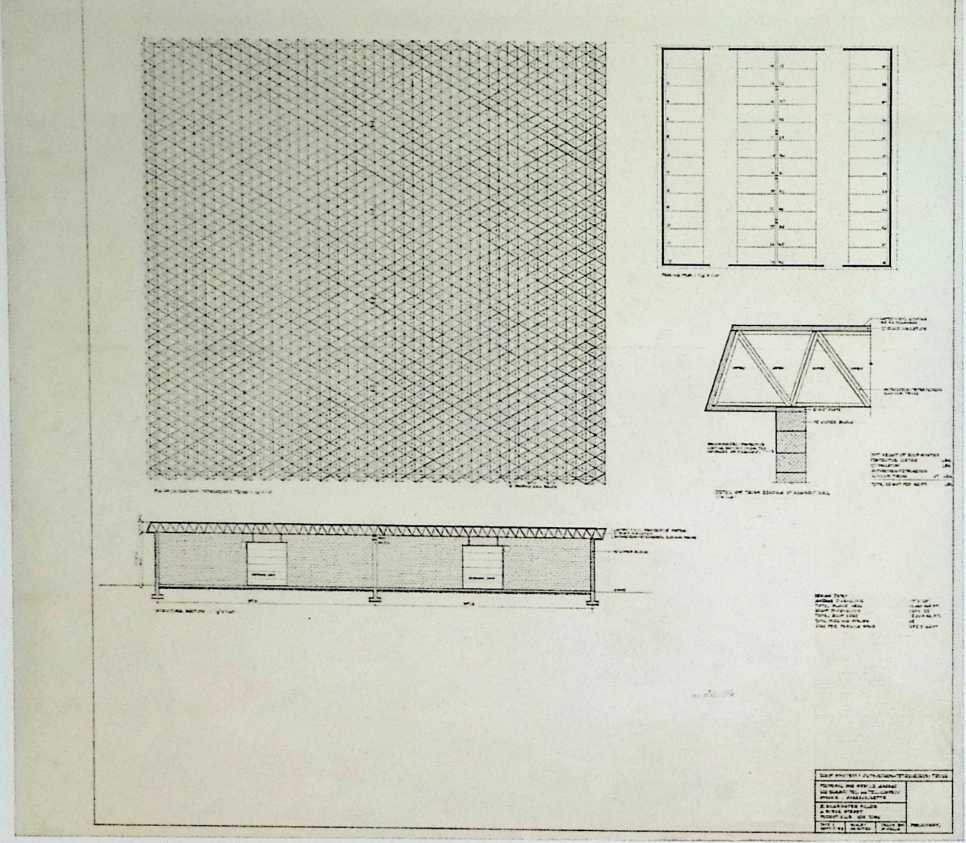
Roof System: Octahedron-Tetrahedron Truss, Proposal for Service Garage for New England Tel. & Tel. Company, Hyannis, Massachusetts, 1953 (drawing by G. Welsh) Graphite on vellum
30/ux 32/tin. (76.4 x 82.6 cm)
Pi.l36
Octahedron-Tetrahedron Truss, 1953 (drawing by G. Welsh)
Graphite on vellum
30 x 32 */: in. (76.2 x 82.6 cm)
PLATE S
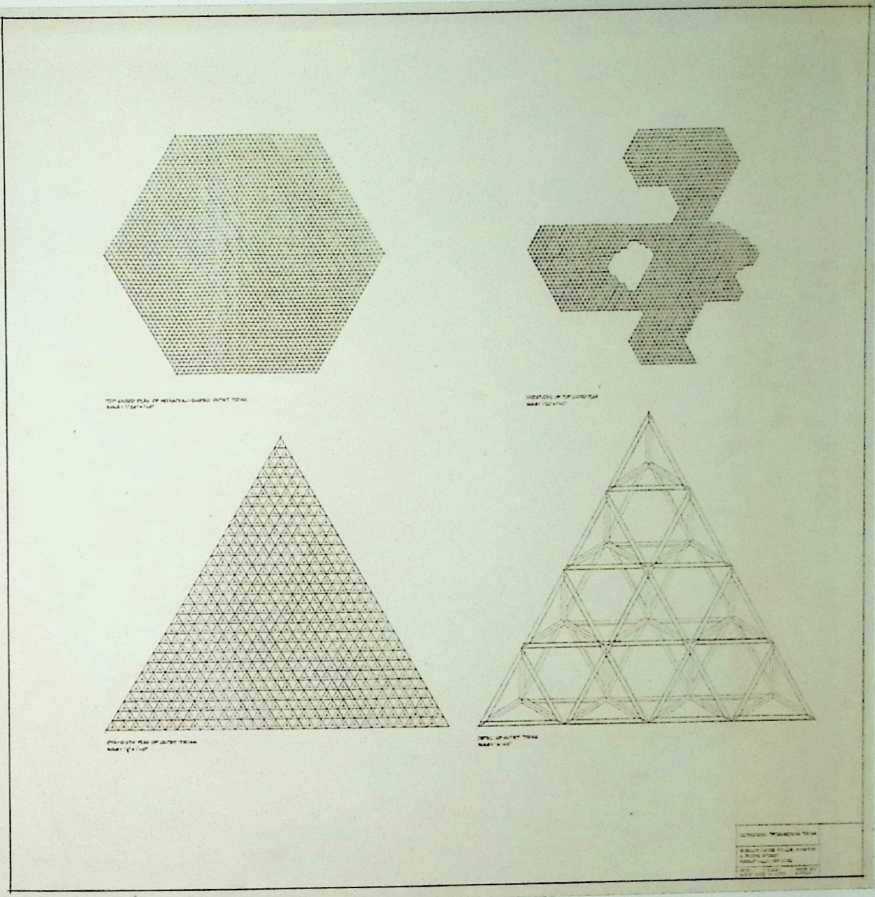
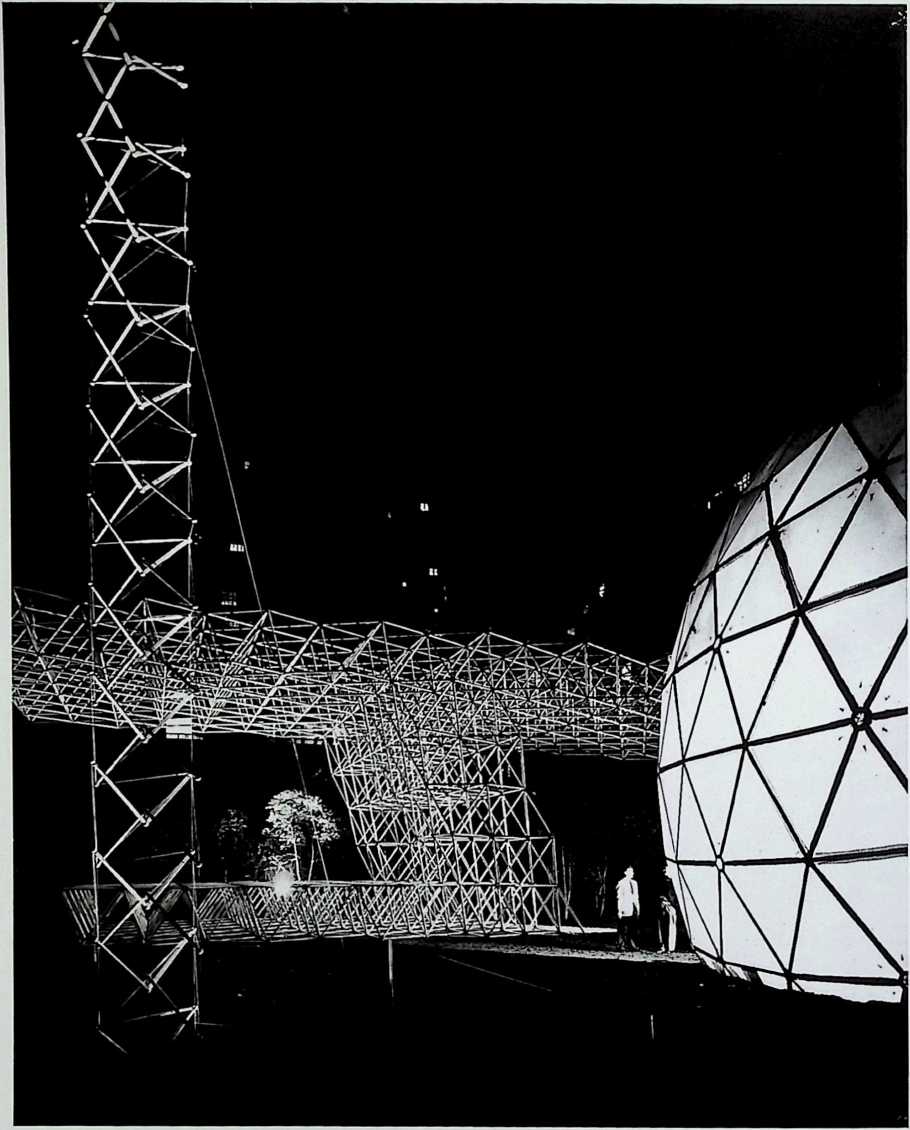
Installation view of Three Structures by Buckminster Fuller (September 22, 1959 winter 1960) in the sculpture garden of the Museum of Modern Art, New York Tensegrity Mast (left), Geodesic Radome (right), Octet Truss (center)
pi.138
Synergetic Building ConstructionOctetruss, United States Patent Office no. 2,986,241, filed February 7, 1956, serial no. 563,931, granted May 30, 1961, inventor: Buckminster Fuller
From the portfolio Inventions: Twelve Around One, 1981 Screenprint in white ink on clear polyester film overlaid on a Curtis plain blue backing sheet 30 x 40 in. (76.2 x 101.6 cm)
Pi.139
Synergetic Building ConstructionOctetruss, United States Patent Office no. 2,986,241, filed February 7,1956, serial no. 563,931, granted May 30,1961, inventor: Buckminster Fuller
From the portfolio Inventions: Twelve Around One, 1981 Screenprint in white ink on clear polyester film overlaid on screenprint on Lenox paper 30 x40 in. (76.2 x 101.6 cm)
PLATES
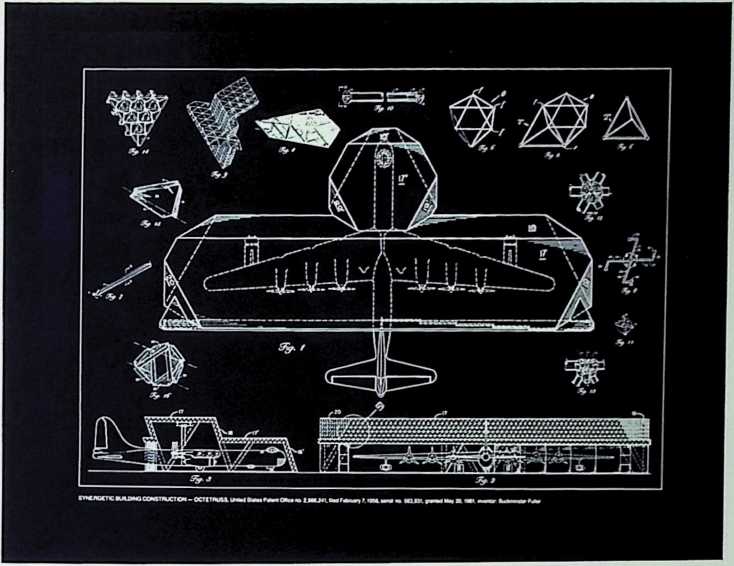
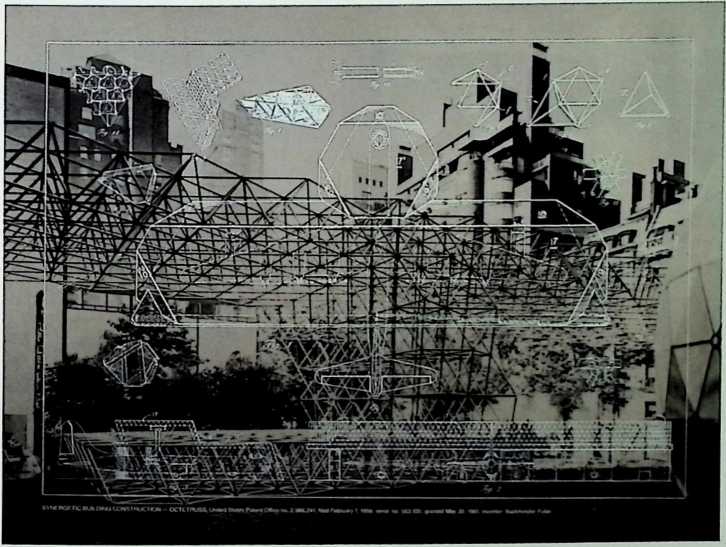
Pi. 140
Octet Truss, project, co. 1959
Wood struts
12,/2x49,/2xl71/2in.
(31.8 x 125.7 x 44.5 cm)
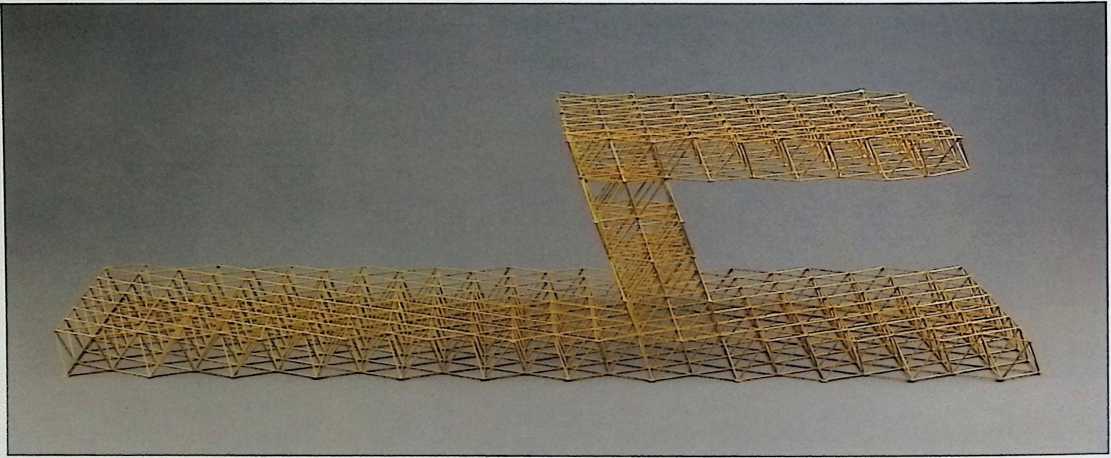
pi.141
Tensile-Integrity StructuresTensegrity, United States Patent Office no. 3,063,521, filed August 31, 1959, serial no. 837,073, granted November 13, 1962, inventor: Buckminster Fuller
From the portfolio Inventions: Twelve Around One, 1981 Screenprint in white ink on clear polyester film overlaid on a Curtis plain blue backing sheet 30x40 in. (76.2 x 101.6 cm)
pi.142
Tensile-Integrity StructuresTensegrity, United States Patent Office no. 3,063,521, filed August 31, 1959, serial no. 837,073, granted November 13, 1962, inventor: Buckminster Fuller From the portfolio Inventions: Twelve Around One, 1981 Screenprint on Lenox paper 30 x 40 in. (76.2 x 101.6 cm)
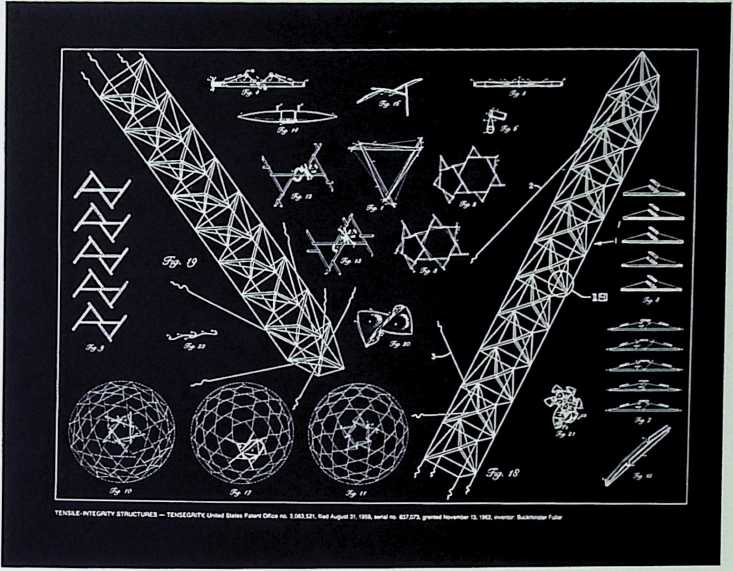
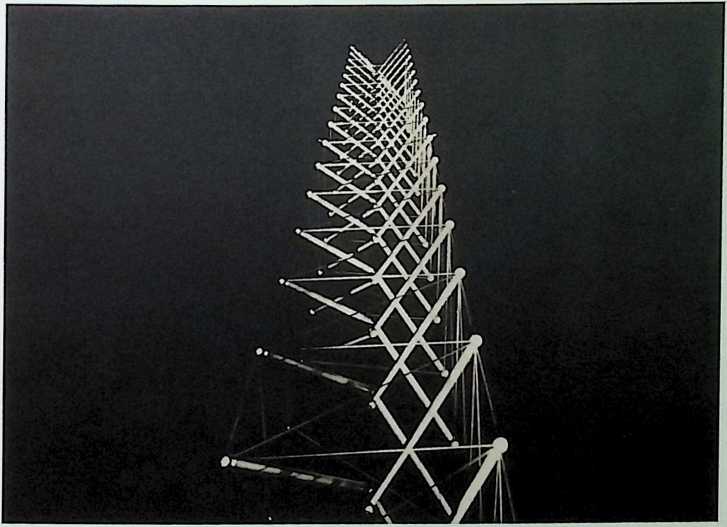
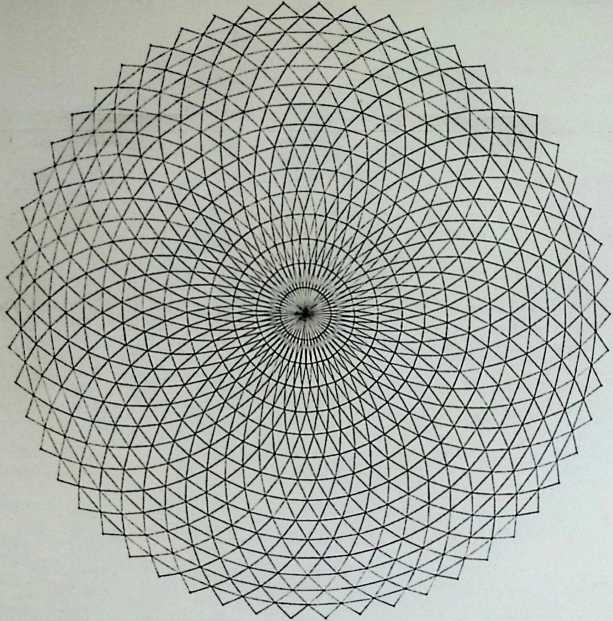

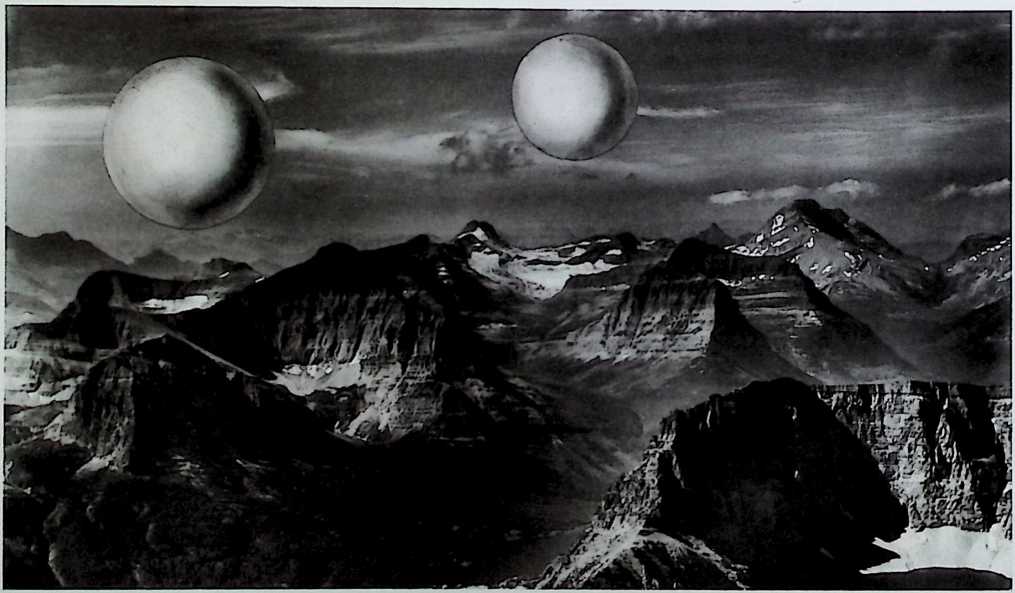
pi.143
Opposite:
Geodesic Dome for the yumiuri Golf Club, Tokyo, Japan, 1961-63 Graphite on tracing paper 28 x 41 3/s in. (71.2 x 105 cm)
pi.144
BUCKMINSTER FULLER andSHOJI SADAO (b. 1927) Project for Floating Cloud Structures (Cloud Nine), ca. 1960 Black-and-white photograph mounted on board
157/8 x 19 3/« in. (40.3 x 50.2 cm)
pi.145
BUCKMINSTER FULLER andSHOJI SADAO
Dome Over Manhattan, ca. 1960 Black-and-white photograph mounted on board
133/<x 183/i in. (34.9 x 46.7 cm)
PLATES
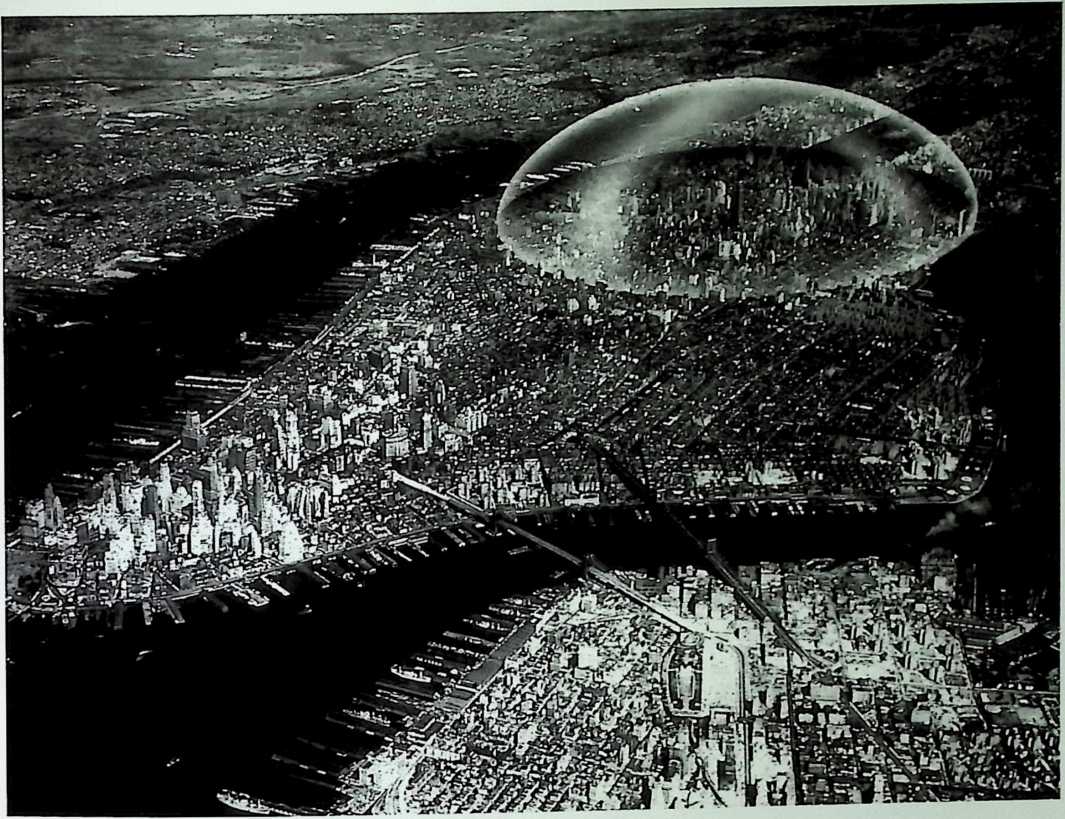
Ci *YKvr
HfiS HSS
Pi.146
PLAYBOY
KX1DW STAT ON I/O
nsnwc posnkx
PLAYBOY Jaw. C.g com
O. K.
BUCKMINSTER FULLER □ndSHOJI SADAO
Tetrahedron City, project, Yomiuriland, Japan, Aerial perspective, ca. 1968 Cut-and-pasted gelatin silver photograph on gelatin silver photograph with airbrush 11x14 in. (27.9x35.6 cm)

BUCKMINSTER FULLER andSHOJI SADAO
Floating Tetrahedral City planned for San Francisco Bay, 1965 Black-and-white photograph mounted on board
15S/16 X 19 in. (38.9 x 48.3 cm)
PLATES
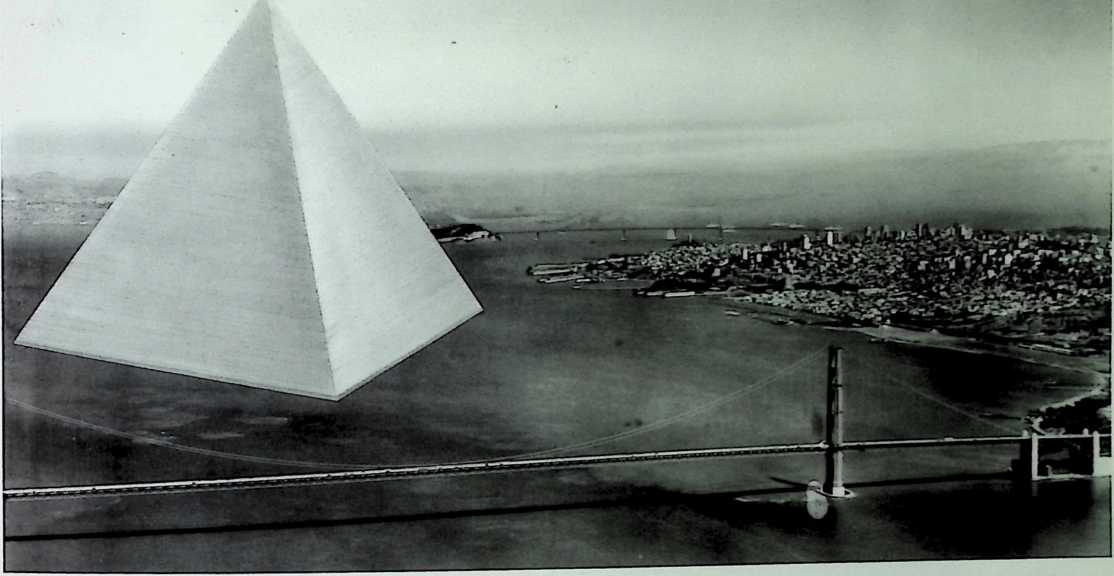

Opposite:
Model of Triton City, 1967 Mixed media 20 */2 x 49 ‘/z x 44 5/« in. |
|||
| pi.149 | (52.1 x 125.7 x 113.3 cm) | ||
| andSHOJI SADAO | |||
| pi.148 | Harlem Redesign, 1965 Graphite on tracing paper 24 x 20 in. (61 x 50.8 cm) | Mixed media 53/4 x49‘/z x 37 */2 in. (14.6 x 125.7 x 95.6 cm) |
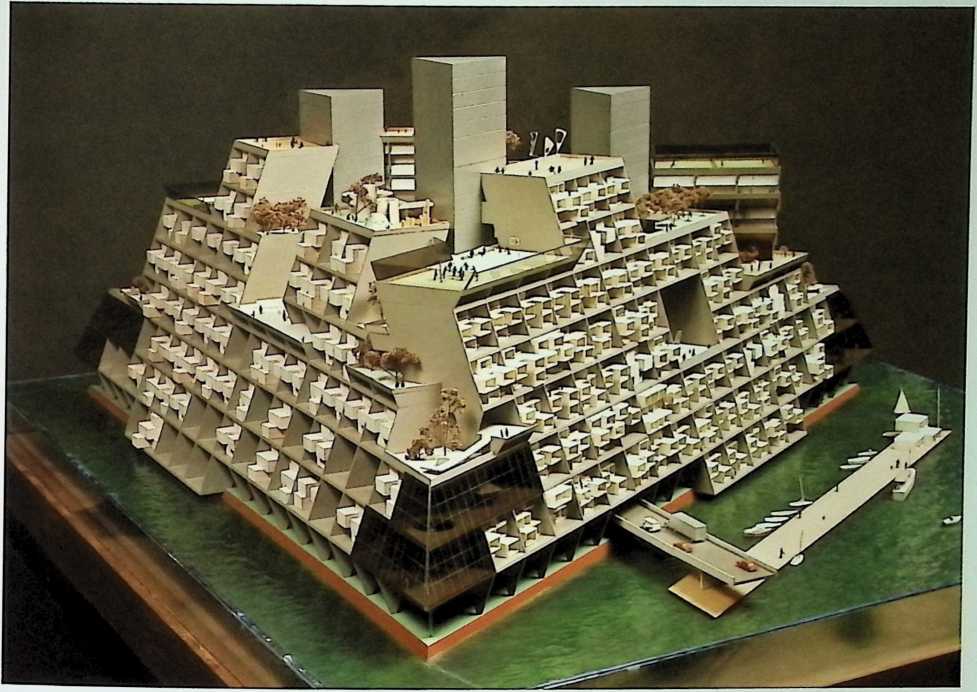
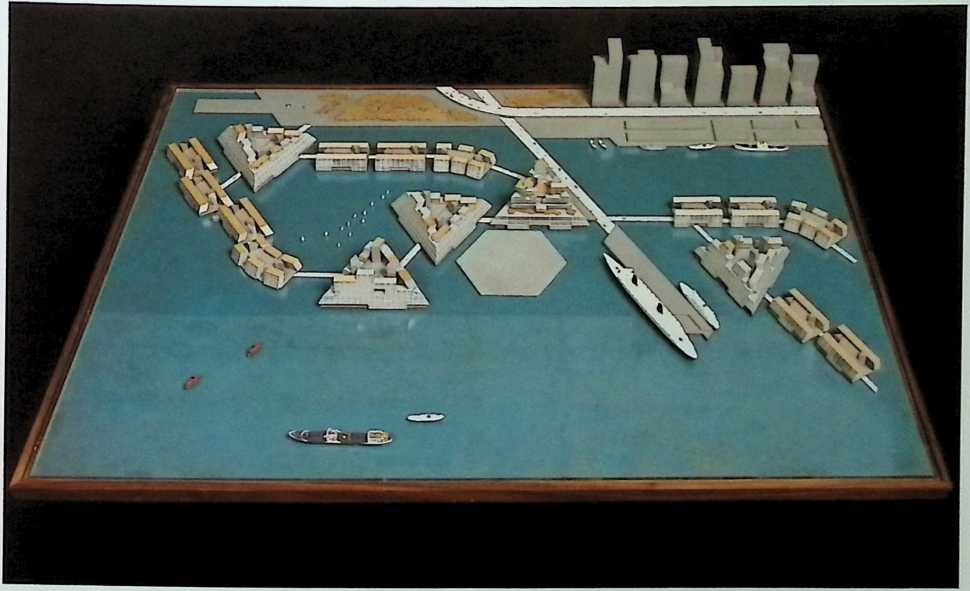
pi.151
Undersea IslandSubmarisle, United States Patent Office no. 3,080,583, filedjune 8, 1959, serial no. 818,935, granted March 12, 1963, inventor: Buckminster Fuller
From the portfolio Inventions:
Twelve Around One, 1981
Screenprint in white ink on clear polyester film overlaid on a screenprint on Lenox paper 30 x 40 in. (76.2 x 101.6 cm)
Pi.152
Undersea IslandSubmarisle, United States Patent Office no. 3,080,583, filed June 8, 1959, serial no. 818,935, granted March 12, 1963, inventor: Buckminster Fuller From the portfolio Inventions:
Twelve Around One, 1981
Screenprint in white ink on clear polyester film overlaid on Curtis plain blue backing sheet 30 x 40 in. (76.2 x 101.6 cm)
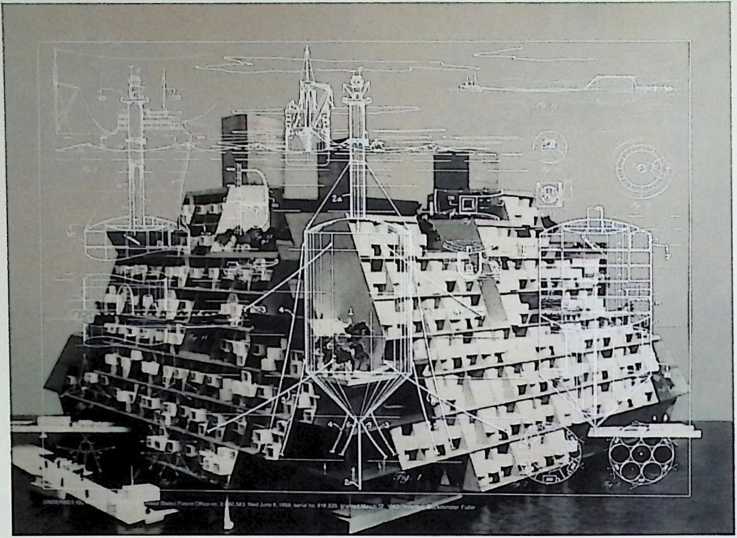
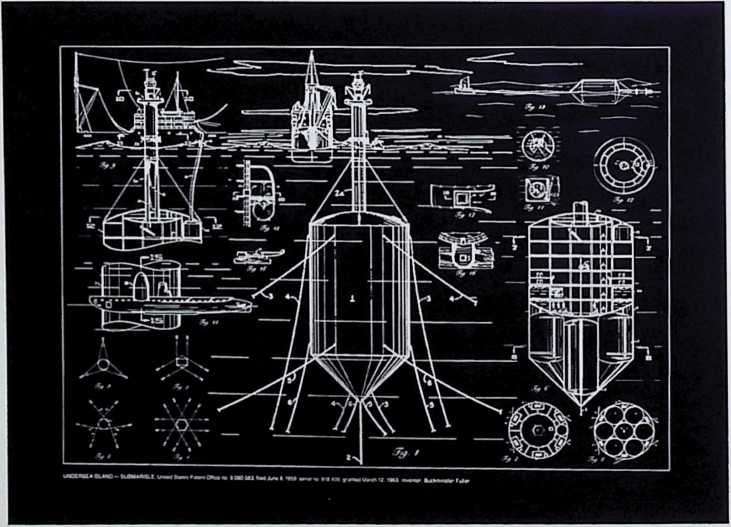
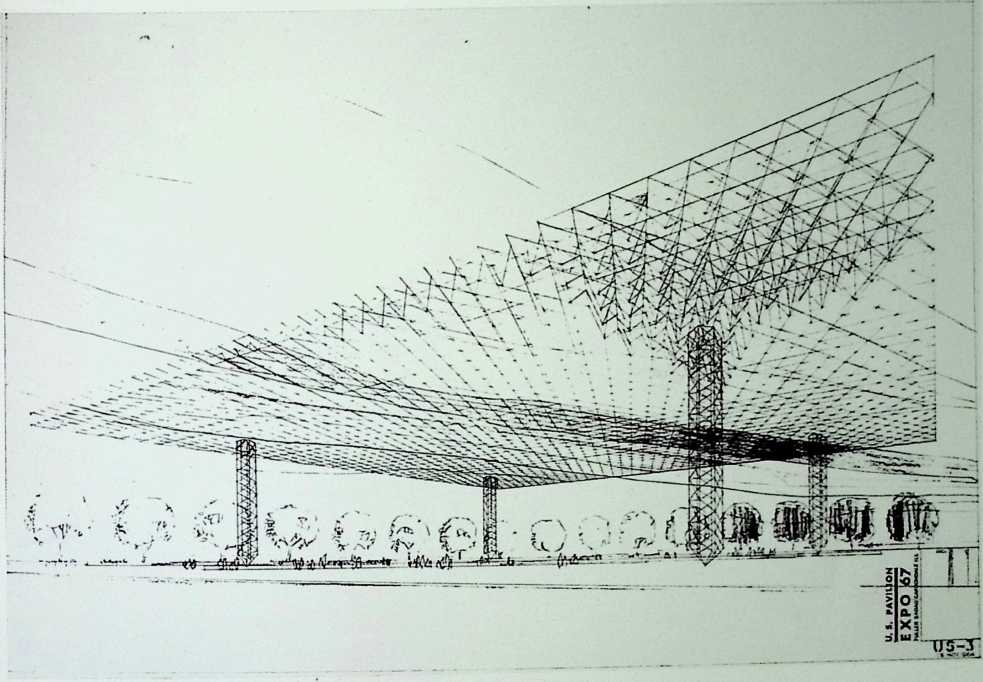
BUCKMINSTER FULLER and SHOJI SADAO
United States Pavilion Design for Montreal Expo 67 (Trabeated Truss), 1964 Photostat
12x18 in. (30.5 x45.7 cm)
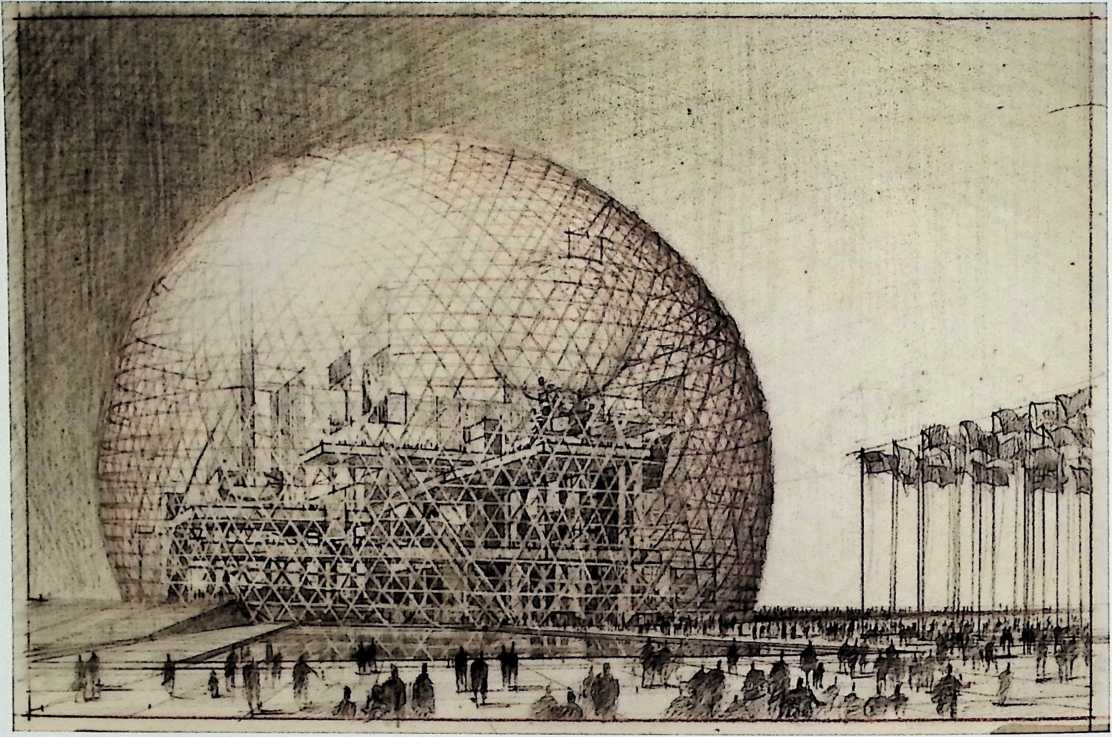
BUCKMINSTER FULLER/FULLER AND
SADAO, INC./GEOMETRICS, INC., ASSOCIATED ARCHITECTS
Rendering of U.S. Pavilion for
Montreal Expo 67, ca. 1966
Graphite on tracing paper
8 x 10 in. (20.3 x 25.4 cm)
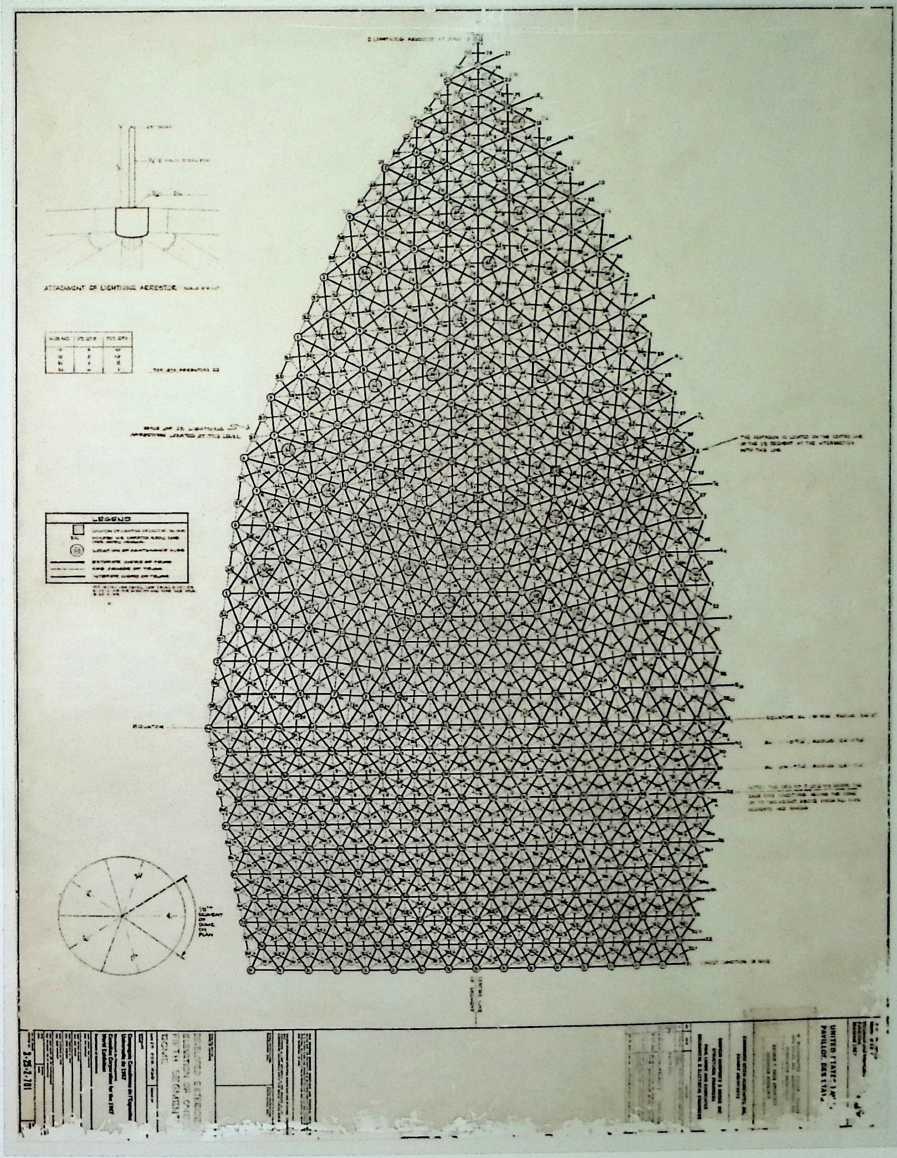
BUCKMINSTER FULLER/FULLER AND SADAO, INC./GEOMETRICS, INC., ASSOCIATED ARCHITECTS
Developed Exterior Elevation of One-fifth Segment of Dome for Montreal Expo 67, 1966 Ink on Mylar
44 x 34 in. (111.8x86.4 cm)
pi.156
U.S. Pavilion for Montreal Expo 67,1967

pi.157
Building Construction/Geodesic Dome, United States Patent Office no. 2,682,235, filed December 12, 1951, serial no. 261,168, granted June 29, 1954, inventor: Buckminster Fuller From the portfolio Inventions: Twelve Around One, 1981
Screenprint in white ink on clear polyester film overlaid on a Curtis plain blue backing sheet 30 x40 in. (76.2x101.6 cm)
Building Construction/Geodesic Dome, United States Patent Office no. 2,682,235, filed December 12,1951, serial no. 261,168, granted June 29, 1954, inventor: Buckminster Fuller From the portfolio Inventions: Twelve Around One, 1981
pi.158
Screenprint on Lenox paper
30 x 40 in. (76.2 x 101.6 cm)
PLATE
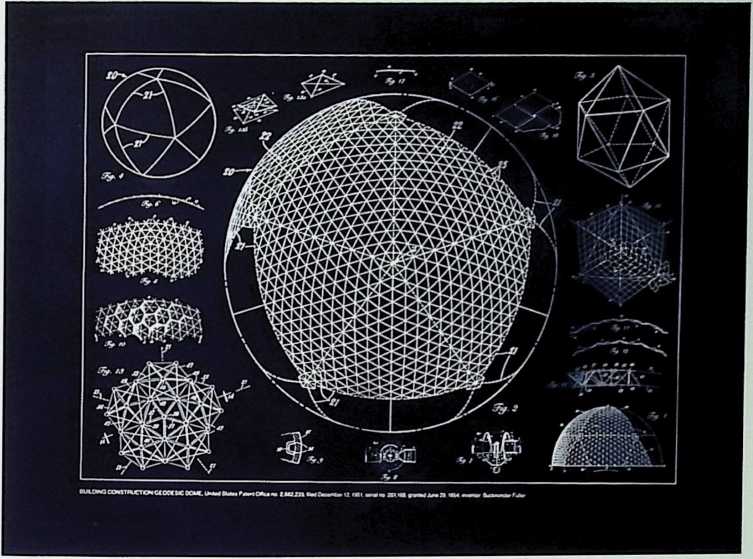
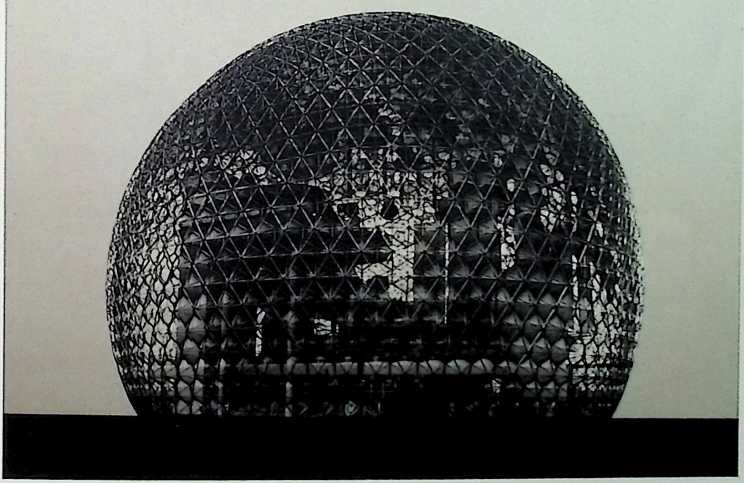
pi.159
Pi.160
Geodesic StructuresMonohex, United States Potent Office no. 3,197,927, filed December 19, 1961, serial no. 160,450, granted August 3, 1965, inventor: Buckminster Fuller From the portfolio Inventions: Twelve Around One, 1981 Screenprint in white ink on clear polyester film overlaid on a Curtis plain blue backing sheet 30 x 40 in. (76.2x101.6 cm)
Geodesic StructuresMonohex, United States Patent Office no. 3,197,927, filed December 19, 1961, serial no. 160,450, granted August 3, 1965, inventor: Buckminster Fuller From the portfolio Inventions: Twelve Around One, 1981 Screenprint on Lenox paper 30x40 in. (76.2x 101.6cm)
pi.161
Geodesic StructuresMonohex, United States Patent Office no. 3,197,927, filed December 19,1961, serial no. 160,450, granted August 3, 1965, inventor: Buckminster Fuller From the portfolio Inventions: Twelve Around One, 1981 Screenprint in white ink on clear polyester film overlaid on a screenprint on Lenox paper 30 x40 in. (76.2 x 101.6 cm)
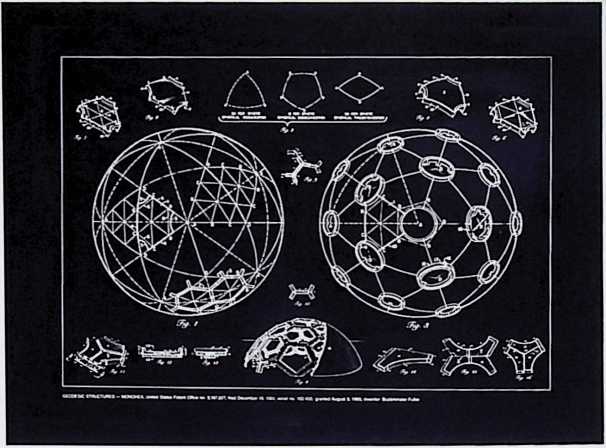
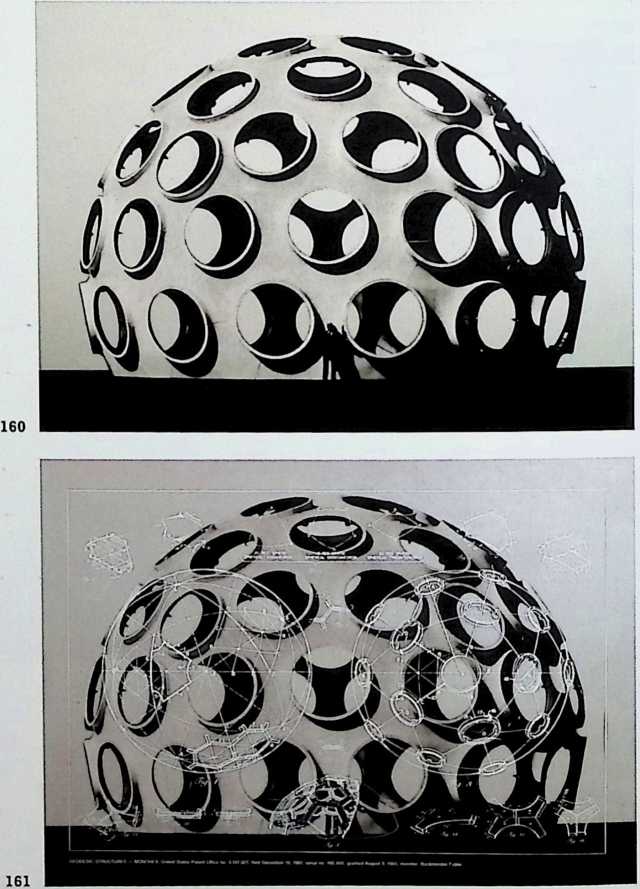

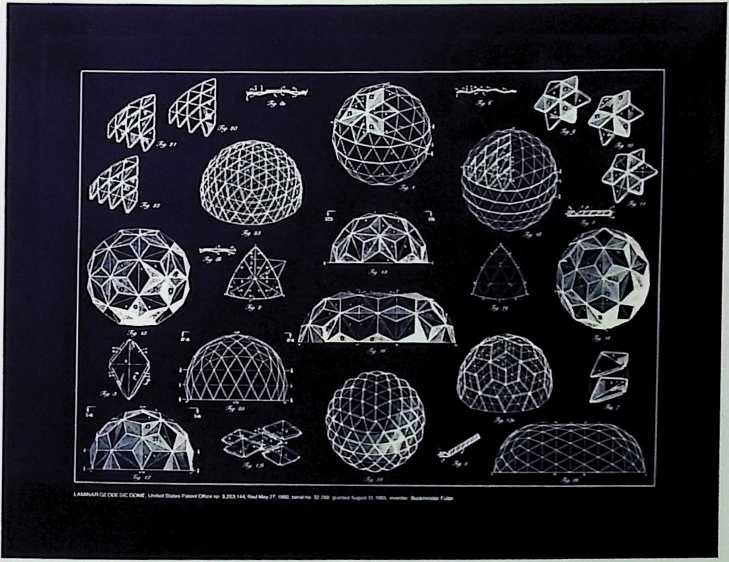
Laminar Geodesic Dome, United States Patent Office no. 3,203,144, filed May 27, 1960, serial no. 32,268, granted August 31, 1965, inventor: Buckminster Fuller
From the portfolio Inventions: Twelve Around One, 1981
Screenprint in white ink on clear polyester film overlaid on a screenprint on Lenox paper 30 x 40 in. (76.2x101.6 cm)
Laminar Geodesic Dome, United States Patent Office no. 3,203,144, filed May 27, 1960, serial no. 32,268, granted August 31, 1965, inventor Buckminster Fuller
From the portfolio Inventions: Twelve Around One, mi
Screenprint in white ink on clear polyester film overlaid on a Curtis plain blue backing sheet 30 x40 in. (76.2x101.6cm)
166
Pi.164
Detail of Tetrascroll, 1976. Stone 1 21 lithographs printed in black, and photographic reproductions of Allegro and Alexandra Fuller
Each page equilateral triangle with 36 in. (91.4 cm) sides, overall dimensions variable Printed by Universal limited Art
Editions, edition of 34
pl. 166 i Detail of Tetrascroll, 1976, Stone 4
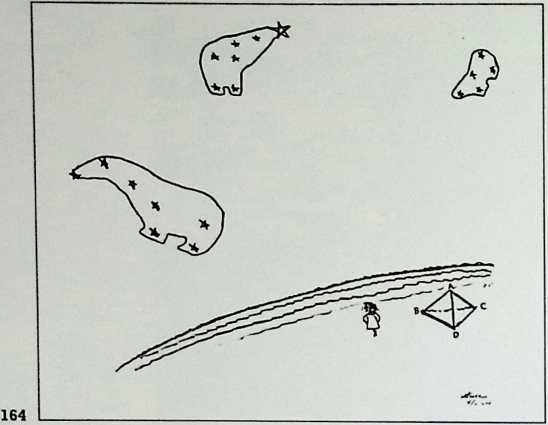
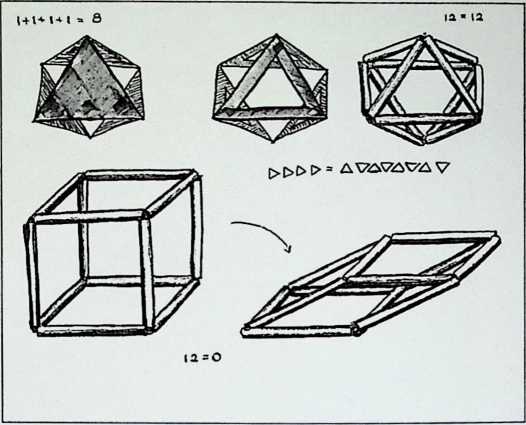
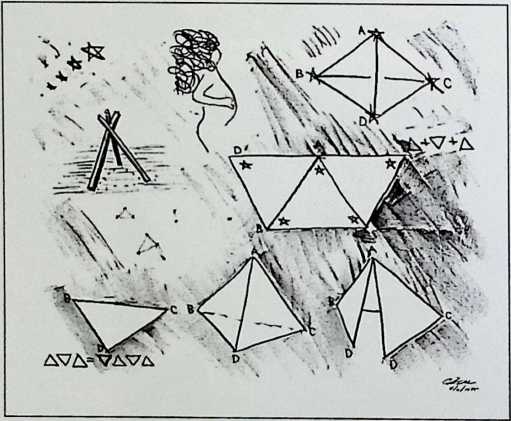
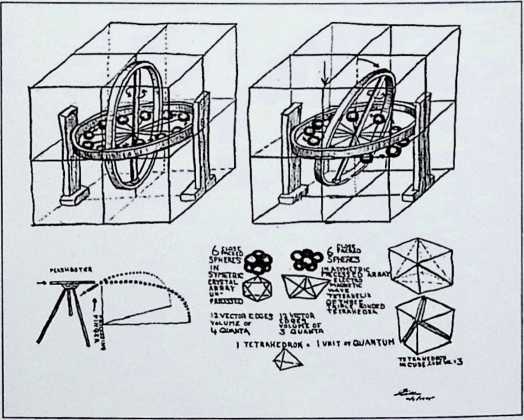
P1.168
168
169
Detail of Tetrascroll, 1976, Stone 9
Pi.170
170
171
Detail of Tetrascroll, 1976, Stone 15
VS
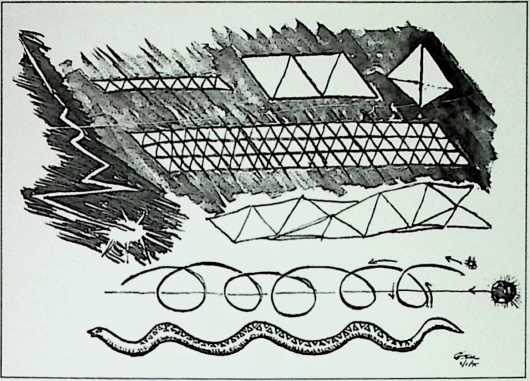

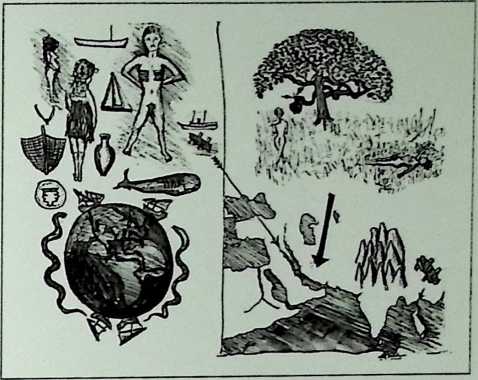
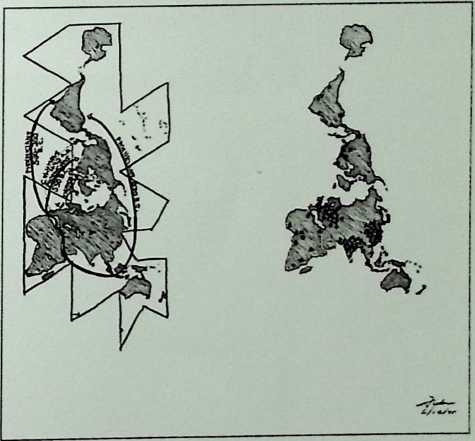
Pi.172
WatercraftRowing Needles, United States Patent Office no. 3,524,422, filed March 28, 1968, serial no. 716,957, granted August 18, 1970, inventor: Buckminster Fuller From the portfolio Inventions: Twelve Around One, 1981
Screenprint in white ink on clear polyester film overlaid on a Curtis plain blue backing sheet 30x40 in. (76.2x101.6 cm)
Pi.173
WatercraftRowing Needles, United States Patent Office no. 3,524,422, filed March 28, 1968, serial no. 716,957, granted August 18, 1970, inventor: Buckminster Fuller From the portfolio Inventions: Twelve Around One, 1981 Screenprint on Lenox paper 30 x 40 in. (76.2x101.6 cm)
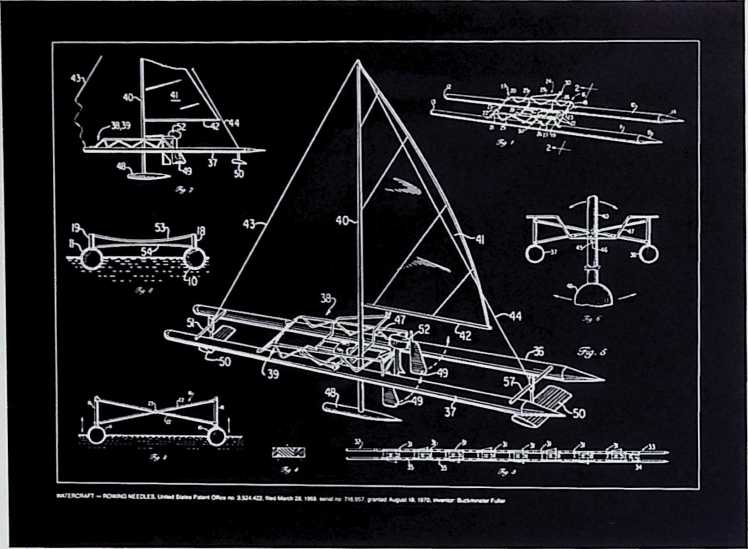
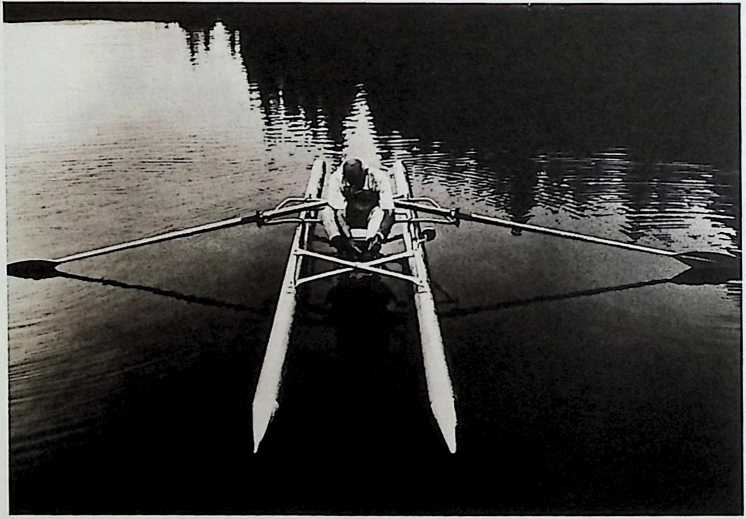
p. 174
Non-Symmetrical Tension-Integrity Structures, United States Patent Office no. 3,866,366, filed August 7, 1973, serial no. 386,302, granted February 18, 1975, inventor: Buckminster Fuller From the portfolio Inventions: Twelve Around One, 1981 (Fuller 1981)
Screenprint in white ink on clear polyester film overlaid on a Curtis plain blue backing sheet 30 x 40 in. (76.2x101.6 cm)
Pi.175
Non-Symmetrical Tension-Integrity Structures, United States Patent Office no. 3,866,366, filed August 7, 1973, serial no. 386,302, granted February 18, 1975, inventor: Buckminster Fuller From the portfolio Inventions: Twelve Around One,1981
Screenprint on lenox paper 30 x40 in. (76.2 x 101.6 cm)
¶ Index
¶ Bibliography
Fuller, R. Buckminster. 1981. Inventions: Twelve Around One.
¶ eBook Formats
1 ↩︎
2 ↩︎
“Buckminster Fuller: Thinking Out Loud,” documentary in the American Masters series, Thirteen/WNET, April 10, 1996, http://www.thirteen.org/bucky/johnson.html. ↩︎
2 - Buckminster Fuller, “Influences on My Work,” in The Buckminster Fuller Reader, ed. James Meller (London: Penguin, 1972), 61. ↩︎
31 R. Buckminster Fuller, No More Secondhand God and Other Writings (Carbondale: Southern Illinois University Press, 1963), 28. ↩︎
Alexander Graham Bell’s (1847) Frost King kite held by three workers, 1905 ↩︎
1 ↩︎
2 ↩︎
3 ↩︎
4 ↩︎
5 ↩︎
6 ↩︎
7 ↩︎
3 ↩︎
9 ↩︎
10 ↩︎
11 ↩︎
12 ↩︎
13 ↩︎
14 ↩︎
15 ↩︎
16 ↩︎
17 ↩︎
18 ↩︎
19 ↩︎
20 ↩︎
21 ↩︎
22 ↩︎
23 ↩︎
24 ↩︎
25 ↩︎
26 ↩︎
27 ↩︎
28 ↩︎
1 ↩︎
29 ↩︎
30 ↩︎
31 ↩︎
32 ↩︎
33 ↩︎
34 ↩︎
1 ↩︎
2 ↩︎
3 ↩︎
4 ↩︎
5 ↩︎
6 ↩︎
7 ↩︎
8 ↩︎
9 ↩︎
10 ↩︎
11 ↩︎
12 ↩︎
13 ↩︎
14 ↩︎
15 ↩︎
; ↩︎
16 ↩︎
17 ↩︎
18 ↩︎
19 ↩︎
20 ↩︎
21 ↩︎
22 ↩︎
23 ↩︎
24 ↩︎
25 ↩︎
26 ↩︎
27 ↩︎
28 ↩︎
29 ↩︎